Two Americans in Paris
The Collection of Sam and Myrna Myers | Part 1
Auction 11 September 2025


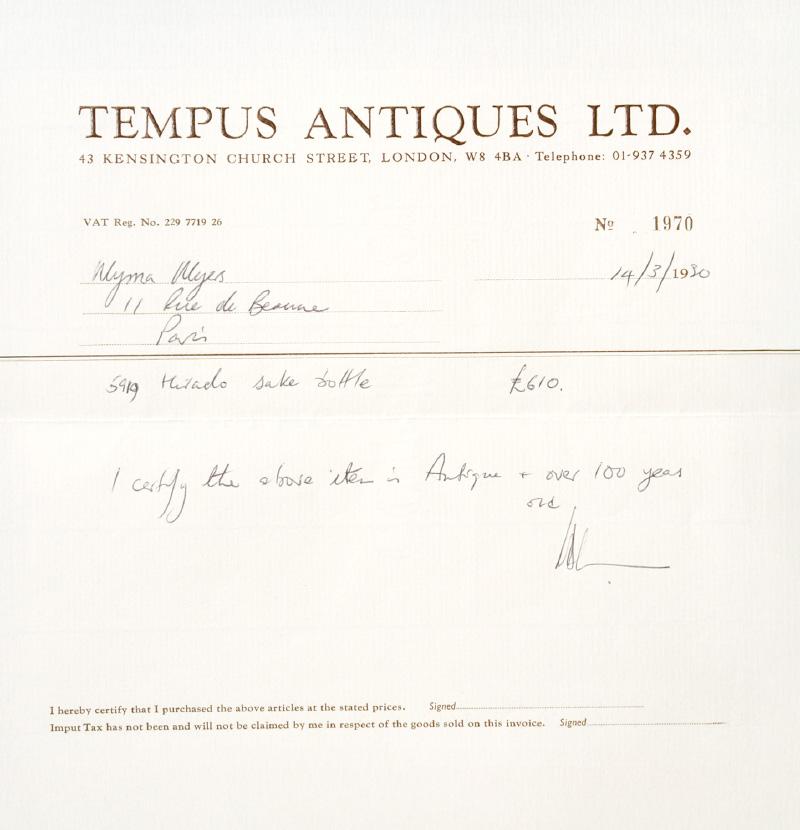




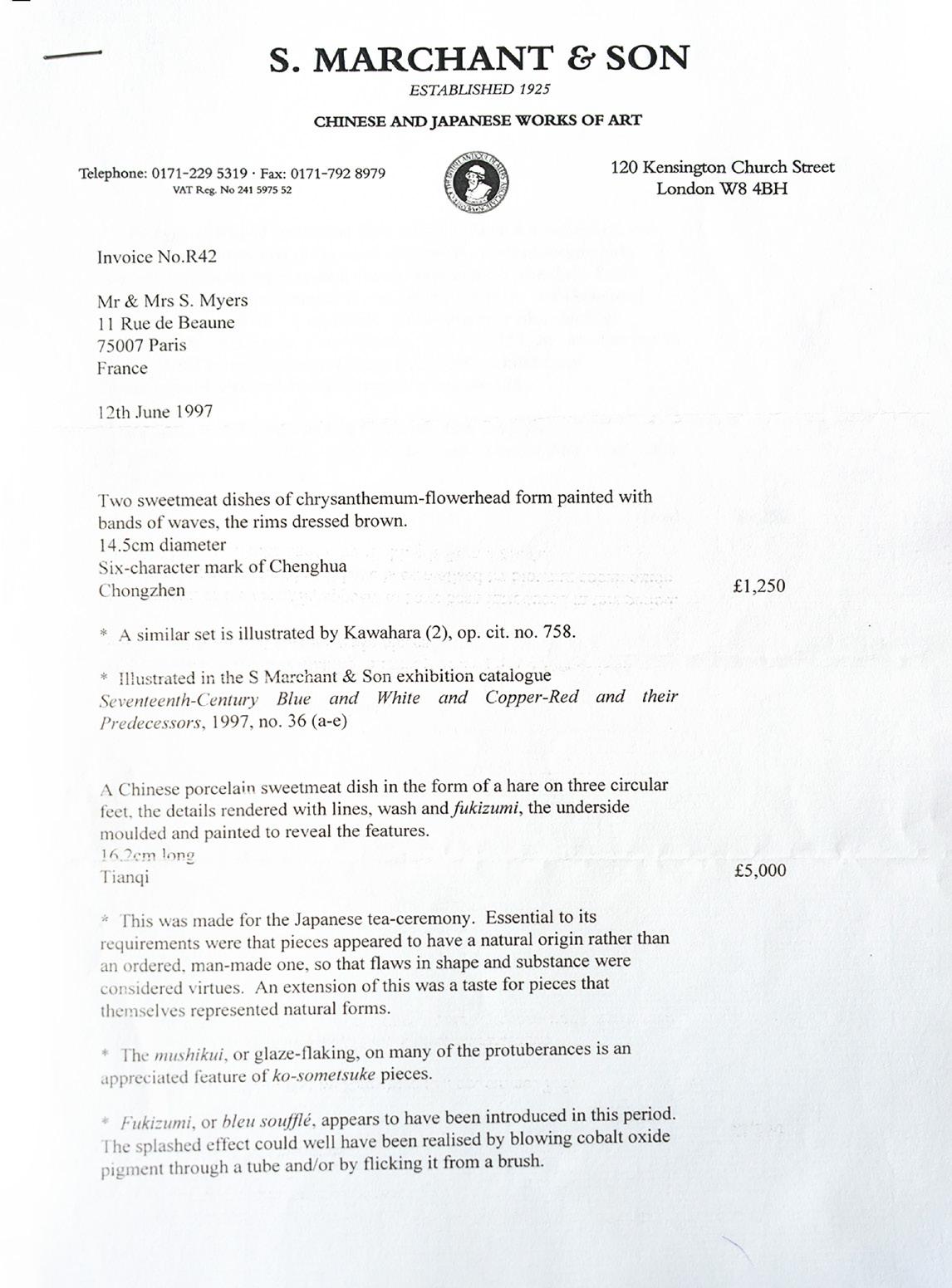






The Collection of Sam and Myrna Myers | Part 1
Auction 11 September 2025













The Collection of Sam and Myrna Myers Part 1
NO RESERVE LIVE AUCTION
11 September 2025, 11 am CET
SESSION 1
Lots 1-141 Print Catalog
SESSION 2 Lots 142-286 Online Catalog
EXHIBITION
1-9 September, Monday – Friday 10 am – 6 pm as well as by appointment
GALERIE ZACKE
Zelinkagasse 6 . 1010 Vienna Austria
Tel +43 1 532 04 52
E-mail office@zacke.at
www.zacke.at
11 September 2025
Lots 142-286



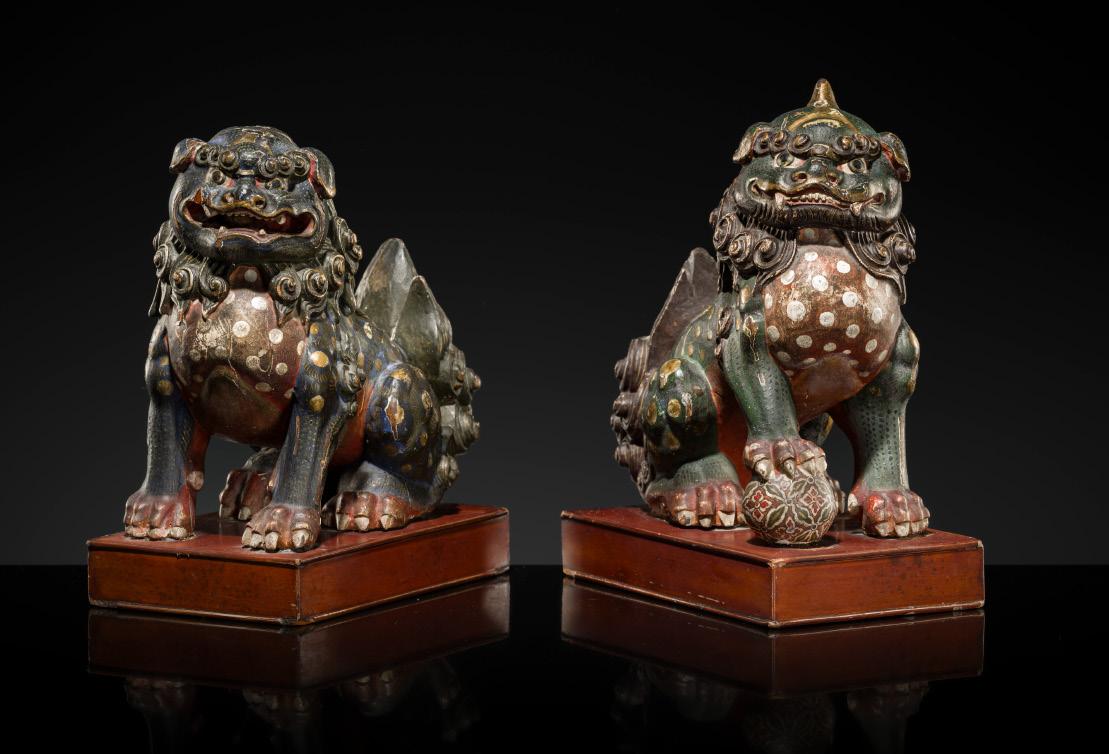









According to the general terms and conditions of business of Galerie Zacke Vienna, Founded 1968, SZA Versteigerungen & Vertriebs GmbH, 1010 Wien, online at www.zacke.at
ABSENTEE BIDDING
Absentee bids are carried out under the regulations of the terms of business of Galerie Zacke, SZA Versteigerungen & Vertriebs GmbH, which requires written submission of your purchase limit. Orders without purchase limits cannot be processed. Only the submitted lot number of the auction lot is binding for the processing of the absentee bid. The place of jurisdiction is Vienna, Austrian Law and Austrian jurisdiction are exclusively applicable for all legal questions arising from the business relationship. Absentee bids for this auction will be accepted until the day of auction by 10:00 a.m. We regret that absentee bids received after the time stated above will not be processed until after the auction.
PLEASE SEND ABSENTEE BIDS FOR THIS AUCTION TO: Fax: +43 1 532 04 52 20 or Email: office@zacke.at or Mail: Galerie Zacke, Zelinkagasse 6, 1010 Wien, Austria, Europe
WE ACCEPT THE FOLLOWING METHODS OF PAYMENTS:
• Cash
• Certified or personal check
• Bank transfer (please inquire to receive our bank account information)
• Credit card (Visa, MasterCard, Amex) up to EUR 5.000 - higher amounts require prior approval and are subject to service fees
TELEPHONE BIDDING
It is generally possible to bid by telephone during the auction. Please fill out the absentee bidding form enclosed in this catalog and include your telephone number at which you can be reached during the auction. In the “bid in euro” column please write “TEL” and then send us the completed absentee bidding form. Galerie Zacke will call you on the day of the auction, on the telephone number provided, 5 lots before the lot you are bidding on and the bidding will commence at the starting price, as stated in the catalog. If Galerie Zacke cannot reach you during the auction, Galerie Zacke will bid the starting price on your behalf.
ESTIMATES AND STARTING PRICES
The auction will begin with the starting price and written bids will be accepted only with a minimum amount equivalent to the starting price.
For domestic shipping Galerie Zacke (hereinafter called “the company”) charges in average Eur 15,- to Eur 50,- per item, depending on size and weight. These fees cover the costs of packing and shipping. Fees for bulky or fragile items, or international shipping will be quoted upon request.
The purchased goods are transported at the risk of the customer following handover of the packaged item to the post office or another carrier which the customer agrees to through his/her submission of the purchase order. According to the specific wish of the customer, the auctioned goods may be insured for the value of the purchase price (highest bid and all surcharges). This insurance fee is 3% of the purchase price. For any lots with a purchase prices exceeding EUR 350,- the transport insurance will be automatically arranged by the company if it does not expressively receive the purchaser’s written denial of this service and signed waiver of claims. Payments due to the company under the insurance contract will be charged to the customer. The company is also entitled to assign claims under the insurance contract to the customer providing the terms of the insurance contract do not prevent this. In any case, the company is only required to make payment to the customer specifically if payment has effectively been received from the insurance company.
Auction lots will be exhibited for viewing prior to the auction, thus offering all interested customers the opportunity to examine the quality and condition of the works exhibited. The catalog illustrations are intended to assist customers during such preview. In illustrations, printed colors do not correspond exactly to the originals. The printed catalog images are not representative for the condition of the illustrated pieces. Hidden flaws and damages are indicated in the condition report. The illustrations in our online catalogs can be strongly magnified, so that most damages and restorations are well recognizable.
ENDANGERED SPECIES / CITES INFORMATION
Some items in this catalog may for example consist of ivory, rhinoceroshorn, tortoise shell, or some types of tropical wood, and are subject to the Convention on International Trade in Endangered Species of Wild Fauna and Flora [CITES]. Such items are marked with the symbol Ɏ on www.zacke.at and may only be exported outside the European Union after an export permit in accordance with CITES has been granted by the Austrian authorities. We would like to inform you that such licenses are typically not granted.
At its auctions, Galerie Zacke sells consigned lots on behalf of third-party consignors. For this reason, any complaints related to purchased lots must be in accordance with §32-48 of the general terms and conditions of business of Galerie Zacke, which can be found on www.zacke.at
IMPORTANT INFORMATION
Whenever making a bid, whether personally or via an agent, in writing, online, telephone, or in any other way, the bidder fully and unconditionally accepts the Terms of Auction, the ‘Important Information’ section in the auction catalog, the Terms and Conditions (AGB) of Galerie Zacke, §1-50, the Fee Tariff, and the Bidding Increments table, all as published on www.zacke.at on the day of the auction
THE ART LOSS REGISTER
All items starting above EUR 2,000 have been checked by the Art Loss register.


PLEASE RAISE MY BID BY ONE BIDDING INCREMENT (ca. 10%) IF NECESSARY
IMPORTANT NOTICE:
Bids do not include buyer’s premium and VAT. Margin taxation applies. Items with added VAT are marked in the online catalog.
TELEPHONE BIDS:
PLEASE CALL ME WHEN A HIGHER BID THAN MINE
If you like to bid by telephone, please state ‘TEL’ in the ‘BID IN EURO’ column instead of a Euro amount. Galerie Zacke will call you on the day of the auction, on the telephone number provided, 5 lots before the lot you are bidding on and the bidding will commence at the starting price, as stated in the catalog. If Galerie Zacke cannot reach you during the auction, Galerie Zacke will bid the starting price on your behalf.
TERMS OF PAYMENT, SHIPPING AND COLLECTION:
NAME
ADRESS
CITY, COUNTRY
POSTCODE
PHONE NUMBER
CREDIT CARD PAYMENT PLEASE CHECK THE DESIRED CARD
COLLECTION BY CLIENT WITH PAYMENT ON THE PREMISES IN CASH, BY CERTIFIED CHEQUE OR CREDIT CARD
INVOICE PAYMENT
VIA BANK WIRE AFTER RECEIPT OF INVOICE
SHIPPING AFTER RECEIPT OF PAYMENT
EXPRESS PARCEL SERVICE REQUIRED (ACCORDING TO TERMS AND CONDITIONS OF GALERIE ZACKE)
SHIPPING INSURANCE
REQUIRED (ACCORDING TO TERMS AND CONDITIONS OF GALERIE ZACKE)
GALERIE ZACKE
Zelinkagasse 6, 1010 Vienna, Austria
Email: office@zacke.at
Tel: +43-1-532 04 52
Fax: +43-1-532 04 52 20
& SIGNATURE
IMPORTANT NOTICE:
Whenever making a bid, whether personally or via an agent, in writing, online, telephone, or in any other way, the bidder fully and unconditionally accepts the Terms of Auction, the ‘Important Information’ section in the auction catalog, the Terms and Conditions (AGB) of Galerie Zacke, §1-48, the Fee Tariff, and the Bidding Increments table, all as published on www.zacke.at on the day of the auction.
ABSENTEE BIDDING FORM
FOR THE AUCTION Two Americans in Paris: The Collection of Sam and Myrna Myers Part 1 ON DATE 11 September 2 025
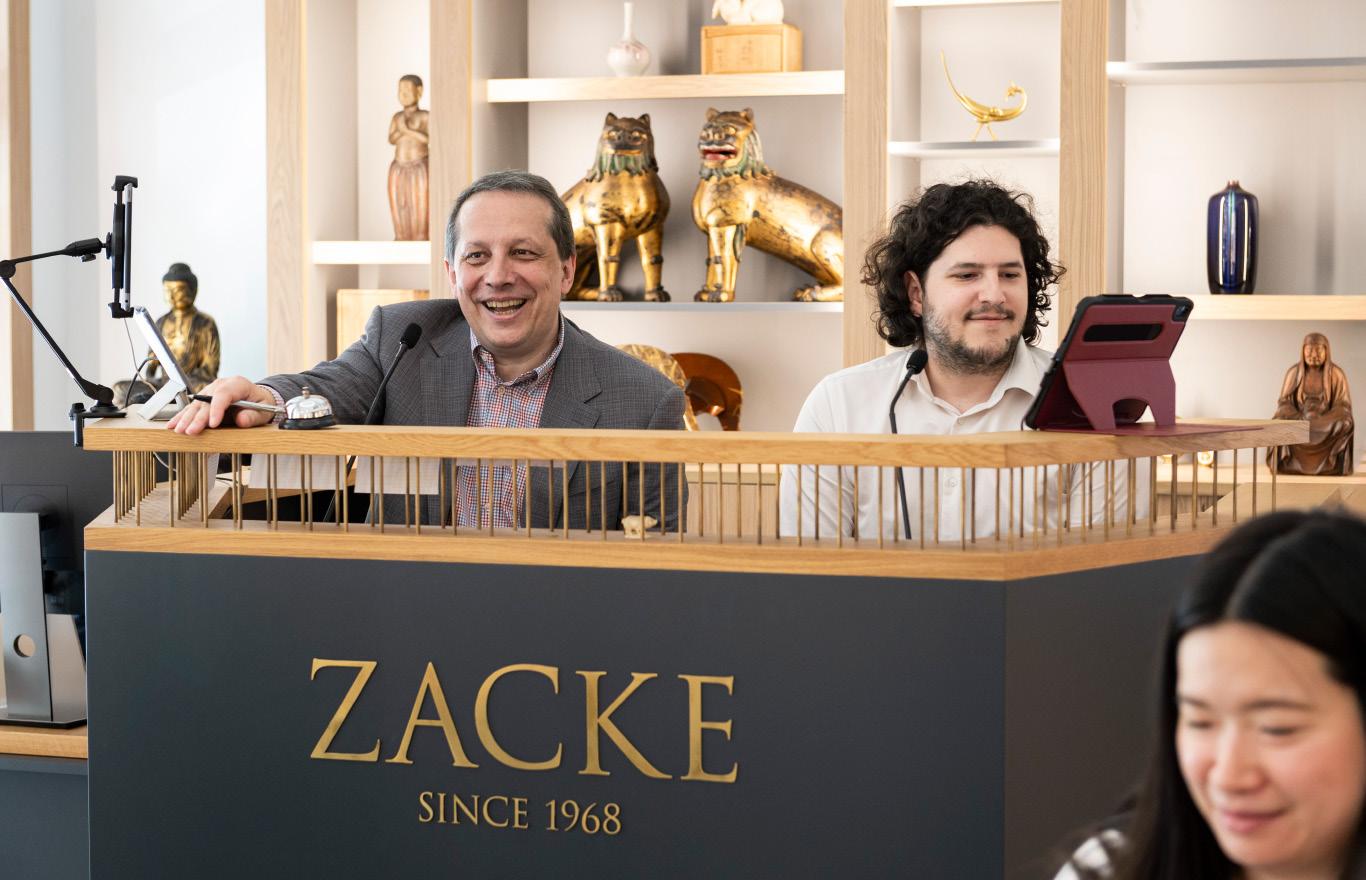
We have opened our brand-new, 6,000-square-foot exhibition, showroom, and auction rooms at Zelinkagasse 6, 1010 Vienna!
Starting 1 September you’ll be able to explore the exceptional pieces featured in this auction at Zelinkagasse 6, 1010 Vienna
JOIN US LIVE
11 September 2025 at 11 am CET
Attend in person at our new auction room at Zelinkagasse 6 or participate online via Zacke Live –and enjoy premium buyer’s terms with no additional online bidding fees
Register now: www.zacke.at
HOW TO FIND OUR NEW AUCTION & SHOWROOM
Our new additional auction and preview space at Zelinkagasse 6 in Vienna’s 1st district is just a sevenminute walk from our 10,000-square-foot office, photography, video, and cataloging hub at Sterngasse 13.
Easily accessible by public transport or car (a parking garage is located nearby).
By Public Transport:
SCHOTTENRING station
(U2, U4, tram lines 1, 31, 71, D, and bus 3A)
ZELINKAGASSE 6
STERNGASSE 13
All lots in this auction are offered with No Reserve, allowing bids below the starting prices to be considered.
Please note that the starting prices have been set at exceptionally low levels to encourage participation.
We encourage you to take advantage of this unique opportunity to acquire remarkable pieces at highly competitive prices.

IMPRINT
Publisher Galerie Zacke founded 1968 © SZA Versteigerungen & Vertriebs GmbH
1010 Wien
Zelinkagasse 6, Austria, Europe
Tel (0043-1) 532 04 52
Email: office@zacke.at
Editors
Susanne Zacke
Marion Schor
Experts
Alexander Zacke
Max Zacke
Catalogers
Ananya Casius
Anne-Aymone Gabriel
Daniel Gonzalez-Gracia
Tatjana Borodin
Assistance and Translation
Jue Zhang
Mieko Gray
Anna-Maria Pollmann
Florentine Oswald
Photography
David Lindengrün
Jonas Matyassy
Cesilio Cesar Garcia
Loreen Sasse
Design
Hermann Kienesberger
Printing Print Alliance
HAV Produktions GmbH
Website www.zacke.at
© GALERIE ZACKE
Reproduction forbidden



Dear customers,
We are immensely proud to have been entrusted by Sam Myers with the stewardship of his collection, one that has traveled across the globe and already inspired countless scholars, connoisseurs, and enthusiasts. As the most prestigious and important collection this gallery has ever handled, being chosen to represent it over our many competitors is an undeniable privilege.
The first opportunity, however, was given to Sotheby’s London. Despite the collection’s historical significance, the November 2021 sale faced considerable challenges, including COVID-19, Brexit, and unusually high reserve prices, resulting in mixed outcomes—quite the opposite of earlier, highly successful appearances of objects from the collection at major auctions. Accordingly, London was ruled out as the venue for future sales.
Let us go back further, to the first decade of this century, when Myrna Myers was securing the legacy of the collection she had built. She achieved this through major donations: most notably, her extensive, well-documented, and widely exhibited textile collection to the Musée Guimet, as well as substantial contributions to the Musée des Arts Asiatiques in Nice, a museum “greatly indebted to her,” according to its director Adrien Bossard. Beyond these gifts, numerous sales to museums took place, often at symbolic prices more akin to donations than commercial transactions.
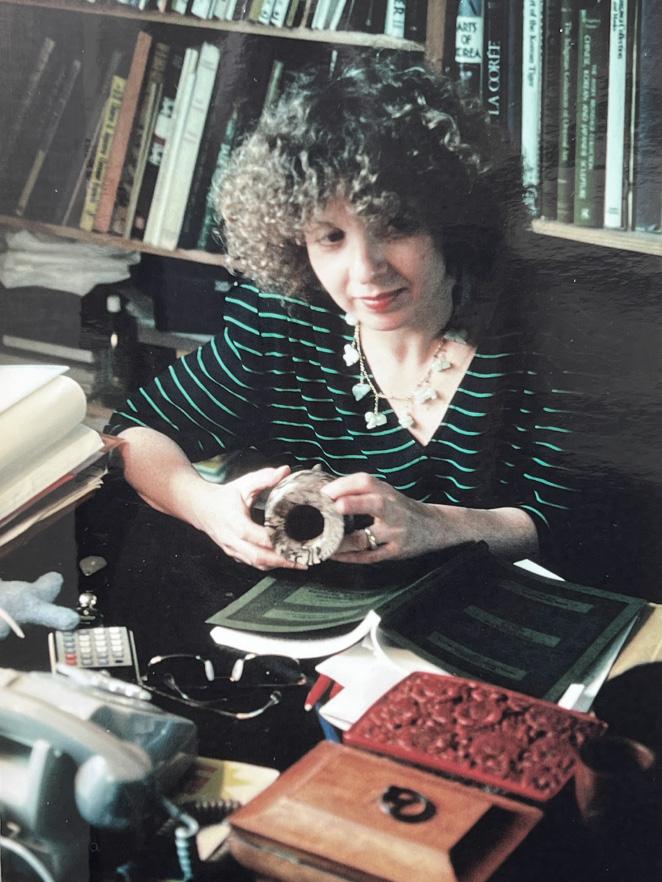
Sotheby’s Hong Kong, 3 April 2019, lot 3620, Jade Animal-Shaped Plaque, Eastern Zhou dynasty, sold for HKD 26,575,000
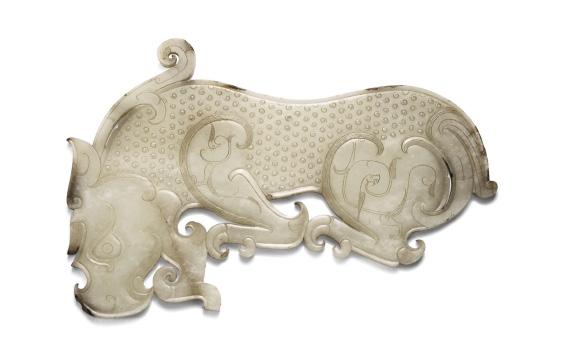
Sotheby’s Hong Kong, 10 April 2006, lot 1540, ‘Twelve-Symbol Dragon’ Robe, Qianlong period, sold for an undisclosed amount and later estimated at HKD 20,000,000 (Sotheby’s Hong Kong, 5 October 2016, lot 3307)

Musée Guimet
1 April 1990, Blue and White Ewer, Yuan dynasty, sold for EUR 1,250,000
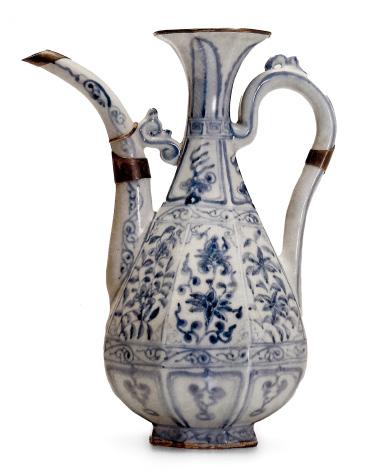
Rubin Museum of Art 22 March 2004, Three Thangka, Qing dynasty, sold for USD 145,000

Los Angeles County Museum of Art 7 April 2017, Man’s Formal Court Robe, Chaopao, Kangxi period, sold for USD 300,000



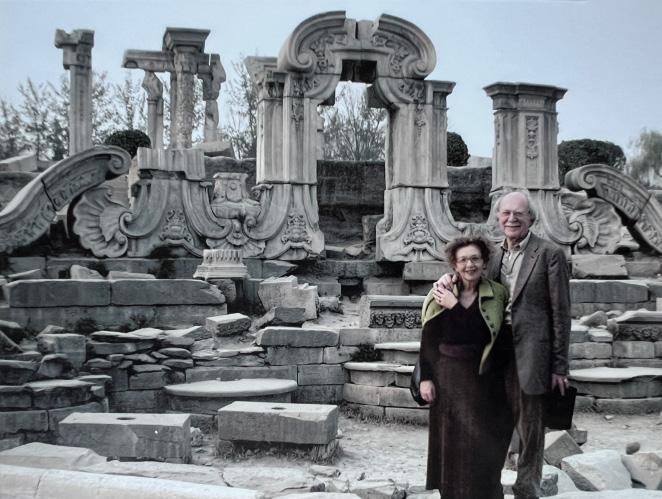

After Myrna’s passing in 2012, Sam Myers continued this work with extraordinary dedication. He spearheaded a project of grand scale: the traveling exhibition and comprehensive publication of their collection, realized under the direction of Jean-Paul Desroches, general curator at the Musée Guimet, and Myrna’s professor at the Ecole du Louvre. This exhibition, which included many of the objects now offered in this sale, brought the collection to the Kimbell Art Museum in Fort Worth, the Musée Pointe-à-Callière in Montréal, the Fondation Baur in Geneva, and the Musée des Arts Asiatiques, and was accompanied by two state-of-the-art catalogs, Two Americans in Paris and The Beginning of the World. Now 90 years old, Sam remains committed to safeguarding and sharing the collection that defined both his and Myrna’s life. Their mutual passion for Asian art, deepened by their devotion to each other, not only enriched their own lives but also left a lasting impact on countless museums, exhibitions, and scholarly publications, along with their visitors and readers.
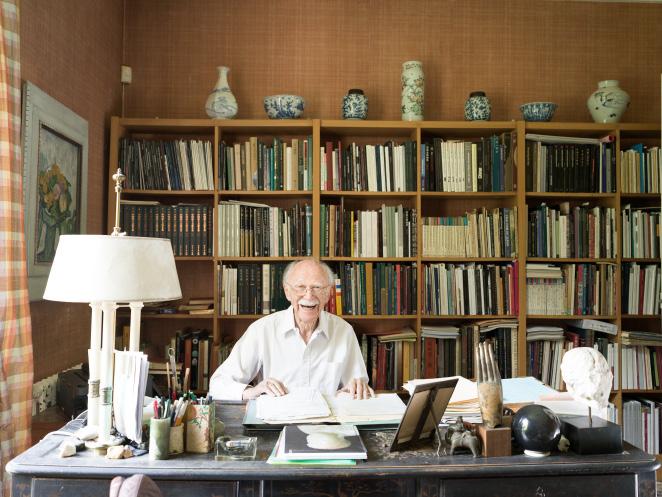

The Myers Collection is the largest and most important private collection of Chinese jade in the West, with many of its most significant pieces entirely unknown to the public. For Sam and Myrna, it was always essential to maintain a core of outstanding jades, most originating from old, distinguished collections and acquired during the 1960s and 1970s. These jades have rarely been seen and remain a wellguarded secret. It is uncertain how many will appear at auction in the coming years, but several certainly will.

This auction celebrates the magnificent artworks and enduring legacy of two collectors whose vision and generosity have shaped the understanding and appreciation of Asian art for generations to come. We hope you find as much joy in looking through our first catalog of the Myers Collection as much as we did in preparing it.
Sincerely,
Alex and Max Zacke


Pointe-à-Callière Museum

From the Lands of Asia.
The Sam and Myrna Myers Collection, Montréal, 17th November 2016-19th March 2017


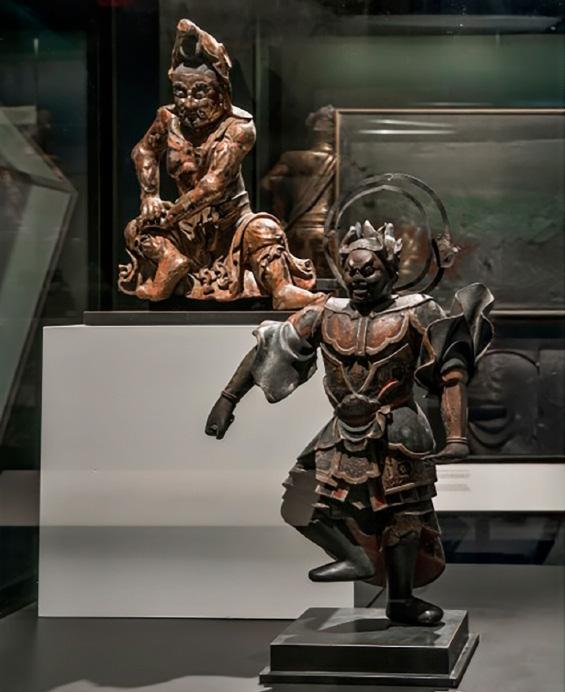



From the Lands of Asia.
The Sam and Myrna Myers Collection, Fort Worth, Texas, 4th March-19th August 2018
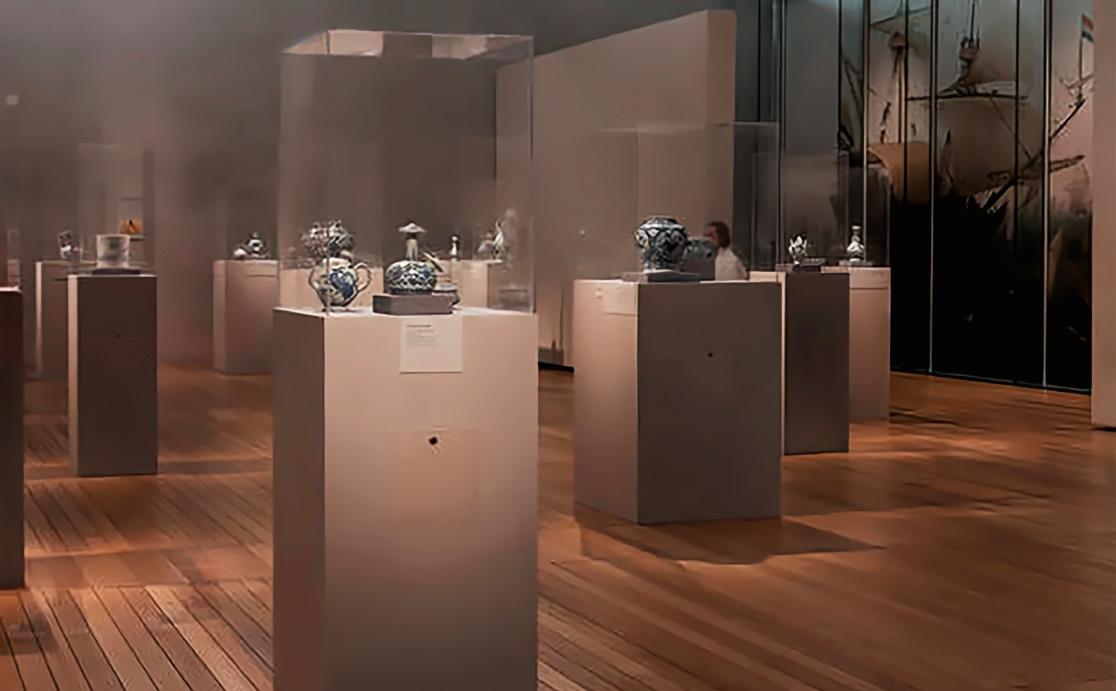
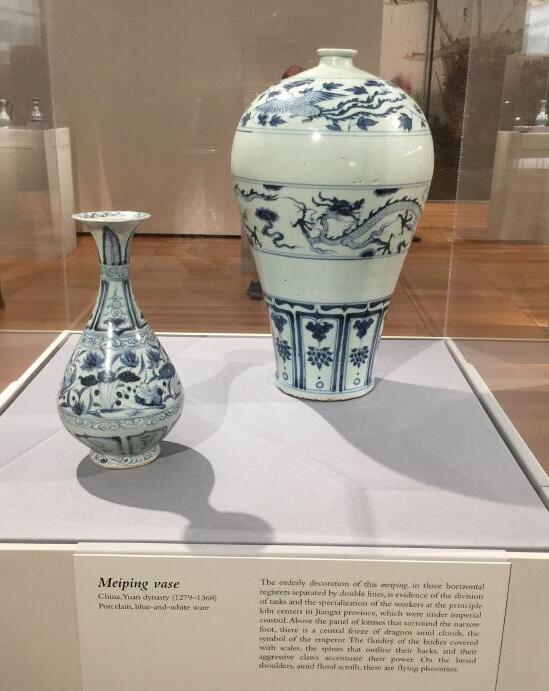

Fondation Baur


The Beginning of the World – According to the Chinese. Dragons, Phoenix and Other Chimera, Geneva, 11 November 2020-23 May 2021


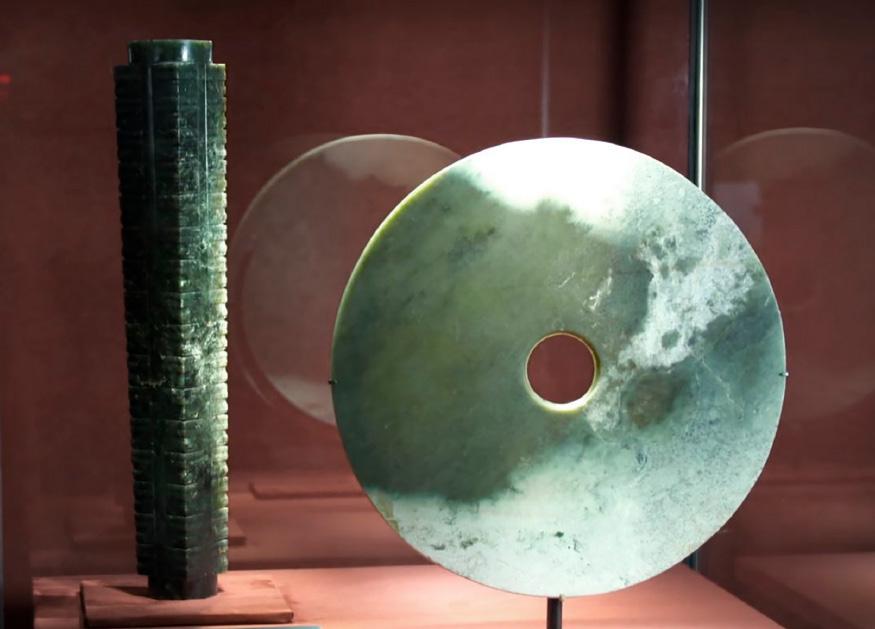

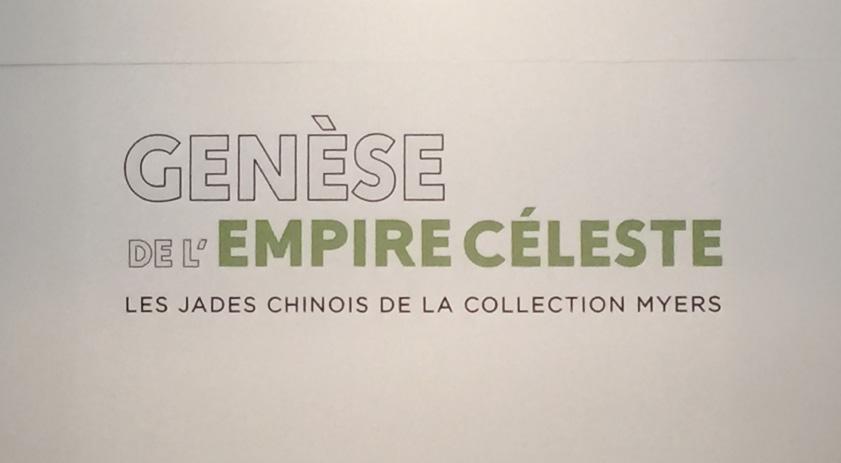

The Beginning of the World – According to the Chinese. Dragons, Phoenix and Other Chimera, Nice, Summer 2021
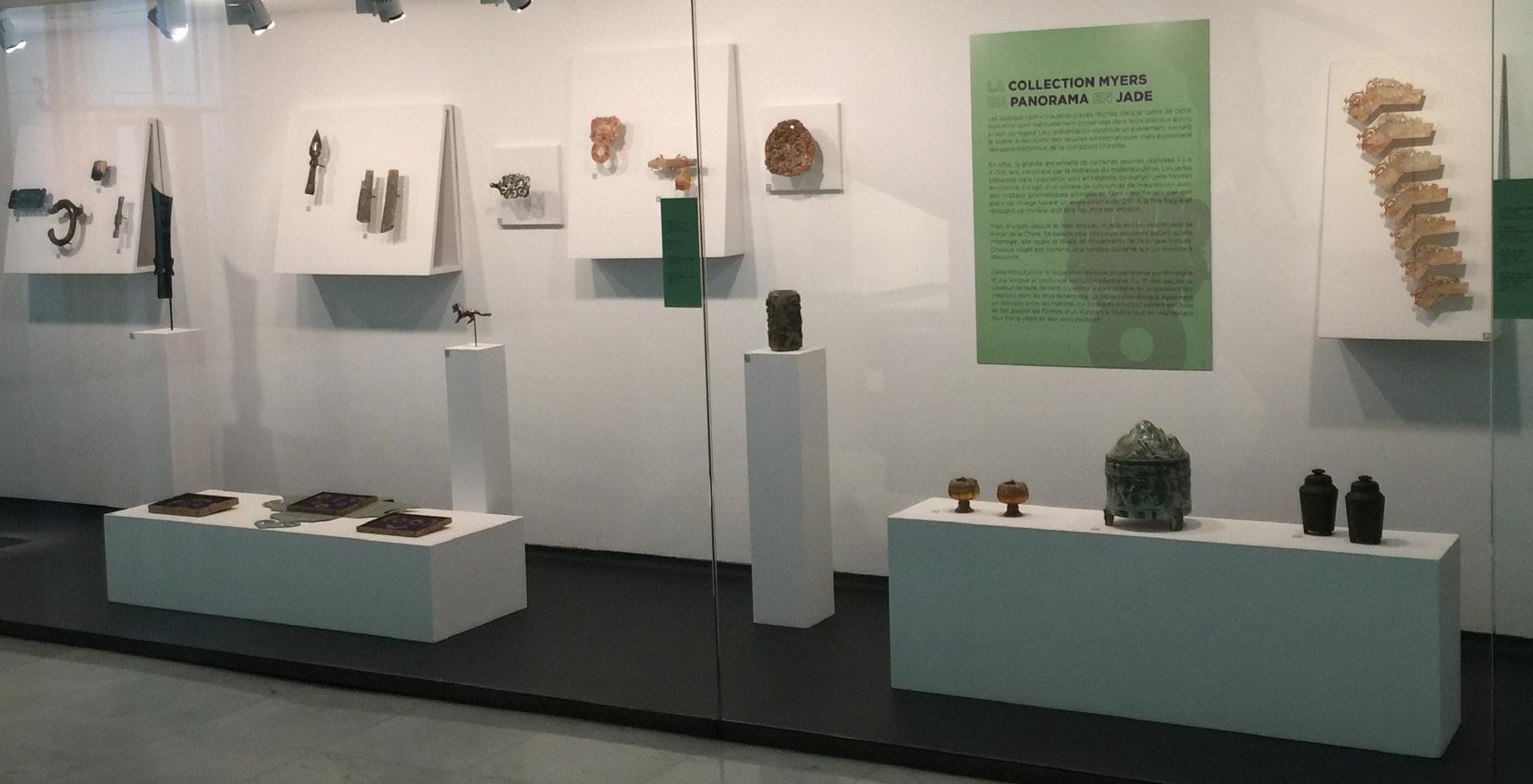
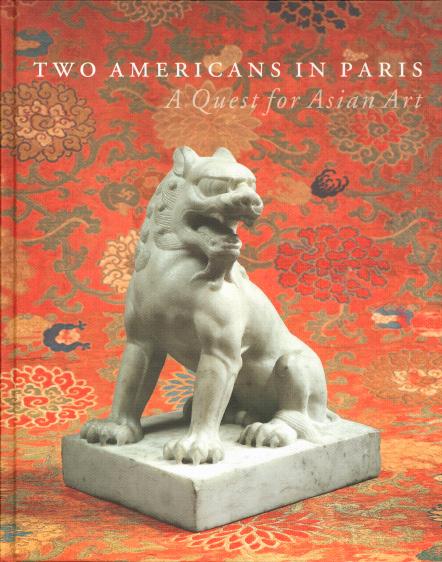




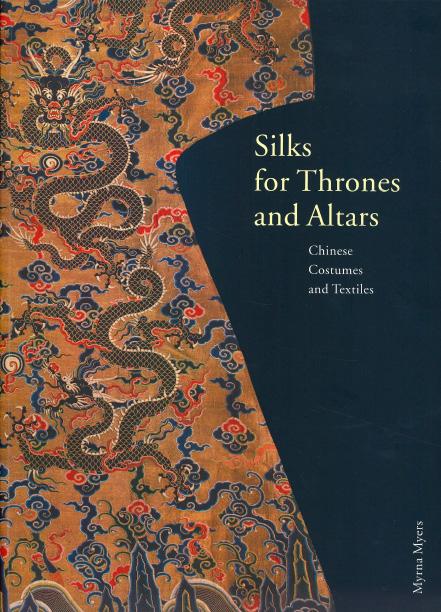




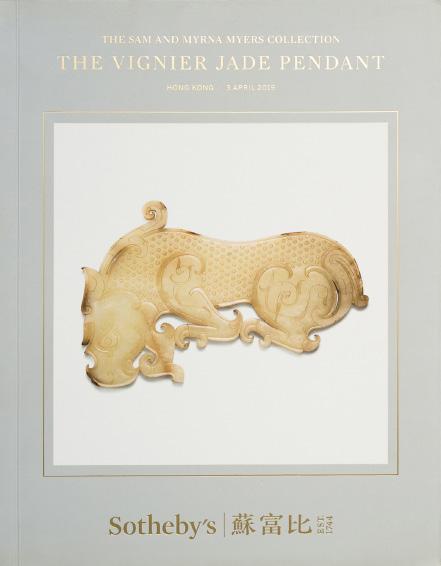


1 A LARGE PAINTED POTTERY JAR, NEOLITHIC PERIOD, MAJIAYAO CULTURE
PUBLISHED
Jean-Paul Desroches
(ed.) et al, Two Americans in Paris: A Quest for Asian Art, Paris, 2016, p. 160, no. 268.



Exhibited:
1. Pointe-à-Callière Museum, From the Lands of Asia. The Sam and Myrna Myers Collection, Montréal, 17 November 2016-19 March 2017.
2. Kimbell Art Museum, From the Lands of Asia. The Sam and Myrna Myers Collection, Fort Worth, Texas, 4 March-19 August 2018.
China, Machang type, late 3rd millennium BC. The compressed globular jar tapering towards the flat base, surmounted by a short waisted neck with an everted rim, flanked by two small loop handles. The shoulders and neck of the vessel boldly painted in black and burgundy slips with designs of stylized anthropomorphic figures, their heads represented by medallions filled with crosshatched patterns, framed by similarly painted geometric bands.
Provenance: The Collection of Sam and Myrna Myers, Paris, France. Acquired between circa 1965-2012.
Condition: Very good condition with expected old wear, firing irregularities, traces of weathering, light surface scratches, few minor chips, some dimples, and small areas of soil encrustation.
Weight: 4,576 g
Dimensions: Height 40.3 cm
The Majiayao culture was a group of smaller neolithic communities who lived primarily in the upper Yellow River region of eastern Gansu, Qinghai and northern Sichuan, China. The culture existed from c. 3300 to 2000 BC and marks the first time in history that the upper Yellow River region was widely occupied by agricultural settlements. It is famous for its painted pottery, which is regarded as a peak of pottery manufacturing at that time.
LITERATURE COMPARISON
Compare a closely related Majiayao earthenware broad-shouldered jar with bichrome slip-painted decoration, 41.2 cm high, in the Harvard Art Museums, object number 2006.170.42. Compare a closely related Majiayao jar with painted decoration of “frog pattern”, dated c. 2300-2000 BC, 41.9 cm high, in the Metropolitan Museum of Art, object number 2015.500.7.9 (fig. 1)
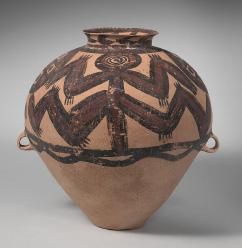
Compare a closely related Majiayao earthenware vessel with painted frog patterns, 31.5 cm high, excavated from a Machang site in Liuwan, Ledu, Qinghai province, and illustrated in: Yang Xiaoneng, Chinese Archaeology: New Perspectives on China’s Ancient Past in the Twentieth Century, vol. 2, London, p. 75, fig. 28b.
AUCTION RESULT COMPARISON
Type: Closely related
Auction: Christie’s New York, 22 September 2023, lot 1046
Price: USD 10,080 or approx. EUR 9,500 converted and adjusted for inflation at the time of writing
Description: A large painted pottery jar, Neolithic period, Majiayao culture, Machang type, late 3rd millennium BC

Expert remark: Compare the closely related form, decoration, and motifs. Note the size (35 cm).
Estimate EUR 3,000
Starting price EUR 1,500
Expert’s note: This jar is a fine example of a rare group of Cizhou wares with motifs both painted and incised through layers of black and white slip. Wares of this type are discussed by Yutaka Mino in the catalog to the exhibition Freedom of Clay and Brush through Seven Centuries in Northern China: Tz’u-chou Type Wares, 960-1600 A.D., Indianapolis Museum of Art, Indianapolis, 1980, p. 198, where he suggests that they originally evolved from sgraffiato wares. He further notes that while painted and incised wares may have originated in the Northern Song period, they became popular only in the Jin, concurrently with the decline of the sgraffiato technique.
China, 960-1368. Heavily potted with a robust ovoid body rising from a short spreading foot to a high rounded shoulder and straight mouth with lipped rim, boldly painted in brownish-black on a white slip under a clear glaze, decorated with a broad band of peony blossoms borne on leafy scrolling stems, framed by line borders below a band of swirling clouds within a sinuous border encircling the shoulder. The slip and glaze stopping irregularly above the foot, revealing the gray ware.
Provenance: The Collection of Sam and Myrna Myers, Paris, France.
Acquired between circa 1965-2012.
Condition: Good condition with old wear, firing irregularities, little fritting to the rim. One side with an old stabilized crack extending from the rim down to the center of the base, previously stapled with three iron rivets which have been subsequently removed. Few small chips and light nicks to the base.
Weight: 1,223 g
Dimensions: Height 14.5 cm, Diameter 17 cm
LITERATURE COMPARISON
Compare a related larger Cizhou painted and incised jar with a dragon and phoenix, dated to the Yuan dynasty, 31 cm high, in the Ashmolean Museum, Oxford, accession number LI1301.338.
AUCTION RESULT COMPARISON
Type: Closely related
Auction: Sotheby’s New York, 20 March 2019, lot 641
Price: USD 10,000 or approx. EUR 11,000 converted and adjusted for inflation at the time of writing
Description: A painted ‘Cizhou’ globular jar, Song-Yuan dynasty
Expert remark: Compare the closely related form, decoration, ware, and size (16.2 cm).
Estimate EUR 3,000
Starting price EUR 1,500
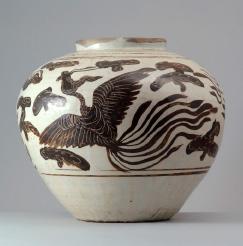
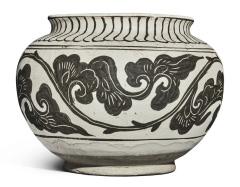
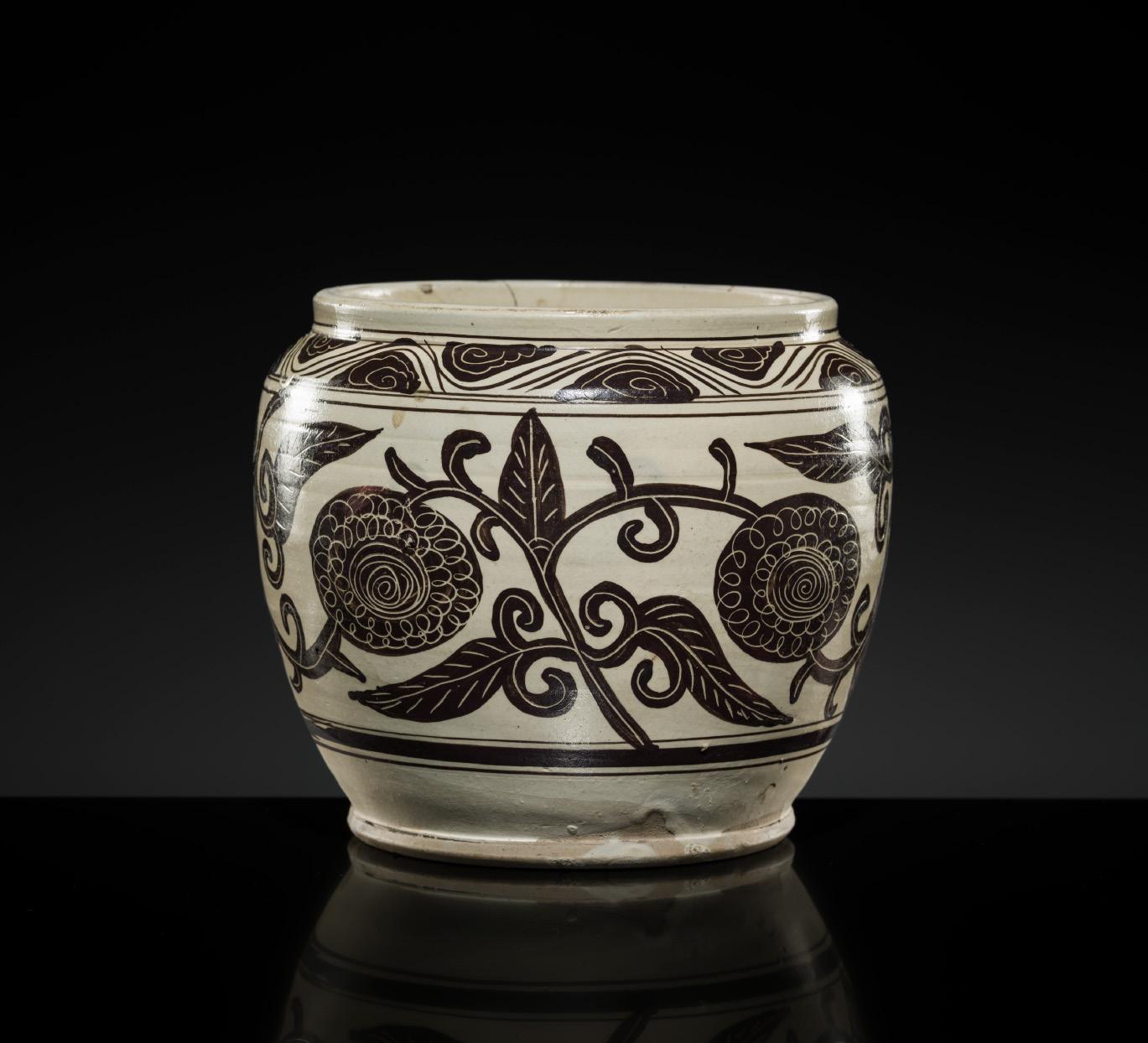
China, 10th-11th century. The ewer is potted with a lobed body rising from a straight foot to a deeply inverted mouth, surmounted by a handle reminiscent of a twisted rope terminating in three separate straps, each with a floral appliqué attached to the other side of the rim, and with a short spout set below. Covered overall with a fine and thinly applied glaze of grayish-tinged white color pooling attractively in the recesses, save for the unglazed foot rim.
Provenance: The Collection of Sam and Myrna Myers, Paris, France. Acquired between circa 1965-2012.
Condition: Very good condition with minor wear and firing irregularities including glaze lines forming a network of craquelure in some areas, minor glaze degradation to the handle, light surface scratches, the unglazed foot rim with small nicks and few minuscule chips.
Weight: 506 g Dimensions: Height 19.4 cm
This ewer was probably used to pour wine, which was customarily served warm. Its form carries auspicious symbolism, as the imagery of melons forms the rebus guadie mianmian (numerous melons borne on never-ending vines), a phrase which conveys the wish for abundant offspring. As early as the Tang dynasty, vessels were made in melon forms encapsulating such auspicious wishes. It is likely that the current ewer, too, served as a decorative piece not intended to be merely functional but rather used to convey fortuitous wishes, as gifts, or in ceremonies and rituals.
A small number of Ding melon-form ewers have been excavated, mostly in the territory of the Liao state, spanning across the mid-Northern Song to mid-to-late Jin dynasties. See for example a Ding ewer of melon form excavated from no. 6 tomb located at Qahar Right Front Banner Haoqian Unit in Inner Mongolia. Because most of these lobed ewers were unearthed in the northeastern part of China, and some of them were indeed fired within Liao territory, for example at Longquanwu in Beijing, many scholars in the past identified ewers like the present lot as ‘Liao wares’. However, this is inaccurate. Most of these lobed ewers, whether
they are coarse or fine, were in fact fired at the Ding kilns. In 2009, the School of Archaeology and Museology at Beijing University and the Hebei Cultural Relic Research Institute conducted a joint excavation at the Ding kilns in Hebei. The Jianciling kiln site produced Ding wares of the finest quality. Sherds of similar lobed ewers were unearthed from the stratum dating to the late Northern Song period, and one can conclude finer types of Ding ewers were produced at this kiln site. Lobed ewers of lesser quality were found in the kiln sites of Yancun and Yebei, from stratum dating to the Jin dynasty. Thus it is likely that some of the coarser lobed ewers found in northeast China mentioned previously were fired at these kiln sites.
LITERATURE COMPARISON
Compare a closely related Ding ewer, dated to the Liao dynasty, 11th century, 15.7 cm high, in the Art Institute of Chicago, reference number 1924.336 (fig. 1). Compare a closely related Ding ewer, dated to the Northern Song dynasty, 11th century, 15 cm tall, in the Victoria and Albert Museum, accession number C.615&A-1918.

AUCTION RESULT COMPARISON
Type: Closely related
Auction: Sotheby’s New York, 23 March 2011, lot 504
Price: USD 122,500 or approx. EUR 150,000 converted and adjusted for inflation at the time of writing
Description: A rare small ‘ding’ ewer, Liao / Song dynasty
Expert remark: Compare the closely related form, glaze, and modeling with similar handle. Note the size (15.9 cm).
Estimate EUR 10,000
Starting price EUR 5,000
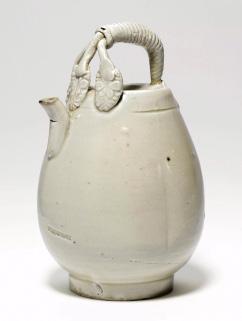


A RARE DINGYAO CARVED ‘LOTUS’ FOLIATE-RIMMED VASE, HUAKOUPING, NORTHERN SONG-JIN DYNASTY
China, 960-1234. Finely potted, the ovoid body supported on a tall splayed foot and surmounted by a waisted neck flaring to an undulating rim and decorated with two bow-string bands, the body fluidly carved with a spray of lotus wrapping around the center. The vase is covered with a glaze of creamy-white color that continues inside the mouth and onto the base save for the unglazed foot rim.
Provenance: The Collection of Sam and Myrna Myers, Paris, France. Acquired between circa 1965-2012.
Condition: Very good condition with minor wear, and firing irregularities including dark spots and expected glaze crazing.
Weight: 664 g
Dimensions: Height 21.8 cm
The Ding kilns created some of the most prestigious ceramics in the Northern Song and Jin dynasties, which enjoyed popularity not only at the Northern Song and Jin imperial courts but even, as has recently been discovered, at the court of the Southern Song, located far away in Hangzhou in South China. Ding wares are among the most delicately potted vessels, and their fine near-white body, thin, translucent, ivory-tinged glaze, and understated decoration give them an elegant and precious appearance and a distinctive identity.
The current vase’s distinctive shape, termed huakouping (vase with foliate mouth rim), was first introduced during the Tang dynasty and became a popular shape employed at a variety of kilns during the Song dynasty, especially the Cizhou kilns. For an example of a Cizhou vase of this shape, see Tsugio Mikami, Sekai toji Zenshu 13 Liao Jin Yuan, Shogakukan, Tokyo, p. 243, no. 278.
The high esteem in which a Ding bottle was held at the Qing court can be gleaned from a smaller (15.9 cm) undecorated example with tall slender neck, everted rim and depressed globular body, with a low footring instead of a splayed foot, preserved in the National Palace Museum, Taipei, which was inscribed on the base with a poem by the Qianlong Emperor dated to the year 1773, apparently the only comparable piece preserved in the National Palace Museum; see Yu Peichin, De jia qu. Qianlong Huangdi de taoci pinwei/Obtaining Refined Enjoyment: The Qianlong Emperor’s Taste in Ceramics, National Palace Museum, Taipei, 2012, cat. no. 4.
Literature comparison: Compare two famous carved Dingyao vases of upright long-necked shape but lacking the foliate rim of the present lot: a bottle vase dated to the Song dynasty, 22 cm high, in the Palace Museum, Beijing, illustrated in The Complete Collection of Treasures of the Palace Museum, Porcelain of the Song Dynasty, vol. 1, Hong Kong, 1996, pl. 35; and a mallet vase dated to the Northern Song dynasty, 25 cm high, from the Percival David Foundation and now in the British Museum, registration number PDF.103.
Type: Closely related
Auction: Sotheby’s Paris, 14 June 2024, lot 97
Price: EUR 42,000 or approx. EUR 42,500 adjusted for inflation at the time of writing
Description: A ‘Ding’-type white-glazed foliaterim vase, Five dynasties - Song dynasty, 9th10th century
Expert remark: Compare the closely related form and glaze. Note the size (16 cm) and lack of carved decoration.
Estimate EUR 6,000
Starting price EUR 3,000



5
A RARE CARVED LONGQUAN CELADON VASE AND COVER, NORTHERN SONG DYNASTY
China, 960-1127. Well potted with an ovoid body supported on a sturdy foot and rising to a slightly flared neck surmounted by a broad and tall galleried rim. The domed cover is surmounted by a flanged ring below a stepped finial. The body richly carved and combed with a band of overlapping upright petals below a register of foliate scroll, the cover with lines evocative of chrysanthemum petals. Covered overall with a finely crackled translucent glaze of slightly grayish olive-green color, save for the partially unglazed base and interior of the cover.
Provenance: The property of a private American collector.
Christie’s New York, 20 September 2013, lot 1277, sold for USD 6,250 or approx. EUR 7,300 (converted and adjusted for inflation at the time of writing). The Collection of Sam and Myrna Myers, Paris, France, acquired from the above.

Condition: Very good condition with expected wear and manufacturing irregularities including kiln grit to the base, few thin firing cracks, and glaze recesses. Minor glaze lines, the interior of the cover with small nicks, the base with few tiny losses.
Weight: 1 kg
Dimensions: Height 26 cm
Covered vases with galleried rims are typical for Northern Song Longquan ware. The form gradually changed from a tall tapering body with long neck in the early Northern Song dynasty to an ovoid body with shorter neck in the late Northern Song dynasty. Meanwhile, the glaze color developed into a more olive tone and the carved decoration was often more robust.
One usage of Longquan covered vases was revealed by the inscription on an example from the Percival David Foundation and now in the British Museum, registration number PDF.258 (fig. 1), illustrated for example by G. St. G. M. Gompertz, Chinese Celadon Wares, London, 1958, fig. 22. The inscription reads, ‘with the prayer that this vessel will hold fragrant wine for hundreds and thousands of years; That I may have a thousand sons and ten thousand grandsons; That they may be wealthy and live long lives; That they may enjoy good fortune and happiness; On the fifteenth day of the ninth month of leap year in the third year of the Yuanfeng period (1080). I have fired this vessel, signed by Liang Yingcheng’. Hence, covered jars of the current type could be used as funerary jars containing offerings such as wine and grains. This practice was a local custom in Southern Zhejiang and Northern Fujian province.
AUCTION RESULT COMPARISON
Type: Closely related

Auction: Christie’s Hong Kong, 2 December 2015, lot 2804
Price: HKD 1,960,000 or approx. EUR 258,000 converted and adjusted for inflation at the time of writing
Description: A rare carved longquan celadon vase and cover, Northern Song dynasty, 11th-12th century
Expert remark: Compare the related form, carved decoration, olive-green glaze, and size (26.6 cm). Note the globular body and loops.
Estimate EUR 6,000
Starting price EUR 3,000


China, 13th century. Well potted with deep rounded sides supported on a gently spreading foot and rising to a broad shoulder and straight rim set with a pair of ear-lug handles, the exterior covered with a rich, finely crackled sky-blue glaze thinning to mushroom at the rim and handles, and highlighted at the shoulder with a streaky splash of deep lavender and crimson tone suffused with hues of malachite green, stopping irregularly above the foot on the exterior and at the base to the interior, pooling in thick drops and revealing the buff ware underneath.
Provenance: The Collection of Sam and Myrna Myers, Paris, France. Acquired between circa 1965-2012. The base lacquered with an inventory number ‘S2022’, suggesting a museum deaccession, and with a label inscribed ‘Sackler X-2549 21 C’. The label and inventory number indicate a connection of the present lot to Arthur M. Sackler and the eponymous gallery of the National Museum of Art. Arthur Mitchell Sackler (1913-1987) was one of America’s foremost art collectors, who amassed the largest Chinese art collection in the world. His name lives on in many art-related projects.
Condition: Good condition with some old wear and expected firing irregularities including glaze lines, pits, and a fine craquelure overall. One crack running from the rim to the base has been stabilized with associated minor touchups. The foot with a small old fill.
Weight: 1.5 kg
Dimensions: Diameter 19 cm
In comparison to the other important Song wares, the bodies of ‘Jun’ wares are more thickly potted, which is a contributing factor to the more simplistic forms as well as the viscous glazes. As water from the glaze is absorbed by the porous biscuit in the firing, the glaze appears thicker, lending itself to a more substantial covering.
The dramatic purple splash, creating a colorful contrast to the thick bright blue glaze, is a typical feature of Jun ware and particularly well accomplished in this example. Such splashes were created through the application of purplish-red pigments derived from copper, over the thick bluish glaze. These colorful marks were either painted in broad stokes or splashed over the dried blue ground before being fired in a reduction kiln, resulting in flamboyant patches of purple, lavender and tones of deep blue.
Literature comparison: Compare a closely related Junyao splashed twinhandled jar, also dated Jin/Yuan dynasty, 13th century, 12.5 cm tall, in the Metropolitan Museum of Art, object number 1975.1.1663.
AUCTION RESULT COMPARISON
Type: Closely related
Auction: Sotheby’s New York, 21 September 2022, lot 318
Price: USD 11,970 or approx. EUR 11,000 converted and adjusted for inflation at the time of writing
Description: A purple-splashed ‘Jun’ handled jar, Northern Song-Yuan dynasty

Expert remark: Compare the closely related form and splashed glaze. Note the size (14.5 cm).
AUCTION RESULT COMPARISON
Type: Closely related
Auction: Christie’s New York, 8 November 2005, lot 4
Price: GBP 7,200 or approx. EUR 17,500 converted and adjusted for inflation at the time of writing
Description: A purple-splashed Junyao twohandled globular jar, Yuan dynasty

Expert remark: Compare the closely related form and splashed glaze. Note the size (14.5 cm).
Estimate EUR 4,000
Starting price EUR 2,000
China, 12th-14th century. The lobed sides reminiscent of a gourd, set with a handle and curved spout, the upper rim flattened, and supported on a short foot. The body covered overall in an olive-green colored glaze suffused with crackles. The foot rim left unglazed, revealing the buff ware slightly burnt to orange.
Provenance: The Collection of Sam and Myrna Myers, Paris, France. Acquired between circa 1965-2012.
Condition: Very good condition with minor wear, traces of use, and firing irregularities, a small area of glaze flaking to the upper rim.
Weight: 528 g
Dimensions: Height 11.1 cm
The monochrome celadon color and elegant shape of the present piece follows the aesthetic tastes of Chinese Song dynasty ceramics. These types of Longquan celadon wares were also well liked by Koreans in the tenth century and absorbed by Goryeo potters to be manufactured and presented to the royal court. Chinese envoy Xu Jin (1091-1153) praised the quality of Goryeo celadon and their resemblance to famous wares in China, evidence of the cultural exchanges between the two countries. While early Goryeo examples have a conscious emulation of certain stylistic features of Chinese wares, later pieces were more articulating the native tastes. See, for example, a celadon-glazed melon-shaped ewer dated 11th-12th century, in the Spencer Museum of Art, accession number 1928.0633.a,b (fig. 1)

Note the slight differences in the form and ware, with the current lot displaying sharper angles and the body burnt to orange. fig. 1
LITERATURE COMPARISON
Compare a closely related Longquan celadon glazed melon-shaped teapot, dated to the Southern Song dynasty, 11 cm tall, in the Shanghai Museum.
AUCTION RESULT COMPARISON
Type: Related
Auction: Sotheby’s London, 1 November 2023, lot 38
Price: GBP 30,480 or approx. EUR 37,500 converted and adjusted for inflation at the time of writing
Description: A rare small ‘Longquan’ celadon-glazed melon-shaped teapot, Southern Song / Yuan dynasty
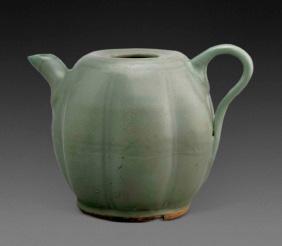

Expert remark: Compare the related melon-shaped form and celadon color, with the foot similarly burnt to orange. Note the size (13.3 cm).
Estimate EUR 6,000
Starting price EUR 3,000

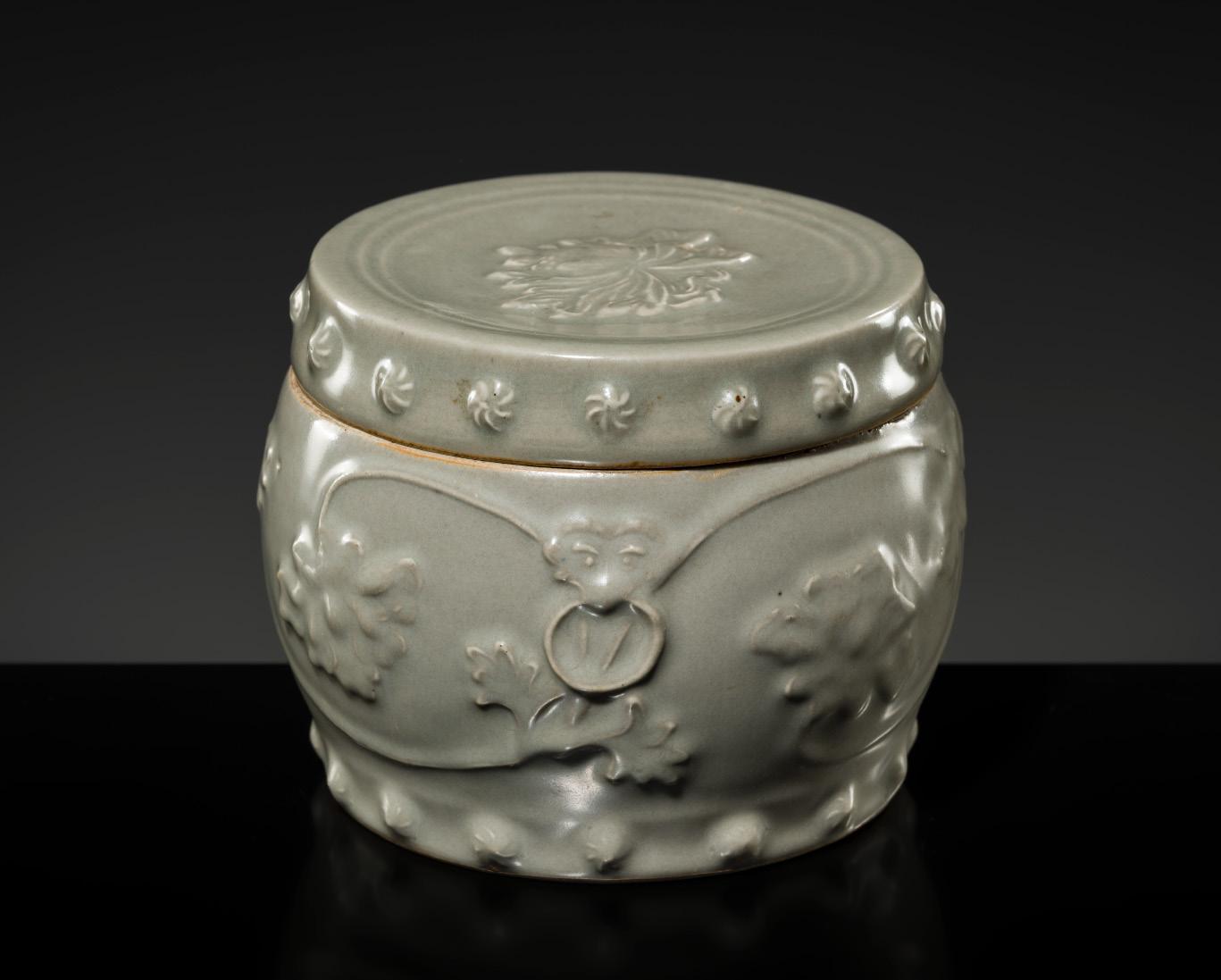
8 A RARE LONGQUAN CELADON ‘PEONY’ BARREL-FORM JAR AND COVER, SOUTHERN SONG-YUAN DYNASTY
China, 1127-1368. Finely potted with gently curved sides rising from a recessed base, delicately molded around the exterior with a continuous undulating leafy peony scroll and a pair of taotie-mask handles suspending fixed rings, all above a band of whorl bosses at the base, the slightly domed cover centered with a large peony flower head and encircled at the rim by a band of whorl bosses, the flushfitting cover similarly decorated with raised whorls, the top centered by a peony flower head. Covered overall in a soft bluish-green glaze thinning at the edges of the decoration.
Provenance: The Collection of Sam and Myrna Myers, Paris, France. Acquired between circa 1965-2012.
Condition: Excellent condition with minor wear and firing irregularities including dark spots, pitting, and glaze recesses.
Weight: 747.2 g
Dimensions: Diameter 14.6 cm
The barrel-form jar, known as a drum-form water vessel in Japan, is one of the rarest Longquan celadon forms. The decoration on the present barrel-form jar (and others in this group) is executed in a popular method used at the time, that of ‘sprig’ molding, where the decoration was molded separately and then applied to the surface before glazing.
Longquan ware is known for its large-scale production, especially during the Yuan dynasty when production increased, with some 300 kilns active in the Longquan area from the Dayao, Jincun and Xikou kiln complexes in the west to those on the Ou and Songxi rivers. This massive production not only supplied domestic market for middle- and upper-class patrons, but also supplied the international market, particularly the Middle East and Japanese clientele. More than three thousand Longquan celadon wares were also found in the cargo of the Sinan wreck, which was on its way from Ningbo to Japan in 1323, when the ship foundered off the coast of Korea. See R. Scott, Imperial Taste: Chinese Ceramics from the Percival David Foundation, Los Angeles, 1989, pp. 50-51. The rarity of barrel-form jars might be ascribed to the special function they had, and they were probably made under special commissions.
LITERATURE COMPARISON
Compare a closely related Longquan barrelform jar, 20.9 cm diameter, dated Yuan dynasty, 14th century, from the Percival David Foundation and now in the British Museum, registration number PDF.225. Compare a closely related Longquan barrel-form jar, 22.3 cm diameter, dated Southern Song-Yuan dynasty, 13th-14th century, in the Seikado Bunko Art Museum. The Seikado Bunko jar and cover is highly prized in Japan and is arguably one of the most iconic masterpieces of Longquan celadon in the world. It is designated as an Important Cultural Property in Japan and was formerly in the collection of the most prominent Edo Period (1603-1868) merchant family, the Kounoike family.
AUCTION RESULT
COMPARISON
Type: Closely related
Auction: Christie’s New York, 13 September 2019, lot 1047
Price: USD 300,000 or approx. EUR 264,000 converted and adjusted for inflation at the time of writing
Description: A very rare large Longquan celadon barrelform jar, Southern Song-Yuan dynasty



Expert remark: Compare the closely related form, decoration, and glaze. Note the different size (23.9 cm) and missing cover.
Estimate EUR 15,000
Starting price EUR 7,500

China, 1279-1368. Well potted with a compressed globular body molded on the sides with a pair of animal masks framed by foliage, raised on three feet issuing from beast masks, and surmounted by a cylindrical neck with squared handles supported by curled dragons, all below a galleried rim. The body covered inside and out with a sky-blue glaze and splashed with purple on the animal masks and handles.
Provenance: Probably ex-collection Erik Hancock (label to base). The Collection of Sam and Myrna Myers, Paris, France. Acquired between circa 1965-2012. Erik Hancock was a collector of early wares dating from the Qing dynasty, snuff bottles, soapstons, jades, horn, among others. Many of which were sold in five posthumous sales at Sotheby’s, in October and December 1973 or were acquired by Dr. Edell.
Condition: Good condition, commensurate with age. Some wear and firing irregularities including pitting and glaze recesses, old repairs to the handles, rim, and neck.
Weight: 2.5 kg
Dimensions: Height 20.2 cm
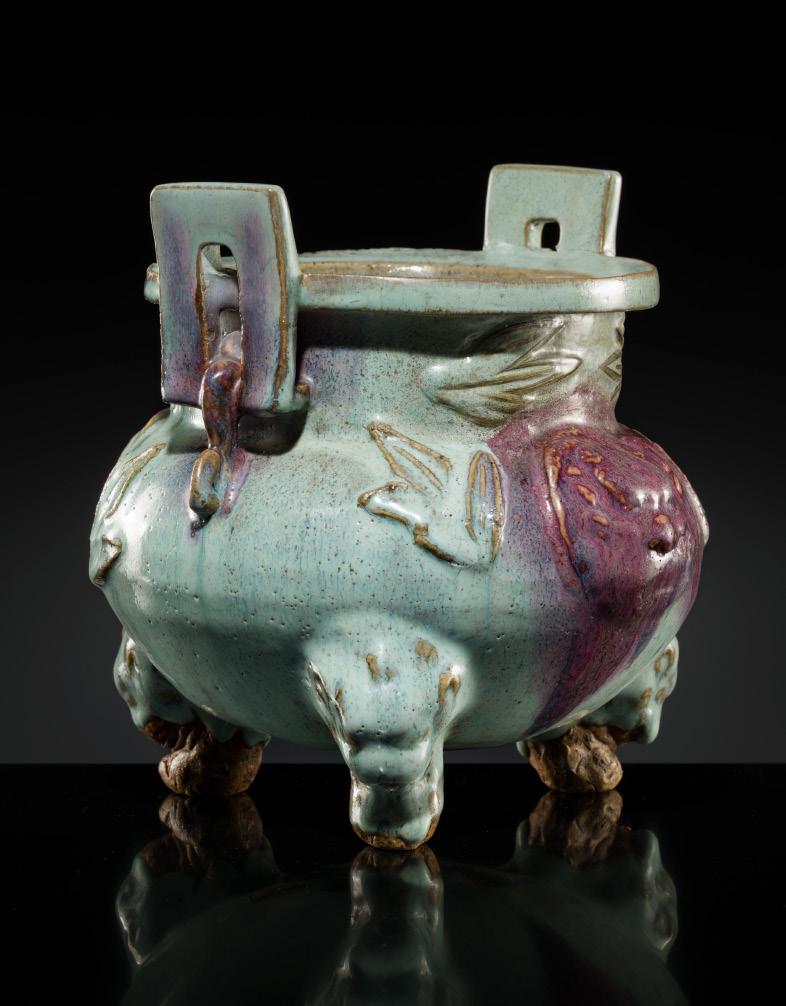



This Junyao incense burner, with its thick luminous glaze and brilliant splashes, is a fine example of its type. Wares from the Juntai kiln site in Yu county, Henan province, an area formerly known as Junzhou, are remarkable for their luscious thick glazes of intense coloration which can vary from light to deep turquoise blue. In the early 12th century potters began applying splashes of deep purplish-red derived from copper to the glaze before firing, resulting in patches of purple, lavender and tones of deep blue on the primary milky-blue glaze. As seen on this piece, these splashes often had a strong calligraphic quality and added a flamboyant effect to the vessel that was of immense appeal to the literati and nobility of the time.
Expert’s note: Junyao incense burners of this shape and with molded designs are generally attributed to the Yuan dynasty due to their similarities with a larger and more elaborately molded incense burner dated in accordance to 1309, excavated at Huhehot in Inner Mongolia, and illustrated in Sekai toji zenshu/ Ceramic Art of the World, vol. 13, Tokyo, 1981, col. pl. 103.
LITERATURE COMPARISON
Compare a closely related Jun purplesplashed censer, 24 cm high, dated to the Yuan dynasty, in the Palace Museum, Beijing, accession number 新00124533.
AUCTION RESULT COMPARISON
Type: Closely related
Auction: Christie’s New York, 22 March 1999, lot 260
Price: USD 68,500 or approx. EUR 114,000 converted and adjusted for inflation at the time of writing
Description: An unusual large junyao tripod censer, Yuan dynasty
Expert remark: Compare the closely related form, molded decoration, and splashed glaze. Note the different size (35.6 cm).
Estimate EUR 6,000
Starting price EUR 3,000



Exhibited:
1. Pointe-à-Callière Museum, From the Lands of Asia. The Sam and Myrna Myers Collection, Montréal, 17 November 2016-19 March 2017.
2. Kimbell Art Museum, From the Lands of Asia. The Sam and Myrna Myers Collection, Fort Worth, Texas, 4 March-19 August 2018.
3. Musée d’Histoire de Nantes, Les Mongols et le monde. L’autre visage de l’empire de Gengis Khan, 14 October 2023-5 May 2024.
External Expert Authentication: This lot was previously authenticated and dated by Regina Krahl, confirming the dating stated above. Krahl has written an essay for this exceptional piece, titled ‘Dragon-and-Phoenix Meiping: A Quintessential Yuan Vessel’, which is reproduced verbatim in its entirety further below, along with supplementary images selected by us.
Regina Krahl (b. 1951) is an eminent independent researcher and a leading authority on Chinese ceramics and early porcelain.

A former President of the Oriental Ceramic Society, she worked as Acting Curator of Chinese Ceramics at the British Museum, and as Academic Advisor and Consulting Curator for the Sir Percival David Collection. She acted as Curator or Advisor for many international museums including the Asia Society, Guggenheim Museum, Brooklyn Museum of Art, Arthur M. Sackler Gallery, Art Institute of Chicago, Cleveland Museum of Art, the Royal Academy of Arts in London, Musée Cernuschi in Paris, and National Museum of History in Taipei. Krahl has lectured and published widely on Chinese ceramics and other works of art. Her many publications include Chinese Ceramics in the Topkapi Saray Museum, Istanbul (3 volumes, 1986, ed. John Ayers) and Chinese Ceramics from the Meiyintang Collection (4 volumes, 1994-2010). She co-edited Ancient Trade Ceramics from The British Museum (1994), Chinese Ceramics: Highlights of the Sir Percival David Collection (2009), and Shipwrecked: Tang Treasures and Monsoon Winds (2010).
China, 14th century. Powerfully and robustly potted with high and broad shoulders sloping down towards the tapering ovoid body. Exquisitely painted in rich cobalt blue tones, the body with a central band enclosing two sinuous dragons pursuing flaming pearls amid clouds and flames, below a band with two phoenixes surrounded by leafy peony sprays and scrolling vines encircling the shoulder, and above a band of pendent lotus blossoms within tall lappets, all framed by double-line borders and divided by two further ‘empty’ white bands.
Provenance: Hôtel Drouot, Paris, circa 1990s. The Collection of Sam and Myrna Myers, Paris, France, acquired from the above. At the time of the Meiping’s sale at Drouot, “the small neck was missing”, see Sam Myers, “The Search for a Yuan Vase”, Two Americans in Paris. A Quest for Asian Art, Paris, 2016, p. 170. The neck was subsequently reconstructed by a professional restorer commissioned by Sam and Myrna Myers. Condition: Good condition, commensurate with age, and presenting superbly. Some old wear and firing irregularities, including scattered dark spots, minute pits, and kiln grit. The base with old, partially smoothed chips along the foot. The neck has been reconstructed above the very first double circle on the shoulder. A small area of touchup (approx. 3 cm long) on one of the plain bands. None of the blue and white paintwork has been affected by either repair.
Weight: 3.8 kg
Dimensions: Height 40.7 cm
PUBLISHED
1. Jean-Paul Desroches (ed.) et al, Two Americans in Paris. A Quest for Asian Art, Paris, 2016, p. 171, no. 280.
2. Pointe-à-Callière Museum, Two Americans in Paris. A Quest for Asian Art, Montréal, 2016, exhibition album, p. 41.
3. Marie Favereau (ed.) et al, Les Mongols et le monde. L’autre visage de l’empire de Gengis Khan, Musée d’Histoire de Nantes & Chinggis Khaan National Museum, 2023, p. 275.


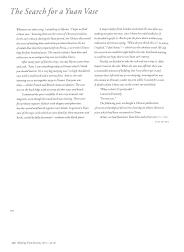








AUCTION RESULT COMPARISON
Type: Closely related
Auction: Poly Auctions, Beijing, 19 June 2018, lot 5147
Price: CNY 2,990,000 or approx. EUR 385,000 converted and adjusted for inflation at the time of writing
Description: A large blue and white meiping vase with a scene of figures, Yuan dynasty Expert remark: Compare the closely related form and decoration with similar lappet and empty white bands, peony sprays, and size (43.7 cm). Note the figural subject.
AUCTION RESULT COMPARISON
Type: Related
Auction: Poly Auctions, Beijing, 6 December 2010, lot 5273
Price: CNY 12,880,000 or approx. EUR 2,000,000 converted and adjusted for inflation at the time of writing
Description: A blue and white ‘peacock and peonies’ meiping vase, Yuan dynasty
Expert remark: Compare the related form and decoration with similar empty white bands and phoenix-and-peony design. Note the size (52.5 cm).
Estimate EUR 150,000
Starting price EUR 75,000

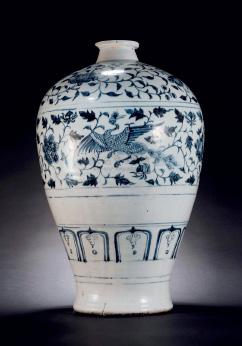
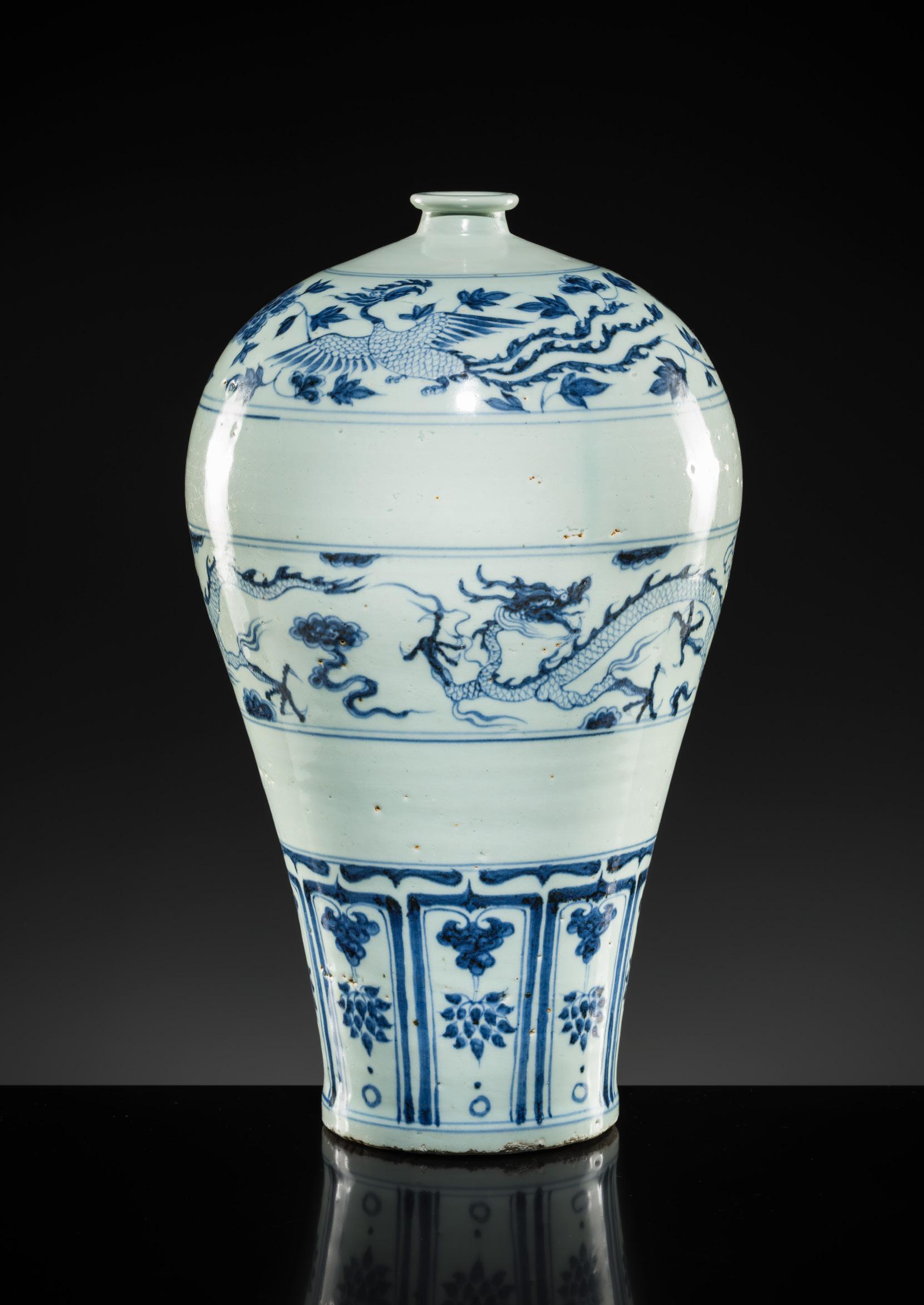
By Regina Krahl
Dragon and phoenix are ubiquitous in Yuan (1279-1368) art, but it is very rare to find a piece of Yuan blue-and-white decorated with both these mythical creatures.
In the Yuan capitals Dadu in Beijing and Shangdu in Inner Mongolia, dragons and phoenixes were ubiquitous. They decorated carved stone panels [fig. 1], posts and balustrades of palace buildings, and alternated on the greenand-yellow end tiles of palace roofs (James C.Y. Watt, ed., The World of Khubilai Khan. Chinese Art in the Yuan Dynasty, The Metropolitan Museum of Art, New York, 2010, figs 53 and 54, fig. 101, and fig. 282; Da Yuan san du/The Capital Cities of Yuan Dynasty, Capital Museum, Beijing, 2016, pp. 72-3; and Chūgoku Uchi Mōko hoppō kiba minzoku bunbutsu ten [Exhibition of cultural relics from the northern horsemen of Inner Mongolia, China], Tokyo, 1983, cat. nos 102-3 and 4).
Emperor Wenzong (r. 1330-1332), his brother and both their wives wore dragon-ornamented garments, when they had themselves immortalized as donors on a tapestry mandala [figs. 2-4] they had commissioned (Watt, op.cit., pp. 110-114 and fig. 146). Dragons and phoenixes appeared on silver ware of the period, on lacquer ware, on textiles, on Cizhou ceramics, and on a huge jade bowl in Beijing that impressed foreign visitors such as the Italian friar Odoric of Pordenone (1286–1331) (Watt, op.cit., passim). Dragon and phoenix appear also as decoration on a lute (pipa) depicted on the Juyongguan toll gate on the Great Wall outside Beijing, that was built between 1342 and 1345 (Sherman E. Lee & Wai-kam Ho, Chinese Art under the Mongols. The Yuan Dynasty (1279-1368), The Cleveland Museum of Art, Cleveland, 1968, p. 8, fig. 2).
Figs. 2-4: Emperor Wenzong (r. 1330-1332) and his brother, who would seize power in 1329 as Emperor Minzong and die under suspicious circumstances shortly thereafter, depicted in the bottom left corner of an Imperial woven Vajrabhairava mandala tapestry, dated ca. 1329, in the Metropolitan Museum of Art, object number 1992.54. Both their wives are depicted in the bottom right corner of the mandala. All four wear robes with dragon decoration.

The impression on foreign visitors of a Chinese realm frequented by dragons and phoenixes must have been overwhelming and is seen reflected, as if in mirror image, in the decoration of the Persian palace Takht-i Sulaiman, the only excavated palace site of the Mongol period in Iran. Built around the 1270s, the palace walls here were faced with local lustre tiles painted with dragon and phoenix designs [figs. 5-6] in unmistakable Yuan style (Linda Komaroff & Stefano Carboni, The Legacy of Genghis Khan. Courtly Art and Culture in Western Asia, 1256-1353, The Metropolitan Museum of Art, New York, 2002, figs 59, 97, 100-1-2, cats. 84, 86, 99-101, and p. 74).
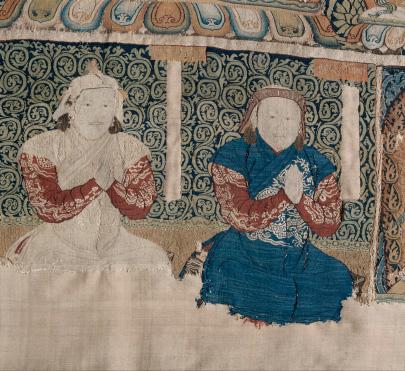


In Yuan blue-and-white decoration, the mythical creatures also feature frequently, but rarely together. Dragon and phoenix appear of course on the iconic ‘David vases’ of 1351, but there they are painted in a very different style. Peter Y.K. Lam has discussed dragon designs on Yuan blue-and-white in a symposium in Shanghai, and has discerned five different manners of dragon representation (Peter Y. K. Lam, ‘Dragons on Yuan Blue-andWhites as Seen from the Bands on the David Vases’, in Li Zhongmou et al., eds, Youlan shencai. 2012 Shanghai Yuan qinghua guoji xueshu yantaohui lunwenji/Splendors in Smalt. Art of Yuan Blue-and-white Porcelain Proceedings, Shanghai, 2015, vol. 2, pp. 194-205, fig. 7). The five types of dragons do not seem to signal different periods of creation, however, but perhaps different workshops or different destinations of the final products.
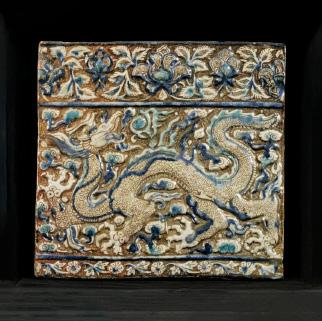

What is particularly unusual on the present meiping is its sparse style of decoration, with bands of blue design alternating with bands in plain white. This style is extremely rare and the only closely related vases appear to be four meiping discovered in the famous hoard of over two hundred pieces of blue-and-white, underglaze-red and monochrome white Jingdezhen porcelains and Longquan celadons of the Yuan dynasty, discovered in Gaoan, a county southwest of Nanchang, not far from Jingdezhen (Liu Jincheng, ed., Gaoan Yuandai jiaocang ciqi/The Porcelain from the Cellar of the Yuan Dynasty in Gao’an, Beijing, 2006).
5-6: Two tiles from the Persian palace Takht-i Sulaiman exemplifying the adaptation of Chinese imagery by Persian artists during the 13th century: one depicting a dragon in the Victoria & Albert Museum, accession number 541-1900, and the other in the Metropolitan Museum of Art, object number 12.49.4.
The Gaoan hoard is believed to have belonged to the influential Wu family of Wujiacun [‘Wu Family Village’] at Shangquan in Gaoan. Two members of that family are particularly noted, Wu Xingfu, a consort of an Imperial princess, and his son Wu Liangcheng, both government officials at Dadu, the principle Yuan capital, in the latter part of the dynasty. Wu Liangcheng is believed to have returned to his home village and to have buried the family treasures before the fall of the Yuan dynasty. The hoard most likely dates from the time when peasant revolts rocked the area, particularly in the 11th and 12th years of the Zhizheng reign (1341-1368).



The hoard contained a total of six blue-and-white meiping [fig. 7], all of similar size as the present piece but with covers, four very similarly decorated and two with floral designs replacing dragons and phoenixes (ibid., frontispiece and pp. 52-63). These six blue-and-white meiping were each inscribed in ink on the bases and inside the covers with the term for one of the six ‘arts’ desirable for a Confucian-educated gentleman to master: rites (li), rulership (yu), mathematics (shu), calligraphy (shu), music (yue), and shooting (she) – a most unusual treatment, but one that is considered to be in keeping with the ideology of Wu Liangcheng, who is known to have been a strong advocate of the Confucian classics.
The Gaoan meiping are very similarly decorated with pairs of phoenixes, distinguished by their tails, hovering among peonies – a combination signalling wishes for wealth and honour –, pairs of dragons among clouds, one looking forward, one turning back, and lotus blossoms in petal panels. Only three of the Gaoan pieces, however, also feature four-clawed dragons like the present vase, while on the fourth the dragons are three-clawed. The painting manner of the dragons and phoenixes on our vase differs from that of the Gaoan vases and does not appear to be by the same hand, but the lotus-filled petals around the base are very similar particularly to two of the Gaoan meiping and may well have been added by the same painter.

A decoration in bands, separated by plain white areas, is otherwise extremely rare, but can also be seen on the much published meiping [fig. 9] from the collection of Ataka Eiichi, now in the Museum of Oriental Ceramics, Osaka, where the upper band, however, shows a lotus scroll, the central one a peony scroll, and the shape is somewhat different in its proportions; see Tōyō tōji no tenkai/Masterpieces of Oriental Ceramics, The Museum of Oriental Ceramics, Osaka, 1999, pl. 32; and Mikami Tsugio, Sekai tōji zenshū/Ceramic Art of the World, vol. 13: Ryō, Kin, Gen/Liao, Chin and Yüan Dynasties, Tokyo, 1981, col. pl. 58.
with similar empty bands and lappet border around the foot, dated to the Yuan dynasty, 14th century, 38.1 cm high, in the Museum of Oriental Ceramics, Osaka, accession number 00539.
Meiping are believed to have been used for storing wine and are in wall paintings in tombs often depicted in connection with the preparation of feasts [figs. 10-11]. Dragons and phoenixes often form the decoration of yuhuchun bottles and stem bowls, which in banquets may have been used together with meiping; see Youlan shencai. Yuandai qinghua ciqi teji/Splendors in Smalt. Art of Yuan Blue-and-white Porcelain, Shanghai Museum, Shanghai, 2012, cat. nos 21, 66, and 75-77.

This fact and the rarity of this general decoration style with white borders between the design friezes, which in the Gaoan hoard is also found on a pair of guan jars [fig. 8] (ibid., pp. 48-51), strongly suggest that the present vase was done at the same time as those of the Wu family – presumably prior to the 1350s – and may have had a Chinese owner of similar standing. This style of decoration is not associated with Yuan blue-and-white exported abroad, and Liu Jincheng (ibid., p. 12 and p. 23) stresses the fact that such rare and important porcelains could only have been obtained by the Wus due to their close contacts to the Imperial house. This ethereal design concept was probably more in line with Chinese taste than the horror-vacui painting manner of most Yuan blue-and-white wares, which in the collector’s handbook Gegu yaolun (The Essential Criteria of Antiquities) by Cao Zhao of 1388 were still dismissed as


the Journal of The Korean Society of Food Culture, vol. 30, no. 5, p. 600, figs. 3 and 4.

China, 1279-1368. The body of pear-form supported on a splayed foot and rising to a waisted neck with a galleried rim, the neck flanked by two horned dragon-head handles biting into fishtails that suspend rings. The body further incised with birds above a register of zigzag lines and scrolls, the neck is decorated with stiff leaves, all divided by raised bow strings. The body covered overall in a pale blueishwhite glaze save for the base, revealing the white ware.
Provenance: The Collection of Sam and Myrna Myers, Paris, France. Acquired between circa 1965-2012.
Condition: Very good condition with minor wear, a thin hairline to one beast handle, and firing irregularities including warping, few small firing cracks, dark spots, minor kiln grit, and little fritting.
Weight: 1.5 kg
Dimensions: Height 31.3 cm
Literature comparison: Compare a related smaller Qingbai vase with dragon-headed handles, 18.7 cm high, dated to the Yuan dynasty, in the Saint Louis Art Museum, accession number 147:2014. Compare two related Qingbai vases, 19.6 cm and 30.5 cm high, dated to the Yuan dynasty, recovered from the Sinan shipwreck and now in the National Museum of Korea, accession number Sinan6683, illustrated by Lee Taehee, “Sinan Shipwreck Collection at the National Museum of Korea”, in Journal of Korean Art and Archaeology, vol. 5, pp. 105-116, figs. 12 and 13. Compare a related larger Qingbai vase with carved and incised decoration, dated Yuan-Ming dynasty, 54.6 cm high, in the British Museum, registration number 1937,0716.136.
AUCTION
RESULT
COMPARISON
Type: Related
Auction: Christie’s New York, 22 March 2013, lot 1448
Price: USD 6,250 or approx. EUR 7,400 converted and adjusted for inflation at the time of writing
Description: A Qingbai carved ovoid vase, Yuan dynasty

Expert remark: Compare the related pale blue glaze, pear-shaped form, carved decoration, and dragon-form handles suspending flat attached rings, albeit in a flattened and simplified variation. Note the related size (33.5 cm).
Estimate EUR 6,000
Starting price EUR 3,000
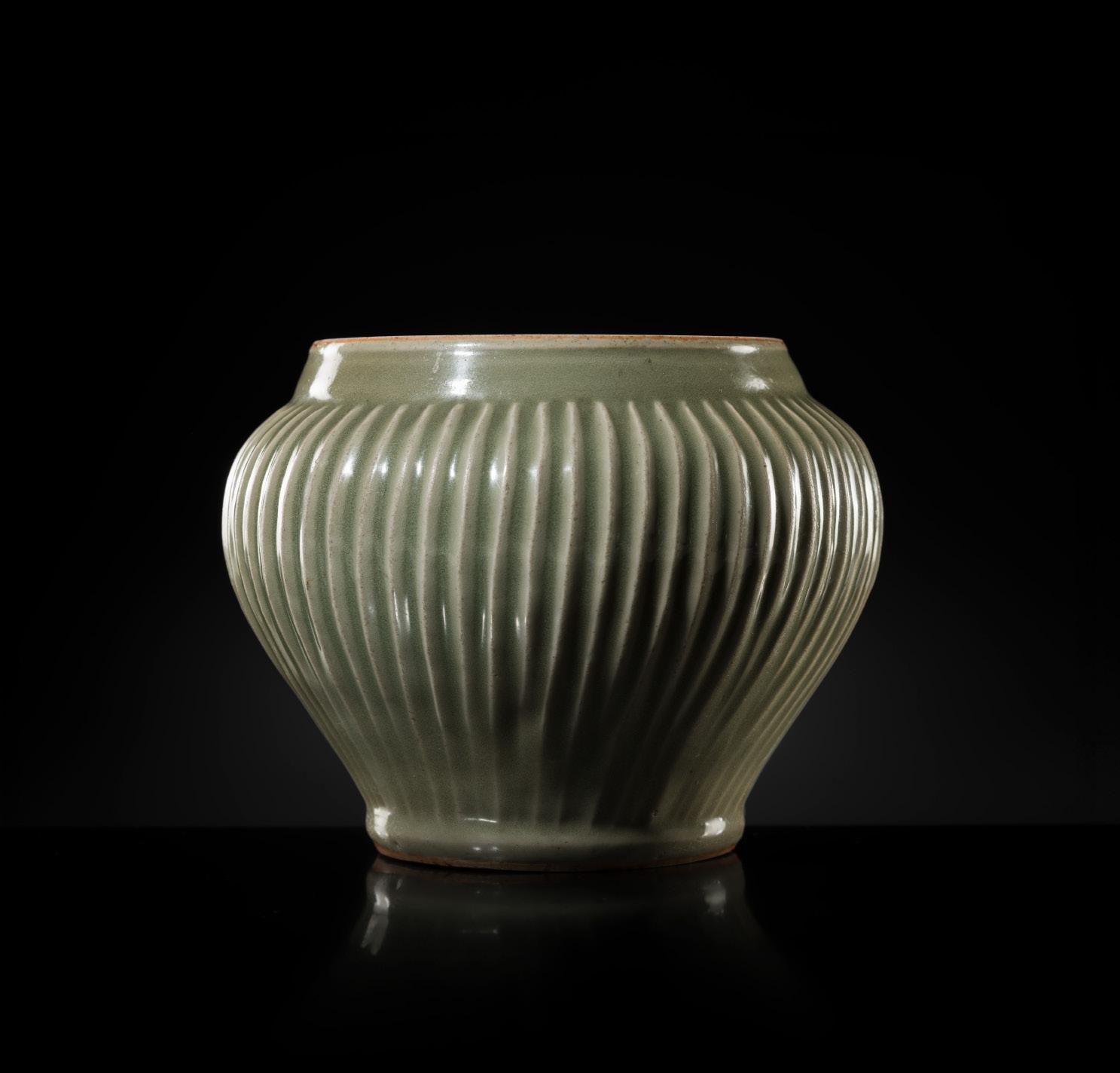
China, 14th-15th century. Finely and heavily potted with a swelling high-shouldered body supported on a thick foot and rising to a tapered neck, molded with vertical ribs extending from below the short neck to the thick foot, and covered overall with a finely crackled glaze of olive-green tone thinning to pale green on the ribs and stopping at the foot, exposing the buff ware.
Provenance: The Collection of Sam and Myrna Myers, Paris, France.
Acquired between circa 1965-2012.
Condition: Very good condition with expected wear and firing irregularities, two old small chips to the upper rim, and light surface scratches. The cover lost.
Weight: 2.4 kg
Dimensions: Height 16.7 cm, Diameter 21 cm
Large ‘Longquan’ jars of this elegant form and ribbed design were much favored by the export market during the Yuan dynasty and can be found in overseas collections. For example, see a similar jar recovered from the ship wrecked off the coast of Korea in 1323 AD, illustrated in Relics Salvaged from the Seabed Off Sinan, Materials I, Seoul, 1985, pl. 31, fig. 38.
LITERATURE COMPARISON
Compare a closely related Longquan jar, 15.5 cm diameter, dated to the Yuan dynasty, in the National Museum of Korea, accession number Sinan140 (fig. 1). Compare a closely related Longquan jar, 13.3 cm diameter, dated to the Yuan dynasty, formerly in the collection of the Austrian ambassador Alexander Otto and now in the USC Pacific Asia Museum, Pasadena, accession number 1994.46.6.
AUCTION RESULT COMPARISON
Type: Closely related
Auction: Christie’s New York, 19 March 2009, lot 710
Price: USD 50,000 or approx. EUR 64,500 converted and adjusted for inflation at the time of writing
Description: A Longquan celadon ‘hundred rib’ jar, guan, Ming dynasty, 14th-15th century
Expert remark: Compare the closely related form, ribbed decoration, and celadon glaze, albeit of a more sea-green tone than the present lot. Note the size (22.9 cm).
Estimate EUR 4,000
Starting price EUR 2,000
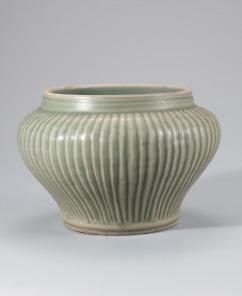

Exhibited:
1. Pointe-à-Callière Museum, From the Lands of Asia. The Sam and Myrna Myers Collection, Montréal, 17 November 2016-19 March 2017.
2. Kimbell Art Museum, From the Lands of Asia. The Sam and Myrna Myers Collection, Fort Worth, Texas, 4 March-19 August 2018.
China. Superbly potted, the flattened spherical body raised on a quatrefoil foot and surmounted by a waisted neck terminating in a cone-form mouth set with two strap handles. Boldly decorated, the sides each with a central medallion that is slightly concave and encloses a subtly painted and charming image of a hare peeking out from behind a conch amid turbulent waves encircled by a band of lotus petals and a wider band of of arabesque lotus scroll, the neck with stiff upright leaves below the tall mouth with bands of alternating lingzhi and blossoms, trefoil ruyi-heads, and key-fret.
Provenance: The Collection of Sam and Myrna Myers, Paris, France. Acquired between circa 1965-2012.
Condition: Good condition with some old wear, firing irregularities including few dark spots, small glaze recesses, and tiny firing cracks to the interior and base. Slightly leaning. Light surface scratches, touchups to one side of the foot and lower body as well as the upper rim.
Weight: 1 kg
Dimensions: Height 24.3 cm
This elegant porcelain is a fine example of the technical and decorative excellence of Ming dynasty blue-and-white wares. The flat-sided flask is known in bronze vessels dating to the sixth century BC in China, but the particular form of this vessel, with its angled, tubular neck and loop handles, is based on Islamic metal prototypes. The flask was constructed from several pieces of molded clay that were joined before firing. The density of the design is characteristic of early fifteenth-century products of the Yongle (1403-24) or Xuande (1426-35) eras of the early Ming dynasty.
Literature comparison: Compare a closely related blue and white flask, dated to the early 15th century, 33.3 cm tall, formerly in the collection of Sir Percival David and now in the Kimbell Art Museum, accession number AP 1968.11. Compare a closely related blue and white moon flask, 34 cm tall, in the National Museum of Ceramics Duca di Martina, Naples, inventory number 1500291689.




PUBLISHED
Jean-Paul Desroches (ed.) et al, Two Americans in Paris. A Quest for Asian Art, Paris, 2016, p. 177, no. 286.
AUCTION RESULT COMPARISON
Type: Closely related
Auction: Christie’s New York, 25 March 2022, lot 1108
Price: USD 35,280 or approx. EUR 33,500 converted and adjusted for inflation at the time of writing
Description: A blue and white moonflask, bianhu, Ming dynasty, late 15th-early 16th century
Expert remark: Compare the closely related form and decoration. Note the size (34.4 cm).
AUCTION RESULT COMPARISON
Type: Closely related
Auction: Christie’s New York, 22 March 2019, lot 1630
Price: USD 30,000 or approx. EUR 32,500 converted and adjusted for inflation at the time of writing
Description: A rare blue and white moon flask, bianhu, Ming dynasty, late 15th-early 16th century
Expert remark: Compare the closely related form and decoration. Note the size (35 cm).
Estimate EUR 10,000
Starting price EUR 5,000



China. The square body with canted corners, surmounted by a tall cylindrical neck flanked by two handles issuing from beast masks, all supported on a splayed foot. The exterior finely painted in cobalt blue with blossoming vines of morning glory between line borders at the foot and mouth, and the beast masks highlighted in blue.
Provenance: Couturier & Nicolay, Paris, France, 21 March 1974. The Collection of Sam and Myrna Myers, Paris, France, acquired from the above. A copy of an invoice from Couturier & Nicolay, Paris, France, dated 21 March 1974, accompanies this lot. Note that on this invoice, the present lot is dated as “Epoque Yong-tcheng” and described as “Petit vase quadrangulaire” (small quadrangular vase).
Condition: Good original condition with some old wear and firing irregularities including tiny firing cracks to the interior. Some fritting, the rim with a shallow chip.
Weight: 449 g
Dimensions: Height 15.5 cm

The Xuande Emperor (r. 1426–1435), a talented artist and major patron of the arts, oversaw the production of exceptionally high-quality Imperial porcelain. By the Jiajing period (1522–1566), these porcelains were already considered superior to Song dynasty wares. Xuande blue-and-white porcelains were especially prized and remained so into the Qing dynasty, even being gifted to the Kangxi Emperor on his birthday.
The complex form of the vase meant it had to be made in sections. The two animal mask handles were made from a carved mold, and their striking appearance and fine details demonstrate the outstanding skills of the potter. Similarly, the core body, consisting of an upper and lower section, was made from a mold and luted together, while the neck and the high foot were made separately. Such a complicated form is not only very difficult to construct, but also much easier to become deformed during firing than round vessel shapes, so that the success rate for such faceted vases must have been very low, thus making them very rare.
Morning glory had been popular in China for a few centuries but was not used as the primary decorative motif on other porcelains, thus porcelains with this motif are generally quite rare.
Xuande faceted vases appear to have been a particular favorite of the Yongzheng Emperor. Two extant handscrolls of the Yongzheng period, dated in accordance with 1728 and 1729 respectively, depict works of art from the Imperial collection including four such vases, all shown on different wooden stands; see Regina Krahl, “Art in the Yongzheng Period: Legacy of an Eccentric Art Lover”, Orientations, November/December 2005, pl. 2.
EXPERT’S NOTE
At least two Xuande vases of this type without reign marks are known. One is in the National Palace Museum, Taipei, included in the museum’s Special Exhibition of Selected Hsuan-te Imperial Porcelains of the Ming Dynasty, Taipei, 1998, cat. no. 15. The other is in the Asian Art Museum of San Francisco, object number B69P22L (fig. 1), published in He Li, Chinese Ceramics: A New Standard Guide, London, 1996, pl. 408, and also in Clarence F. Shangraw, “Fifteenth-Century Blue-and-White Porcelain in the Asian Art Museum of San Francisco,” Orientations, May 1985, pp. 34–46.

1
Dating this vase is inherently challenging. The painting is entirely freehand, and the cobalt blue is exceptionally intense. The morning glory blossoms lack the refinement seen on imperial examples, yet the masks are far more expressively modeled, and the painting gives them a vivid, almost animated quality. The form and construction—assembled from multiple parts, a technically demanding process—are identical to the imperial Xuande vases. However, the proportions differ, which excludes this vase from belonging to the same series as the imperial examples.
This piece is either an early prototype predating the Xuande vases or a later work from the 15th or 16th century, possibly even early 17th century during the Transitional period. Without TL testing (impossible due to the small size) or direct comparison with reference pieces, a precise date cannot be established.
What is certain is that this is a fascinating and extremely rare example. It is not a copy of the Xuande vases. Anyone capable of constructing such a complex form could have easily imitated Xuande painting if that had been the intention. This alone strongly argues for an early prototype from before or at the very beginning of the Xuande period, in the first half of the 15th century.
Literature comparison: Compare a related blue and white vase with morning glories, formerly in the Percival David Foundation (where it was dated mid-15th century and the reign mark described as “poorly written”) and now in the British Museum (where it is dated to the Xuande period), registration number PDF,A.633, and another related example with a Xuande mark and of the period, in the Palace Museum, Beijing, illustrated in The Complete Collection of Treasures of the Palace Museum, Blue and White Porcelain with Underglaze Red (I), vol. 34, Hong Kong, 2000, p. 99, no. 93.
AUCTION RESULT COMPARISON
Type: Related
Auction: Sotheby’s London, 13 May 2015, lot 38
Price: GBP 3,845,000 or approx. EUR 7,000,000 converted and adjusted for inflation at the time of writing
Description: A rare blue and white facetted vase, Xuande mark and period
Expert remark: Compare the closely related form, decoration, and motifs. Note the Xuande reign mark and the size (13.8 cm).
Estimate EUR 15,000
Starting price EUR 7,500


Exhibited:
1. Pointe-à-Callière Museum, From the Lands of Asia. The Sam and Myrna Myers Collection, Montréal, 17 November 2016-19 March 2017.
2. Kimbell Art Museum, From the Lands of Asia. The Sam and Myrna Myers Collection, Fort Worth, Texas, 4 March-19 August 2018.
Scientific Analysis Report: A thermoluminescence analysis report issued by Oxford Authentication on 30 November 2006, based on sample number P206c24, sets the firing date of the sample taken between 400 and 700 years ago, consistent with the dating above. A copy of the report accompanies this lot.
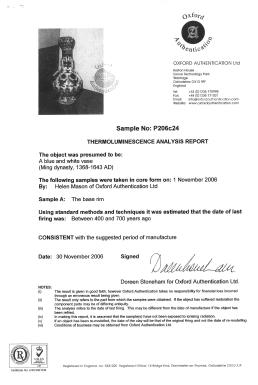
China, 1572-1620. Finely potted, the pear-shaped body raised on a tall splayed foot and terminating in a lotiform ‘garlic-head’ mouth pierced at the top to simulate a seed pod. The body molded with two bands of notched flanges above three rows of lotus petals similar to those found on the mouth. The exterior painted in shades of cobalt blue with Buddhist wheels amid scrolling clouds and wispy flames, below a band of lingzhi, all divided by the flanges. The foot decorated with the terrestrial diagram amid crashing waves and clouds.
Provenance:
Bonhams London, 5 November 2007, lot 189, sold for GBP 7,200 or approx. EUR 16,500 (converted and adjusted for inflation at the time of writing).
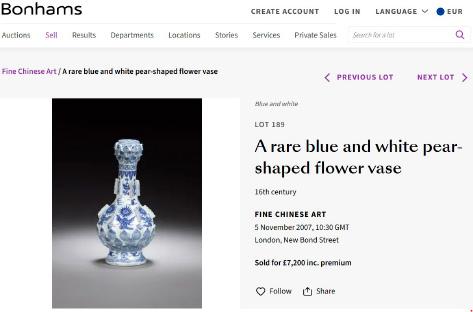
The Collection of Sam and Myrna Myers, Paris, France, acquired from the above.
Condition: Good condition with minor wear and firing irregularities including dark spots and small firing cracks, the vase leaning slightly, minor fritting to exposed areas, the foot with two fills to drilled holes from sample-taking.
Weight: 921 g
Dimensions: Height 27.5 cm
EXPERT’S NOTE
The form of this vase is based on bronze prototypes dating from the Han period, also decorated with garlic heads, see one example in the National Palace Museum, Taipei, object number 中銅001232N000000000. The overall form and flanges encircling the body and neck can also been observed in a group of blue and white arrow vases, see one example dated to the Wanli period from the Percival David Foundation and now in the British Museum, registration number PDF,A.662 (fig. 1)
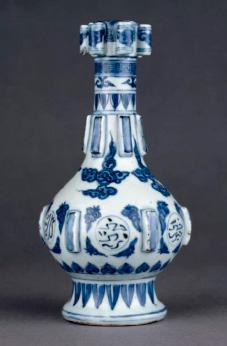
fig. 1




PUBLISHED

LITERATURE COMPARISON
Compare a closely related blue and white garlic-head vase with similar form, pierced mouth, and notched flanges, dated to the Jiajing period, 31.1 cm high, in the Victoria & Albert Museum, accession number C.100-1928 (fig. 2). Compare a related molded blue and white vase with lotus petals, dated to the Wanli period, 25 cm high, in the British Museum, registration number 1927,0618.1.
Estimate EUR 10,000
Starting price EUR 5,000

fig. 2
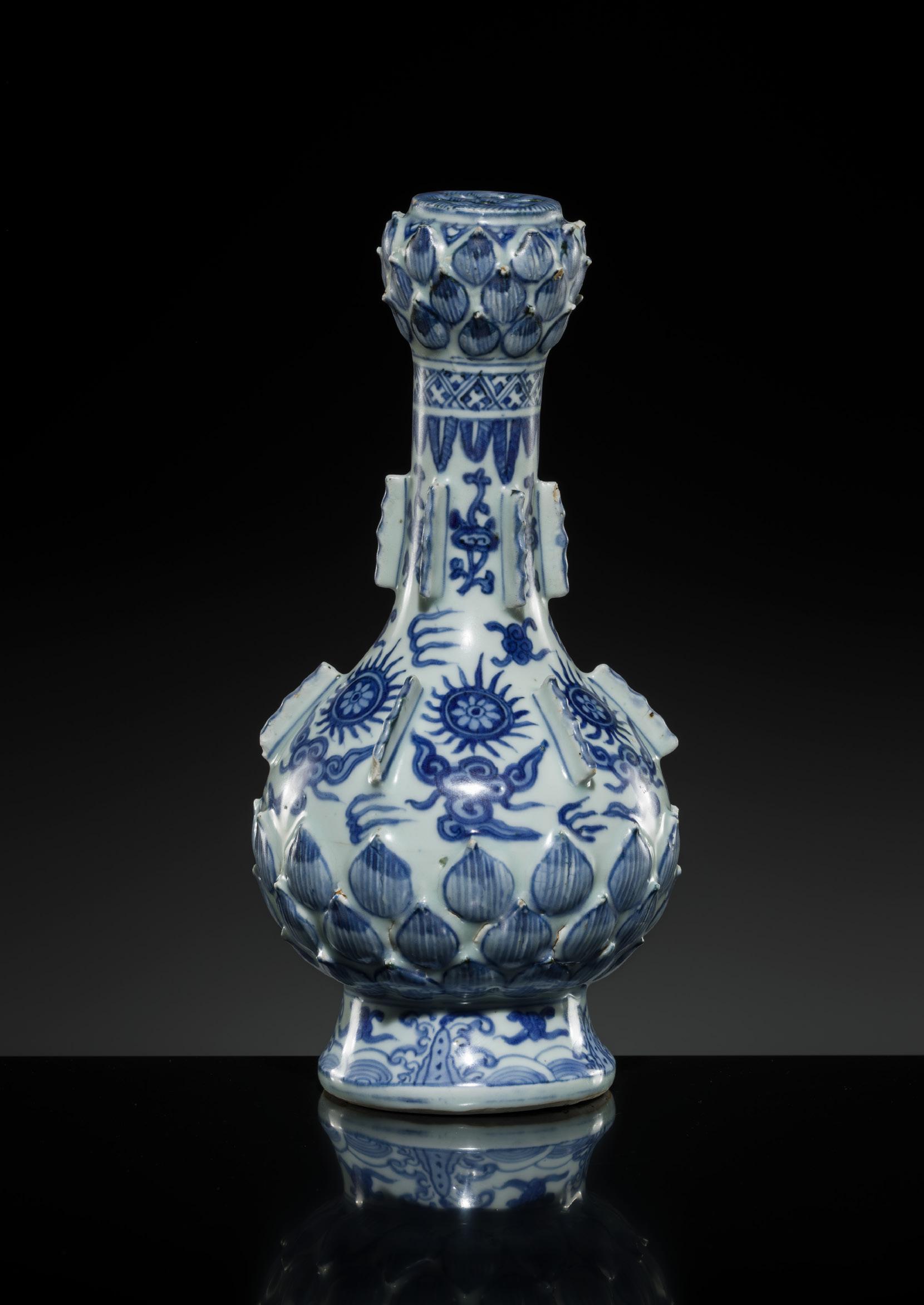

A JUNYAO ‘LOTUS BUD’ MINIATURE WATER DROPPER, MING DYNASTY
China, 1368-1644. The bud-shaped body supported on a tapering foot and rising to a small circular mouth, covered overall in a thick sky-blue glaze applied with two splashes of deep lavender color. The foot ring left unglazed to reveal the buff ware burnt to orange during firing.
Provenance: The Collection of Sam and Myrna Myers, Paris, France. Acquired between circa 1965-2012.
Condition: Very good condition with minor wear and firing irregularities, few tiny glaze flakes, intentional crackling, a small glaze fill to the upper rim.
Weight: 119 g
Dimensions: Height 6.7 cm
Traditionally this type of ware is classified as ‘soft’ Jun. Scholars are unsure where this type of Jun ware was made, and so in the absence of a kiln site, they are dated stylistically by comparison to other pieces.
LITERATURE COMPARISON
Compare a closely related Junyao stoneware waterdropper, also of pear form, dated to the Ming dynasty, 8.6 cm tall, in the British Museum, museum number PDF.52.

AUCTION RESULT COMPARISON
Type: Related
Auction: Bonhams London, 13 May 2024, lot 8
Price: GBP 5,760 or approx. EUR 7,000 converted and adjusted for inflation at the time of writing
Description: A Jun ware ‘lotus-bud’ miniature waterdropper, Song/Jin dynasty
Expert remark: Compare the similar form and glaze. Note the size (5.5 cm), spout, and earlier dating.
Estimate EUR 3,000
Starting price EUR 1,500


China, 16th century. The slightly domed top with a central mouth encircled by lotus petals, surrounded by rectangular and circular apertures for brushes and ink sticks separated by ruyi-heads against a diapered ground, the sides similarly painted in inky shades of cobalt blue to depict a continuous palace garden scene with scholars engaged in leisurely pursuits such as painting, reading, playing music, and weiqi (go).

Provenance: The Collection of Sam and Myrna Myers, Paris, France. Acquired between circa 1965-2012.
Condition: Overall well-preserved with minor wear and firing irregularities including dark spots and small firing cracks, little fritting, a circumferential crack above the foot with minor associated glaze flakes and remnants of adhesive.
Weight: 983 g
Dimensions: Diameter 14.5 cm
The use of this vessel is clarified by a painting in the Princeton University Art Museum, accession number y1979-95, depicting the famous philosopher Wang Yangming (1472-1529) seated at his writing desk which illustrates a similar ink stand on his desk with three brushes placed in it, together with a small vase of flowers, an inkstone, and a water dropper or paperweight. The rectangular section is naturally assumed to hold an inkstick as confirmed by the late Ming scholar Wen Zhenheng, who in Zhang wu zhi (A Treatise on Superfluous Things) under the heading of brushpots wrote: ‘[...] there are also drum-shaped ones with holes in them for inserting brushes and ink.’
AUCTION RESULT COMPARISON
Type: Closely related
Auction: Bonhams London, 3 November 2022, lot 1
Price: GBP 20,400 or approx. EUR 26,500 converted and adjusted for inflation at the time of writing
Description: A blue and white circular brush and ink stand, Chang ming fu gui mark, late 16th century

Expert remark: Compare the closely related form, decoration, and size (13 cm). Note the different motifs and auspicious four-character mark.
Estimate EUR 4,000
Starting price EUR 2,000

18 A KINRANDE EWER, 16TH CENTURY
Exhibited:
1. Pointe-à-Callière Museum, From the Lands of Asia. The Sam and Myrna Myers Collection, Montréal, 17th November 2016-19th March 2017.
2. Kimbell Art Museum, From the Lands of Asia. The Sam and Myrna Myers Collection, Fort Worth, Texas, 4th March-19th August 2018.
China. The ewer with a pear-shaped body decorated in gilt, iron red, green, turquoise and black enamels with two large teardrop-shaped panels depicting a gilt peacock on the iron-red diaper ground, and with two peony sprig-filled quatrefoil panels, one positioned beneath the S-shaped strut that attaches the elongated spout to the waisted neck, the other below the slender, arched handle on the opposite side.
Provenance: The Collection of Sam and Myrna Myers, Paris, France, acquired in April 2006.
Condition: Good condition with minor wear, some rubbing to the ironred and gilt, and firing irregularities including kiln grit to the base. The cover lost.
Weight: 547 g
Dimensions: Height 20.4 cm
This brightly painted porcelain ewer illustrates a vivid cross-medium exchange of artistic design during the sixteenth century. The form is based on a metal wine ewer, while the bright red enamel embellished with golden birds and flowers is clearly inspired by luxury lacquerware. The turquoiseblue enamel resembles similar colors commonly found on cloisonné and adds a fresh touch to the red-gold surface. This style of overglaze enamels and gold is known by the Japanese name kinrande, meaning ‘gold brocade’, as they have been particularly appreciated in Japan. Although the details of decoration differ, the peach-shaped panel of these ewers is usually covered with iron red enamel and then gilded designs are applied.
PUBLISHED
Jean-Paul Desroches (ed.) et al, Two Americans in Paris. A Quest for Asian Art, Paris, 2016, p. 256, no. 402 (illustrated together with a cover that is now lost).



Type: Closely related
Auction: Christie’s New York, 23 March 2018, lot 727
Price: USD 15,000 or approx. EUR 16,500 converted and adjusted for inflation at the time of writing
Description: A kinrande ewer and cover, Ming dynasty, 16th century Expert remark: Compare the closely related form and decoration. Note the size (25.4 cm).
Estimate EUR 6,000
Starting price EUR 3,000

China, Wanli period (1573-1619). Modeled in mirror image, each bushy-tailed beast seated on a rectangular plinth with a front paw resting on a brocade ball, the head with black-accentuated bulging eyes and jaws open revealing fangs and tongue, turned sharply to the side and framed by a knobby collar and spine detailed with mane curls and fur tufts. (2)
Provenance: The Collection of Sam and Myrna Myers, Paris, France. Acquired between circa 1965-2012.
Condition: Wear and firing flaws, minor chips to edges, old repairs.
Weight: 742 g and 774 g
Dimensions: Height 13.4 cm and 12.9 cm
AUCTION RESULT COMPARISON
Type: Closely related
Auction: Christie’s London, 6 November 2013, lot 846
Price: GBP 10,000 or approx. EUR 18,500 converted and adjusted for inflation at the time of writing
Description: A Chinese blue and white model of a Buddhist lion, Wanli period (15731619)
Expert remark: Compare the related subject and color of the glaze. Note the size (24.1 cm).
Estimate EUR 4,000
Starting price EUR 2,000


China, 1573-1619. The vase of double-gourd form with a slender waist and terminating in a tapering neck, the bulbs richly decorated in iron-red, underglaze blue, and yellow, light and dark green enamels with scrolling tendrils, leafy vines, flames, and wan symbols surrounding double-gourds enclosing the characters ‘daji (good fortune)’. The upper bulb with a conch and bell alternating with the double gourds. The waist highlighted with a band of classic blue scrolls above an iron-red ground and the neck with petal lappets.
Provenance:
Tsui Museum of Art, Hong Kong. Christie’s New York, 20 September 2013, lot 1294, sold for USD 22,500 or approx. EUR 26,500 (converted and adjusted for inflation at the time of writing).
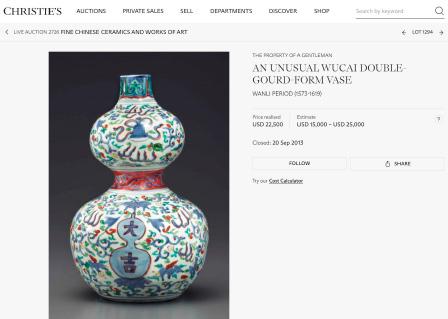
Weight: 1.2 kg
Dimensions: Height 27.3 cm
LITERATURE COMPARISON

Dr. Tsui Tsin Tong (1941-2010)
The Collection of Sam and Myrna Myers, Paris, France, acquired from the above. The base with three old labels, ‘Palace Museum Beijing # 38, Polychrome Porc. H.K. 1999 No 29’, ‘811’, and ‘M.5290’. Dr. Tsui Tsin Tong (1941-2010) was a Hong Kong entrepreneur, philanthropist, and connoisseur of Chinese antiques. He was also a Hong Kong member of the Standing Committee of the Chinese People’s Political Consultative Conference. Tsui began collecting antiques in the 1970s and later exhibited pieces of his collection in the Tsui Museum of Art, a gallery within the Hong Kong Heritage Museum. His collection included over 700 pieces of art and antiquities, mainly focusing on ceramics ranging from painted pottery of the Neolithic period to the porcelain of the Qing dynasty. Dr. Tsui also founded the Tsui Art Foundation and loaned a part of his collection to the University Museum and Art Gallery, Hong Kong, the Hong Kong Heritage Museum, and has made donations to galleries in Australia, England, and the United States.
Condition: Overall good condition with expected wear and firing irregularities including minor pitting, few thin hairlines at the neck and shoulder, the upper neck with minor areas of restoration, each smaller than a thumbnail. Little glaze flaking and rubbing to enamels, light surface scratches.
Compare a vase of identical design and size in the Palace Museum, Beijing, illustrated in The Complete Treasures of the Palace Musuem, Porcelains in Polychrome and Contrasting Colors, vol. 38, 1999, Hong Kong, p. 32, no. 29.

AUCTION RESULT COMPARISON
Type: Related
Auction: Christie‘s Hong Kong, 30 May 2023, lot 2802
Price: HKD 352,800 or approx. EUR 40,000 converted and adjusted for inflation at the time of writing
Description: A rare large polychrome double-gourd vase, Wanli period (15731619)
Expert remark: Compare the related form and decoration. Note the size (39.7 cm).
Estimate EUR 15,000
Starting price EUR 7,500


China, c. 1620. The vase of cylindrical form, tapering towards the recessed foot, set with high rounded shoulders supporting the cylindrical neck with lipped rim, and painted in shades of cobalt blue to depict a dense scrollwork issuing lotus blossoms, below a ruyi-head border encircling the shoulder, the neck with geese in flight amid ruyi clouds, all above a band depicting a qilin, dragon, lion, and longma amid turbulent waves.
Provenance: Millon, Paris, 2 July 1997, lot 182. The Collection of Sam and Myrna Myers, Paris, France, acquired from the above.
Condition: Good condition with minor wear, manufacturing irregularities including small firing cracks and minuscule pits. The luting line above the foot with associated glaze losses, a star-crack to the shoulder with a small associated chip, expected minor fritting, two small chips to the mouth rim.
Weight: 6 kg
Dimensions: Height 47.3 cm
Expert’s note: A similar vase in the Phoenix Art Museum, Matthew Wong Collection, is illustrated by Stephen Little in Chinese Ceramics of the Transitional Period: 1620-1683, New York, 1984, p. 39, no. 2, where the author notes that the shape, which is unique to this period, is a cross between the traditional meiping and the cylindrical-form vases of the Chongzhen period.
AUCTION RESULT COMPARISON
Type: Closely related
Auction: Christie’s Hong Kong, 29 May 2007, lot 1460
Price: HKD 216,000 or approx. EUR 37,500 converted and adjusted for inflation at the time of writing
Description: A fine late Ming large blue and white jar, Wanli period
Expert remark: Compare the related decoration and motifs with similar lotus scroll. Note the size (37.5 cm) and different form.
AUCTION RESULT COMPARISON
Type: Related
Auction: Christie’s Hong Kong, 30 November 2011, lot 2993
Price: HKD 500,000 or approx. EUR 78,500 converted and adjusted for inflation at the time of writing
Description: A fine late ming blue and white ‘lotus’ jar, Wanli six-character mark within double-circles and of the period (1573-1619)
Expert remark: Compare the related decoration and motifs with similar lotus scroll. Note the different form, bands, and size (16.4 cm), as well as the reign mark.
Estimate EUR 15,000
Starting price EUR 7,500

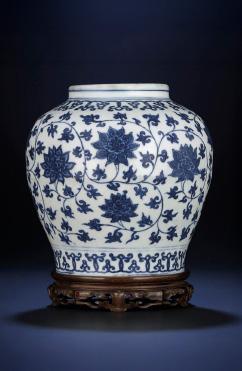


China, c. 1620. Finely potted, the body flaring gently toward the high rounded shoulder surmounted by a slightly waisted neck, the exterior richly painted in shades of cobalt blue with a wide band around the body depicting a lush landscape and a pair of pheasants accompanied by birds, amid prunus, peonies, lingzhi, and other auspicious flowers. The foot similarly decorated with auspicious flowers and fruiting trees, the shoulders with three lobed cartouches enclosing chilong reserved on a diapered ground and divided by ruyi-heads, the neck with a band of ruyi-heads issuing scrolling vines with pendent stiff leaves.
Provenance: Millon, Paris, 2 July 1997, lot 183. The Collection of Sam and Myrna Myers, Paris, France, acquired from the above.
Condition: Good condition with minor wear and firing irregularities, the vase made in several sections and slightly leaning, the luting lines well visible, the rim with expected minor fritting and a hairline crack (approx. 15 cm) extending onto the shoulder with an associated area of touchup (approx. 4 cm).
Weight: 5.9 kg
Dimensions: Height 52 cm
Expert’s note: A similar vase in the Phoenix Art Museum, Matthew Wong Collection, is illustrated by Stephen Little in Chinese Ceramics of the Transitional Period: 1620-1683, New York, 1984, p. 39, no. 2, where the author notes that the shape, which is unique to this period, is a cross between the traditional meiping and the cylindrical-form vases of the Chongzhen period.
Type: Closely related
Auction: Christie’s New York, 16 March 2015, lot 3507
Price: USD 60,000 or approx. EUR 94,500 converted and adjusted for inflation at the time of writing
Description: A blue and white tapering cylindrical vase, late Ming dynasty, WanliTianqi period, circa 1620
Expert remark: Compare the closely related form and decoration with similar composition and bands around the shoulder and neck. Note the size (40 cm) and different motifs including figures in a landscape.
Estimate EUR 10,000
Starting price EUR 5,000


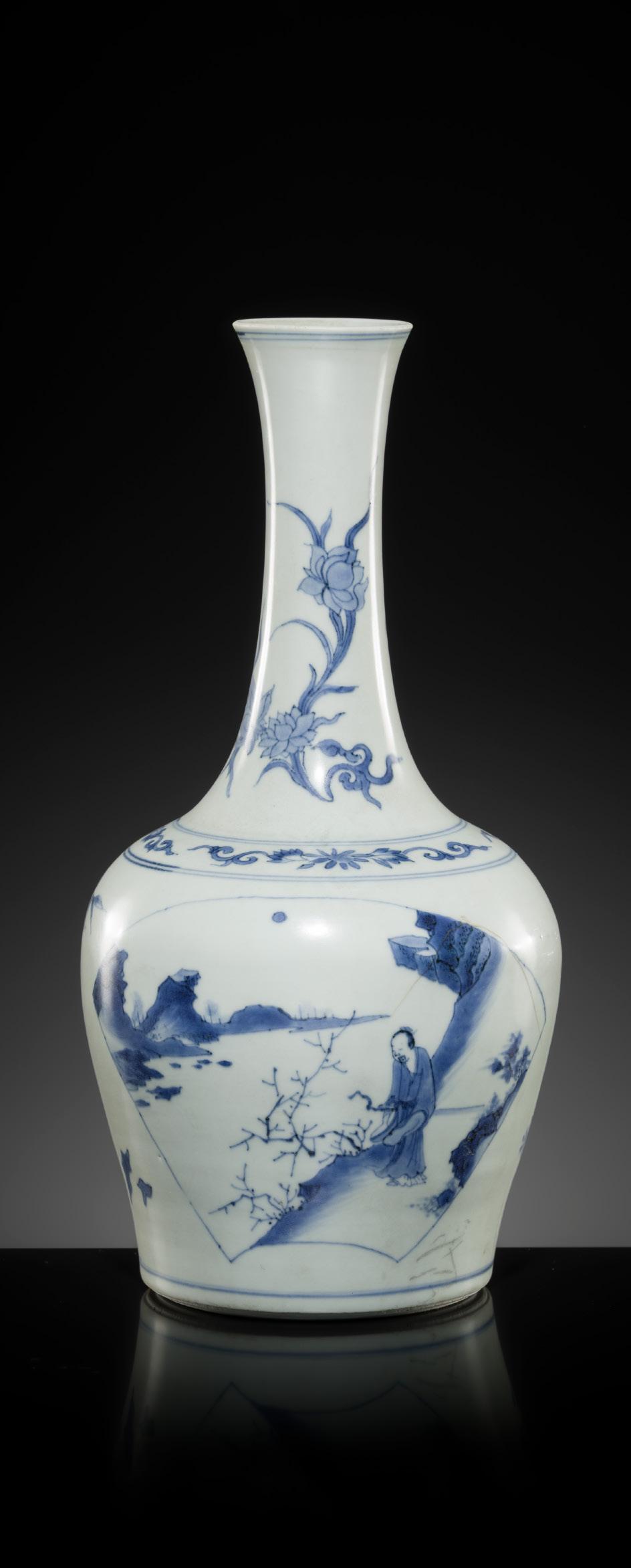
China, c. 1643-1645. The vase with a tapering body set with a long waisted neck and flaring mouth, painted in shades of cobalt blue with a fan-shaped cartouche enclosing a river landscape depicting a scholar beside a shore, the remainder of the body and neck decorated with sprays of lotus, bamboo, morning glory, and other auspicious flowers, and the shoulders encircled by a band of floral scrolls within double line borders. The flat base unglazed revealing the white ware.
Provenance: Michael Hatcher, recovered from the ‘Hatcher wreck’ in 1983. Christie’s Amsterdam, 14 March 1984. The Collection of Sam and Myrna Myers, Paris, France, acquired from the above. The base with three labels, ‘Myrna Myers Paris’, ‘The Hatcher Collection, Christie’s Amsterdam 14-03-1984’, and ‘Recovered from an Asian vessel sunk in the South China Sea’.

The catalog cover for the auction in which the present lot was sold at Christie’s Amsterdam, 14 March 1984
Condition: Good condition with expected surface wear and firing irregularities including minor kiln grit, the upper rim possibly smoothened, one side with a U-shaped hairline below the shoulder. The exterior with surface alteration consistent with objects from maritime salvage.
Weight: 1.8 kg
Dimensions: Height 36 cm
The present vase was recovered among some 25,000 vessels found on the wreck of an unidentified Asian ship in the South China Sea. This ship is known as the ‘Hatcher cargo’ after Captain Michael Hatcher who discovered her in 1983. There is no written record testifying to the exact year of her sinking but the covers of two oviform jars inscribed in underglaze blue with a cyclical date corresponding to 1643 make fairly precise dating of the wreck possible. The cargo primarily consisted of two types of blue-and-white porcelain made at Jingdezhen at the end of the Ming dynasty – late variations of ‘kraak’ ware and examples of a ‘transitional’ style characterized by landscape motifs and naturalistic plants and birds. The ship may have been on its way to Indonesia, carrying also spices, silk and other commodities for sale to the Dutch whose East India Company had offices in Batavia (modern Jakarta). Chinese junks sailing to Batavia or Bantam varied in size from 200 to 800 tons. The journey out was made over three weeks during December and January and the return trip took place in June and July.
Type: Closely related Auction: Bonhams London, 17 May 2012, lot 250
Price: GBP 15,000 or approx. EUR 29,000 converted and adjusted for inflation at the time of writing
Description: A blue and white mallet-shaped vase, mid-17th century Expert remark: Compare the closely related form, cobalt-blue decoration, motifs, and size (37 cm). Note the garlic mouth.
Estimate EUR 4,000
Starting price EUR 2,000

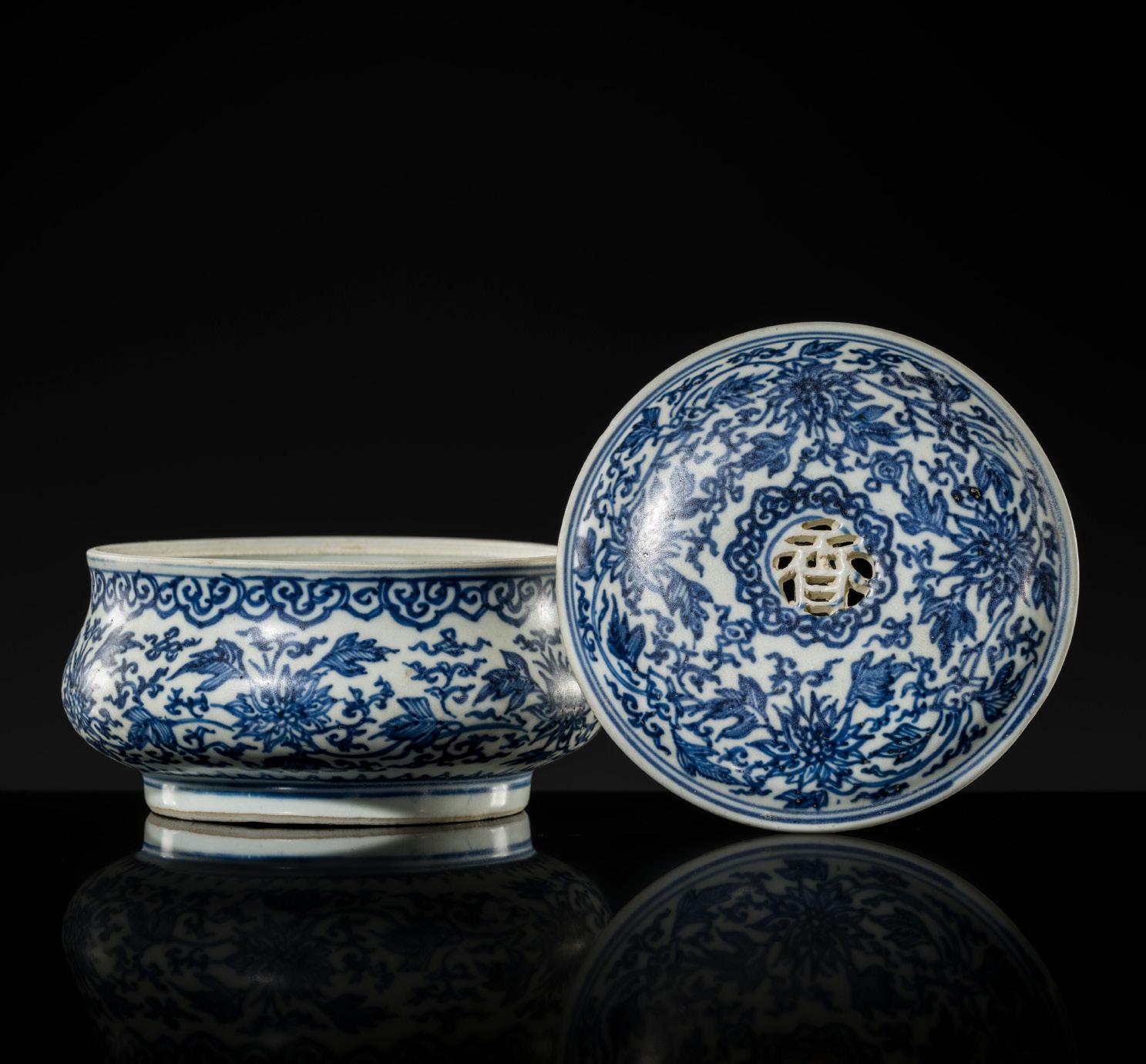
24 A RARE BLUE AND WHITE BOMBÉ ‘XIANG’ CENSER AND COVER, TRANSITIONAL PERIOD, FROM THE HATCHER CARGO


PUBLISHED

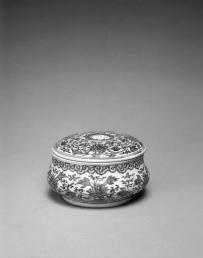
Exhibited:
1. Pointe-à-Callière Museum, From the Lands of Asia. The Sam and Myrna Myers Collection, Montréal, 17 November 2016-19 March 2017.
2. Kimbell Art Museum, From the Lands of Asia. The Sam and Myrna Myers Collection, Fort Worth, Texas, 4 March-19 August 2018.
China, c. 1643-1645. The censer of bombé form, finely painted in shades of cobalt blue with a dense pattern of lotus scroll below a band of ruyi-heads, the foot encircled by double lines, the slightly domed cover similarly decorated and centered by the pierced character ‘xiang’ (fragrance), the recessed base with an apocryphal underglaze-blue six-character mark da Ming Jiajing nianzhi
Provenance: Michael Hatcher, recovered from the ‘Hatcher wreck’ in 1983. Christie’s Amsterdam, 14 March 1984, lot 372. The Collection of Sam and Myrna Myers, Paris, France, acquired from the above. The base with an old label, ‘The Hatcher Collection, Christie’s Amsterdam 14-031984’. The interior with a further label, ‘Recovered from an Asian vessel sunk in the South China Sea’. Michael Hatcher (b. 1940) is a British explorer and marine salvor who specialized in salvage work in the South China Sea. In 1981, he was involved in investigating the wreck of the Dutch submarine K XVII. He is especially known for his recovery of large quantities of Chinese porcelain from the VOC ship Geldermalsen (known as the ‘Nanking cargo’) which was sold at Christie’s in Amsterdam in 1986. Previously, he had discovered another ship in the South China Sea, which became known as the ‘Hatcher cargo’. A part of the cargo salvaged in this wreck was sold at Christie’s Amsterdam in March 1984. Condition: Very good condition with expected wear and minor firing irregularities including few dark spots. The exterior with surface alteration consistent with objects from maritime salvage.
Weight: 375 g
Dimensions: Diameter 12 cm
Estimate EUR 6,000
Starting price EUR 3,000

Exhibited:
1. Pointe-à-Callière Museum, From the Lands of Asia. The Sam and Myrna Myers Collection, Montréal, 17 November 2016-19 March 2017.
2. Kimbell Art Museum, From the Lands of Asia. The Sam and Myrna Myers Collection, Fort Worth, Texas, 4 March-19 August 2018.
China, c. 1643-1645. The globular body rising from a straight foot to a cylindrical neck with domed section below the upper rim, set with a spout emerging from a disk to one side. The sides are painted in cobalt blue with a hare and a mythical beast hiding amid lotus scroll, framed by a band of stiff leaves above and below, the neck further detailed with petals, and the domed upper section with further scrolling vines. The disk around the mouth is decorated with floral sprays enclosed by stylized leaves.
Provenance: Michael Hatcher, recovered from the ‘Hatcher wreck’ in 1983. Christie’s Amsterdam, 14 March 1984. The Collection of Sam and Myrna Myers, Paris, France, acquired from the above. The base with an old label, ‘The Hatcher Collection, Christie’s Amsterdam 14-03-1984’. Michael Hatcher (b. 1940) is a British explorer and marine salvor who specialized in salvage work in the South China Sea. In 1981, he was involved in investigating the wreck of the Dutch submarine K XVII. He is especially known for his recovery of large quantities of Chinese porcelain from the VOC ship Geldermalsen (known as the ‘Nanking cargo’) which was sold at Christie’s in Amsterdam in 1986. Previously, he had discovered another ship in the South China Sea, which became known as the ‘Hatcher cargo’. A part of the cargo salvaged in this wreck was sold at Christie’s Amsterdam in March 1984.


Condition: Good condition with expected wear, firing irregularities, minor warping, two shallow chips to the underside of the disk and a tiny chip to the spout. The exterior with surface alteration consistent with objects from maritime salvage.
Weight: 983 g
Dimensions: Height 20.2 cm

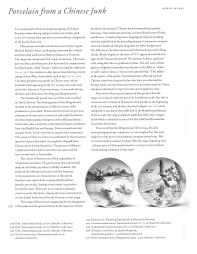


PUBLISHED
Jean-Paul Desroches (ed.) et al, Two Americans in Paris. A Quest for Asian Art, Paris, 2016, p. 202, no. 324.
The present kendi was recovered among some 25,000 vessels found on the wreck of an unidentified Asian ship in the South China Sea. This ship is known as the ‘Hatcher cargo’ after Captain Michael Hatcher who discovered her in 1983. There is no written record testifying to the exact year of her sinking but the covers of two oviform jars inscribed in underglaze blue with a cyclical date corresponding to 1643 make fairly precise dating of the wreck possible. The cargo primarily consisted of two types of blue-andwhite porcelain made at Jingdezhen at the end of the Ming dynasty – late variations of ‘kraak’ ware and examples of a ‘transitional’ style characterized by landscape motifs and naturalistic plants and birds. The ship may have been on its way to Indonesia, carrying also spices, silk and other commodities for sale to the Dutch whose East India Company had offices in Batavia (modern Jakarta). Chinese junks sailing to Batavia or Bantam varied in size from 200 to 800 tons. The journey out was made over three weeks during December and January and the return trip took place in June and July.
The shape of this kendi is neither Chinese nor European, but derives from Southeast Asian water pourers. Although this might suggest that it was destined for sale to Southeast Asian customers rather than for transport on to The Netherlands, we know from surviving Dutch still-life oil paintings that porcelains in shapes seemingly made for non-European customers were sold and used in Europe. Out of a total of 545 kendi, eleven with this type of ‘transitional’ decoration were sold at auction over the four Christie’s sales of the Hatcher wreck cargo. Most kendi recovered from the wreck had ‘kraak’style decoration. The disked kendi type was encountered for the first time in this cargo.
LITERATURE COMPARISON
Compare a pair of closely related blue and white kendis, 19.8 cm high, dated to the Ming dynasty, also from the Hatcher cargo and now in the British Museum, registration number 1984,0303.11.a-b.
Estimate EUR 8,000
Starting price EUR 4,000


China, 1662-1722. The ovoid jar tapering towards the foot, supporting a short, unglazed, cylindrical neck, and with a domed cover. The exterior painted with scenes of elegant ladies in conversation in a courtyard setting with castellated walls and domed roofs bearing flags, all above diaper bands and pendent stiff leaves, and the shoulder and foot encircled by chevron bands. The cover similarly decorated with precious vases and objects enclosed by a border of stiff leaves. The recessed base with an Artemesia leaf in underglaze blue within a double circle.
Provenance: The Collection of Sam and Myrna Myers, Paris, France. Acquired between circa 1965-2012.
Condition: Wear and firing irregularities including pitting. Old repairs, fills, and touchups. Overall presenting very well.
Weight: 5.3 kg
Dimensions: Height 38.2 cm
AUCTION RESULT COMPARISON
Type: Near identical
Auction: Sotheby’s London, 6 November 2013, lot 114
Price: GBP 10,625 or approx. EUR 19,500 converted and adjusted for inflation at the time of writing
Description: A blue and white ‘ladies’ jar and cover Qing dynasty, Kangxi period
Expert remark: Compare the form, decoration, and motifs.
Estimate EUR 3,000
Starting price EUR 1,500
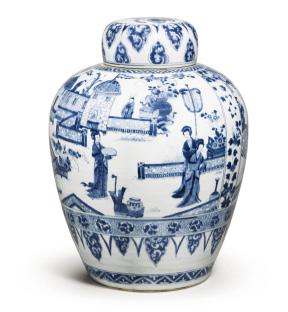
China, 1662-1722. Well potted with a gently waisted slender body supported on a spreading foot and rising to a trumpet mouth with foliate rim, finely painted in deep cobalt blue, the central fluted section with peony and bellflower blossoms borne on leafy meandering stems, framed by molded petalshaped panels enclosing further blossoms of peony and aster above the foot and below the rim, each encircled by bands of peony sprays.
Provenance: The Collection of Sam and Myrna Myers, Paris, France. Acquired between circa 1965-2012. Condition: Very good condition with minor wear and manufacturing irregularities including few firing cracks, the rim with fritting and minor shallow chips.
Weight: 945 g
Dimensions: Height 25.4 cm
LITERATURE COMPARISON
Compare a related blue and white molded porcelain beaker vase, part of a five-piece garniture, dated mid-17th-early 18th century, 18 cm high, in the National Museum of Asian Art, Smithsonian Institution, accession number F1992.47.1.
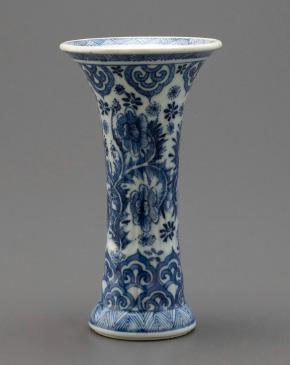


China, 1620-1644. Finely painted in the center with a scene of a monkey seated on rocks beneath a fruiting peach tree, a recumbent deer nearby and a bird and insects in flight above, all below the everted rim painted with four cartouches of flower sprigs reserved on a ground of multicolored lozenge pattern, and a café-au-lait rim.
The recessed base with an apocryphal underglaze blue six-character mark da Ming Chenghua nianzhi within a double circle.
Provenance: The Collection of Sam and Myrna Myers, Paris, France. Acquired between circa 1965-2012.
Condition: Overall good condition with wear and firing irregularities including warping, few dark spots, and minor kiln grit to the base, two tiny hairline cracks to the rim, the rims with old repairs and touchups.
Weight: 396 g
Dimensions: Diameter 20.1 cm
Kosometsuke, literally ‘old blue and white’, refers to porcelains made specifically to cater to the Japanese taste, including those painted in another palette such as this wucai example. With the growing demand for wares for tea drinking and kaiseki meals during the tea ceremony in Japan, Chinese kilns developed new, irregular shapes and decorations. Kosometsuke porcelain was intentionally manufactured using poorly levigated clay and roughly potted with inconsistencies or imperfections that appealed to the Japanese. Typical Kosometsuke wares are often slightly warped in shape and bear rim ‘frits’ from manufacture which were intentionally made and often perceived as damage or a mistake during firing. Often the glaze would flake off the body of the piece and the edges, known as mushikui, or ‘earth worm nibbles’ were particularly prized.
In Japan, porcelain with polychrome overglaze enamels produced at private kilns in Jingdezhen from the late Ming through the early Qing dynasties is known as nankin aka-e, while porcelains of the Tianqi and Chongzhen eras are sometimes known as Tenkei aka-e, from the Japanese name for Tianqi, and differentiated from Nankin aka-e.
LITERATURE COMPARISON
Compare a closely related dish with monkey, deer, and peach tree, dated to the Ming dynasty, 17th century, 19.7 cm diameter, in the Kyoto National Museum, museum number GK335.
AUCTION RESULT COMPARISON
Type: Closely related
Auction: Sotheby’s New York, 22 June 2021, lot 126
Price: USD 4,410 or approx. EUR 4,400 converted and adjusted for inflation at the time of writing
Description: A wucai ‘longevity’ kosometsuke dish, Ming dynasty, Tianqi / Chongzhen period Expert remark: Compare the closely related subject, enamels, and size (20 cm).
Estimate EUR 3,000
Starting price EUR 1,500


China. Finely potted with a pear-shaped body supported on a short spreading foot and rising to a long waisted neck with flaring crescent mouth, the neck encircled by a rib, the body set with the elegantly curved spout towards a hexagonal tip. Covered overall in a vibrant deep blue glaze thinning towards the upper rim and spout and running over the brown rim to the interior. The recessed base left unglazed to reveal the white ware.
Provenance: The Collection of Sam and Myrna Myers, Paris, France. Acquired between circa 1965-2012.
Condition: Overall good condition with minor wear and firing irregularities including pitting, a tiny firing crack to the base, and minor kiln grit, extensive losses to gilt with faint marks of a ‘prunus and spider web’ design above the glaze, old repairs to the mouth.
Weight: 1.1 kg
Dimensions: Height 29.5 cm
Expert’s note: According to Rose Kerr, the shape of these ewers stems from Middle Eastern metalwork in combination with their crescent-shaped mouths and their dark blue glazes (see Kerr and Mengoni, Chinese Export Ceramics, London, 2011, p. 110). A late 17th century bluish-white ewer made in Iran with a curved spout and crescent-moon mouth is in the British Museum, registration number OA+.739, and shows the same Middle Eastern form as these Chinese export ewers.
LITERATURE COMPARISON
Compare two closely related ewers, dated to the 18th century, 29.2 cm and 28.9 cm high, in the Victoria & Albert Museum, accession numbers 775-1888 (fig. 1) and 16741876.
AUCTION RESULT
COMPARISON
Type: Closely related
Auction: Sotheby’s London, 20 April 2016, lot 205
Price: GBP 6,250 or approx. EUR 11,000 converted and adjusted for inflation at the time of writing


Description: A Kangxi gilt-decorated powder-blue ewer, China, with later Ottoman metal mounts, 18th century Expert remark: Compare the closely related form and glaze, as well as the gilt ‘prunus on spider web’ design. Note the metal mounts.
Estimate EUR 3,000
Starting price EUR 1,500
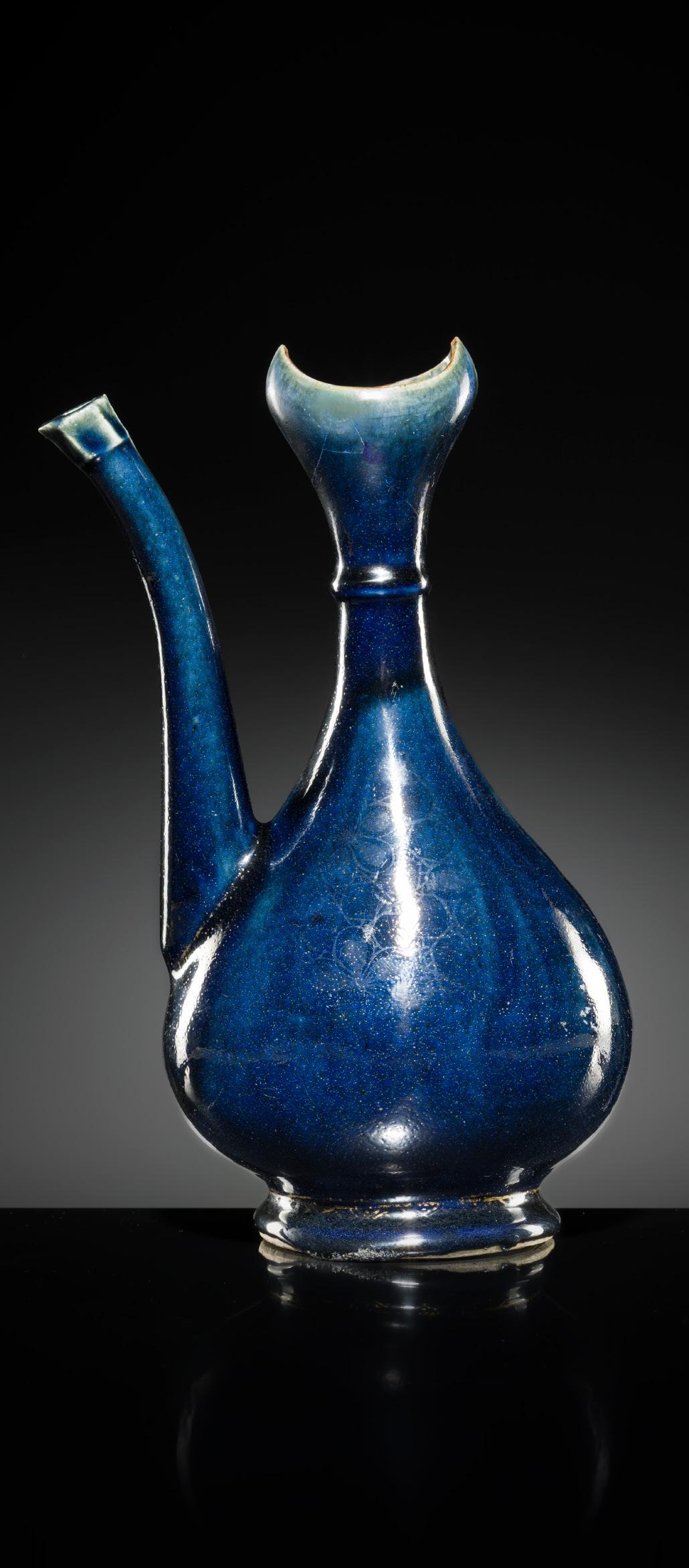
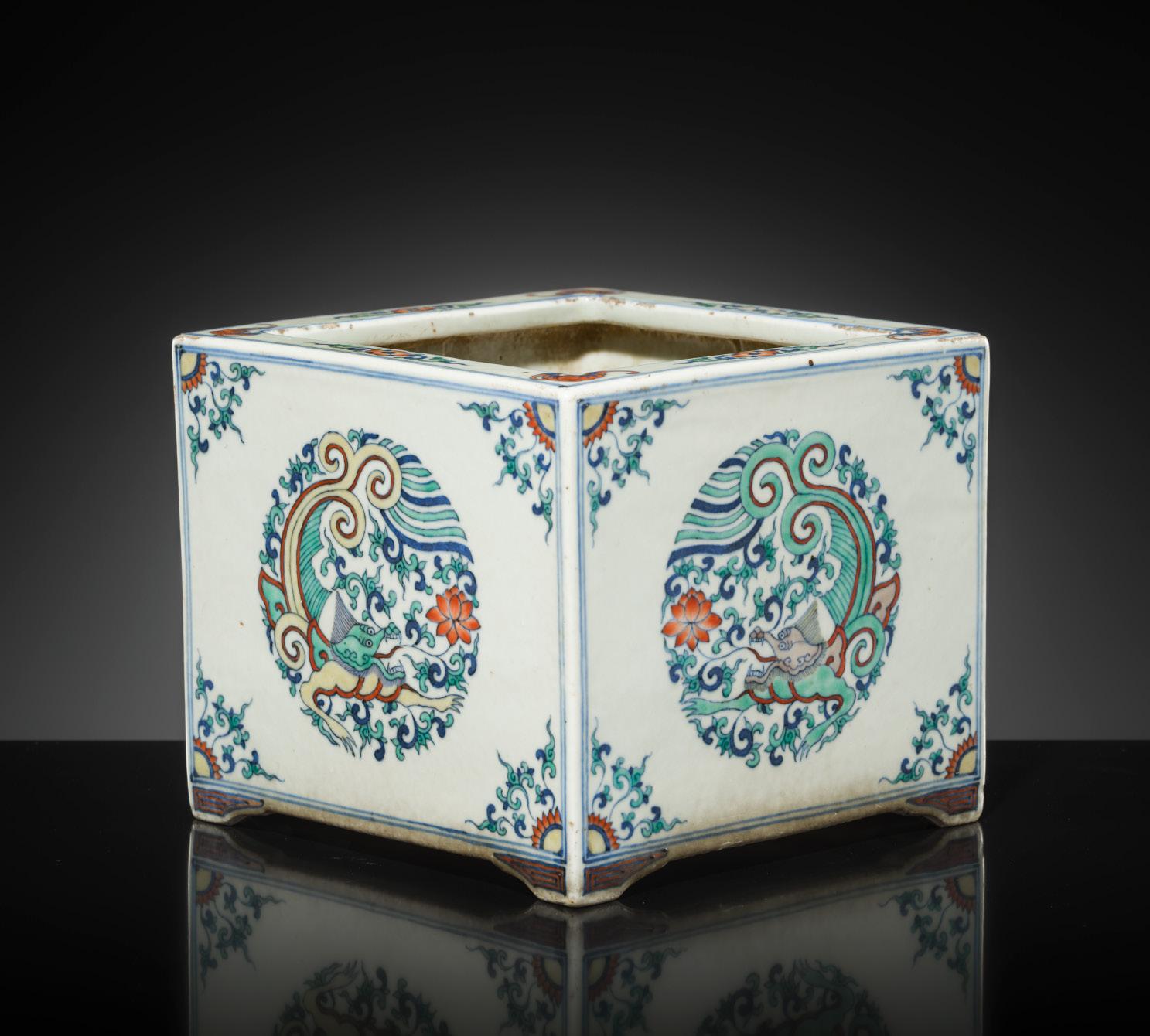
China, 1722-1795. Well potted with a square body supported on four bracket feet, the sides finely enameled in hues of green, yellow, and red, and further decorated in shades of cobalt blue, each with a central roundel composed of a charmingly painted, winged hybrid beast with the head of a dragon, the muscular limbs of a feline, and the finned tail of a fish terminating in a trifurcated scrolling tip.

The beast’s ears and wings are accentuated with ruyi elements and the mouth is wide open revealing sharp fangs and issuing a lotus blossom borne on a delicate stem with leafy scroll designs repeated throughout, similarly extending from the floral-petaled sun symbols at each corner, above the feet with key-fret, the upper rim with a bat to each corner alternating with four floral sprays. The base unglazed and pierced with a central circular aperture.
Provenance: The Collection of Sam and Myrna Myers, Paris, France, acquired in April 2006. The interior with a label inscribed ‘A Doucai square jadiniere’.
Condition: Overall good condition with some wear, traces of use, and firing irregularities, few light glaze scratches, expected minor fritting, one corner with few shallow chips and a small repair, one dragon with minor touchups to the enamels.
Weight: 3.2 kg
Dimensions: Size 19.9 x 19.9 x 16.8 cm
AUCTION RESULT COMPARISON
Type: Near identical
Auction: Poly Auctions, Beijing, 3 January 2020, lot 773
Price: CNY 69,000 or approx. EUR 8,500 converted and adjusted for inflation at the time of writing
Description: A doucai ‘flower and dragon’ jardinière, Qianlong period
Expert remark: Compare the form, decoration, motifs, and size (19.5 x 16.5 cm).
Estimate EUR 6,000
Starting price EUR 3,000
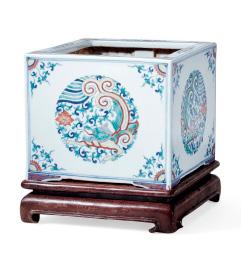
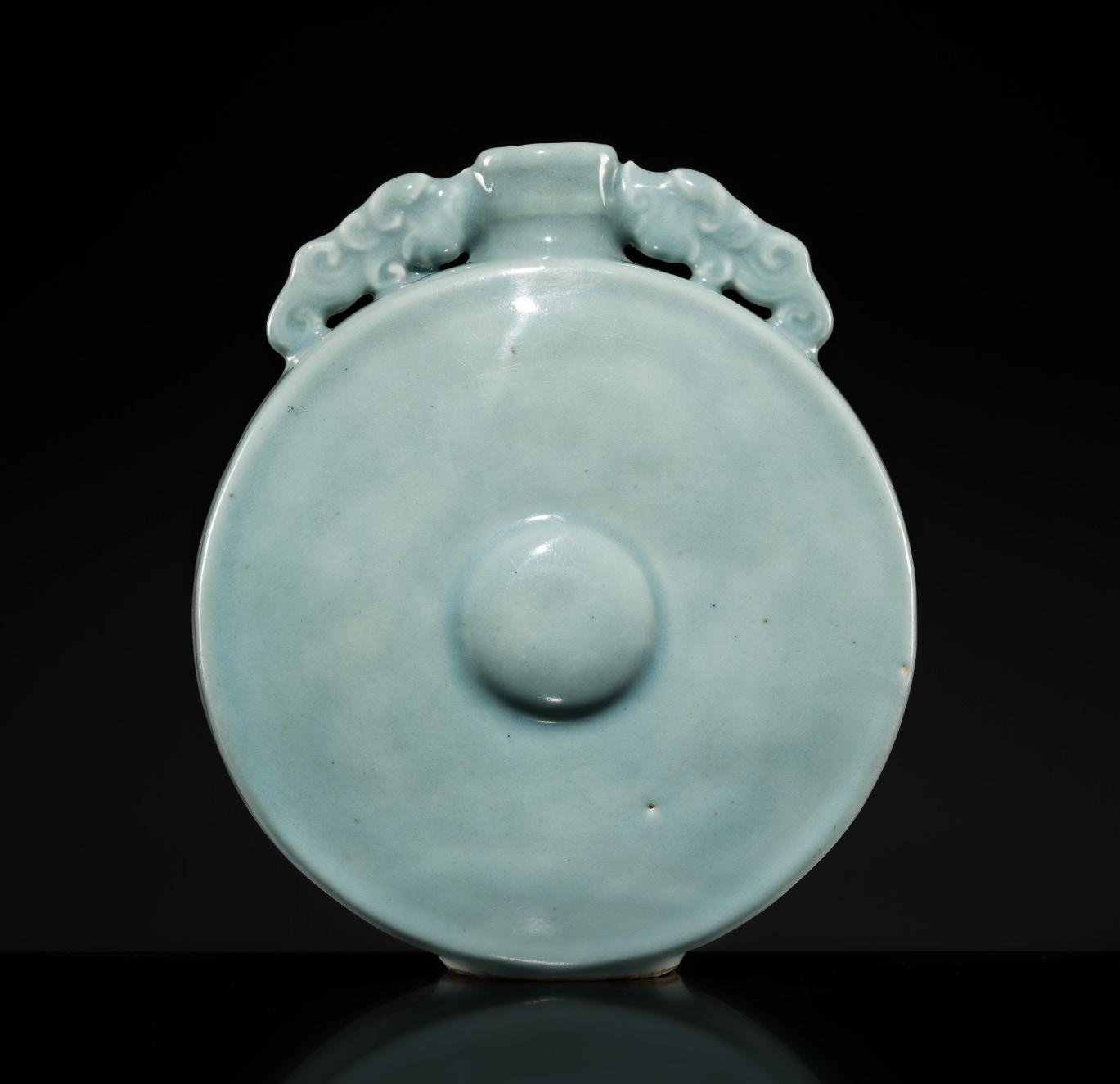
China. The flask of flattened globular form rising from a short foot to a cylindrical neck with central rib and lipped rim, flanked by a pair of dragon handles, and molded to the front and back face with a central boss. The body covered overall in a thick celadon glaze pooling in the recesses and thinning at the edges, the unglazed foot covered with a brown slip.
Provenance: The Collection of Sam and Myrna Myers, Paris, France.
Acquired between circa 1965-2012.
Condition: Very good condition with minor wear and firing irregularities including small glaze recesses, two tiny glaze flakes, the foot with few minuscule chips.
Weight: 843 g
Dimensions: Height 19 cm
In the Yongzheng period, the production of monochrome glazes was vastly expanded and celadon glazes were made in many variations. Several different celadon types are recorded in the list of porcelains produced by the imperial kilns, which was composed in 1735 by the brilliant, innovative supervisor of the imperial factory, Tang Ying (1682-1756). One of his successful recipes was to study in detail the finest antique ceramics of the Song and Ming periods to understand their workmanship and physical quality, but also to comprehend what makes their shapes and designs so harmonious and satisfying, and then to apply this knowledge to totally redesigned, modern versions inspired by the antiques. The present flask imitates the rarest of the ‘five great wares’ of the Song dynasty, the ru glaze, used on wares made for the imperial court during the Northern Song dynasty.
In form, this moonflask is inspired by an early Ming dynasty design, which in turn drew on an Islamic metal prototype; see J. A. Pope, ‘An Early Ming Porcelain in Muslim Style’, in R. Ettinghausen (ed.), Aus der Welt der Islamischen Kunst, Festschrift für Ernst Kühnel, Berlin, 1959, pp. 357-375.
LITERATURE COMPARISON
Compare a related celadon glazed moonflask with a Yongzheng mark and of the period, 16.5 cm high, in the Jilin Provincial Museum. Note the prominent central boss, as found on the present lot.

AUCTION RESULT COMPARISON
Type: Related
Auction: Bonhams, London, 7 November 2011, lot 598
Price: GBP 18,750 or approx. EUR 38,000 converted and adjusted for inflation at the time of writing
Description: A Celadon monochrome vase of moon flask form
Expert remark: Compare the related form and glaze. Note the size (29 cm), taller neck, and differently shaped handles.
Estimate EUR 6,000
Starting price EUR 3,000

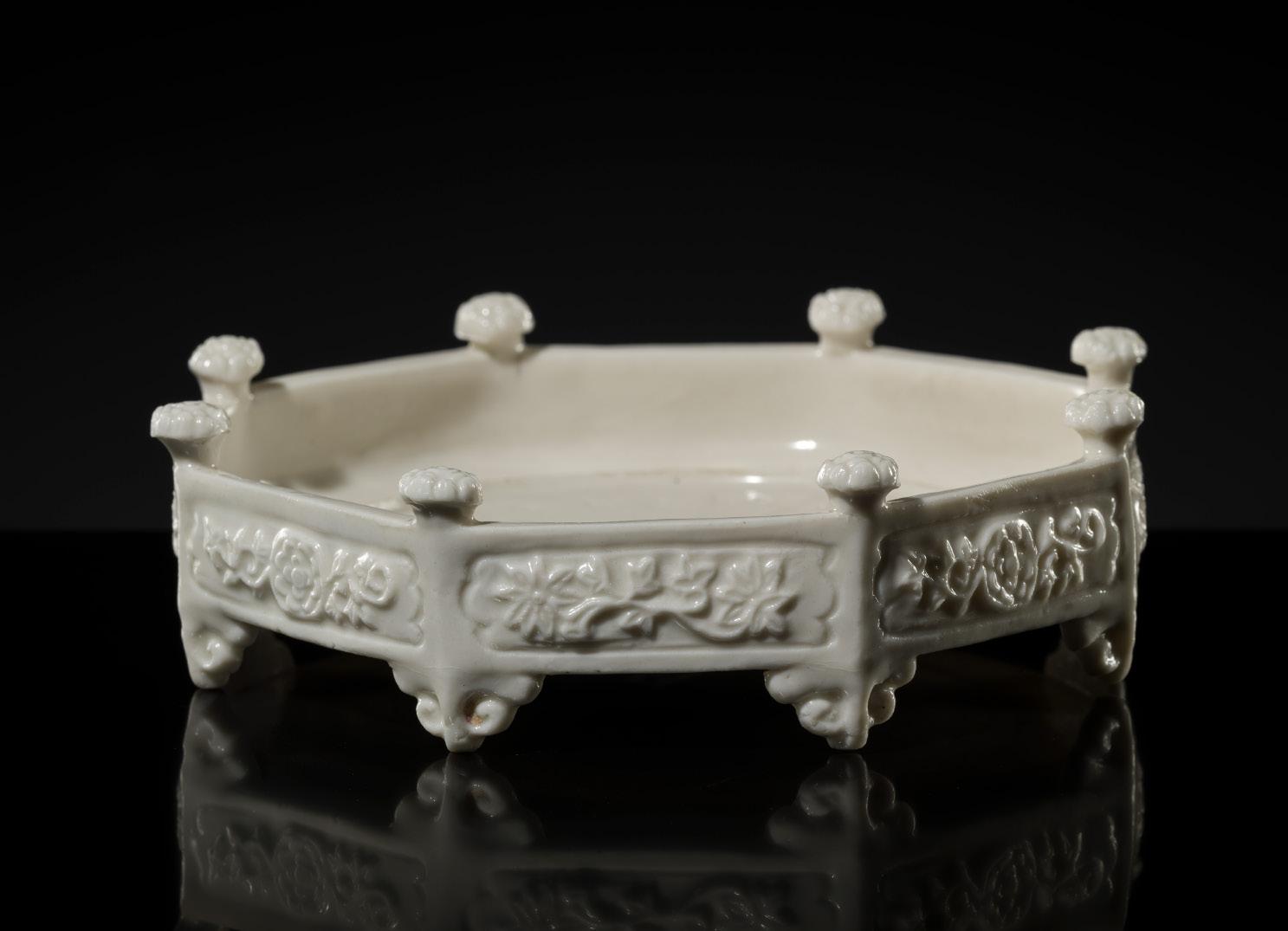

China, 1675-1725. Delicately potted, the octagonal tray raised on eight ruyi feet, with relief-molded panels of lotus sprays around the exterior alternating with blossom-form knobs, and the interior neatly carved with a central lotus blossom and leaf encircled by stylized water ripples enclosed by a raised border.
Provenance: The Collection of Sam and Myrna Myers, Paris, France. Acquired between circa 1965-2012.
Condition: Overall good condition with minor wear and manufacturing irregularities including tiny firing cracks, few small chips to the inner raised border, one foot chipped, another with a small repair, and a third with few small hairline cracks.
Weight: 363 g
Dimensions: Length 15.2 cm
Expert’s note: This tray or stand would have been part of a set together with a censer and cover, see one example sold at Sotheby’s New York, 13 September 2016, lot 288, for USD 15,000 or approx. EUR 17,000 (converted and adjusted for inflation at the time of writing). Censers of this type have been associated with Marco Polo since at least the 19th century, when it was a popular belief that they were brought to Venice by the explorer.
LITERATURE COMPARISON

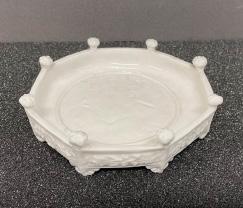
Compare a closely related dehua octagonal tray, dated 1675-1725, 15.6 cm long, in the Cornell University, object number 80.093.005. Compare a closely related octagonal base, dated to the 1700s, 17.5 cm long, in the British Museum, museum number 1980,0728.160.
Estimate EUR 2,000
Starting price EUR 1,000
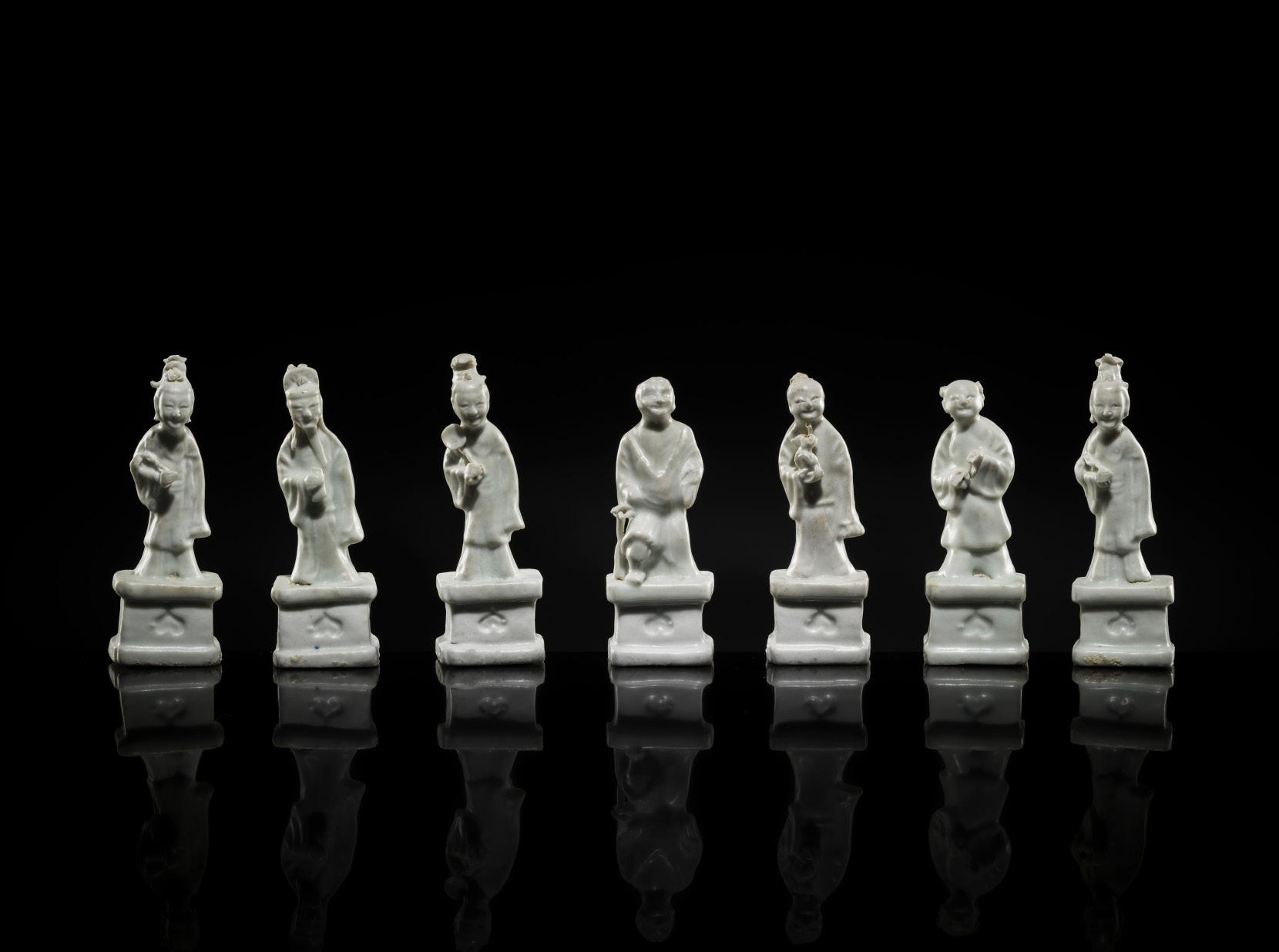
A RARE GROUP OF SEVEN DEHUA GLAZED FIGURES OF THE DAOIST IMMORTALS, BAXIAN, QIANLONG PERIOD, FROM THE NANKING CARGO
China, c. 1752. Comprising three figures of He Xiangu, two holding a fly whisk and one with a scepter, a figure of Li Tieguai leaning on his cane, a figure of Cao Guojiu, a figure of Han Xiangzi with his hands held before his chest and the hair tied in two buns, and a figure of Lan Caihe with a small pouch in his right hand. Each standing atop a rectangular base with upturned ruyi to the front and back and covered in a bluish white glaze over the white body. (7)
Weight: 369 g (total)
Dimensions: Height 9.8-10.6 cm

Michael Hatcher unveils a bell found at the ‘Nanking cargo’ site, 1986
Provenance: Michael Hatcher, recovered from the Geldermalsen wreck (known as the ‘Nanking cargo’). Christie’s Amsterdam, 28 April 1986, lot 5736A. The Collection of Sam and Myrna Myers, Paris, France. One figure with an old label to the back, ‘Christie’s, The Nanking Cargo, lot 5736A’. Michael Hatcher (b. 1940) is a British explorer and marine salvor who specialized in salvage work in the South China Sea. In 1981, he was involved in investigating the wreck of the Dutch submarine K XVII. He is especially known for his recovery of large quantities of Chinese porcelain from the VOC ship Geldermalsen, which was sold at Christie’s in Amsterdam in 1986. Previously, he had discovered another ship in the South China Sea, which became known as the ‘Hatcher cargo’. A part of the cargo salvaged in this wreck was sold at Christie’s Amsterdam in March 1984.
Condition: Overall very good condition with expected surface wear, manufacturing irregularities including small firing cracks and dark spots, apart from one figure only few small losses to extremities, two bases with small hairlines and one with a chip to one corner. The exterior with minor surface alteration consistent with objects from maritime salvage.
These porcelain figures belong to the celebrated ‘Nanking Cargo’, recovered from the wreck of the Dutch East India Company ship Geldermalsen, which sank in the South China Sea on January 3, 1752 after striking a reef on its return voyage to the Netherlands. The ship had departed Canton (Guangzhou) just sixteen days earlier, carrying a valuable cargo of tea, silk, gold ingots, and more than 100,000 pieces of porcelain produced in Jingdezhen for the Dutch market. The porcelain had been packed in chests of tea, which inadvertently protected many of the wares from damage during their long submersion. In 1985, British salvage expert Captain Michael Hatcher discovered the wreck on the same reef where, just two years earlier, he had found a sunken Chinese junk carrying a cargo of Kraak and Transitional wares dated to around 1643. The two wrecks lay barely a mile apart. The Geldermalsen’s contents were sold the following year in a sensational auction at Christie’s Amsterdam, where the combination of commercial history, shipwreck romance, and the pristine condition of the porcelain led to extraordinary public interest and record-breaking sales.
The Baxian (Eight Immortals) are a legendary group of Chinese heroes who fight to vanquish evil.
LITERATURE COMPARISON
Compare a closely related Dehua figure of Li Tieguai, dated c. 1752, also salvaged from the Geldermalsen wreck, 9.8 cm tall, in the Minneapolis Institute of Art, accession number 99.217.413.

Estimate EUR 6,000
Starting price EUR 3,000

34 A FINE COLLECTION OF EIGHTEEN QINGBAI FIGURES, SONG DYNASTY
Exhibited:
1. Pointe-à-Callière Museum, From the Lands of Asia. The Sam and Myrna Myers Collection, Montréal, 17 November 2016-19 March 2017.
2. Kimbell Art Museum, From the Lands of Asia. The Sam and Myrna Myers Collection, Fort Worth, Texas, 4 March-19 August 2018.
3. Fondation Baur, The Beginning of the World – According to the Chinese. Dragons, Phoenix and Other Chimera, Geneva, 11 November 2020-23 May 2021 (the zodiac figures).
4. Musée Départemental des Arts Asiatiques, The Beginning of the World – According to the Chinese. Dragons, Phoenix and Other Chimera, Nice, Summer 2021 (the zodiac figures).
China, 960-1279. Comprising four courtiers, each with a differently styled beard, dressed in voluminous robes, and clutching a tablet (gui) to their chest; four zodiac figures, each wearing a tall crown, the face with a stern expression, and the chest centered by a different animal, the dragon, snake, monkey, or rooster; four smaller zodiac figures of a dragon, horse, goat, and dog, modeled as a human figure standing ramrod straight with hands clasped beneath the long sleeves of court robes; one attendant crouching low as he presses his forehead to a gui; a conjoined mythical beast with two human heads on either side; a figure of Li Tieguai resting against his crutch; a figure of Weituo dressed in full regalia; and model of a sinuous dragon; and another of a crouching tiger. (18)




1.
2. Jean-Paul Desroches (ed.) et al, The Beginning of the World. Dragons, Phoenix and Other Chimera, Fondation Baur, Geneva, 2020, p. 242243, nos. 168-169 (the zodiac figures).



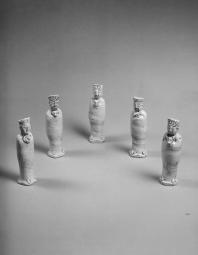
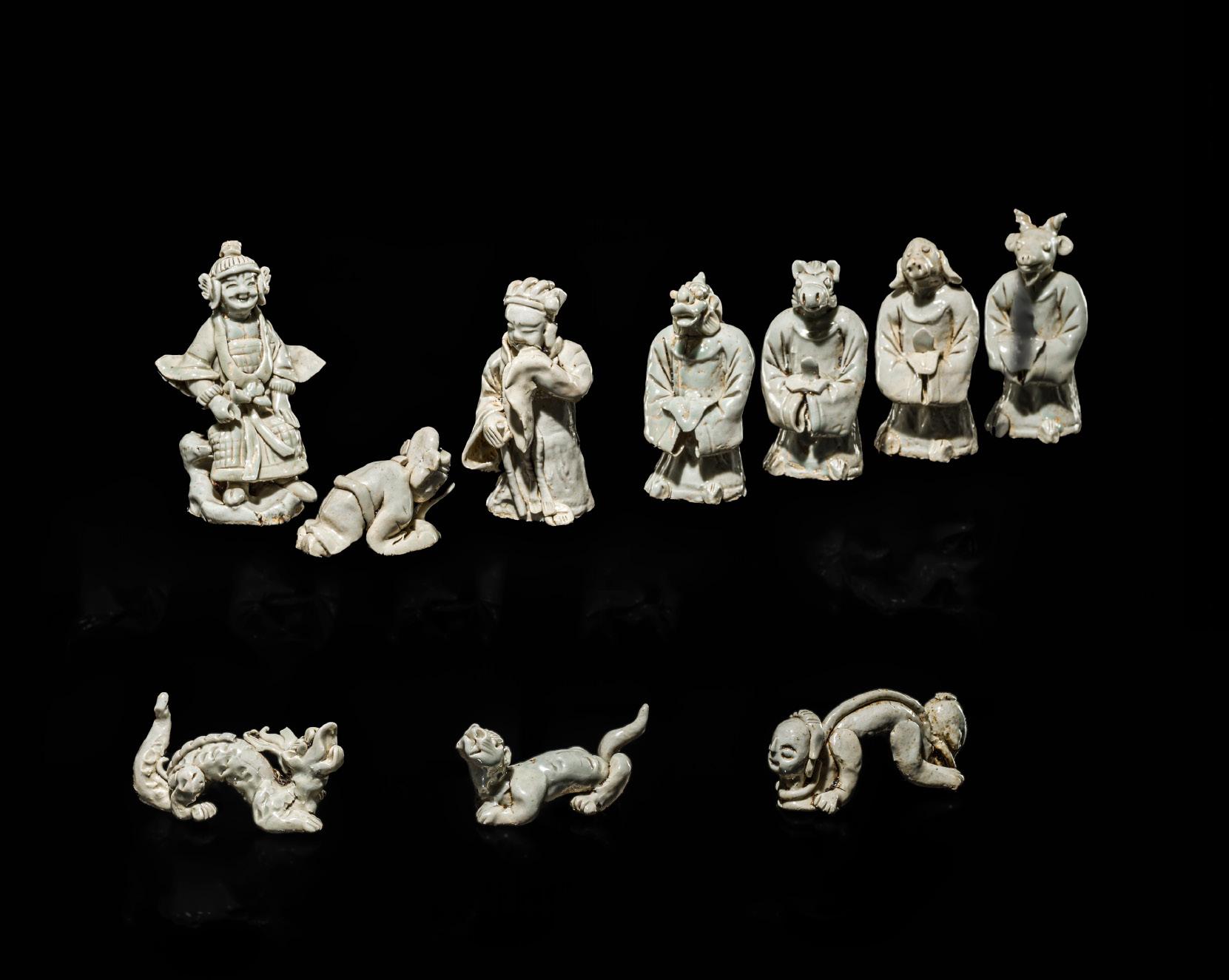
Provenance: The Collection of Sam and Myrna Myers, Paris, France. Acquired between circa 1965-2012.
Condition: Good condition with expected wear and manufacturing irregularities including firing cracks, dark spots, and glaze recesses. Scattered small chips and tiny losses, all as expected.
Weight: 51.3 g (the smallest), 279.2 g (the largest)
Dimensions: Height 4 cm (the smallest), 18.4 cm (the largest)
Zodiac figures first appeared during the Han dynasty as artisans began casting representations of the animals in bronze as offerings. From the Northern Wei dynasty onwards, the zodiacal animals began to be anthropomorphized, as seen on several examples in the present lot.
AUCTION RESULT COMPARISON
Type: Closely related
Auction: Sotheby’s Hong Kong, 26 August 2021, lot 1024
Price: HKD 40,320 or approx. EUR 4,700 (for two) converted and adjusted for inflation at the time of writing
Description: Two Qingbai figures of courtiers, Southern Song dynasty Expert remark: Compare the closely related modeling, expression, glaze, and similar stance clutching a gui tablet. Note the size (18.6 cm).

AUCTION RESULT COMPARISON
Type: Closely related
Auction: Christie’s Hong Kong, 7 December 2021, lot 3252
Price: HKD 21,250 or approx. EUR 2,500 (for one) converted and adjusted for inflation at the time of writing
Description: A Qingbai zodiac ‘Ox’ figure, Song dynasty
Expert remark: Compare the closely related modeling, expression, swaddled robe, and related ox head to the chest. Note the size (20.5 cm).
Estimate EUR 10,000
Starting price EUR 5,000


China, c. 1752. Each dish decorated in shades of cobalt blue with the ‘leaping boy’ pattern, featuring a boy holding out his arms on a rocky bank and watched by another in a pavilion amongst pine and wutong in a river landscape, all framed by a band of scrolls, below three floral sprays of peony, lotus, and chrysanthemum. (5)
Provenance: Michael Hatcher, recovered from the Geldermalsen wreck (known as the ‘Nanking cargo’). Christie’s Amsterdam, 28 April 1986, lot 4605 (labels to bases). The Collection of Sam and Myrna Myers, Paris, France, acquired from the above. One with an old label, ‘Myrna Myers’, to the base.
Condition: Good condition with minor wear and firing irregularities including dark spots, fritting around the rim, minor glaze flaking, little warping, and pitting. One dish with a 3 cm long area of repair to the upper rim.
Weight: 3.1 kg (total)
Dimensions: Diameter 28.2-28.8 cm

These dishes belong to the celebrated ‘Nanking Cargo’, recovered from the wreck of the Dutch East India Company ship Geldermalsen, which sank in the South China Sea on January 3, 1752 after striking a reef
on its return voyage to the Netherlands. The ship had departed Canton (Guangzhou) just sixteen days earlier, carrying a valuable cargo of tea, silk, gold ingots, and more than 100,000 pieces of porcelain produced in Jingdezhen for the Dutch market. The porcelain had been packed in chests of tea, which inadvertently protected many of the wares from damage during their long submersion. In 1985, British salvage expert Captain Michael Hatcher discovered the wreck on the same reef where, just two years earlier, he had found a sunken Chinese junk carrying a cargo of Kraak and Transitional wares dated to around 1643. The two wrecks lay barely a mile apart. The Geldermalsen’s contents were sold the following year in a sensational auction at Christie’s Amsterdam, where the combination of commercial history, shipwreck romance, and the pristine condition of the porcelain led to extraordinary public interest and record-breaking sales.
Type: Near identical
Auction: Christie’s Amsterdam, 2 May 2007, lot 150
Price: EUR 4,200 or approx. EUR 6,500 (for twelve) adjusted for inflation at the time of writing

Description: A set of twelve blue and white ‘Nanking cargo’ saucer dishes, circa 1750
Expert remark: Compare the form and decoration. Note the closely related size (28.5).
Estimate EUR 3,000
Starting price EUR 1,500
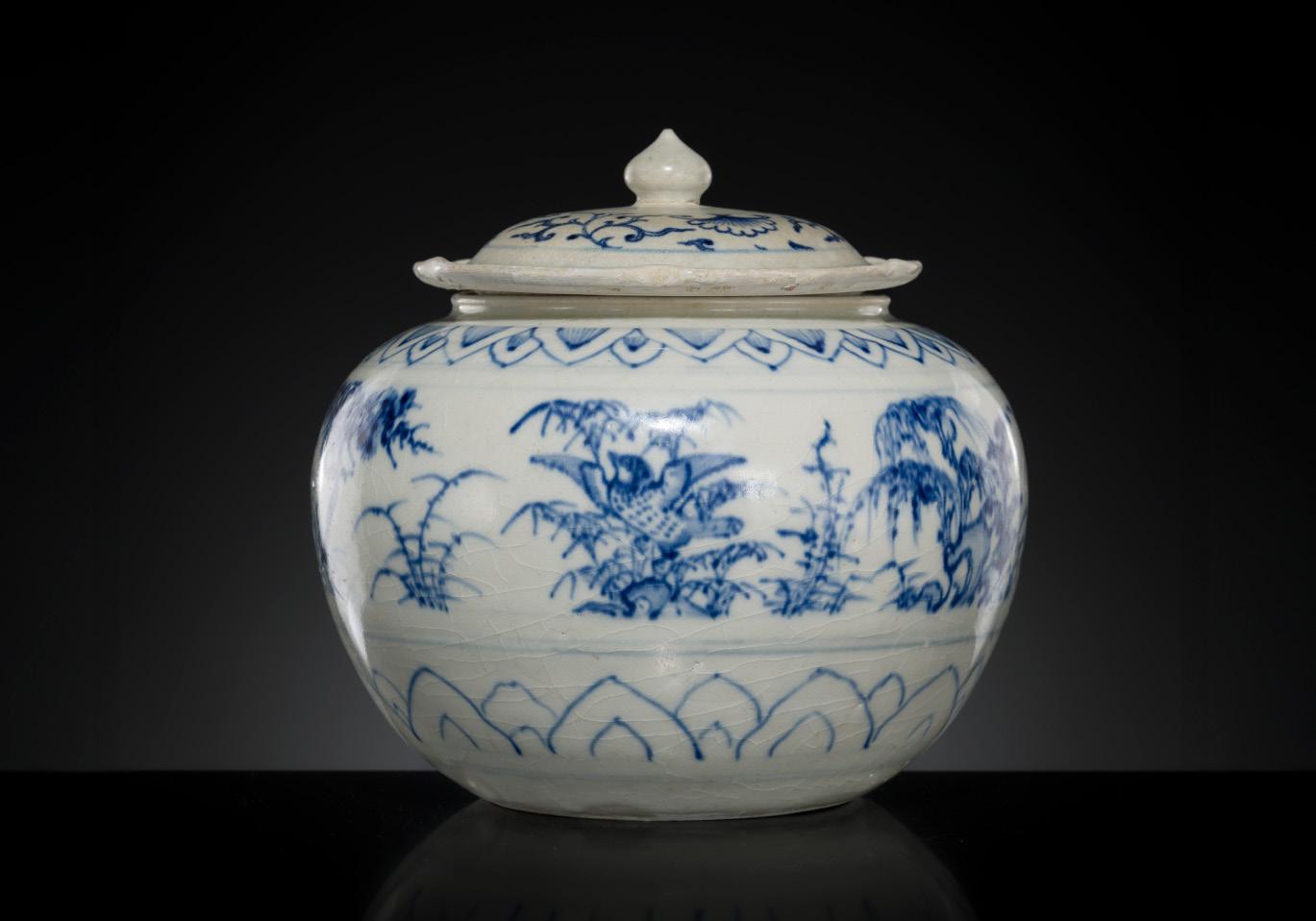
Exhibited:
1. Pointe-à-Callière Museum, From the Lands of Asia. The Sam and Myrna Myers Collection, Montréal, 17 November 2016-19 March 2017.
2. Kimbell Art Museum, From the Lands of Asia. The Sam and Myrna Myers Collection, Fort Worth, Texas, 4 March-19 August 2018.
Vietnam, Hai Duong province, Chu Dau kilns. Of compressed globular form, rising from a gently recessed foot to a short waisted neck with lipped rim, finely decorated to the body with birds in flight amid flowers and foliage, framed by lotus petal bands. The gently domed cover with a lobed rim, decorated with foliate blossoms and sprigs, and topped by a knop-form finial.
Provenance: Recovered between 1997-1999 from the Hoi An Hoard Shipwreck Site, Vietnam. The base and interior of the cover each with an excavation label, ‘Saga. Hoi An Hoard. Visal. 244606’ and ‘Saga. Hoi An Hoard. Visal. 2389’. Butterfields, California, 2000. The Collection of Sam and Myrna Myers, Paris, France, probably acquired from the above.
Condition: Very good condition with expected wear and firing irregularities, a small chip to the mouth with an associated hairline. The exterior with minor surface alteration consistent with objects from maritime salvage including glaze lines.
Weight: 1,195 g
Dimensions: Height 16.2 cm
This jar was cargo on a teakwood junk - a type of boat with Chinese origins that sank during the late fifteenth or early sixteenth century near the Cham Islands in the South China Sea. The boat was heavily laden with ceramic cargo. It likely fell victim to the sea’s treacherous currents or to a typhoon. Seventy meters below the surface, the boat lay underwater, undisturbed until 1993, when Vietnamese fishermen from Hoi An accidently recovered ceramics with their nets. The fishermen attempted to keep the shipwreck a secret. However, after they strategically dragged metal rakes across the wreckage, hundreds of ceramics were broken and dislodged, thereby floating into other fishermen’s nets, and ultimately flooding the art market. It was not until 1997, when two Japanese dealers were detained in the Da Nang airport with baggage filled with fifteenth-century pottery that the Vietnamese government obtained knowledge of the wreck’s exact location and enlisted the expertise of both archaeologists and the Ministry of Culture.


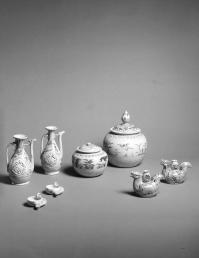

PUBLISHED
Jean-Paul Desroches (ed.) et al, Two Americans in Paris. A Quest for Asian Art, Paris, 2016, p. 207, no. 331.
In 1997, the Vietnamese government secured the assistance of the Vietnamese National Salvage Corporation (VISAL); Saga Horizon, a Malaysian marine engineering company; and Oxford University’s Marine Archaeology Research Division. Between 1996 and 1999, the team ultimately recovered nearly three hundred thousand artifacts.
Once retrieved from the floor of the South China Sea, all artifacts were inventoried, tagged with an excavation sticker and the unique object number. Vietnam’s National History Museum retained all “one-of-a-kind” objects, and the Ministry of Culture distributed hundreds of ceramics to regional museums. The remaining inventory of artifacts was sent to Butterfields, an American auction house. The three-part auction of the “Hoi An Hoard” took place from October 11 to October 13, 2000, both live and online. Collectors, however, were simply not ready to buy works of art online, as nearly sixty percent of the lots did not sell. On December 3, 2000, Butterfields hosted another sale that featured pieces from the Hoi An Hoard.
LITERATURE COMPARISON
Compare a related Vietnamese blue and white jar, dated 15th-16th century, in the Phoenix Art Museum, object number 2000.109.1.A.
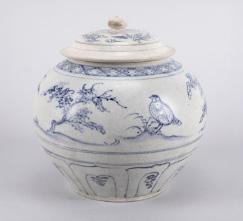
Estimate EUR 3,000
Starting price EUR 1,500

Exhibited:
1. Pointe-à-Callière Museum, From the Lands of Asia. The Sam and Myrna Myers Collection, Montréal, 17 November 2016-19 March 2017.
2. Kimbell Art Museum, From the Lands of Asia. The Sam and Myrna Myers Collection, Fort Worth, Texas, 4 March-19 August 2018.
Vietnam, Hai Duong province, Chu Dau kilns. Modeled in the form of a cockerel, supported on a flat foot, and fitted with a prominent globular spout jar rising from the bird’s back. The body is gracefully contoured with painted plumage, arched tail feathers, and a well-defined beak and crest.
Provenance: Recovered between 1997-1999 from the Hoi An Hoard Shipwreck Site, Vietnam. The base with an excavation label, ‘Saga. Hoi An Hoard. Visal. 9685’. Butterfields, California, 2000. The Collection of Sam and Myrna Myers, Paris, France, probably acquired from the above. Condition: Good condition with expected wear and firing irregularities. The base with light surface scratches, few small nicks, a shallow ship, a minute hairline, and a firing crack. The exterior with minor surface alteration consistent with objects from maritime salvage including glaze lines particular to the spout jar.
Weight: 411.2 g
Dimensions: Length 16.5 cm, Height 11.5 cm
This ewer was cargo on a teakwood junk—a type of boat with Chinese origins, defined by a high stern and projecting bow—that sank during the late fifteenth or early sixteenth century near the Cham Islands in the South China Sea. The boat, which likely originated in Thailand, was heading toward the Philippines and was heavily laden with ceramic cargo. It likely fell victim to the sea’s treacherous currents or to a typhoon. Seventy meters (nearly 230 feet) below the surface, the boat lay underwater, undisturbed until 1993, when Vietnamese fishermen from Hoi An accidently recovered ceramics with their nets. The fishermen attempted to keep the shipwreck a secret. However, after they strategically dragged metal rakes across the wreckage, hundreds of ceramics were broken and dislodged, thereby floating into other fishermen’s nets, and ultimately flooding the art market. It was not until 1997, when two Japanese dealers were detained in the Da Nang airport with baggage filled with fifteenth-century pottery that the Vietnamese government obtained knowledge of the wreck’s exact location and enlisted the expertise of both archaeologists and the Ministry of Culture.




PUBLISHED
Jean-Paul Desroches (ed.) et al, Two Americans in Paris. A Quest for Asian Art, Paris, 2016, p. 207, no. 334.
In 1997, the Vietnamese government secured the assistance of the Vietnamese National Salvage Corporation (VISAL); Saga Horizon, a Malaysian marine engineering company; and Oxford University’s Marine Archaeology Research Division. Between 1996 and 1999, the team ultimately recovered nearly three hundred thousand artifacts.
Once retrieved from the floor of the South China Sea, all artifacts were inventoried, tagged with an excavation sticker and the unique object number. Vietnam’s National History Museum retained all “one-of-a-kind” objects, and the Ministry of Culture distributed hundreds of ceramics to regional museums. The remaining inventory of artifacts was sent to Butterfields, an American auction house. The three-part auction of the “Hoi An Hoard” took place from October 11 to October 13, 2000, both live and online. Collectors, however, were simply not ready to buy works of art online, as nearly sixty percent of the lots did not sell. On December 3, 2000, Butterfields hosted another sale that featured pieces from the Hoi An Hoard.
LITERATURE COMPARISON
Compare two closely related ewers in the form of a bird, Vietnam, dated mid-late 15th century, in the British Museum, registration numbers 2000,1212.4 and 2000,1212.5.
Estimate EUR 3,000
Starting price EUR 1,500


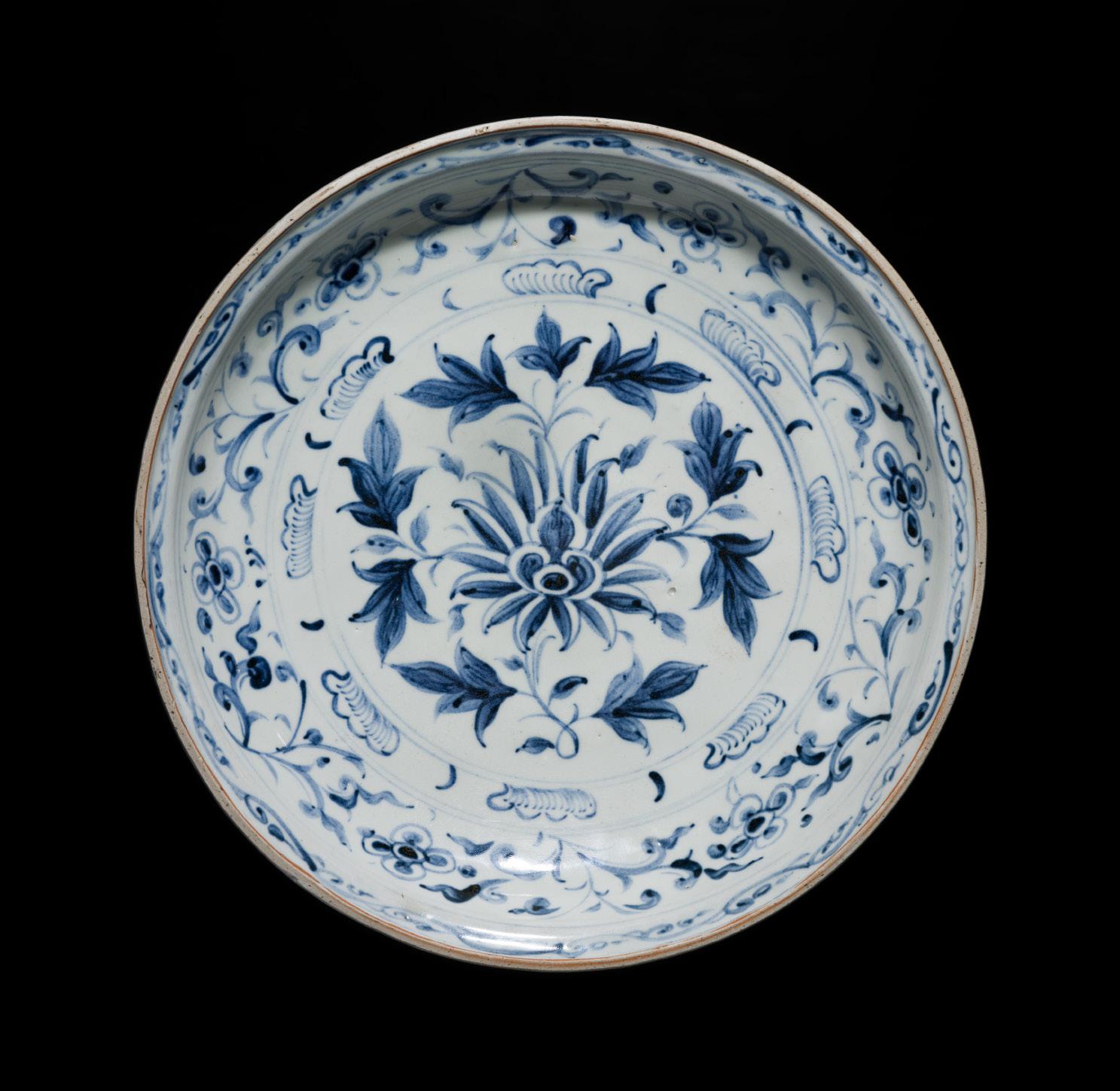
Vietnam. The dish supported on a short, tapering foot, the rounded sides rising to an everted rim, painted in cobalt blue with a roundel at the well enclosing a stylized blossom surrounded by further foliage, framed by foliate bands, and with a border of scrolls below the unglazed rim. The exterior decorated by jeweled lappets and the recessed base applied with a brown iron oxide wash.
Provenance: The Collection of Sam and Myrna Myers, Paris, France. Acquired between circa 1965-2012.
Condition: Good condition with minor wear, surface scratches, a small star crack to the exterior, and firing irregularities including minor warping, and dark spots.
Weight: 2 kg
Dimensions: Diameter 35.2 cm
LITERATURE COMPARISON
Compare a closely related Vietnamese blue and white dish, dated 16th century, 36.9 cm diameter, in the British Museum, registration number 2009,3014.5 (fig. 1). Compare a related blue and white dish from Vietnam, probably Hai D’uong province, dated early 16th century, 23.8 cm diameter, in the Metropolitan Museum of Art, object number 2019.570.15.
AUCTION RESULT COMPARISON
Type: Closely related
Auction: Bonhams San Francisco, 20 November 2006, lot 6141
Price: USD 23,900 or approx. EUR 36,000 converted and adjusted for inflation at the time of writing
Description: A good blue and white pottery deep dish, Vietnam, late 15th/early 16th Century
Expert remark: Compare the closely related form and decoration. Note the peony motif and similar size (37 cm).
Estimate EUR 3,000
Starting price EUR 1,500


39 AN UNDERGLAZE IRON-PAINTED AND CELADON-GLAZED ‘PEONY’ MAEBYONG, GORYEO DYNASTY, 12TH CENTURY
Korea. Heavily potted with a robust ovoid body rising from a short foot and surmounted by a short cylindrical neck with a cup-form mouth, decorated in underglaze iron with peonies borne on scrolling foliage, enclosed between bands of oblique petals to the shoulder and foot.
Provenance: Ex-collection Roger Chambard, the first French Ambassador to Korea (19591969). The Collection of Sam and Myrna Myers, Paris, France. Acquired between circa 1965-2012. Ambassador Roger Chambard (1904-1982) had a lifetime affection and curiosity for continents and cultures, including Africa, the Arab world and the Far East. He shared his interests in history and archaeology with his acquaintances, the writers Henry de Monfreid and Joseph Kessel. His first post in Asia was in China in Hankou (Province of Hubei) from 1932 to 1938. Afterwards he was posted to the Middle East, returning to Asia in 1959 as French Ambassador to South Korea. His interest and his knowledge of Asian cultures as well as his popularity permitted him to stay for ten years in Seoul.

Published by Anne Fauvet, “Au cœur des réseaux d’affaires français en Asie du Nord-Est : Roger Chambard, premier ambassadeur de France en Corée du Sud (années 1950-1980)”, in Relations internationales, no. 167, March 2016, p. 115
Condition: Old wear and firing irregularities including pitting, crackling, encrustations, and glaze recesses. The foot slightly warped. The mouth with old repairs. Fine kintsugi repairs to the body.
Weight: 1,757 g
Dimensions: Height 26.3 cm
Wine bottles like this are known as maebyong, a term derived from the Chinese meiping (“vase for plum blossoms”), a misnomer coined by Qing dynasty scholars. The iron-painted (ch’olhwa) decoration shows some affinity with Chinese Cizhou wares, though this technique was first employed under a celadon glaze in Korea. Celadon ware produced for the court and aristocracy of the Goryeo dynasty is typically gray-green in color— an aesthetic highly prized at the extravagant Goryeo court. The application of underglaze iron required considerable skill, as it had to be executed swiftly before the pigment was absorbed into the clay body.
This shape is typical of twelfth-century maebyong painted in iron. It was probably used for plum blossom or ginseng wine. Sherds of such ironpainted celadon have been excavated at the Kyeyul-ri kiln site in Kangjingun, South Cholla province. And still others have been excavated from the kiln site in Jinsan-ri, Haenam and from the waters around Eodu-ri of Wando Island.
When contemplating a vessel repaired with kintsugi, several aesthetic considerations come into play. The first is the recognition that many ceramics, especially those used in chanoyu, often have a lineage of owners, or a distinguished provenance, and the act of repair allows that act of passing down the object to continue past the generation when the damage occurred. Another is that a given vessel, having been handmade, can never be perfectly reproduced or replaced, and so repair is preferable to losing the object completely. A third, and perhaps the most difficult to describe in words, are the Japanese concepts of wabi and sabi, the former an appreciation of poverty, an undemanding nature, and imperfection, and the latter a recognition that things change over time, often in the direction of altered patina or decay. It is these concepts that allow the damage that an object has sustained to be highlighted with gold, emphasizing the repair rather than trying to hide it. Finally, while aesthetic considerations are key in the use of gold in a kintsugi repair, the restoration of the object to usefulness, returning the vessel to functionality as a jar is the driving force behind this act.
LITERATURE
COMPARISON
Compare a closely related maebyong, dated to the Goryeo dynasty, 27 cm high, in the Fitzwilliam Museum, Cambridge, accession number OC.90-1946 (fig. 1)

Compare a closely related maebyong, dated to the Goryeo dynasty, first half of 12th century, 22 cm high, in the National Museum of Asian Art, Smithsonian Institution, accession number F1917.290.
Compare a closely related maebyong, celadon with chrysanthemum scrolls design, dated to the Goryeo Dynasty, 22 cm high, in the National Museum of Korea, accession number Deoksu4930 (fig. 2) fig. 1 fig. 2
Estimate EUR 8,000
Starting price EUR 4,000


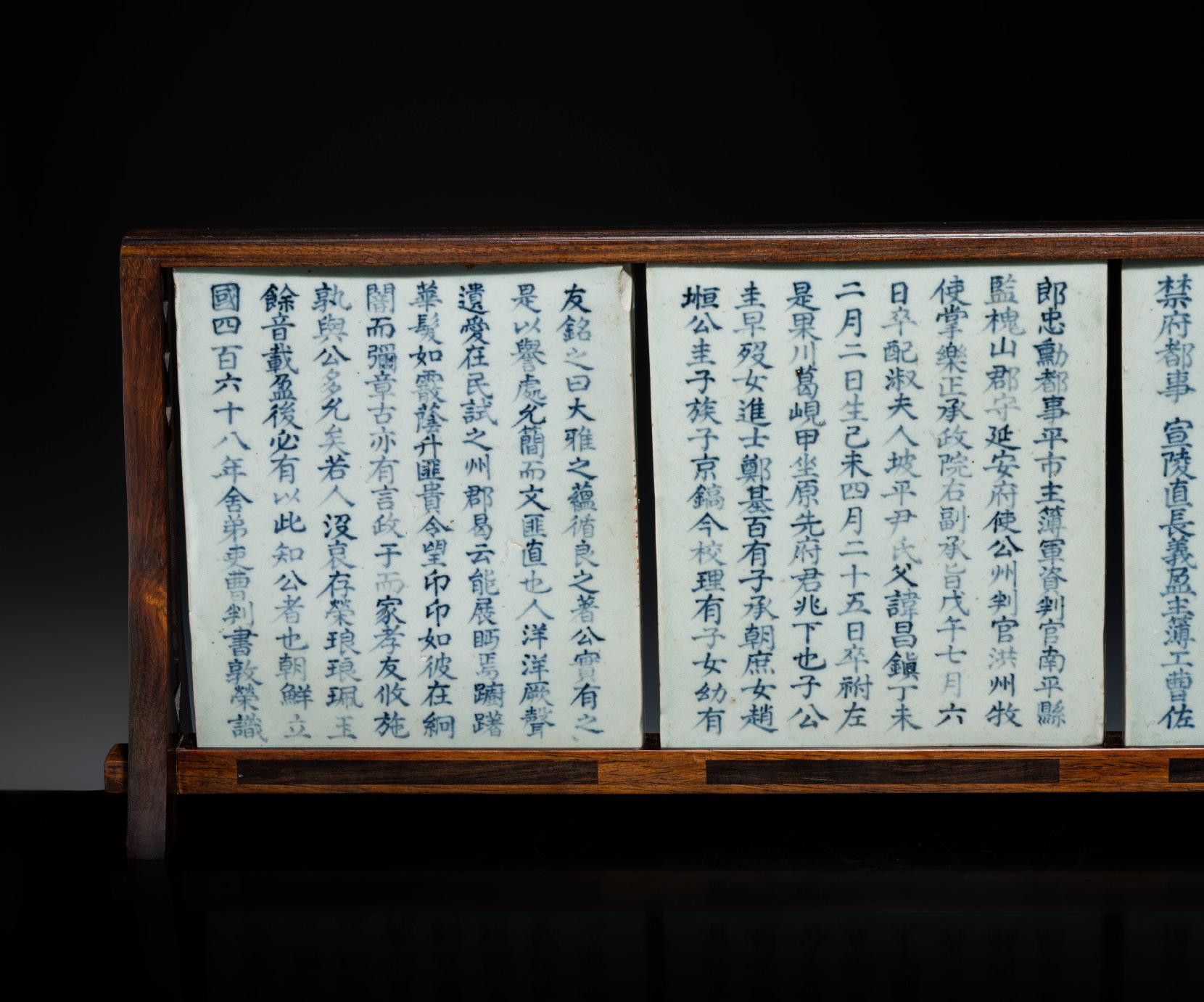
40
A SET OF THREE BLUE AND WHITE INSCRIBED EPITAPH TILES, MYOJI, FOR THE OFFICIAL YI GONG-SOK AND HIS WIFE LADY YUN, JOSEON DYNASTY, DATED 1861
Korea. The three epitaph tablets commemorate the life of Yi Gong-sok, Official at the Royal Secretariat, and his wife, the noble Lady Yun of Papyeong. The tablets summarize his career achievements and inform about his wife and children. The last tile with a poetic text emphasizing Confucian virtues such as filial piety, public service and scholarly refinement.
Inscriptions: Dated ‘468th year of Jeosong (corresponding to 1861)’ and written by the younger brother Don Yeung, Minister of Personnel. The narrow sides each numbered ‘No. 1 of 3, No. 2 of 3, No. 3 of 3’.
The first tile inscribed, ‘Tomb inscription for the joint grave of Yi Gong-suk, Official at the Royal Secretariat, and his wife, the noble Lady Yun of Papyeong’, further inscribed ‘He came from the royal Yi (李) clan as a descendant of Prince Hyo-ryeong. His personal name was Yi Mun-yeong, his courtesy name Hak-ro. His father, Yi Sang-du, was Magistrate of Yongsu and held the rank of Tongjeong. His grandfather, Yi Deok-yeong, was posthumously appointed Ijo-Panseo (Minister of Personnel). His great-grandfather, Yi Si-chae, was posthumously appointed Ijo-Champan (Vice Minister of Personnel). His mother was the Honorable Lady Seo, daughter of Seo In-su, a descendant of Chungsuk-Gong Seo Seom. The tablet also discloses his birthday ‘29 November in the year of Gengxu during the reign of King Jeongjo (corresponding to 1790)’.
The first and second tile include his educational background, ‘Passed the Saengwon examination in the year of Byeongja year under King Sunjo (corresponding to 1816)’ and enlists all his career achievements, ‘Official at the royal tomb, Deputy Ritual Official at Jongmyo Shrine, Officer in the State Tribunal, Director of Royal Tombs Administration, Superintendent of Royal Warehouses, Official in the Ministry of Public Works, Officer in the Merit Office, Officer in the Market Bureau, Officer in the Military Supplies Bureau, County Magistrate of Nampyeong, Governor of Goesan, Prefect of Yeonan, Judge in Gongju, Governor of Hongju, Director of Court Music, and Second Secretary of the Royal Secretariat’. The last lines of the second tablet inform about his death, ‘6 July in the year of Muo (corresponding to 1858)’, include the birth and death of his wife, the location of his tomb, ‘Location: Gwachon, Galhyeon, Orientation: Jap-Jwa, Position: below the grave of this father’, and mention his son Yi Gong-gyu, his daughter, and a daughter by a concubine.
The last tile is inscribed with a poetic and commemorative text.
Provenance: Spink & Son, London (label to back, no other evidence available). The Collection of Sam and Myrna Myers, Paris, France. Acquired between circa 1965-2012. An old paper to the back inscribed in Korean, ‘Late Li dynasty, tombstone 3, Jeongjong’, and with a succession of years in the late 1700s.
Condition: Good condition with minor wear, the third tile with two small cracks to the left side and a small chip to the top right corner.
Weight: 5.3 kg
Dimensions: Size 67.5 x 26.6 cm, c. 23 x 19 cm (each tile)
All framed in a carved hardwood frame.
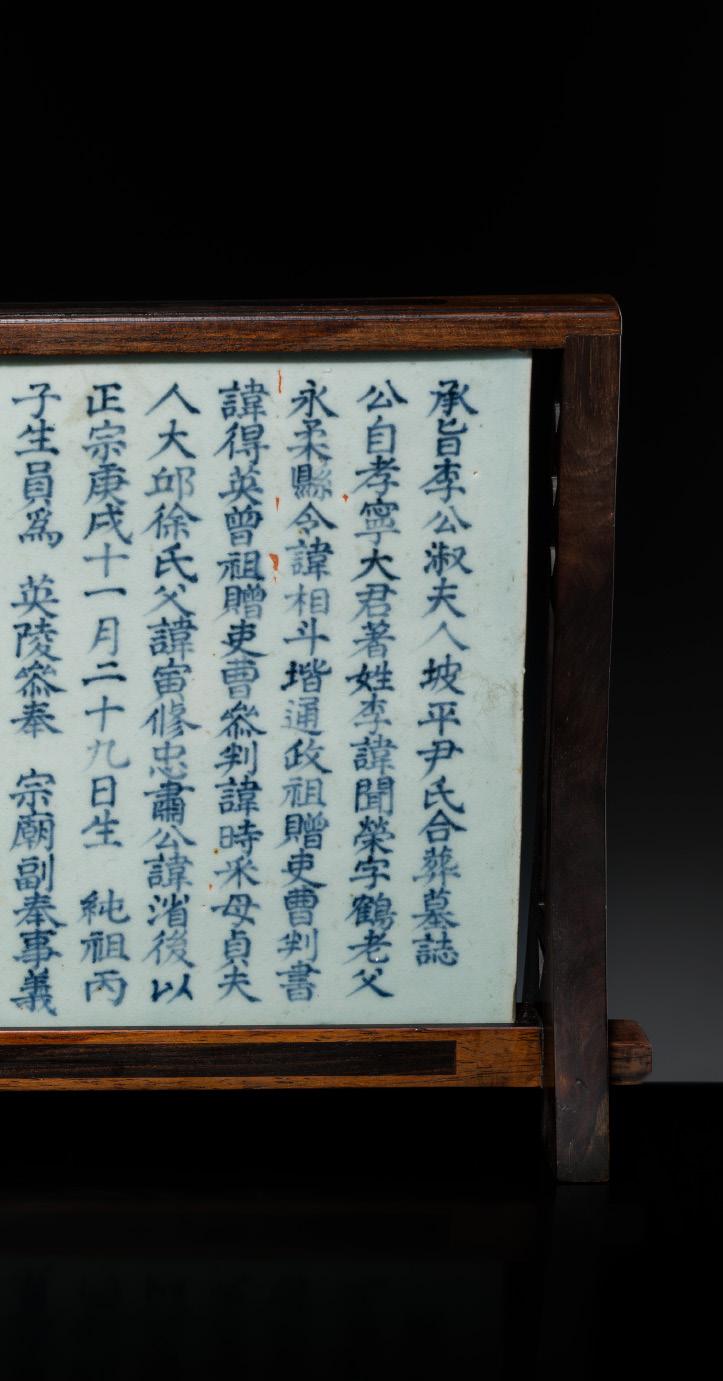
LITERATURE COMPARISON
Compare a related set of thirty-four epitaph tablets, dated 1736, length 25.1 cm (each tablet), in the Metropolitan Museum of Art, object number 1998.486.1–.34. Compare a closely related set of fourteen epitaph tablets, dated c. 1849, 19 x 18 cm, in the British Museum, registration number 1997,0721.1-14.
AUCTION RESULT COMPARISON
Type: Closely related
Auction: Bonhams
New York, 20 March 2019, lot 391



Price: USD 8,200 or approx. EUR 8,800 (for ten) converted and adjusted for inflation at the time of writing
Description: A set of ten blue and white epitaph plaques for the official Yoo Hanki, Joseon dynasty, dated by inscription to 1824
Expert remark: Compare the closely related form and underglaze-blue inscription. Note the size (18.1 x 15.5 cm).
Estimate EUR 3,000
Starting price EUR 1,500
Finely modeled in the form of a recumbent duck, the beak agape below circular eyes, and the plumage finely molded around the sides and back. The body covered in a deep grayish-celadon color save for the base revealing the buff ware.
Provenance: The Collection of Sam and Myrna Myers, Paris, France. Acquired between circa 1965-2012.
Condition: Excellent condition with minor surface wear and firing irregularities.
Weight: 246 g
Dimensions: Length 13.5 cm
EXPERT’S NOTE
Compare with a celadon-glazed duck-form water dropper dated to the Goryeo dynasty, 12th century, in the National Museum of Asian Art, Smithsonian Institution, accession number F1909.24.
Estimate EUR 1,000
Starting price EUR 500


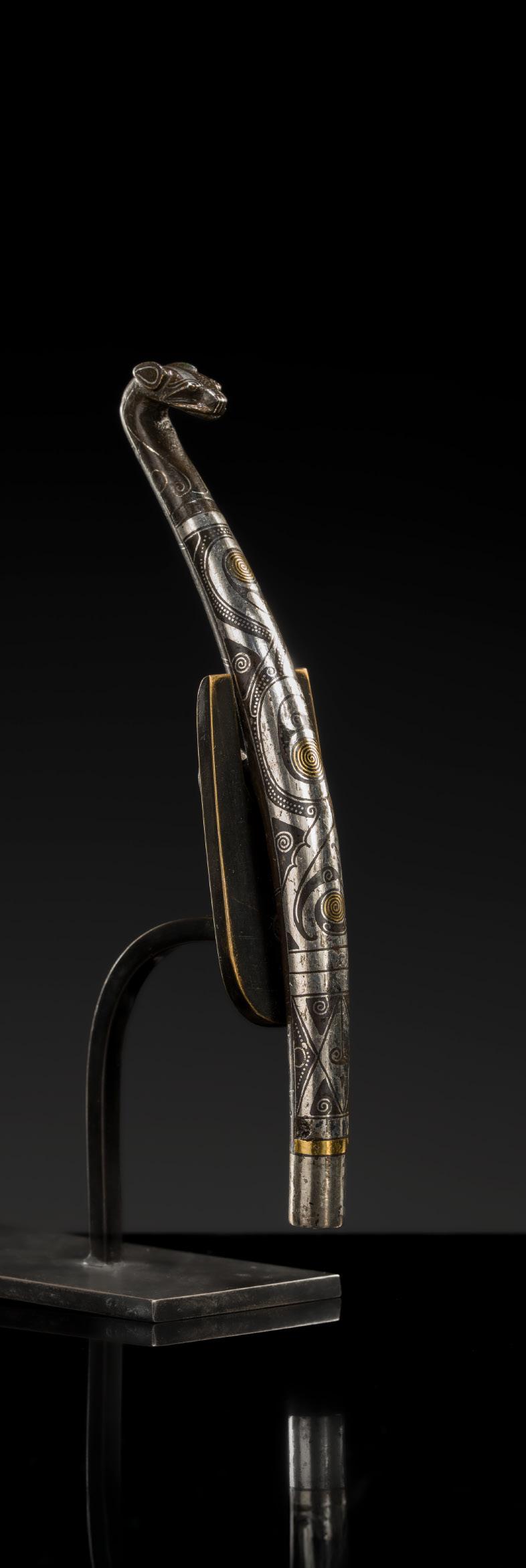

China. 475 BC-220 AD. The slender rounded shaft is intricately inlaid with gold and silver sheet, wire, and stippling, forming overlapping scrolls evocative of intertwined beasts punctuated with spiral designs, and a geometric pattern, framed by horizontal lines, all below the finely modeled and similarly decorated hook in the form of a dragon’s head, the underside with a circular button.
Provenance: The Collection of Sam and Myrna Myers, Paris, France. Acquired between circa 1965-2012.
Condition: Very good condition, commensurate with age. Wear, casting irregularities, traces of use, signs of burial, encrustations, expected tarnish and minor losses to inlays, the hook with a small fill to the neck. The bronze with a fine, naturally grown, dark patina with scattered malachite encrustation.
Weight: 150.1 g
Dimensions: Length 16.5 cm
LITERATURE COMPARISON
Compare a closely related gold and silver-inlaid bronze belt hook, dated to the Han dynasty,12.8 cm long, in the Palace Museum, Beijing, illustrated in The Complete Collection of Treasures of the Palace Museum. Bronze Articles for Daily Use, vol. 28, Hong Kong, 2006, p. 131, no. 110.
AUCTION RESULT COMPARISON
Type: Closely related

Auction: Christie’s New York, 18 March 2021, lot 607
Price: USD 60,000 or approx. EUR 62,000 converted and adjusted for inflation at the time of writing
Description: A gold and silver inlaid bronze belt hook, Warring States period (475-221 BC)
Expert remark: Compare the closely related form, manner of casting, and inlaid decoration. Note the size (11.5 cm).
Estimate EUR 1,500
Starting price EUR 800

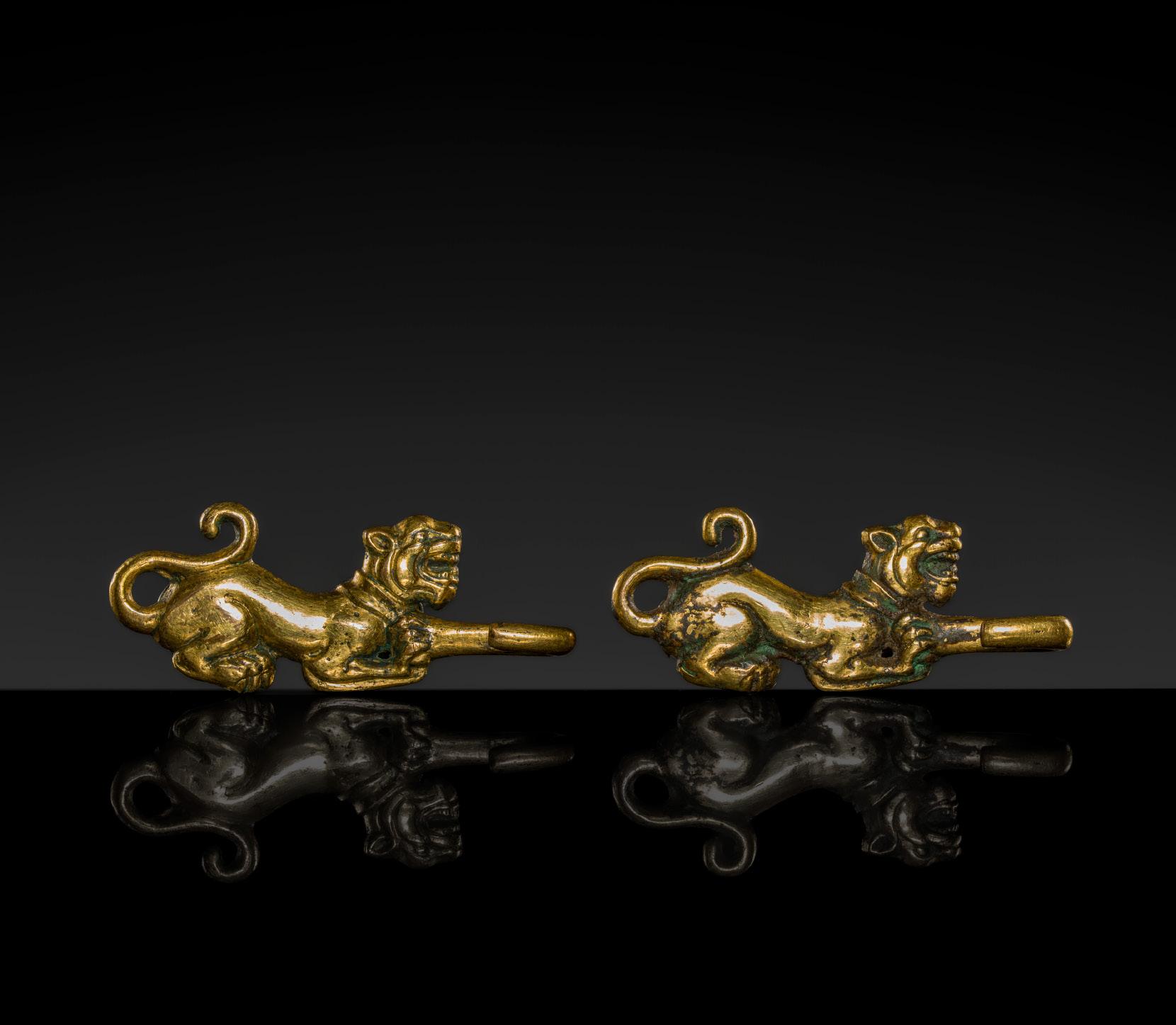
A RARE PAIR OF GILT-BRONZE ‘TIGER’ GARMENT HOOKS, WESTERN HAN DYNASTY
China, 2nd century BC. Each in the form a crouching feline seated on its haunches as it extends its forelimbs, the paws pushing against the hooks. The sinuously cast beast with a fierce expression, the head gently raised and mouth wide open in a snarl, and tail curled over the back. The back with two circular buttons. (2)
Provenance: The Collection of Sam and Myrna Myers, Paris, France. Acquired between circa 1965-2012.
Condition: Very good condition with minor wear, casting irregularities, traces of use, signs of weathering, small nicks, light surface scratches, tiny dings, expected minor losses to gilt, the bronze with a rich, naturally grown patina with areas of malachite encrustation.
Weight: 43.8 g and 44.6 g
Dimensions: Length 7.7 cm and 7.9 cm
The tiger is one of the oldest and most revered animals in Chinese history. According to Han mythology, the tiger symbolized the Western cardinal point, and in conjunction with the Green Dragon of the West, Vermilion Bird of the South and Black Tortoise of the North, positioned the burial within the spatial-temporal features of the universe. It is possible that tigers were deemed to protect the tomb occupant against the malign influences they may encounter in their afterlife.
Expert’s note: The design of the present hooks is related to an earlier group attributed to the Eurasian Steppes and specifically North China, often directly to the Ordos culture, known for significant finds of Scythian art. See for example a belt hook in the shape of a carnivore, Northwest China, 5th-4th century BC, in the Metropolitan Museum of Art, object number 2002.201.198; and a bronze tiger-form belt hook, North or Northeast China, 6th century, at Christie’s New York, 19 September 2013, lot 1112.
LITERATURE COMPARISON
Compare a closely related gilt bronze single garment hook, 7 cm long, also dated to the Western Han dynasty, 2nd century BC, formerly in the collection of Paul Singer, catalog number 1051, and illustrated on the website of the National Museum of Asian Art, Smithsonian Institution, under “Missing Art Objects from the Dr. Paul Singer Collection of Chinese Art”.
Estimate EUR 2,000
Starting price EUR 1,000


Exhibited:
1. Fondation Baur, The Beginning of the World – According to the Chinese. Dragons, Phoenix and Other Chimera, Geneva, 11 November 2020-23 May 2021.
2. Musée Départemental des Arts Asiatiques, The Beginning of the World – According to the Chinese. Dragons, Phoenix and Other Chimera, Nice, Summer 2021.
China, 206 BC-220 AD. Cast as a powerful winged beast in a striding stance, the right front leg stretched forward and the left hind leg extended, the thick paws slightly lifted off the ground exposing sharp claws, the head with two horns and raised alertly in a wild expression with large bulging eyes, a broad nose, and the mouth wide open in a roar revealing sharp fangs. The body detailed with tufts of fur and wing feathers with scrolling tips and a long tail.
Provenance: The Collection of Sam and Myrna Myers, Paris, France. Acquired between circa 1965-2012.
Condition: Good condition with expected wear, signs of prolonged burial, encrustations, areas of corrosion, a nick to the underside, few small losses. The bronze with a rich, naturally grown, mottled patina with extensive malachite and cuprite encrustation. The corrosion layers consist primarily of copper salts (oxides and chlorides) with tin-enriched areas, along with copper sulphide inclusions containing iron, which are consistent with authentic ancient patination processes.
Alloy Composition: The composition (85.4% copper, 10.1% tin, 4.5% lead) is characteristic of Chinese Han dynasty bronzes. The lead addition improved casting fluidity and reduced costs, while the ~10% tin content provides optimal mechanical properties for this period’s bronze technology.
Weight: 2,117 g
Dimensions: Length 25 cm
This bronze animal, although not monumental in size, has a universal sculptural quality that carries it well beyond the confines of Chinese art. With its imaginative, fanciful physique and dynamic quasi-naturalistic bearing, it can hold a place in any history of world art. The basic image of a mighty but not ferocious animal, depicted in a state of utmost alertness that makes one expect an immediate jump or other rapid movement, expresses qualities valued in any animal sculpture and achieved rarely as strikingly as in this figure.
The Han dynasty is the last period that can still be considered a part of the Bronze Age, but as bronze was no longer the one material vital for daily life and for ritual, it was increasingly explored also as an artistic medium. When looking at this dramatic sculpture, there can be no doubt that bronze casting had come a long way since its beginnings in the Shang dynasty, when animals tended to be shown in a distant, awe-inspiring mode. In the late Warring States period there began an interest in animal sculptures rendered in naturalistic poses and movements. This perceived naturalism made mythical creatures, cherished as guardians and benevolent supporters of men, seemingly more approachable.
Fabulous animals were frequently depicted in two-dimensional form, but sculptures worked in the round like the present lot are rare in the Han dynasty. Bronze animals that exist from this time mostly had a practical purpose, being cast as fittings, weights, tallies, belt hooks or supports carrying lamps, incense burners, frames for musical instruments and other items of perishable material which have not survived. Such bronzes were most probably used in daily life, even if some were eventually buried with important personalities.
Pixiu are mythical hybrid creatures, considered powerful protectors, resembling strong, winged tigers or lions, auspicious for wealth, and said to have a voracious appetite exclusively for gold, silver, and jewels. Therefore, Pixiu have always been regarded as being capable of drawing cai qi (wealth) from all directions, and according to the Chinese zodiac, they are especially helpful for those who are going through a bad year. There are two types of Pixiu: The one with two horns is the female, called Bixie. The one with only one antler is the male, called Tianlu.
Emperor Wu of the Han dynasty declared that the pixiu would be forever known as the ‘Treasure of the Emperor’, that only royal personage could possess a pixiu, and that it was strictly forbidden for all others to own one, including officials. This law was kept through to the very end of the Qing dynasty. Lifelike sculptures of these mythical beings made from durable materials, such as bronze and jade, were made to embody and pacify the elemental and supernatural forces of the living world.




PUBLISHED
Jean-Paul Desroches (ed.) et al, The Beginning of the World. Dragons, Phoenix and Other Chimera, Fondation Baur, Geneva, 2020, p. 166, no. 95.
Winged beasts in general (lion, tiger, deer, ram, eagle… etc.) are a popular and enduring subject in ancient Chinese works of art, and exist in many different forms (as a decorative pattern, flat carving or carving in the round). The term bixie first appeared in Jijiupian by Shi You in the Western Han period: ‘Sheji, bixie are both names of mythical beasts… bixie means ‘warding off the wicked’. It is said that jade pendants in the form of these two beasts can help prevent adversity and provide protection.’
The iconography of the bixie is closely associated with that of the griffin, popular in the Western Asia and Eurasia steppes, and originated in Mesopotamia in 3000 B.C. Bixie occupies a curious position in Chinese art. It is based on the imagery of a lion, a foreign animal, but has the spirit of a fierce tiger. It is often depicted alongside other exotic animals as artistic backdrops for monumental architectures, especially in the Han dynasty where palaces, temples, shrines and tombs were often decorated with large scale bronze or stone sculptures of Weng Zhong, qilin, tianlu, elephants, camels or horses. Bixie is an important component amongst the array that makes up this subject matter.
Although bixie have heads like a lion or a tiger, it is the tiger that most embodies its essence. In the Three Kingdoms period, Zhuge Liang in his military strategy coined the now well-known term ‘like a tiger added with wings’ to describe a general that excels at deploying his troops. The origin of this phrase can be found in his anthology Zhuge Zhongwuhou wenji, juan 4, edited by Zhang Shu (1781-1847): “Military command is the mandate to lead the three armies, and the authority of the chief commander. A general who has the command of the army and knows the essence of troop deployment to gain the upper hand, is like a fierce tiger that has been given wings and able to travel the four seas, to apply force when he sees fit.”
Zhuge Liang’s description of an able general as ‘a tiger added with wings’ is the Han dynasty bixie personified.
LITERATURE COMPARISON
Compare a closely related bronze fitting in the form of a supernatural animal, dated to the Han dynasty, ca. 1st-2nd century AD, 36.6 cm long, in the National Museum of Asian Art, Smithsonian Institution, accession number F1961.3 (fig. 1). Compare a related larger stone winged chimera, dated to the Eastern Han dynasty, found in 1992 in Mengjin, Henan, and presently in the Luoyang Museum, Henan.
AUCTION RESULT COMPARISON
Type: Related Auction: Bonhams Hong Kong, 24 November 2013, lot 529
Price: HKD 937,500 or approx. EUR 134,000 converted and adjusted for inflation at the time of writing
Description: An archaic bronze ‘mythical beast’ paperweight, Eastern Han dynasty Expert remark: Compare the related relief modeling, manner of casting, and subject. Note the smaller size (6.2 cm).
Estimate EUR 30,000
Starting price EUR 15,000


China, Yunnan Province. The ritual dagger in the form of the threeheaded Vidyaraja with his arms held to his chest in vairocana mudra, his resplendent wings and tail to the back, crowned with a tall mukta with a four-pronged vajra finial, and terminating in a tripartite blade issuing from a lotus-petal pedestal.
The back is cast with a ring-loop attachment in the form of a coiled snake.
Provenance: The Collection of Sam and Myrna Myers, Paris, France.
Acquired between circa 1965-2012.
Condition: Good condition with expected wear, casting irregularities, signs of weathering, encrustations, corrosion, rubbing, minuscule losses, expected flaking and losses to gilt, the ring-loop with one crack. The green-tinted bronze with a rich, naturally grown, dark patina.
Weight: 119 g
Dimensions: Height 11.2 cm
The Dali Kingdom’s ritual daggers—known in Sanskrit as kīla and in Tibetan as phurba—represent some of the earliest surviving examples of these significant tantric implements, predating most Himalayan counterparts and offering critical insight into Buddhist material culture along the Southern Silk Road. The Dali kingdom ruled a large swath of territory in what is now southwest China, centered in present-day Yunnan Province.
Dali’s daggers display considerable continuities with their more widespread Himalayan counterparts, but they differ in one key way: all Dali daggers are attached to rings, meaning that they could be slipped on a finger or looped on a cord. In addition, most Dali daggers feature the top half of a deity above and a blade below, which is less common in early Himalayan phurba.

Because the Dali texts—written in Sinitic script and drawing on TangSong sources—refer to instruments called ‘vajra stakes’ (jingang jue) rather than phurba, scholars infer that the physical daggers arrived via transregional exchanges from Pala India and Southeast Asia, then adapted within the Dali court’s Buddhist tradition, which blended Indic and Chinese cosmologies. The Dali kingdom bordered Song China, Dai Viet, Bagan, and Khams, with Pala territory just beyond Bagan, so different forms of Buddhism could have entered Dali from different directions. As ritual objects, these daggers may have served more devotional or protective roles than the actively manipulated phurba of Tibetan ceremonial practice.
The Dali daggers show many similarities with their Himalayan counterparts: they are bifurcated into a bottom half that consists of a three-faceted blade, and a top half that displays the torso and head of a deity as well as lotus and vajra decorations. They use similar, if not identical, materials: most Dali daggers are made of gilt bronze or copper, but there is at least one example made of iron; most Himalayan phurba are made of iron or wood, but there are also examples made of bronze, copper, steel, or other metal alloys. For further discussion, see Megan Bryson, “Dali Daggers: Buddhist Material Culture on the Southern Silk Road”, in Saved from Desert Sands. Re-discovering Objects on the Silk Roads, East and West, vol. 18, 2024, pp. 162-193.
LITERATURE COMPARISON
Compare a related Dali bronze kila with a single-faced bodhisattva, also wearing a double vajra crown and holding the hands in the vairocana mudra, excavated from the pagoda of Chongsheng Temple in Yunnan, currently in the collection of the Yunnan Provincial Museum, illustrated in Li Kunsheng, The Complete Works of Yunnan National Fine Arts: The Sculpture and Painting Arts of Nanzhao and Dali Kingdoms, Kunming, 1999, no. 298.
AUCTION RESULT COMPARISON
Type: Closely related
Auction: Christie’s Hong Kong, 29 May 2019, lot 2711
Price: HKD 1,062,500 or approx. EUR 129,000 converted and adjusted for inflation at the time of writing
Description: A gilt-bronze kila, Dali Kingdom, 12th century
Expert remark: Compare the closely related form, manner of casting, gilding, subject, and size (11.1 cm).
Note that this example also has it’s back cast with a ring-loop attachment in the form of a coiled snake.
Estimate EUR 10,000
Starting price EUR 5,000
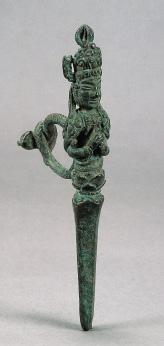






PUBLISHED


Jean-Paul Desroches (ed.) et al, Two Americans in Paris. A Quest for Asian Art, Paris, 2016, p. 75, no. 165.
Exhibited:
1. Pointe-à-Callière Museum, From the Lands of Asia. The Sam and Myrna Myers Collection, Montréal, 17 November 2016-19 March 2017.
2. Kimbell Art Museum, From the Lands of Asia. The Sam and Myrna Myers Collection, Fort Worth, Texas, 4 March-19 August 2018.
China, 4th-3rd century BC. The tubular bronze body, resembling a small bamboo stalk with a thick band at its center, decorated at both ends with bold jade collars, finely incised with scrollwork and carved in openwork to depict stylized dragons, whose slender bodies and bifurcated tails coil gracefully around the tube.
Provenance: The Collection of Sam and Myrna Myers, Paris, France. Acquired between circa 1965-2012.
Condition: Good condition with ancient wear, traces of weathering, signs of burial, encrustations overall. The jades with natural fissures, microscopic nibbling, one chilong with a minor old repair to the tip of its tail, and natural surface alterations. The bronze with few minute nicks, small surface scratches, and a rich, naturally grown patina with deep malachite encrustations.
Weight: 82.2 g
Dimensions: Length 12.2 cm
This tubular harness element was part of the luxurious equestrian equipment used by the aristocracy of the time, designed to both embellish and reinforce the straps of the saddle, as well as to secure the bridle, yoke, or pectoral decorations of the horse. Its dual longitudinal perforations allowed cords or leather strips to pass through the tube, distributing tension and ensuring the proper fitting of the assembly.
Beyond its practical function, the use of jade in such elements reflects the high status of its owner, as these equestrian ornaments served as visible symbols of prestige and power. These accessories were employed in both everyday and ceremonial contexts, integrating the horse, an essential animal for warfare and transportation, into the visual language of authority characteristic of Eastern Zhou nobility.
AUCTION RESULT COMPARISON
Type: Related
Auction: Christie’s Hong Kong, 29 November 2022, lot 2764
Price: HKD 819,000 or approx. EUR 94,500 converted and adjusted for inflation at the time of writing
Description: A very rare set of jade and bronze ‘chilong’ chariot fittings
Expert remark: Compare the related function, tubular form, and chilong subject. Note the size (15.7 cm) and slightly later dating.
Estimate EUR 10,000
Starting price EUR 5,000
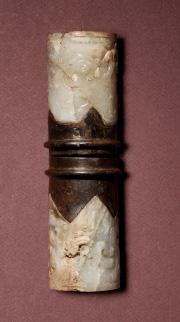
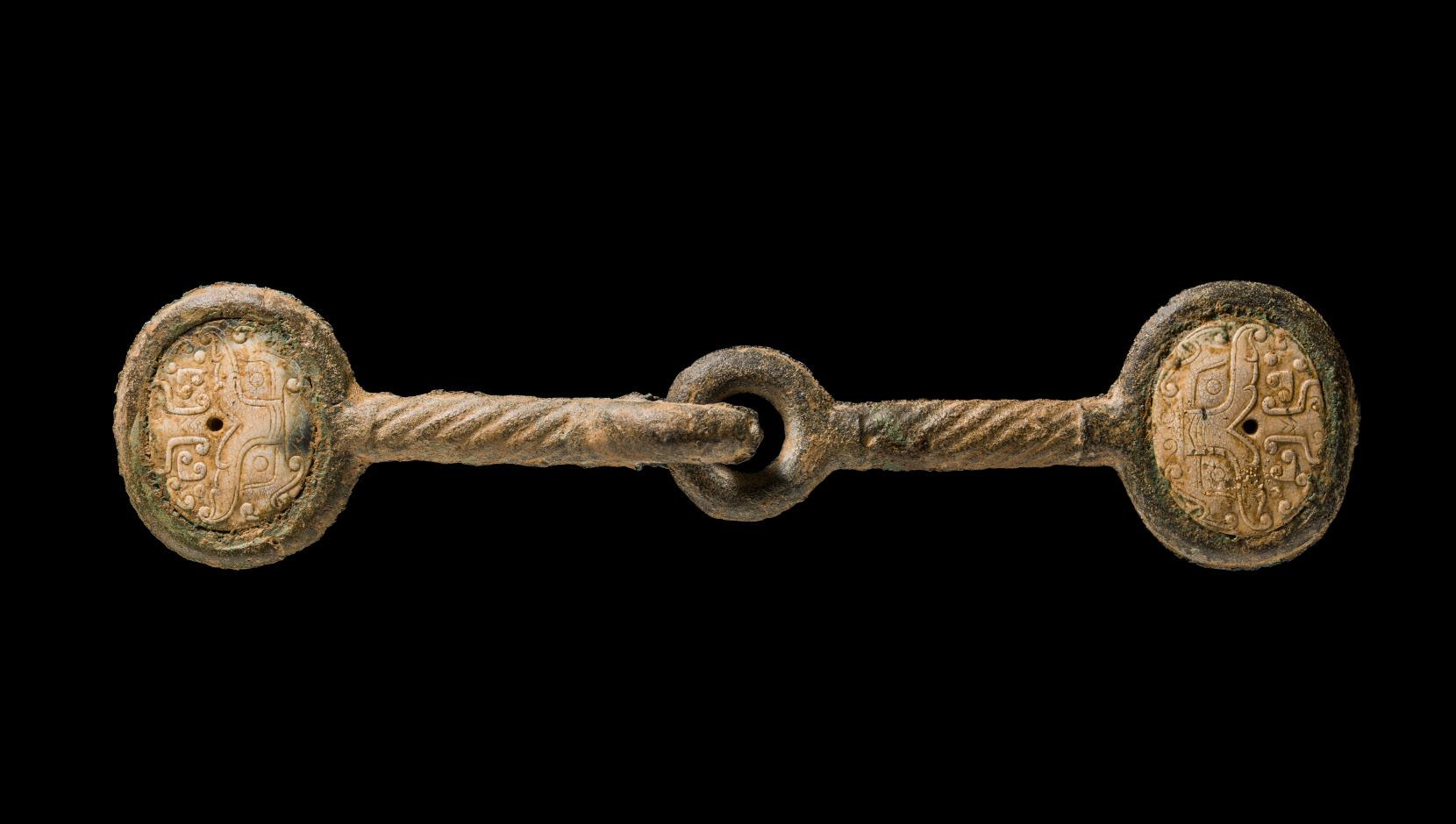
47 A JADE AND BRONZE HORSE BIT, EASTERN ZHOU DYNASTY, 4TH-3RD CENTURY BC


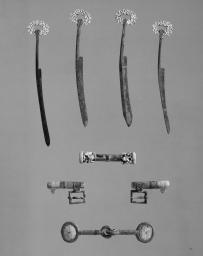

Weight: 202.6 g
Dimensions: Length 21 cm
AUCTION RESULT COMPARISON
Type: Related
Auction: Bonhams London, 9 November 2017, lot 6
Price: GBP 10,625 or approx. EUR 18,000 converted and adjusted for inflation at the time of writing
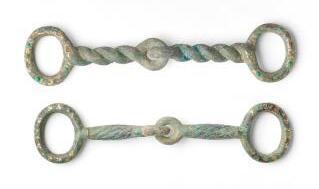
Description: A rare set of gold, silver and hardstone-inlaid bronze harness fittings, Eastern Zhou dynasty
Expert remark: Note this lot comprises a set of fourteen fittings, including two pairs of “connected ring fittings” which closely resemble the present horse bit in their form and rope-twist decoration.
Estimate EUR 6,000
Starting price EUR 3,000 PUBLISHED
Jean-Paul Desroches (ed.) et al, Two Americans in Paris. A Quest for Asian Art, Paris, 2016, p. 75, no. 167.
Exhibited:
1. Pointe-à-Callière Museum, From the Lands of Asia. The Sam and Myrna Myers Collection, Montréal, 17 November 2016-19 March 2017.
2. Kimbell Art Museum, From the Lands of Asia. The Sam and Myrna Myers Collection, Fort Worth, Texas, 4 March-19 August 2018.
China. The two bars finely decorated with a rope-twist design and terminating in a circular loop at one end, by which they are connected, and a larger oval loop on the other, skillfully inlaid with a pair of jade plaques carved in thread relief with taotie masks on each side, each pierced with a central aperture, the opaque calcified stones now of an ivory-white hue.
Provenance: The Collection of Sam and Myrna Myers, Paris, France.
Acquired between circa 1965-2012.
Condition: Good condition, commensurate with age. With ancient wear, casting irregularities, and signs of prolonged burial, including encrustations, weathering, and corrosion. The stones show natural fissures, dense crackling, and microscopic nicks. One bar has been repaired, with associated minor touchups. The bronze bears a naturally developed patina with extensive malachite encrustations, which, over millennia, have bled into the edges of the jade plaques, creating an overall superb patina. The bronze may once have been gilt.


Exhibited:
1. Pointe-à-Callière Museum, From the Lands of Asia. The Sam and Myrna Myers Collection, Montréal, 17 November 2016-19 March 2017.
2. Kimbell Art Museum, From the Lands of Asia. The Sam and Myrna Myers Collection, Fort Worth, Texas, 4 March-19 August 2018.
China, 3rd century BC. Of elegant sinuous form, the broad jade shaft topped by a raised openworked design of intertwined serpents, above two curved feet, each fitted with a bronze animal mask, opposite the gilt-bronze hook terminating in a dragon head, the reverse with a circular button. The semi-translucent stone of a bluish green tone with icy inclusions and extensive areas of creamy ivory-white calcification.
Provenance: The Collection of Sam and Myrna Myers, Paris, France. Acquired between circa 1965-2012.
Condition: Good condition, commensurate with age. Ancient wear, signs of prolonged burial, traces of weathering, casting irregularities, encrustations. One section of the intertwined serpents with an old repair. The stone with natural fissures, some of which have developed into small hairline cracks. The bronze with losses to gilt and a rich, naturally grown patina with malachite encrustation. The jade shows distinct signs of verdigris penetration and also calcification.
Weight: 146.4 g
Dimensions: Length 12 cm
With a padded silk storage box. (2)
The adoption of cavalry and the dress style of the nomadic tribes prompted in China the creation of many accessories closely related to the new outfit: belt hooks and belt buckles, garment hooks, fittings for iron swords, horse trappings and archery-related accessories. Besides their utilitarian function, these accessories also communicated the high status of their owners. Since jade had played this function up to the moment preceding these innovations, it is unsurprising to find it used during the Warring States and Han periods in the ornamentation of belt buckles like the present lot and other accessories forged in metal. Sometimes items commonly made in metal were entirely carved in jade, thus showing not only an adaptation of foreign elements derived from the nomadic people, but their full integration into the Chinese cultural sphere. Jade was considered precious by the Chinese and valued above anything else. Jades functioned not only as ritual and burial items during this time, but also as objects of personal adornment for the living. Other luxury materials, such as gold, bronze, and glass began to be incorporated with jades with greater frequency.


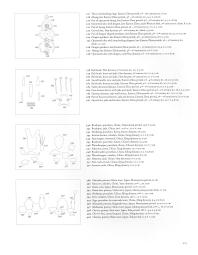

1. Jean-Paul Desroches (ed.) et al, Two Americans in Paris. A Quest for Asian Art, Paris, 2016, p. 74, no. 159.
2. Myrna Myers (ed.) & Filippo Salviati (auth.), The Language of Adornment. Chinese Ornaments of Jade, Crystal, Amber and Glass, Paris, 2002, no. 45.
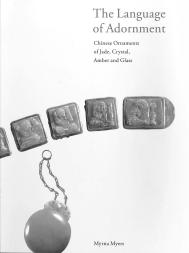
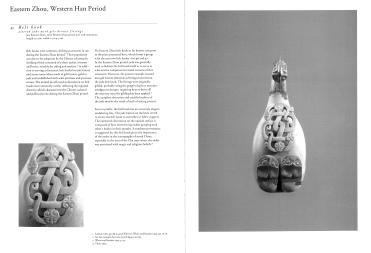

LITERATURE
COMPARISON
Compare a closely related jade and giltbronze garment hook, 9 cm long, dated Warring States to Western Han period, in the National Museum of Asian Art, accession number


F1953.82. Compare a related jade-inlaid gilt-bronze belt hook, 16.5 cm long, dated 4th-3rd century BC, in the Metropolitan Museum of Art, object number 1974.268.1.
AUCTION RESULT
COMPARISON
Type: Closely related
Auction: Sotheby’s Hong Kong, 8 April 2023, lot 3856

Price: HKD 406,400 or approx. EUR 46,000 converted and adjusted for inflation at the time of writing

Description: A jade and gilt-bronze belt hook, The jade: Eastern Zhou dynasty, Warring States period; the bronze later Expert remark: Compare the closely related technique with the jade and bronze similarly joined. Note the related size (11 cm). In light of the low estimate of HKD 10,000 and lengthy bidding war for this lot, it is plausible to assume that bidders were left unconvinced by Sotheby’s assertion that the bronze may be “later”.
Estimate EUR 15,000
Starting price EUR 7,500

A SET OF TEN GILT AND SILVERED COPPER REPOUSSÉ BELT PLAQUES, TANG
China, 618-1125. Each belt plaque finely chased to depict a recumbent deer sitting under an arched lotus stem bearing foliage and blossoms, all against a ring-punched ground, fitted to the underside with four short pegs for attachment. (10)
Provenance: The Collection of Sam and Myrna Myers, Paris, France. Acquired between circa 1965-2012.
Condition: Very good condition, commensurate with age. Wear, manufacturing irregularities, traces of use, rubbing to gilt, soil encrustations, small nicks, and minuscule dents. A rounded plaque with one peg lost.
Weight: 238 g (together)
Dimensions: Size ca. 5.2 x 10.6 cm (the rounded rectangular plaques), ca. 5.2 x 6.3 cm (the rectangular plaques)
Belt ornaments were a highly important part of attire in ancient China as it revealed the person’s rank and status. Under Tang dynasty sumptuary laws and dress regulations, the number of belt plaques related directly to the rank of the wearer. In the Liao dynasty, clothing and accessories related very closely stylistically to those in the Tang dynasty because the same laws and regulations were adopted, and the tradition of high-ranking figures wearing elaborate belt ornaments continued.
LITERATURE COMPARISON

Compare a group of seven related earlier gilt-bronze belt plaques with animal design, dated to the Sui dynasty, in the Asian Art Museum of San Francisco, object number B68B10a-g. Compare a group of five related gilt-bronze belt plaques with similar deer, dated to the Tang dynasty, 8th century, in the Metropolitan Museum of Art, object number 19.123a–e (fig. 1)
AUCTION RESULT COMPARISON
Type: Related
Auction: Christie’s New York, 14 September 2018, lot 1170
Price: USD 10,000 or approx. EUR 11,000 converted and adjusted for inflation at the time of writing
Description: A very rare group of fourteen gilt-bronze glass-inset belt ornaments, Tang-Liao dynasty (AD 618-1125)
Expert remark: Compare the related form and animal design. Note the size (4.8 cm) and different material.
Estimate EUR 3,000
Starting price EUR 1,500



50 A SET OF ELEVEN INCISED AND GILT JADE ‘IMMORTAL BANQUET’ BELT PLAQUES WITH GILT SILVER MOUNTS, LIAO DYNASTY
Exhibited:
1. Pointe-à-Callière Museum, From the Lands of Asia. The Sam and Myrna Myers Collection, Montréal, 17 November 2016-19 March 2017.
2. Kimbell Art Museum, From the Lands of Asia. The Sam and Myrna Myers Collection, Fort Worth, Texas, 4 March-19 August 2018.
China, 10th-11th century. Each of rectangular form and boldly carved in relief with incised and richly gilt accents. The translucent stones of a celadon tone with brown shadings, russet inclusions, grayish-white clouds, and icy veins. (11)
Comprising two groups of plaques, each decorated with identical figures oriented in opposing directions. The two terminal plaques depicting a seated man of portly stature, resting one arm on a cushion placed upon a low table while raising a cup, evoking a banquet scene. The remaining plaques featuring various attendants carrying trays with offerings, cross-legged musicians playing the sheng (mouth organ), and a young man holding a flask. All figures are attired in the characteristic loose-fitting tunics, long trousers, and headwear typical of Central Asian dress from the period.
Provenance: The Collection of Sam and Myrna Myers, Paris, France. Acquired between circa 1965-2012.
Condition: Good condition with expected wear, manufacturing irregularities, traces of use, rubbing and losses to gilt, soil encrustations, few minuscule nicks, small surface scratches, remnants of ancient leather and fabric, the jades with few minor losses, natural fissures, and thin hairline cracks. The complete set shows a beautiful and solid naturally grown patina overall.
Weight: 287.8 g
Dimensions: Length 3.3 to 5.5 cm
The present belt set represents a synthesis of two cultural traditions: the Nomadic and the Chinese. As a dress accessory, the belt reflects the nomadic heritage of the Liao, while the choice of jade is distinctly Chinese. Leather belts adorned with plaques became standard dress accessories among the nomadic and semi-nomadic peoples living north of the Chinese heartland.
Belts made of jade plaques sewn together appeared in China around the 3rd or 4th century AD and were likely derived from gold and silver prototypes used in the steppe regions. They were quickly adapted into the traditional Chinese dress code and produced in a variety of materials, with jade being the most significant. According to the Ming hui yao (Essential


PUBLISHED


& Filippo




of the
jade belts; those of the second rank have patterned belts [...]’.
LITERATURE COMPARISON
Compare a related, slightly earlier set of nine agate belt plaques with musicians and dancers, Tang dynasty, dated 618-906, 5.3 cm long, in the British Museum, museum number 1937,0416.129-137. Compare a related, slightly earlier set of ten decorative belt plaques, dated to the Tang dynasty, in the Metropolitan Museum of Art, accession number 1992.165.22a–j (fig. 1)
Estimate EUR 8,000 Starting price EUR 4,000

fig. 1

51
China, 10th-11th century. The group comprising three end pieces, a buckle, and eleven plaques with foliate contours, along with a pendant loop to which leather straps were likely attached. All elements worked in gilt bronze, with thirteen of the pieces embellished with jade insets carved in shallow relief to depict a bird in profile with its long tail gracefully turned upward. Each ornament consisting of an upper element bearing the jade inset, riveted to a plain bronze backing, with a deliberate space left between the two layers to allow the passage of a leather bridle. (15)
Provenance: The Collection of Sam and Myrna Myers, Paris, France. Acquired between circa 1965-2012.
Condition: Condition commensurate with age, with expected ancient wear, some areas with soil encrustation, some loose elements, sparse nicks, light surface scratches, and extensive rubbing to gilt-bronze fittings.




PUBLISHED
Weight: 309.1 g (total)
Dimensions: Length 2.9-4.4 cm
The horse was not simply a useful animal for the pastoral, nomadic people of Central Asia, but a valuable possession and a real companion in life. The Liao were no exception, and their high esteem for horses is proved by the precious harnesses of richly caparisoned horses discovered in princely tombs. The harness elements presented in this lot are a good example of this rare type of adornment. In workmanship and choice of precious materials, they approach ornaments worn by high-ranking people, whose status was also reflected in the decoration on the trappings of their mounts.

The jade insets are pivotal in determining the sex and the status of the owner of this harness. The bird depicted in profile, most likely to be a phoenix or a peacock, suggests that the harness was originally meant for a high ranking woman. This can be deduced by comparison with the harness discovered in the tomb of the Princess of Chen, which was found in one of the side funerary chambers of the tomb. That harness shows frequent use of the phoenix motif on the gilt-silver saddle flaps and even in the decoration of the horse’s bit. According to the Liaoshi, jade was considered as valuable as gold, so its presence in a royal tomb was a distinct status marker. Thus, the harness presented here, with its jade insets, was probably originally intended to adorn the mount of a woman closely associated with the Liao imperial family. See Inner Mongolian Institute of Cultural Relics and Archaeology (ed.), Liao Chengguo gongzhu Mu (Tomb of the Princess of State Chen), Beijing, 1993, fig. 11, 70-73.
LITERATURE COMPARISON
Compare a group of three related gilt-bronze mounted jade belt fittings, dated to the Liao dynasty, in the Museum of East Asian Art, Bath, record number BATEA : 451. Estimate EUR 10,000



AN EXTREMELY RARE ROCK CRYSTAL ‘BOVINE HEAD’ RHYTON WITH GOLD COVER, LIAO DYNASTY
Exhibited:
1. Pointe-à-Callière Museum, From the Lands of Asia. The Sam and Myrna Myers Collection, Montréal, 17 November 2016-19 March 2017.
2. Kimbell Art Museum, From the Lands of Asia. The Sam and Myrna Myers Collection, Fort Worth, Texas, 4 March-19 August 2018.
3. Musée d’Histoire de Nantes, Les Mongols et le monde. L’autre visage de l’empire de Gengis Khan, 14 October 2023-5 May 2024.
China, 10th-11th century. Carved as a deep libation vessel, the cup with a prominent two-horned bovine head projecting from one side to serve as a handle and resting on a flat base. The cover, crafted from a thin sheet of gold, worked in repoussé with two makara depicted in mutual pursuit against a ring-punched ground, secured by two gold chains.
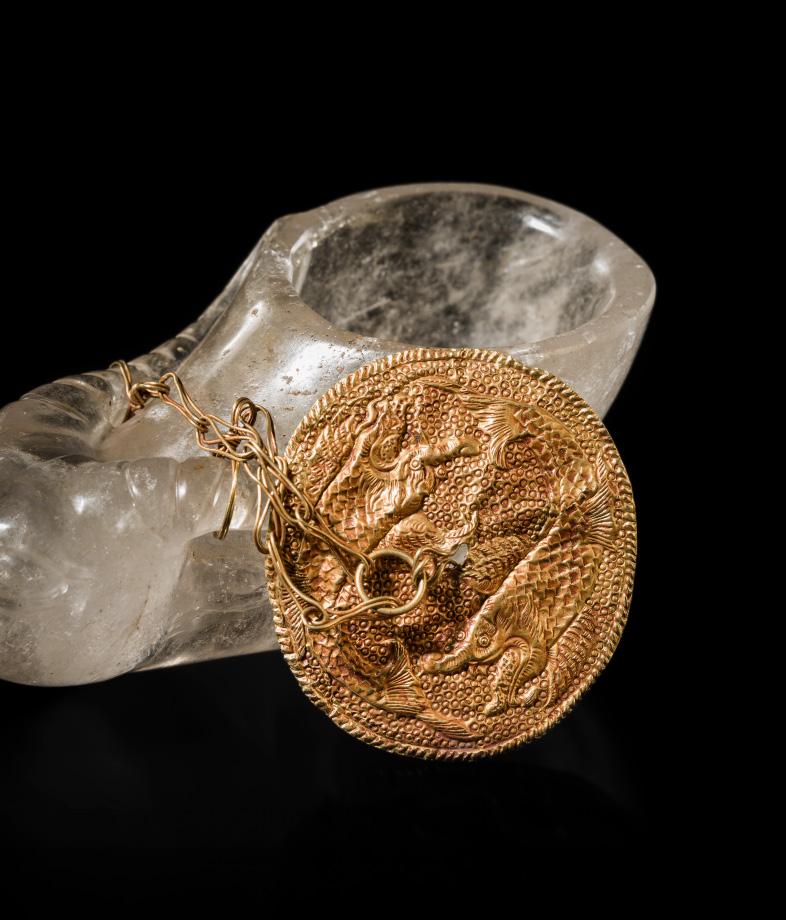
PUBLISHED
1. Myrna Myers (ed.) & Filippo Salviati (auth.), The Language of Adornment. Chinese Ornaments of Jade, Crystal, Amber and Glass, Paris, 2002, no. 74.
2. Jean-Paul Desroches (ed.) et al, Two Americans in Paris: A Quest for Asian Art, Paris, 2016, p. 162, no. 273.
3. Marie Favereau (ed.) et al, Les mongols et le monde, L’autre visage de l’empire de Gengis Khan, Musée d’histoire de Nantes & Chinggis Khaan National Museum, 2023, p. 49.

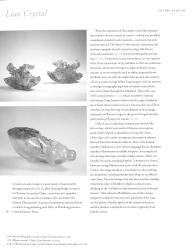

Provenance: The Collection of Sam and Myrna Myers, Paris, France. Acquired between circa 1965-2012.
Condition: Good condition with expected ancient wear. The crystal with natural inclusions and fissures, few minuscule nicks, and light scratches. The gold with light dents and a fine, naturally grown, reddish patina overall.
Weight: 183.8 g
Dimensions: 10.8 cm
AUCTION RESULT COMPARISON
Type: Closely related
Auction: Bonhams London, 5 November 2009, lot 252
Price: USD 4,800 or approx. EUR 10,500 converted and adjusted for inflation at the time of writing
Description: A rare rock crystal ‘bovine head’ libation cup and gold cover, Liao dynasty
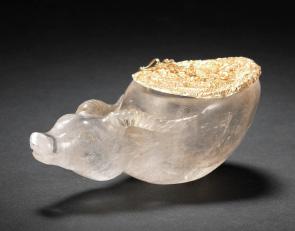
Expert remark: Compare the closely related form, manner of carving, and hinged gold cover. Note the much smaller size (5 cm).
Estimate EUR 6,000
Starting price EUR 3,000

A PAIR OF GILT AND INCISED ROCK CRYSTAL ‘GEESE’ VESSELS, LIAO
China, 10th-11th century. Each finely carved in the form of a goose preening itself, the body with a long sinuous neck forming a loop for the gilt-metal chain and stopper which is fitted neatly into a small circular aperture revealing the hollowed interior, the head and wings boldly incised and embellished with gilt. (2)
Provenance: The Collection of Sam and Myrna Myers, Paris, France. Acquired between circa 1965-2012.
Condition: Good condition with expected wear, traces of use, natural imperfections including fissures, one shallow chip, few minuscule nicks, losses to gilt.
Weight: 804.6 g (total)
Dimensions: Length 10.4 cm and 12.2 cm
Swans had special significance for the Liao, thus it is not surprising to see them carved in precious materials such as rock crystal and jade. Swan hunting was one of the principal seasonal activities of the Liao. At the
beginning of spring, when the grasslands turned green marking renewal, swans like other migratory birds returned to the lands inhabited by the Liao. During the ‘nabo’ ceremony, predatory birds were released to hunt the swans. The most desirable prey was the leader of the flock, which was presented by the emperor as a sacrifice to his ancestors or to Heaven.
AUCTION RESULT
COMPARISON
Type: Closely related
Auction: Bonhams Hong Kong, 27 November 2024, lot 514
Estimate: HKD 120,000 or approx. EUR 13,000 converted and adjusted for inflation at the time of writing

Description: A pair of rock crystal ‘goose’ holders with gold covers, Liao dynasty
Expert remark: Compare the closely related form, manner of carving and golden decoration. Note the smaller size (7 cm).
Estimate EUR 6,000
Starting price EUR 3,000


China, Neolithic period, c. 3500-3000 BC. Superbly carved as a small pig-dragon (zhulong), coiling around so that the straight tail abuts the jaw of the powerful head. The face is detailed with bulging eyes, a wrinkled snout and flared nostrils, the slit below the sealed lips meets the central perforation, and the neck is drilled for suspension. The semi-translucent stone is of a pale yellowish-green color with patches of russet inclusions and creamy white.
Provenance: The Collection of Sam and Myrna Myers, Paris, France. Acquired between circa 1965-2012.
Condition: Very good condition with minor wear, signs of prolonged burial, traces of weathering, minuscule nibbling, the stone with natural inclusions and fissures, some of which may have developed into small hairline cracks.
Weight: 28 g
Dimensions: Height 4 cm
The coiled pig-dragon (zhulong) which likely developed from the earlier slit ring and quite possibly the prototype of the dragon in Chinese art, is one of the principal jade forms of the Hongshan culture. A quintessential artifact, it reflects the Hongshan people’s mature and complex belief system centered on supernatural forces. Though both its facial design and body shape influenced later periods such as the Liangzhu and Shang, the form itself seems to have vanished with the disappearance of the Hongshan people. Archaeologists have identified the Liaoxi and Liaodong peninsulas and the upper and lower valleys of the Liao River as the heartland of the culture, where numerous jade zhulong have been unearthed—often from tombs, placed on the chest of the deceased, suggesting they were worn as chest ornaments. Fragments found at a goddess temple in Niuheliang, Liaoning province, further imply a possible connection to fertility rituals. See related discussion by Elizabeth Childs-Johnson in “Jades of the Hongshan Culture,” Arts Asiatiques, vol. XLVI, December 1991, pp. 82-95.
Literature comparison: Compare a related jade zhulong, 7.8 cm high, dated to the late Hongshan culture, in the National Palace Museum, Taipei, and included in their permanent exhibition Art in Quest of Heaven and Truth. Masterpieces of Jades in the Museum Collection. Compare a related jade zhulong, 9.5 cm high, in the Chinese University of Hong Kong Art Museum, accession number 1997.0418.

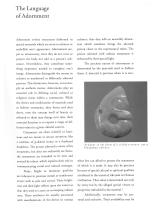


PUBLISHED
Myrna Myers (ed.) & Filippo Salviati (auth.), The Language of Adornment. Chinese Ornaments of Jade, Crystal, Amber and Glass, Paris, 2002, no. 5.
AUCTION RESULT COMPARISON
Type: Closely related
Auction: Sotheby’s Hong Kong, 18 April 2024, lot 506
Price: HKD 203,200 or approx. EUR 22,500 converted and adjusted for inflation at the time of writing
Description: A celadon jade ‘pig-dragon’ pendant, Neolithic period, Hongshan culture
Expert remark: Compare the closely related form, manner of carving, stone, and size (4.4 cm).
AUCTION RESULT COMPARISON
Type: Closely related
Auction: Christie’s New York, 21 March 2025, lot 1004
Price: USD 63,000 or approx. EUR 54,000 converted at the time of writing
Description: A very rare pale greyish-green and russet jade ‘pig dragon’, Neolithic period, Hongshan culture, 4th-3rd millennium BC
Expert remark: Compare the closely related form, manner of carving, and stone. Note the size (5.3 cm).
Estimate EUR 4,000
Starting price EUR 2,000



Exhibited:
1. Pointe-à-Callière Museum, From the Lands of Asia. The Sam and Myrna Myers Collection, Montréal, 17th November 2016-19th March 2017.
2. Kimbell Art Museum, From the Lands of Asia. The Sam and Myrna Myers Collection, Fort Worth, Texas, 4th March-19th August 2018.
China, ca. 3300-2200 BC. Finely carved in the form of a bird in flight with the wings spread far apart, the head with round double-incised eyes and a short beak. The semi-translucent stone of a celadon tone with extensive ivory-white calcification and russet inclusions.
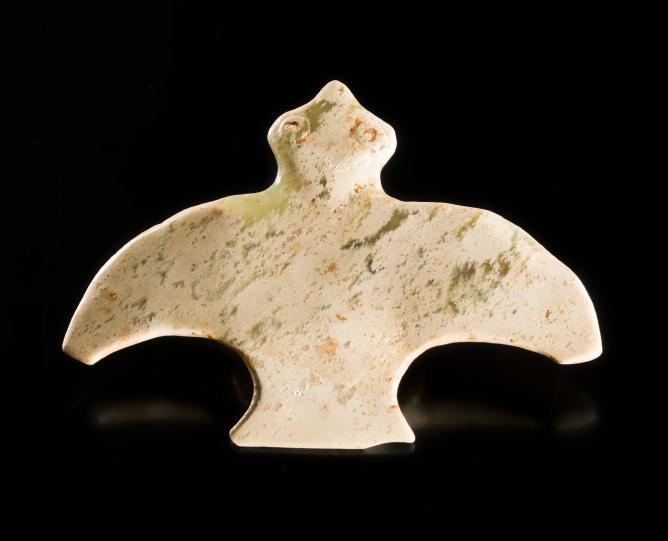
PUBLISHED
Jean-Paul Desroches (ed.) et al, Two Americans in Paris. A Quest for Asian Art, Paris, 2016, p. 38, no. 29.



Provenance: The Collection of Sam and Myrna Myers, Paris, France. Acquired between circa 1965-2012.
Condition: Good condition with expected wear, signs of prolonged burial, soil encrustations, old smoothened chips, few tiny nicks, the stone with natural fissures, some of which may have developed into small hairline cracks.
Weight: 44 g
Dimensions: Length 6.9 cm
LITERATURE COMPARISON
Compare a closely related Liangzhu jade bird plaque in the Zhejiang Provincial Museum, included in their exhibition Jade Vision: The Hongshan and Liangzhu Cultures, 10 December 2021-3 April 2022 (fig. 1)
Compare a closely related Liangzhu jade bird plaque unearthed from Fanshan site M15 in Yuhang, Hangzhou, Zhejiang. fig. 1
Estimate EUR 3,000
Starting price EUR 1,500
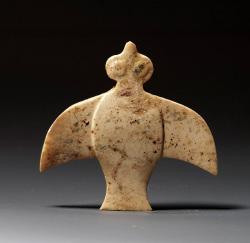

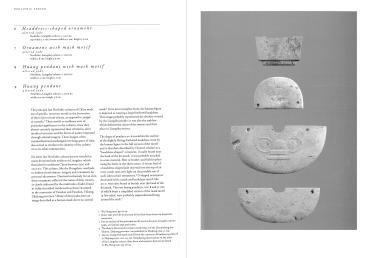

PUBLISHED
Myrna Myers (ed.) & Filippo Salviati (auth.), The Language of Adornment. Chinese Ornaments of Jade, Crystal, Amber and Glass, Paris, 2002, no. 8.
China, c. 2500 BC. The arc-shaped huang finely carved with a prominently godhead mask located at the center of the front side. Two small holes are drilled for suspension. The opaque stone completely calcified and of an ivory-white tone.
Provenance: The Collection of Sam and Myrna Myers, Paris, France. Acquired between circa 1965-2012.
Condition: Overall good condition, commensurate with age. Expected wear, signs of prolonged burial, traces of weathering and erosion, extensive calcification, two chips, small losses, minuscule nibbling here and there.
Weight: 54 g
Dimensions: Length 11.2 cm
Huang were a part of the elite adornments during the Neolithic period, especially within Hongshan, Liangzhu, and Longshan cultures. These were worn along with headgear, knee decorations, elaborate beaded necklaces, and other body ornaments, all made primarily from jade.
Dr. Elizabeth Childs-Johnson dubs these cultures a part of the ‘Jade Age’, a period during which an abundance of jade objects accompanied the elite burials for the first time. The imagery carved on these jade adornments was highly standardized, and the most prominent image, which appears on this lot, is that of the godhead (also called a spirit person, shenren, or an anthropomorphized deity). This image is flat, often covered in cosmic cloud scrolls, and has zoomorphic attributes combining bird and semi-human elements.
LITERATURE COMPARISON
Compare a closely related and similarly calcified jade huang with mask, unearthed from Pingyao, Yuhang, Hangzhou, and now in the Liangzhu Museum, illustrated by Liu Bin, ‘Eighty Years of Liangzhu Discovery, 1936–2016’, Jades for Life and Death, National Museum of Asian Art, Smithsonian Institution (digital publication), fig. 2h, and described by the author as a ‘major jade artifact’. Compare a closely related and similarly calcified jade huang with mask in the Jade Gallery of the Shanghai Museum, photographed by Gary Lee Todd and published on Wikimedia Commons. Compare a related Liangzhu jade ornament with mask, dated mid-3rd millennium BC, in the Metropolitan Museum of Art, object number 18.63.
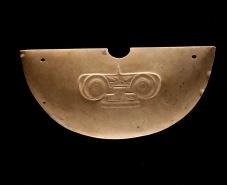
Estimate EUR 4,000
Starting price EUR 2,000




57
PUBLISHED
Jean-Paul Desroches (ed.) et al, Two Americans in Paris. A Quest for Asian Art, Paris, 2016, p. 45, no. 54.



Exhibited:
1. Pointe-à-Callière Museum, From the Lands of Asia. The Sam and Myrna Myers Collection, Montréal, 17th November 2016-19th March 2017.
2. Kimbell Art Museum, From the Lands of Asia. The Sam and Myrna Myers Collection, Fort Worth, Texas, 4th March-19th August 2018.
China, c. 3300-2200 BC. Of circular form, the thick disk with a central aperture drilled from both sides, the inner walls and outer edge finely polished as are the two faces of the disk, the stone now opaque and of an ivory-white color with dark veins and specks as well as hints of pale grayish-green.
Provenance: The Collection of Sam and Myrna Myers, Paris, France.
Acquired between circa 1965-2012.
Condition: Good condition with wear, signs of prolonged burial, traces of weathering, minor chips, smoothened losses, the calcified stone with natural veins and fissures, some of which have developed into small hairline cracks.
Weight: 417 g
Dimensions: Diameter 16 cm
Expert’s note: The stone of this jade has undergone complete alteration, a hallmark of Liangzhu culture jades. Over millennia, burial in mineral-rich soil has resulted in the calcified, chalky surface seen here, an aesthetic and material transformation prized by collectors and scholars alike. Despite the calcification, traces of the original fine polish remain visible on the surface, suggesting that the jade was highly finished before burial. The combination of altered material and surviving polish is typical for Liangzhu ritual jades.
AUCTION RESULT COMPARISON
Type: Closely related
Auction: Christie’s New York, 25 September 2020, lot 1723
Price: USD 11,875 or approx. EUR 13,000 converted and adjusted for inflation at the time of writing
Description: An opaque ivory-colored jade bi disc, Neolithic period, Liangzhu culture, 3rd millennium BC
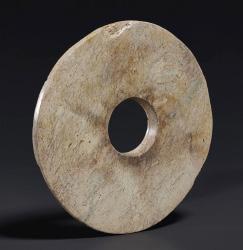
Expert remark: Compare the closely related form, manner of carving, and stone. Note the related size (14.5 cm).
AUCTION RESULT COMPARISON
Type: Closely related
Auction: Christie’s New York, 18 March 2009, lot 284
Price: USD 104,500 or approx. EUR 135,000 converted and adjusted for inflation at the time of writing
Description: A very rare opaque taupe and russet jade bi, Neolithic period, Liangzhu culture, 3rd millennium BC

Expert remark: Compare the closely related form, manner of carving, stone, and size (15.5 cm).
Estimate EUR 3,000
Starting price EUR 1,500
Exhibited:
1. Pointe-à-Callière Museum, From the Lands of Asia. The Sam and Myrna Myers Collection, Montréal, 17th November 2016-19th March 2017.
2. Kimbell Art Museum, From the Lands of Asia. The Sam and Myrna Myers Collection, Fort Worth, Texas, 4th March-19th August 2018.
Expert’s note: Only a handful of known cong feature this rare threetiered configuration: one tier of hybrid mask flanked by two deity masks. Among the estimated 200 Liangzhu jade cong in public and private collections worldwide, fewer than six are of this particular design. Notably, most three-tiered examples are squat, with a height less than the diameter of the mouth, and share a close resemblance in both configuration and carving technique. The current cong, however, stands out for the refinement of its incised decoration—especially the cloud-scrolls on the eyelids of the animal mask, a feature rarely executed with such precision.
China, c. 3300-2200 BC. The thick-walled cong with gently rounded sides and a cylindrical interior, carved to each corner with a stylized human and animal mask design. The eyes and noses as well as the raised bands above the masks and recesses in between are finely incised with line and scroll designs. The faces are divided with a gently recessed vertical band to the center of each side. The opaque, calcified stone is of an ivory tone with deep veins of russet, brown, dark gray, and green.
Provenance: The Collection of Sam and Myrna Myers, Paris, France. Acquired between circa 1965-2012.
Condition: Good condition with expected wear, signs of prolonged burial and traces of weathering, encrustations, extensive calcification, old smoothened chips, few minuscule nicks, the stone with natural fissures, some of which have developed into hairline cracks.
Weight: 706 g
Dimensions: Height 8 cm
The Liangzhu culture and its remarkable jade artifacts came to prominence in the late 1980s, when the discovery of several significant cemeteries brought international attention to the richness of their tomb contents. Since then, a wave of new archaeological findings has dramatically transformed our understanding of this late Neolithic civilization. At the Mojiaoshan site, Chinese archaeologists have uncovered the remains of a vast, walled settlement covering 750 acres. This site, the largest known walled settlement from late Neolithic China, includes palatial foundations, jade workshops, habitation zones, and a sophisticated network of internal waterways.



PUBLISHED
Jean-Paul Desroches (ed.) et al, Two Americans in Paris. A Quest for Asian Art, Paris, 2016, p. 36, no. 28.
Distinguished by their quantity, variety, and superb craftsmanship, Liangzhu jades are among the most iconic artifacts in the history of Chinese civilization. Among them, the jade cong stands out as the most emblematic. These objects feature a square exterior surrounding a circular inner hollow, with each corner serving as a vertical axis for the carving of symmetrical mask motifs. Early examples are typically squat and intricately decorated with deities or animal forms. In contrast, later versions are tall and slender, with stylized facial features dominated by prominent eyes and noses.
The present cong is incised with three horizontal tiers featuring twelve ‘crowned divine figure’ motifs. Two parallel lines above each figure signify the crown, while short horizontal ridges, engraved with swirling cloud patterns, depict the nose. The eyes consist of double circles connected by short, intermittent incised lines, with two short extensions on either side to mark the corners of the eyes.
Literature comparison: Compare a closely related Liangzhu jade cong, formerly in the collection of Charles Lang Freer and now in the National Museum of Asian Art, Smithsonian Institution, accession number F1916.118.
Type: Near identical
Auction: Christie’s Hong Kong, 27 November 2019, lot 2719
Price: HKD 31,325,000 or approx. EUR 3,760,000 converted and adjusted for inflation at the time of writing
Description: An extremely rare three-tiered jade Cong, Liangzhu culture, circa 33002300 BC
Expert remark: Compare the form, manner of carving, incision work, motifs, calcified stone, and size (7.8 cm).
Estimate EUR 30,000
Starting price EUR 15,000


Exhibited:
1. Pointe-à-Callière Museum, From the Lands of Asia. The Sam and Myrna Myers Collection, Montréal, 17th November 2016-19th March 2017.
2. Kimbell Art Museum, From the Lands of Asia. The Sam and Myrna Myers Collection, Fort Worth, Texas, 4th March-19th August 2018.
China, c. 3300-2200 BC. Of cylindrical form with square projections on four corners, the sides slightly tapering towards the base, each corner carved with a stylized mask comprising twin bands of narrow parallel grooves above incised circular ‘eyes’ and a short raised band with rounded ends for the ‘nose’, the dark green jade mottled and streaked with cloudy off-white and black inclusions.
Provenance: The Collection of Sam and Myrna Myers, Paris, France. Acquired between circa 1965-2012.
Condition: Very good condition with expected wear, signs of prolonged burial, traces of weathering and erosion, few minuscule nicks, old smoothened chips. The stone with natural inclusions fissures, some of which may have developed into small hairline cracks.
Weight: 3,542 g Dimensions: Height 28.5 cm
The Liangzhu culture and its remarkable jade artifacts came to prominence in the late 1980s, when the discovery of several significant cemeteries brought international attention to the richness of their tomb contents. Since then, a wave of new archaeological findings has dramatically transformed our understanding of this late Neolithic civilization. At the Mojiaoshan site, Chinese archaeologists have uncovered the remains of a vast, walled settlement covering 750 acres. This site, the largest known walled settlement from late Neolithic China, includes palatial foundations, jade workshops, habitation zones, and a sophisticated network of internal waterways.
Distinguished by their quantity, variety, and superb craftsmanship, Liangzhu jades are among the most iconic artifacts in the history of Chinese civilization. Among them, the jade cong stands out as the most emblematic. These objects feature a square exterior surrounding a circular inner hollow, with each corner serving as a vertical axis for the carving of symmetrical mask motifs. Early examples are typically squat and intricately decorated with deities or animal forms. In contrast, later versions are tall and slender, with stylized facial features dominated by prominent eyes and noses.
The development of tall cong is here fully realized in one of the best known of all types. It belongs to the category of larger cong fully displayed in tomb M3 at Jiangsu Wujin Sidun. Although large examples are abundant in this tomb, fourteen of the thirty-two found are over 20 cm in height. Very few tombs with such an abundance of cong have come to light, though a few large cong have come from smaller tombs. There are a number of large multi-tiered cong in museums in Asia and the West, and these pieces may all have come from one or two large tombs discovered in the late nineteenth or early twentieth century. Large cong must have been known as early as the Song period, when they were copied in Longquan celadon and Guan ware. Ming Wilson (Chinese Jades, London, 2004, pp. 15-16) suggests that the Song potters might have been inspired by the jade cong unearthed during the construction of their new capital at Lin’an, modernday Hangzhou, where many cong were found in recent decades.

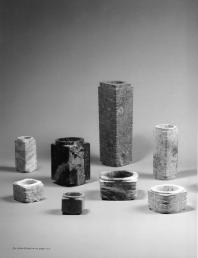
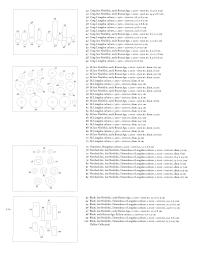

PUBLISHED
Jean-Paul Desroches (ed.) et al, Two Americans in Paris. A Quest for Asian Art, Paris, 2016, p. 42, no. 36.
LITERATURE COMPARISON
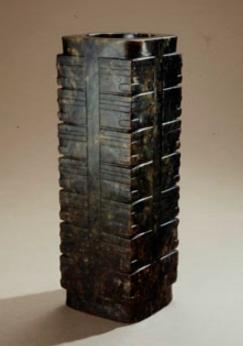

Compare two closely related Liangzhu jade cong, one with seven elements and the other with seventeen, both from the collection of Sir Joseph Hotung and now in the British Museum, registration numbers 2022,3034.242 and 2022,3034.241, dated to 3300-2200 BC, 23.3 cm and 49 cm high, in the British Museum, discussed by Jessica Rawson in Chinese Jade from the Neolithic to the Qing, cat. nos. 5 and 6, respectively.
AUCTION RESULT COMPARISON
Type: Closely related
Auction: Sotheby’s Hong Kong, 9 April 2024, lot 3603
Price: HKD 1,651,000 or approx. EUR 182,000 converted and adjusted for inflation at the time of writing
Description: A mottled jade cong, Neolithic period, Liangzhu culture
Expert remark: Compare the closely related form, manner of carving, and motifs. Note the size (23.8 cm) and mottled stone.
Estimate EUR 20,000
Starting price EUR 10,000


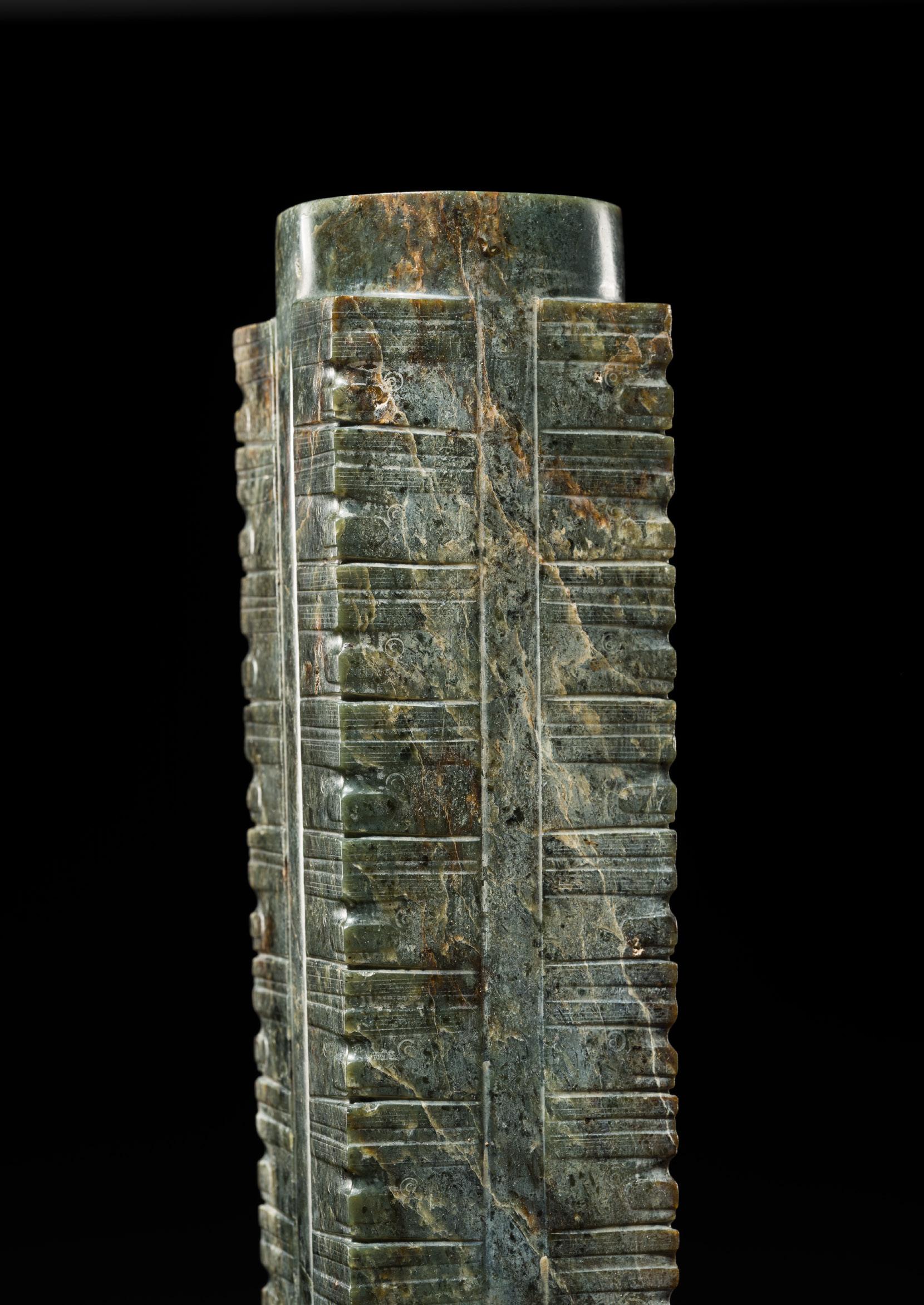




1. Myers Myers (ed.) & Filippo Salviati (auth.), Radiant Stones. Archaic Chinese Jades, Paris, 2000, no. 12.
2. Jean-Paul Desroches (ed.) et al, Two Americans in Paris. A Quest for Asian Art, Paris, 2016, p. 43, no. 39.


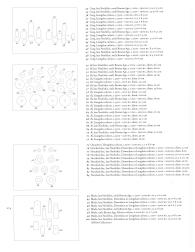

Exhibited:
1. Pointe-à-Callière Museum, From the Lands of Asia. The Sam and Myrna Myers Collection, Montréal, 17 November 2016-19 March 2017.
2. Kimbell Art Museum, From the Lands of Asia. The Sam and Myrna Myers Collection, Fort Worth, Texas, 4 March-19 August 2018.
Expert’s note: This magnificent cong, carved with thirteen tiers of stylized face masks, is of imposing and exceptionally tall size. The carving of such a large piece of jade several thousand years ago must have been extremely labor-intensive and time-consuming, signifying the great wealth and social status of its original owners.
External Expert Authentication: This lot was previously authenticated and dated by Sotheby’s London, confirming the dating stated above. The experts in charge were Henry Howard Sneyd, Senior Director and Chairman of Asian Arts (Americas & Europe), Chinese Works of Art, and Cherrei Tian, Deputy Director and Specialist in Chinese Works of Art. At the time, the lot was valued at GBP 300,000–500,000, equivalent to approximately EUR 375,000–625,000 when converted and adjusted for inflation as of the time of writing.
China, c. 3300-2200 BC. The mostly opaque stone of a variegated deep celadon and dark green tone with black specks as well as russet and off-white veins and inclusions, the natural mottling creating a fascinating interplay of colors with vivid cloud-like formations.
The cong of typical cylindrical form with square projections on four corners, sectioned into thirteen tiers of matching panels angled over the four corners, the sides slightly tapering towards the base, each corner carved with a stylized mask comprising twin bands of narrow parallel grooves above incised circular eyes and a short raised band with rounded ends for the nose.
Provenance: The Collection of Sam and Myrna Myers, Paris, France. Acquired in Hong Kong in 1999.
Condition: Very good condition with ancient wear, signs of prolonged burial and traces of weathering with associated tiny losses, minuscule nibbling, obvious losses to the mouth and one edge, the stone with natural fissures, some of which have developed into small hairline cracks.

Weight: 2,069 g (excl. stand), 3,014 g (incl. stand)
Dimensions: Height 37.8 cm (excl. stand), 39 cm (incl. stand)
With a fitted hardwood-shafted metal stand. (2)

The Liangzhu culture and its remarkable jade artifacts came to prominence in the late 1980s, when the discovery of several significant cemeteries brought international attention to the richness of their tomb contents. Since then, a wave of new archaeological findings has dramatically transformed our understanding of this late Neolithic civilization. At the Mojiaoshan site, Chinese archaeologists have uncovered the remains of a vast, walled settlement covering 750 acres. This site, the largest known walled settlement from late Neolithic China, includes palatial foundations, jade workshops, habitation zones, and a sophisticated network of internal waterways.
Distinguished by their quantity, variety, and superb craftsmanship, Liangzhu jades are among the most iconic artifacts in the history of Chinese civilization. Among them, the jade cong stands out as the most emblematic. These objects feature a square exterior surrounding a circular inner hollow, with each corner serving as a vertical axis for the carving of symmetrical mask motifs. Early examples are typically squat and intricately decorated with deities or animal forms. In contrast, later versions are tall and slender, with stylized facial features dominated by prominent eyes and noses.
The development of tall cong is here fully realized in one of the best known of all types. It belongs to the category of larger cong fully displayed in tomb M3 at Jiangsu Wujin Sidun. Although large examples are abundant in this tomb, fourteen of the thirty-two found are over 20 cm in height. Very few tombs with such an abundance of cong have come to light, though a few large cong have come from smaller tombs. There are a number of large multi-tiered cong in museums in Asia and the West, and these pieces may all have come from one or two large tombs discovered in the late nineteenth or early twentieth century. Large cong must have been known as early as the Song period, when they were copied in Longquan celadon and Guan ware. Ming Wilson (Chinese Jades, London, 2004, pp. 15-16) suggests that the Song potters might have been inspired by the jade cong unearthed during the construction of their new capital at Lin’an, modernday Hangzhou, where many cong were found in recent decades.
LITERATURE COMPARISON
One of the tallest surviving Liangzhu jade cong, 49.5 cm high, formerly in the collection of George Eumorfopoulos, is now preserved in the British Museum, registration number

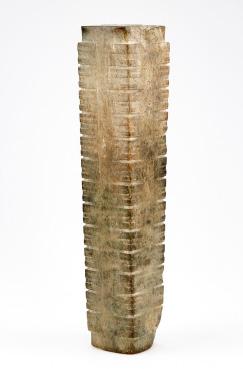
1937,0416.188. Compare a closely related Liangzhu jade cong of thirteen sections, 32.6 cm high, in the National Museum of Asian Art, Smithsonian Institution, accession number F2016.2a-d.
AUCTION RESULT COMPARISON
Type: Closely related
Auction: Bonhams New York, 20 March 2023, lot 21
Price: USD 1,500,375 or approx. EUR 1,368,000 converted and adjusted for inflation at the time of writing
Description: A large neolithic mottled grey jade cong, Liangzhu culture, circa 3000-2500
B.C.
Expert remark: Compare the closely related form, manner of carving, stone, and size (37.2 cm).
Estimate EUR 150,000
Starting price EUR 75,000


61
China, c. 3000-1800 BC. Of circular form, with a centrally drilled aperture retaining the cutting marks on the walls. The finely polished, mostly opaque stone of variegated shades of dark green and turquoise with cloudy white inclusions and patches of grayish-brown alteration.
Provenance: The Collection of Sam and Myrna Myers, Paris, France. Acquired between circa 1965-2012.
Condition: Very good condition, commensurate with age. Signs of prolonged burial including minor encrustations and small areas of corrosion with associated minute losses, traces of weathering, few minuscule nicks, the stone with natural fissures, some of which have developed into thin hairline cracks.
Weight: 5,008 g
Dimensions: Diameter 40.5 cm
Exceptionally large bi like the current example are exceedingly rare, with even the largest comparable disks recorded in private and public collections seldomly exceeding 30 cm and most ranging between 10 and 20 cm. Among the large variety of the artifacts of the Neolithic period, the present bi is close to those of the Liangzhu culture in the Yangtze River Delta, which flourished from the late 4th to the end of the 3rd millennium BC, and was one of the most prominent Neolithic Chinese civilizations. These plain disks, together with the squared cylinders known as cong, form an essential ritual pair in Liangzhu burials of high-status individuals.
LITERATURE COMPARISON
Compare a related jade bi disk, 3839 cm diameter, attributed to the Longshan-Qijia System, in the National Palace Museum, Taipei, object number 中玉000634N000000000. Compare a related Liangzhu jade bi, 34.2 cm diameter, formerly in the collection of Sir Joseph Hotung and now in the British Museum, registration number 2022,3034.246. Compare a related Liangzhu jade bi disk, 32 cm diameter, in the Cleveland Museum of Art, accession number 1917.974 (fig. 1)
AUCTION RESULT COMPARISON
Type: Related
Auction: Christie’s New York, 18 March 2009, lot 277
Price: USD 194,500 or approx. EUR 250,000 converted and adjusted for inflation at the time of writing
Description: A very rare and unusually large dark green jade bi, Late Neolithic period, Northwest China, circa 2000 BC
Expert remark: Compare the closely related form, stone, and manner of carving. Note the size (34.1 cm)
AUCTION RESULT COMPARISON
Type: Closely related
Auction: Bonhams Hong Kong, 1 December 2022, lot 3
Estimate: HKD 1,326,000 or approx. EUR 153,000 converted and adjusted for inflation at the time of writing
Description: A large green jade circular disc, bi, Neolithic Period
Expert remark: Compare the closely related form, stone, and manner of carving. Note the size (33.5 cm)
Estimate EUR 15,000
Starting price EUR 7,500





A LARGE AND COMPLETE CELADON AND RUSSET JADE NINE-SECTION DISK, BI, LATE NEOLITHIC PERIOD-EARLY BRONZE AGE
PUBLISHED
Jean-Paul Desroches
(ed.) et al, Two Americans in Paris: A Quest for Asian Art, Paris, 2016, p. 46, no. 73.



Exhibited:
1. Pointe-à-Callière Museum, From the Lands of Asia. The Sam and Myrna Myers Collection, Montréal, 17 November 2016-19 March 2017.
2. Kimbell Art Museum, From the Lands of Asia. The Sam and Myrna Myers Collection, Fort Worth, Texas, 4 March-19 August 2018.
China, c. 2200-1900 BC. Of circular form, composed of nine flat arc-shaped sections cut from a single piece of jade, each fashioned with straight edges and a beveled inner rim, as well as pierced with three holes drilled from one side to allow the sections to be joined together. The semi-translucent stone of a celadon tone with brown shadings and patches of creamy ivory-white calcification.
Provenance: The Collection of Sam and Myrna Myers, Paris, France. Acquired between circa 1965-2012.
Condition: Good condition with wear, signs of prolonged burial, traces of weathering, old smoothened losses, minute nicks, the stone with natural fissures, some of which have developed into small hairline cracks.
Weight: 1,764 g
Dimensions: Diameter 30.4 cm
Mounted on a transparent acrylic base. (10)
Segmented disks constitute a distinct category of jade objects, predominantly attested among the archaeological finds of north-western China, particularly within the Qijia culture. These disks were typically made from several arched segments, often cut from a single block of jade. In some cases, the segments were superimposed in such a way that the natural markings and veining of the stone align, clearly indicating that each segment was a ‘slice’ of the same original piece. It is plausible that this method of production was employed to maximize the use of the raw material and to create disks larger than the available blocks of jade would otherwise allow. Once cut and shaped, the segments were assembled and secured by cords threaded through perforations at their extremities. Segmented disks are also attested at sites dating to the Shang and Zhou periods, although they may in fact represent heirlooms or relics from earlier times.
LITERATURE COMPARISON


Compare a closely related, slightly later and larger jade nine-segmented bi, dated to the Western Zhou dynasty, 43.8 cm diameter, illustrated and exhibited by J. J. Lally, Ancient Chinese Jade, 15-29 March 2018, no. 80. Compare a related celadon and russet jade three-section disk from the Qijia culture, dated c. 2250-1900 BC, 12.1 cm diameter, in the Smithsonian National Museum of Art, accession number S2012.9.143a-c.
AUCTION RESULT COMPARISON
Type: Related
Auction: Sotheby’s Hong Kong, 8 April 2023, lot 3801
Price: HKD 76,200 or approx. EUR 8,600 converted and adjusted for inflation at the time of writing
Description: A set of three arc-shaped celadon jade pendants, huang, Neolithic period-early Shang dynasty

Expert remark: Compare the related form, manner of carving, and stone. Note that the bi is composed of only three segments, as opposed to nine on the present lot.
Estimate EUR 6,000
Starting price EUR 3,000


63 AN UNUSUAL BLACK AND WHITE ‘STRIPED’ MARBLE DISK, BI, LATE NEOLITHIC PERIOD-EARLY BRONZE AGE
Exhibited:
1. Pointe-à-Callière Museum, From the Lands of Asia. The Sam and Myrna Myers Collection, Montréal, 17th November 2016-19th March 2017.
2. Kimbell Art Museum, From the Lands of Asia. The Sam and Myrna Myers Collection, Fort Worth, Texas, 4th March-19th August 2018.
China, c. 2200-1900 BC. Of circular form with a central aperture drilled from one side. The opaque stone presenting a unique and beautiful arrangement of white stripes against a dark brownish-black ground with deep russet veins.
Provenance: The Collection of Sam and Myrna Myers, Paris, France. Acquired between circa 1965-2012.
Condition: Good condition with wear, signs of prolonged burial, traces of weathering, old smoothened losses, the stone with natural fissures, some of which have developed into small hairline cracks.
Weight: 615 g
Dimensions: Diameter 18.5 cm
PUBLISHED
Jean-Paul Desroches (ed.), Two Americans in Paris: A Quest for Asian Art, Paris, 2016, p. 44, no. 50.



Bi disks such as the current example have been thought to symbolize a connection between heaven and earth. This hypothesis has been solidified by the large number of examples found in ancient tombs of Chinese elite dating from the Neolithic to the Han Dynasty, also underscoring their significance as objects deemed important enough to accompany one to the afterlife. The Chinese character for jade, 玉 (yù), is a pictorial representation of three such disks suspended on a cord, an image that is also found in the Chinese character for king, 王 (wáng), which further emphasizes the precious nature and cultural significance of such disks.
Estimate EUR 4,000
Starting price EUR 2,000
A BLACK AND WHITE ‘STRIPED’ MARBLE AXE, YUE, LATE NEOLITHIC PERIODEARLY BRONZE AGE
China, c. 2200-1900 BC. The broad axe flaring towards the slightly beveled and rounded cutting edge with the butt end pierced with a large central aperture drilled from one side. The opaque stone presenting a unique and beautiful arrangement of white stripes against a dark brownish-black ground with deep russet veins.
Provenance: The Collection of Sam and Myrna Myers, Paris, France. Acquired between circa 1965-2012. Condition: Good condition with wear, signs of prolonged burial, traces of weathering, old smoothened losses, and one chip to the cutting edge. The stone with natural fissures, some of which have developed into small hairline cracks.
Weight: 310.3 g
Dimensions: Length 23.9 cm
While collectively termed ‘axe’ in English, jade axes have variations of translations in Chinese. Ceremonial jades of a trapezoidal form with a straight or curved edge would be named yue, produced for a long duration of time from the Neolithic period to the Zhou dynasty. As a ceremonial weapon, jade yue symbolized power in ancient Chinese culture. This jade yue would have been attached to a wood pole to be carried by officials as an emblem of authority.
LITERATURE COMPARISON
Compare a related marble tiger with a similar natural pattern of black and white veining, dated to the Western Zhou dynasty, 11th-9th century BC, 14.6 cm long, in the Metropolitan Museum of Art, object number 1985.214.93.

Estimate EUR 4,000
Starting price EUR 2,000

A RARE AND VERY LARGE (48 CM) DARK GREEN
JADE CEREMONIAL BLADE, YAZHANG, SHIMAO CULTURE


PUBLISHED
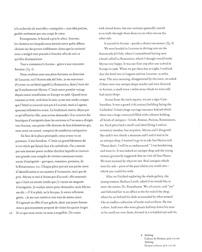

Exhibited:
1. Fondation Baur, The Beginning of the World – According to the Chinese. Dragons, Phoenix and Other Chimera, Geneva, 11 November 2020-23 May 2021.
2. Musée Départemental des Arts Asiatiques, The Beginning of the World – According to the Chinese. Dragons, Phoenix and Other Chimera, Nice, Summer 2021.
China, c. 2300-1800 BC. The gently waisted blade flaring towards the strikingly curved end, opposite the tang on the other end above a pierced hole and toothed projections on either side. The mostly opaque stone is of a dark green hue with black shadings, streaks, and specks.
Provenance: The Collection of Sam and Myrna Myers, Paris, France. Acquired between circa 1965-2012.
Condition: Very good condition with expected ancient wear, soil encrustations with remnants of ancient cinnabar, the stone with natural fissures, some of which may have developed into small hairline cracks. Traces of weathering and erosion. Microscopic nicks.

Weight: 475 g
Dimensions: Height 47.6 cm

Large jade blades such as the present example have no direct prototypes among Neolithic stone tools, and the origin of their distinctive shape remains unknown (see Jessica Rawson, Chinese Jade from the Neolithic to the Qing, London, 1995, p. 188). Often finely and thinly carved at considerable scale, these blades suggest a ceremonial function and have also been interpreted as sceptres. While this type flourished during the Erlitou period in the Central Plains, its broader distribution is striking—yet notably focused on two key sites: Guanghan in Sichuan and Shimao in northern Shaanxi (see Yang Boda, ‘Jade Zhang in the Collection of the Palace Museum, Beijing,’ in Chinese Jade. Selected Articles from Orientations 1983-1996, pp. 141-146; and Jessica Rawson, ibid., pp. 188-191). The strong presence of such blades at Shimao, particularly in elite contexts, underscores their importance within its ceremonial and political landscape.
The Shimao Culture has dramatically reshaped how we understand the origins of complex society in ancient China, challenging long-held views that early civilization radiated solely from the Central Plains. Discovered in the 1970s but only recognized as a major urban site decades later, Shimao was a massive stone-walled city in northern Shaanxi, complete with fortifications, palatial terraces, jade-inlaid walls, and zones for ritual sacrifice. Its monumental architecture—including a stepped pyramid crowned by elite residences—and its evidence of advanced craft production and long-distance exchange suggest it was not a periphery, but a dynamic heartland. Far from being a passive recipient of influence, Shimao appears to have been a powerful, independent center of exchange and innovation at the origin of many Middle Yellow River traditions, which would inform the development of the slightly later Erlitou culture.
EXPERT’S NOTE
The present blade is also comparable to examples excavated from ritual pits at the Xinzhai Wenhuazui site in Henan province (see Deng Cong, Yazhang yu guojia qiyuan, Beijing, 2018, no. 4), further supporting its function in pre-Erlitou sacrificial contexts. According to research by Japanese archaeologist Okamura Hidenori, the yazhang originated as a ritual object used in sacrificial rites before the Erlitou Culture, becoming one of the most important ceremonial jade types during the Erlitou period itself.
AUCTION RESULT COMPARISON
Type: Closely related

Auction: Christie’s Hong Kong, 30 November 2020, lot 2702
Price: HKD 2,250,000 or approx. EUR 264,000 converted and adjusted for inflation at the time of writing
Description: A dark green jade ceremonial blade, Yazhang, Erlitou culture or slightly earlier
Expert remark: Compare the closely related form, manner of carving, and stone, with similar toothed projections and dark green color. Note the size (32 cm).
Estimate EUR 20,000
Starting price EUR 10,000



66
Exhibited:
1. Pointe-à-Callière Museum, From the Lands of Asia. The Sam and Myrna Myers Collection, Montréal, 17th November 2016-19th March 2017.
2. Kimbell Art Museum, From the Lands of Asia. The Sam and Myrna Myers Collection, Fort Worth, Texas, 4th March-19th August 2018.
Expert’s note: The marbled ‘cloud’ patterns on this jade are entirely natural, formed over millennia of weathering and exposure to the elements. Such patterns, which cannot be created or imitated artificially, left the first excavators during the Ming and Qing dynasties in absolute awe. Most notably, the Qianlong Emperor dedicated several of his most important poems to jades like this, treasuring them in his private rooms within the Forbidden City.
China, c. 13th-11th century BC. Superbly carved as a thin rectangular blade with a bifurcated tip, the handle pierced with a central aperture flanked by pairs of notches and flanges to the edge. The mostly opaque stone of a beautiful ivory-white tone with veining and patches forming vivid cloud-like patterns in hues of ochre, gray, and deep mossy green, as well as faintly translucent areas.
Provenance: The Vallin Galleries, Wilton, Connecticut, USA, 19 October, 1975. The Collection of Sam and Myrna Myers, Paris, France, acquired from the above. A copy of an invoice from Vallin Galleries, USA, dated 19 October 1975, accopanies this lot.
Condition: Very good condition, commensurate with age. Expected ancient wear, traces of weathering and erosion, signs of prolonged burial including encrustations and numerous fatigue cracks across the handle, extensive calcification, few old smoothened losses and minuscule nibbles, the stone with natural fissures, some of which have developed into small hairline cracks.
Weight: 392 g
Dimensions: Height 47 cm
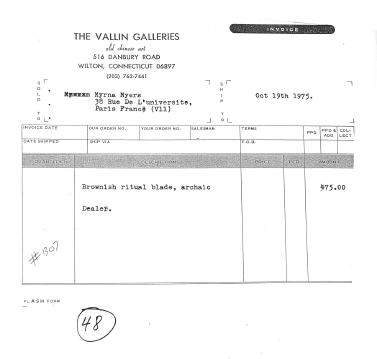

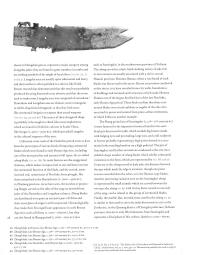


PUBLISHED
Jean-Paul Desroches (ed.) et al, Two Americans in Paris. A Quest for Asian Art, Paris, 2016, p. 49, no. 90.
The present lot relates closely to a number of blades excavated at Jinsha, an archaeological site located in Qingyang, Chengdu, the capital of the Chinese province of Sichuan. The site is one of the major archaeological discoveries in China during the 21st century. After the decline of Sanxingdui, Jinsha emerged as the capital of the Shu state in the Shang or Western Zhou dynasty. It disappeared between 500 BC and 200 BC with various theories as to the cause positing political revolution, earthquakes, or flooding. The site was accidentally discovered in 2001 after construction revealed a drain which contained artifacts made of bronze, jade, stone and ivory. In 2007, the Jinsha Museum was constructed to display the artifacts and features found. The objects discovered, besides the aforementioned jade blades, include the gold sunbird, a national symbol of China according to the State Administration of Cultural Heritage.
LITERATURE COMPARISON
Compare a related earlier mottled jade blade excavated at the Erlitou site in Yanshi in 1974 and now in the Luoyang Museum, Henan.

AUCTION RESULT COMPARISON
Type: Related
Auction: Bonhams London, 9 November 2017, lot 1
Price: GBP 81,250 or approx. EUR 140,000 converted and adjusted for inflation at the time of writing
Forked blades (zhang) first made their appearance during the Neolithic period, although their source of inspiration remains unknown as the form has no prototype in stone implements of the period. The function of this type of blade has been an area of discussion, and interpretations of it as a military implement have bene suggested in ancient texts such as Zhouli (Rites of Zhou), as well as Zheng Xuan’s commentaries in the Eastern Han dynasty. Blades of this form are often of large size and are finely and thinly carved, suggesting a ceremonial function, which is consistent with archaeological excavation findings from sacrificial pits.
Description: A rare and large mottled beige jade blade, yazhang, Neolithic period
Expert remark: Compare the related form, manner of carving, and mottled stone. Note the size (41.6 cm) and earlier dating.
Estimate EUR 15,000
Starting price EUR 7,500


PUBLISHED
Jean-Paul Desroches (ed.) et al, Two Americans in Paris. A Quest for Asian Art, Paris, 2016, p. 50, no. 92.



Exhibited:
1. Pointe-à-Callière Museum, From the Lands of Asia. The Sam and Myrna Myers Collection, Montréal, 17 November 2016-19 March 2017.
2. Kimbell Art Museum, From the Lands of Asia. The Sam and Myrna Myers Collection, Fort Worth, Texas, 4 March-19 August 2018.
China, c. 13th-11th century BC. The long blade with a median ridge extending on both sides and beveled edges continuing to where the blade begins to taper to the point, issuing from a bronze handle decorated on either side with a stylized taotie mask cast in threadrelief below the hafting bar and hole in the nei which is cast to one side with a clan mark. The opaque stone of variegating hues of grayishgreen, deep celadon, and dark olive with brown and ivory-white shadings.
Inscriptions: The pictogram cast onto the current blade’s handle can be interpreted as xian (先) and depicts the stylized profile of a human figure surmounted by a footprint. This ideographic composition conveys the concept of leadership or precedence, symbolizing an individual who ‘leads the way’ or ‘goes before others’. Such clan marks were not merely decorative, but rather served as powerful identity symbols for elite lineage groups and would have carried connotations of authority, ancestral prestige, and divine sanction. Objects of this type and quality were likely used in ceremonial contexts, possibly associated with ancestral worship or elite martial display.
Provenance: The Collection of Sam and Myrna Myers, Paris, France. Acquired between circa 1965-2012.
Condition: Superb condition, commensurate with age. Old wear, signs of prolonged burial and traces of weathering, minuscule nibbles, one small chip to the edge. The bronze is richly encrusted and covered in a naturally grown patina with vibrant malachite as well as scattered cuprite and azurite encrustations.
Weight: 252.2 g
Dimensions: Length 25.1 cm
This magnificent halberd blade exemplifies a weapon type first developed at Erlitou (c. 1900–1500 BC) and brought to full maturity during the Shang dynasty. Shang artisans elevated the form with exquisite craftsmanship, often embellishing examples with jade inlay and casting complex taotie masks as seen in the current lot. Blades such as this reflect the dual function of the ge as both a military implement and a symbol of elite authority. Similar examples have been recovered from high-status tombs, notably at Anyang, underscoring their ritual significance and political value. The fine casting and rich burial patina attest to the object’s age and importance.
Expert’s note: The line-work on the taotie decoration on this present lot is particularly fine. The taotie would have been inlaid, probably with turquoise or other precious materials. Compare two related examples with intact inlay, one excavated from the Tomb of Fu Hao, c. 1200 BC, Anyang, and exhibited in the National Museum of China, and another formerly in the collections of Arthur M. Sackler and Chang Wei-Hwa, sold at Christie’s Hong Kong, 30th November 2020, lot 2706.
Literature comparison: Compare a closely related jade dagger-axe in a bronze haft with taotie and zoomophic designs, dated to the Shang dynasty, 12th-11th century BC, 23.8 cm long, in the Harvard Art Museums, object number 1943.51.7, illustrated by Max Loehr and Louisa G. Fitzgerald Huber, Ancient Chinese Jades from the Grenville L. Winthrop Collection in the Fogg Art Museum, Harvard University, 1975, cat. no. 74, where the designs are described as “bronze cloisons, but without any trace of inlay.”
AUCTION RESULT COMPARISON
Type: Closely related
Auction: Sotheby’s Hong Kong, 22 April 2021, lot 46
Price: HKD 2,252,000 or approx. EUR 266,000 converted and adjusted for inflation at the time of writing
Description: A jade ge and archaic bronze haft, Shang dynasty
Expert remark: Compare the closely related form of the beveled blade and similar bronze handle cast in thread-relief with taotie masks. Note the size (18.5 cm).
AUCTION RESULT COMPARISON
Type: Closely related
Auction: Christie’s London, 3 November 2020, lot 1
Price: GBP 212,500 or approx. EUR 342,000 converted and adjusted for inflation at the time of writing
Description: A very rare jade halberd blade with turquoise-inlaid bronze shaft, ge, late Shang dynasty, Anyang, 12th-11th century BC
Expert remark: Compare the closely related form of the beveled blade and similar color of the stone, and bronze handle cast in thread-relief with taotie masks. Note the related size (23.2 cm).
Estimate EUR 15,000
Starting price EUR 7,500
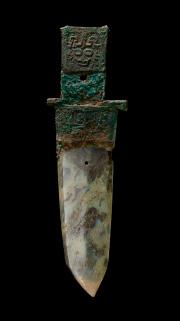
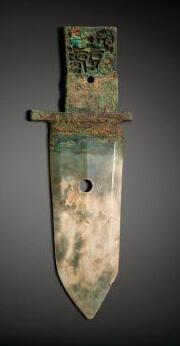

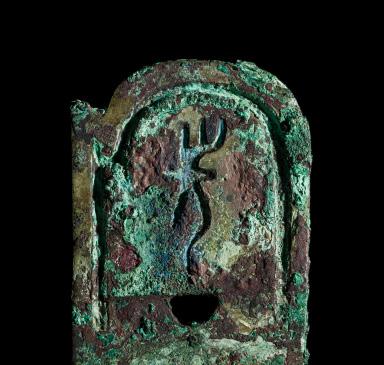
68 A RARE JADE ‘TAOTIE’ CEREMONIAL DAGGER-AXE, GE, LATE SHANG DYNASTY, ANYANG PHASE

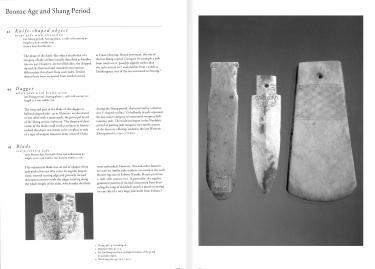

PUBLISHED
Myrna Myers (ed.) & Filippo Salviati (auth.), Radiant Stones. Archaic Chinese Jades, Paris, 2000, no. 44.
China, circa 13th-11th century BC. The blade is thinly carved in ge form with a pointed tip and a median ridge extending on both sides. The tang pierced with a single hole and incised with a taotie mask on either side. The stone with extensive opaque ivory-white with translucent areas of of an ivory-white tone with translucent areas of white and russet as well as icy veins.
Provenance: The Collection of Sam and Myrna Myers, Paris, France. Acquired between circa 1965-2012.
Condition: Good condition with expected wear, signs of prolonged burial and traces of weathering with associated small losses, minor nibbling and few minute chips along the edges.
Weight: 32.9 g
Dimensions: Height 12.8 cm
The present ge is decorated with a taotie mask, the principal motif of the Shang artistic repository. The shape and decoration of the blade recall similar artifacts in bronze: indeed, the object was meant to be a replica in jade of a type of weapon found in many areas of China during the Shang period, characterized by a distinctive V-shaped outline. Ge halberds represent the last major category of ceremonial weapons fashioned in jade. The tradition of putting jade weapons in tombs as part of the funerary offerings, begun in the Neolithic period, ending in the late Western Zhou dynasty.
Jade ge of the Xia, Shang, and Zhou dynasties were mainly used for ceremonial purposes. A significant number of jade ge were found in the tomb of Fu Hao, at Yinxu in Anyang, Henan Province, demonstrating the importance of these ritual blades; see Yinxu Fu Hao mu, Beijing, 1980, col. pl. 17.1, 17.2, and 18.1.
LITERATURE COMPARISON
Compare a closely related ceremonial dagger-axe with animal masks, 4.4 cm long, Shang dynasty, c. 1600-1050 BC, in the Cleveland Museum of Art, accession number 1983.2 (fig. 1). Compare a closely related jade dagger-axe with taotie designs, dated Shang-Western Zhou dynasty, 11th-10th century BC, 11 cm long, in the Harvard Art Museums, object number 1943.50.91, illustrated by Max Loehr and Louisa G. Fitzgerald Huber, Ancient Chinese Jades from the Grenville L. Winthrop Collection in the Fogg Art Museum, Harvard University, 1975, cat. no. 67. fig. 1
AUCTION RESULT
COMPARISON
Type: Closely related Auction: Sotheby’s New York, 22 March 2011, lot 63
Price: USD 68,500 or approx. EUR 84,500 converted and adjusted for inflation at the time of writing
Description: A rare archaic jade dagger, late Shang dynasty-Early Western Zhou dynasty
Expert remark: Compare the closely related form, manner or carving, taotie motif, and calcified stone. Note the related size (14 cm).
Estimate EUR 6,000
Starting price EUR 3,000
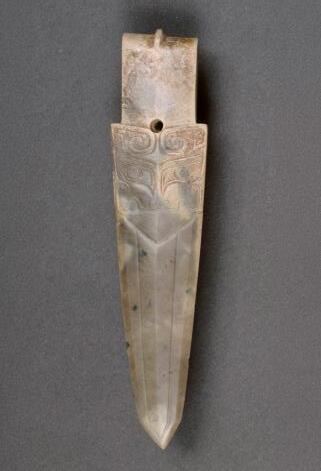


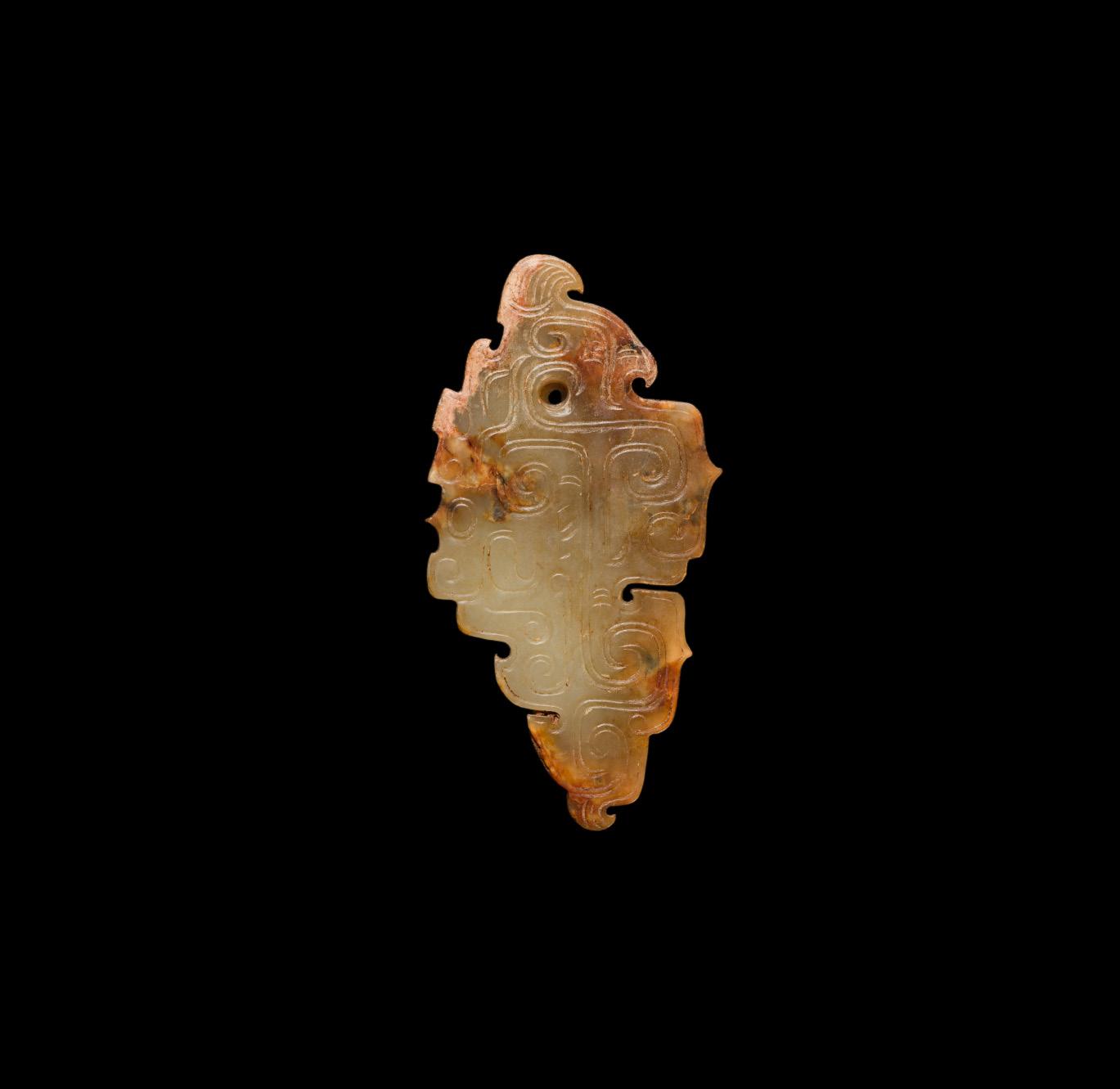
A PALE YELLOW AND RUSSET JADE ‘BIRD‘ PENDANT, LATE SHANG DYNASTY,
China, c. 1200 BC. The flattened plaque finely carved in the form of a crested bird shown in profile with a hooked beak and short tail, neatly incised to both sides with double-line grooves evoking the scrolling wings and plumage, the translucent stone of a white tone with pale yellow nuances, russet veins and inclusions, dark specks, and few small areas of creamy-beige calcification.
Provenance: The Collection of Sam and Myrna Myers, Paris, France. Acquired between circa 1965-2012.
Condition: Good condition with wear, traces of weathering and signs of prolonged burial, soil encrustations, few minor old losses to edges which have partially smoothened over time, the stone with natural fissures, some of which have developed into small hairline cracks.
Weight: 30 g
Dimensions: Height 8.2 cm
Literature comparison: Compare a related, slightly later jade bird pendant incised with double-line grooves, 11.2 cm long, dated to the Western Zhou dynasty, in the Cleveland Museum of Art, accession number 1972.38. Compare a related later jade bird pendant, 4.1 cm, dated to the Warring States period, of similar albeit curvier form and lacking the doubleline grooves found on the present lot, in the Cleveland Museum of Art, accession number 1952.581.
Expert’s note: The flat form of the present bird links it to the early birds linked with the Shijiahe Culture, Yangtze River region in Hubei Province, which show a similar treatment of incised designs and scales. See a fragment of a jade ornament in the form of a bird, dated to the Shijiahe culture, ca. 2500-2000 BC, 5.3 cm high, in the National Museum of Asian Art, Smithsonian Institution, accession number S1987.589.
AUCTION RESULT COMPARISON
Type: Closely related
Auction: Christie’s New York, 18 March 2009, lot 263
Price: USD 56,250 or approx. EUR 72,500 converted and adjusted for inflation at the time of writing
Description: A rare pale greenish-white jade bird-form finial/insignia, Shang dynasty, Anyang phase, circa 1200 BC
Expert remark: Compare the closely related subject, stone, manner of carving with similar double-line grooves and subtle openwork, and size (7.7 cm). Note the slightly arched form.
Estimate EUR 4,000
Starting price EUR 2,000


A CELADON JADE ‘KUI DRAGON’ PENDANT, WESTERN ZHOU DYNASTY
China, 1046-771 BC. Well carved as a crouching horned dragon shown in profile, its muscular body and legs finely incised, the head with large round eyes and a long snout, the mouth slightly agape before a small aperture pierced for suspension. The translucent stone of a celadon tone with cloudy inclusions and creamy off-white calcification mostly to one side.
Provenance: The Collection of Sam and Myrna Myers, Paris, France. Acquired between circa 1965-2012.
Condition: Overall good condition minor wear, traces of weathering and signs of burial, minuscule nibbling, the tail with an old smoothened loss.
Weight: 3 g
Dimensions: Length 4.7 cm
Literature comparison: Compare a related jade carving of a kui-dragon, excavated from a Guo State tomb, illustrated in Sanmenxia Guoguomu, vol. 1, Beijing, 1999, no. 66.
AUCTION RESULT COMPARISON
Type: Closely related
Auction: Christie’s Hong Kong, 30 November 2020, lot 2759
Price: HKD 60,000 or approx. EUR 7,000 converted and adjusted for inflation at the time of writing
Description: A celadon jade ‘kuidragon’ pendant, Western Zhou dynasty, c.1100-771 BC

Expert remark: Compare the closely related subject, manner of carving, incision work, and stone. Note the related size (5.8 cm).
AUCTION RESULT COMPARISON
Type: Closely related
Auction: Bonhams, London, 18 May 2023, lot 24
Price: GBP 15,300 or approx. EUR 19,000 converted and adjusted for inflation at the time of writing
Description: An archaic jade ‘kui dragon’ pendant, Western Zhou
Dynasty

Expert remark: Compare the closely related subject, manner of carving, stone, and size (4.7 cm). Note the slightly more detailed incision work.
Estimate EUR 1,500
Starting price EUR 800
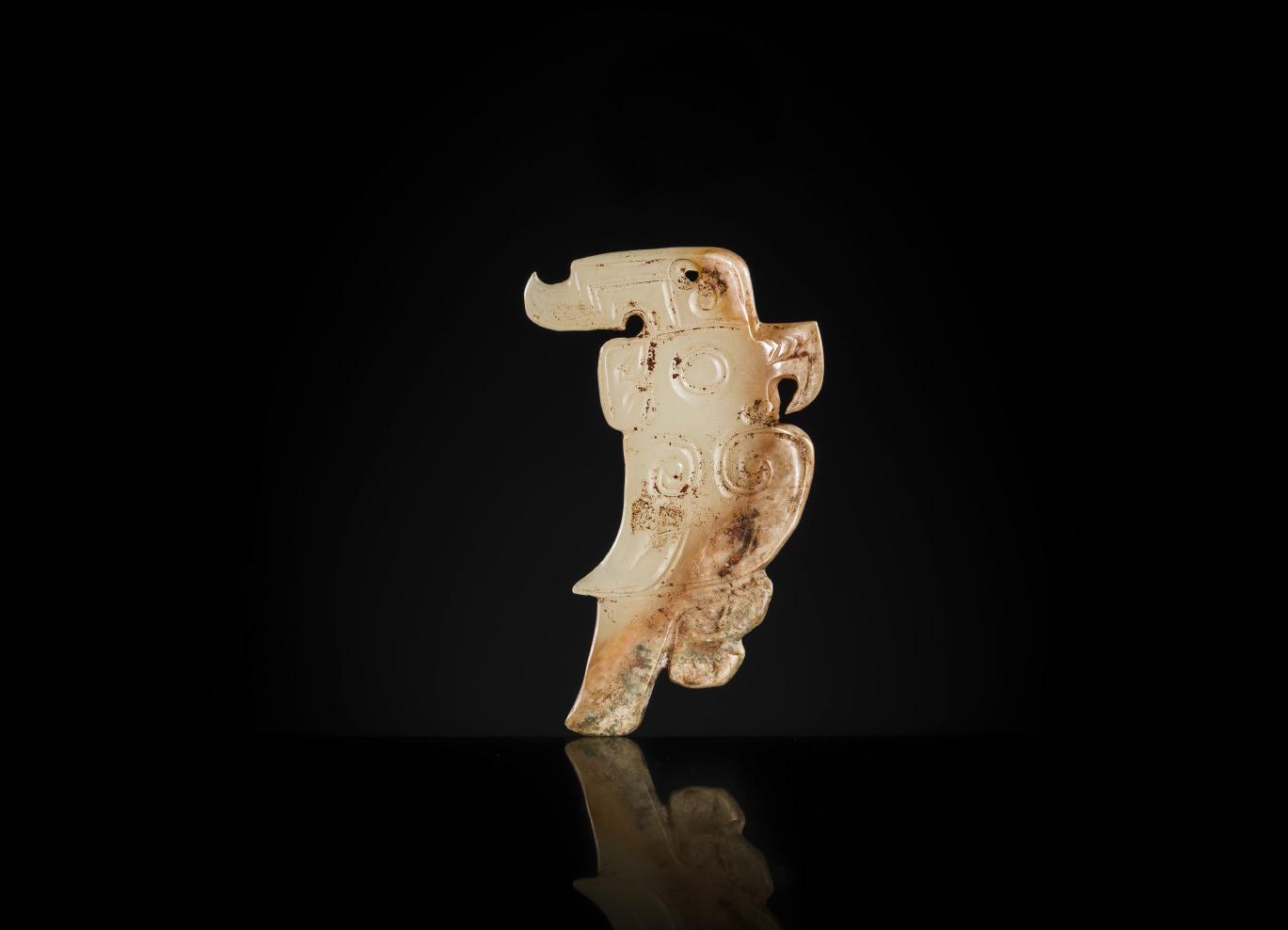
Exhibited:
1. Pointe-à-Callière Museum, From the Lands of Asia. The Sam and Myrna Myers Collection, Montréal, 17th November 2016-19th March 2017.
2. Kimbell Art Museum, From the Lands of Asia. The Sam and Myrna Myers Collection, Fort Worth, Texas, 4th March-19th August 2018.
China. Finely carved as a crested bird shown in profile, richly incised on both sides with double-line grooves delineating features including the circular eyes and folded wings, the animal further detailed with a hooked beak and long curved tail. Pierced at the top with a small aperture for suspension. The translucent stone of a pale greenishwhite tone with pale russet shadings and patches of opaque creamywhite calcification.
Provenance: The Collection of Sam and Myrna Myers, Paris, France. Acquired between circa 1965-2012.
Condition: Very good condition with expected wear, signs of prolonged burial, traces of weathering, encrustations, remnants of ancient cinnabar pigment, areas of calcification, few tiny nicks, two minute chips.
Weight: 18 g
Dimensions: Height 6.5 cm
Ornaments of this form are typical of the period of Fu Hao and several have been excavated from her tomb, illustrated for example in Yinxu Yuqi (The Jades from Yinxu), Beijing, 1982, pls. 44, 47, 50, and 58.
The Tomb of Fu Hao is an important archaeological site located at Yinxu, the ruins of the ancient Shang dynasty capital Yin, within modern-day Anyang in Henan Province, China. The tomb was identified as the final resting place of Queen and military general Fu Hao, who died around 1200 BC. Fu Hao is believed to be the Lady Hao mentioned in oracle bone inscriptions by King Wu Ding and one of his many wives. Notably, the Tomb of Fu Hao is the only Shang royal tomb discovered intact, with its contents undisturbed, likely due to its remote location, far from other known burial sites. This pristine condition has provided invaluable insights into Shang dynasty culture and the significance of jade in their ritual practices.
PUBLISHED
1. Myrna Myers (ed.) & Filippo Salviati (auth.), The Language of Adornment. Chinese Ornaments of Jade, Crystal, Amber and Glass, Paris, 2002, no. 10.
2. Jean-Paul Desroches (ed.) et al, Two Americans in Paris. A Quest for Asian Art, Paris, 2016, p. 52, no. 102.



LITERATURE COMPARISON
Compare a closely related jade birdform pendant or terminal fitting, 7 cm high, dated 15th-10th century BC, in the British Museum, registration number 2022,3034.109 (fig. 1). Compare a closely related jade bird-form pendant unearthed from the tomb of Fu Hao and exhibited in the Beijing Capital Museum.
AUCTION RESULT COMPARISON
Type: Closely related
Auction: Christie’s Hong Kong, 30 November 2020, lot 2718
Price: HKD 1,250,000 or approx. EUR 147,000 converted and adjusted for inflation at the time of writing
Description: A dark green jade parrot-form pendant, Shang dynasty, c. 1600-1046 BC Expert remark: Compare the closely related form, manner of carving, and size (6.8 cm).
Estimate EUR 6,000
Starting price EUR 3,000

1
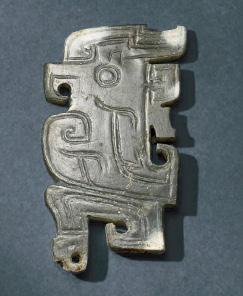
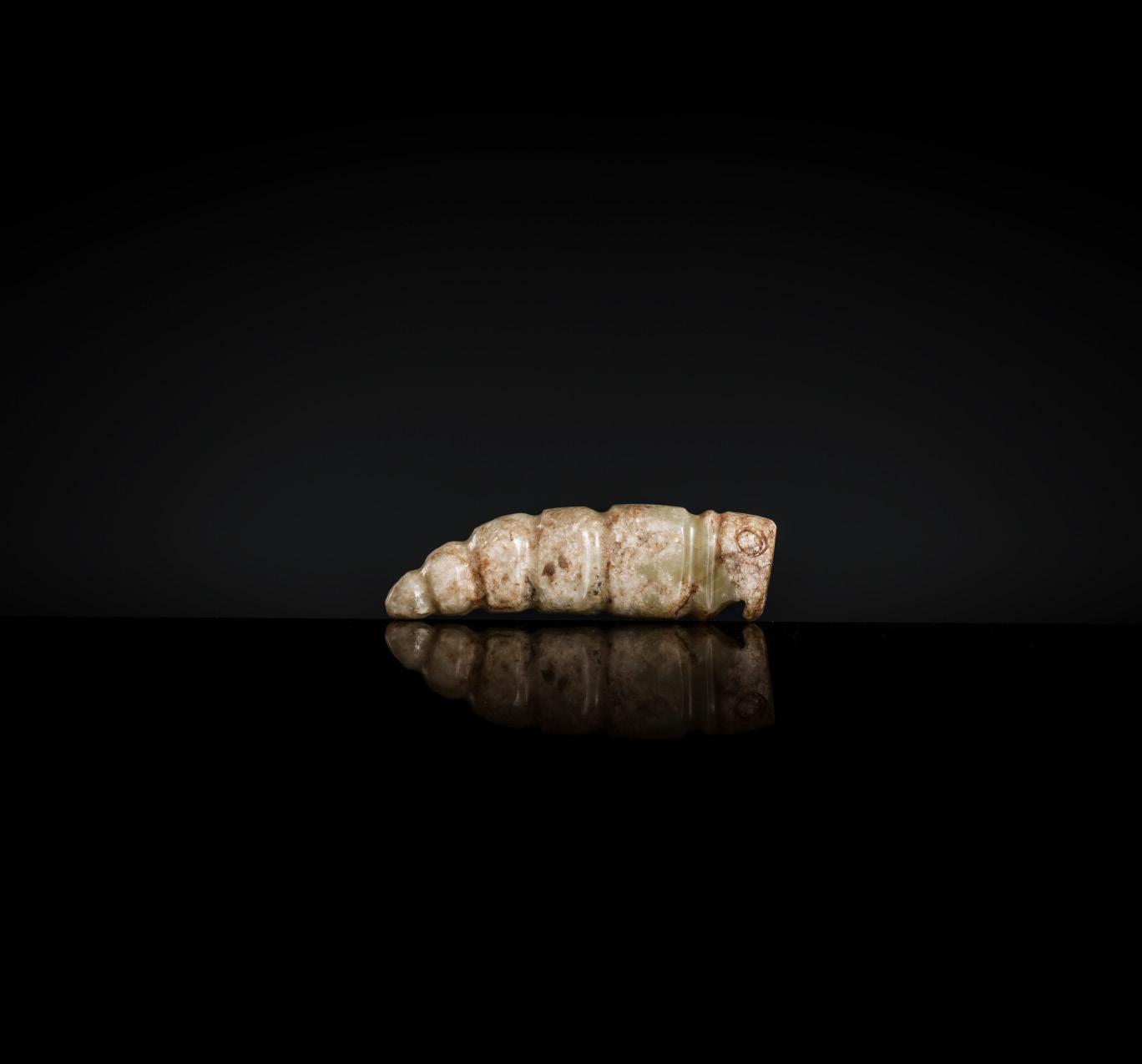
A CELADON JADE ‘SILKWORM’ PENDANT, LATE SHANG DYNASTY
Exhibited:
1. Pointe-à-Callière Museum, From the Lands of Asia. The Sam and Myrna Myers Collection, Montréal, 17th November 2016-19th March 2017.
2. Kimbell Art Museum, From the Lands of Asia. The Sam and Myrna Myers Collection, Fort Worth, Texas, 4th March-19th August 2018.
China, 13th-11th century BC. Well carved, the slightly flattened body with neatly delineated segments, the head incised with a pair of round eyes and pierced for suspension. The stone is of a pale celadon color with creamy-white patches and russet-brown veins and inclusions.
Provenance: The Collection of Sam and Myrna Myers, Paris, France. Acquired between circa 1965-2012.
Condition: Excellent condition with expected wear, signs of prolonged burial, traces of weathering, minuscule nibbling, the stone with few natural fissures, some of which may have developed into thin hairline cracks.
Weight: 11.9 g
Dimensions: Length 5 cm
Literature comparison: Compare a closely related jade silkworm, dated to the late Shang dynasty to Western Zhou dynasty, 2.8 cm long, in the National Palace Museum, Taipei, accession number 購玉 000237N000000000. Compare a closely related jade silkworm, dated 11th century-10th century BC, 4.1 cm long, in the Victoria and Albert Museum, accession number FE.106-1974. Compare a closely related jade pendant of a silkworm, dated to the Western Zhou dynasty, 2.8 cm long, in the National Museum of Asian Art, Smithsonian Institution, accession number S2012.9.1440.




PUBLISHED
Jean-Paul Desroches (ed.) et al, Two Americans in Paris. A Quest for Asian Art, Paris, 2016, p. 55, no. 110.
AUCTION RESULT COMPARISON
Type: Closely related
Auction: Christie’s Hong Kong, 29 November 2024, lot 1036
Price: HKD 189,000 or approx. EUR 21,000 (for two) converted and adjusted for inflation at the time of writing
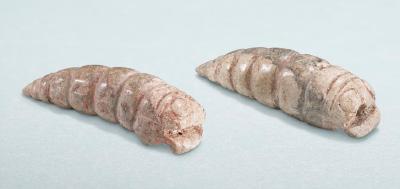
Description: Two jade carvings of hawk moth pupae, Western Zhou dynasty, circa 1050-771 BC
Expert remark: Compare the closely related form, manner of carving, and size (4.5 cm).
Estimate EUR 2,000
Starting price EUR 1,000
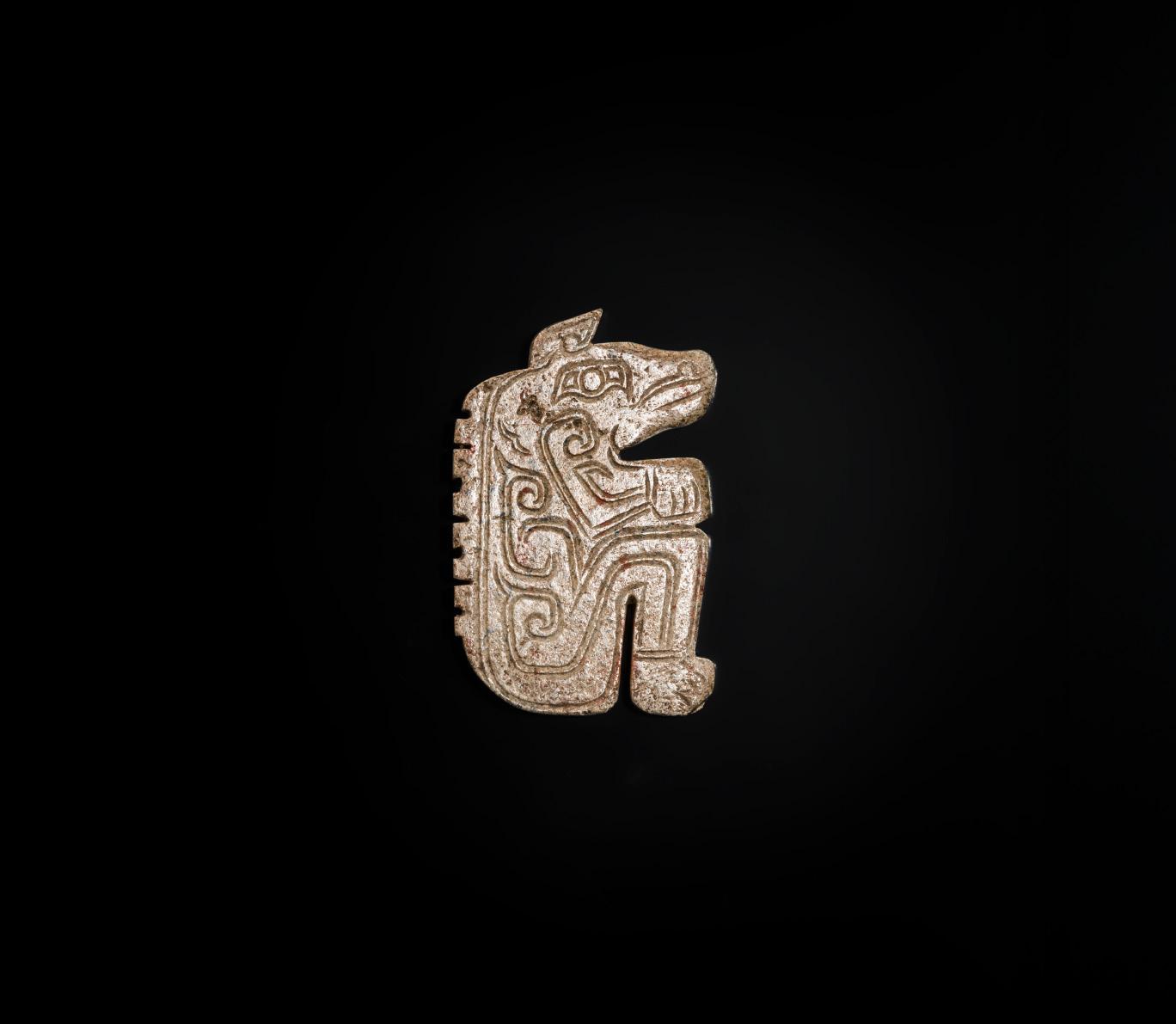


PUBLISHED

1. Filippo Salviati, The Language of Adornment. Chinese Ornaments of Jade, Crystal, Amber and Glass, Myrna
2. Jean-Paul Desroches (ed.) et al, Two Americans in Paris. A Quest for Asian Art, Paris, 2016, p. 55, no. 108.
China. Finely carved in the form of a crouching bear shown in profile, the body neatly detailed with double-line grooves that emphasize features such as the eye and ear. The mostly opaque stone now of an ivory-white color with hints of deep green and russet inclusions, a tiny section remaining subtly translucent.
Provenance: The Collection of Sam and Myrna Myers, Paris, France. Acquired between circa 1965-2012.
Condition: Good condition with expected wear, signs of prolonged burial and traces of weathering with associated tiny losses, some erosion, extensive calcification, minuscule nibbling, minute nicks, and an old smoothened chip.
Weight: 20 g
Dimensions: Height 5.4 cm
Small animal-shaped carvings form one of the main categories of the Shang and early Western Zhou dynasty jades. A higher level of carving and artistic skills were developed during the late Shang period such as relief carving and double-line incision, as demonstrated by the present lot.
Plaques of this type are among the Shang dynasty jade artifacts discovered in the Tomb of Fu Hao, located at Yinxu, the ruins of the ancient Shang capital, now within modern Anyang in Henan Province, China. Discovered in 1976 by archaeologist Zheng Zhenxiang, the tomb was identified as the final resting place of Queen and military general Fu Hao, who died around 1200 BC. Likely the Lady Hao mentioned in oracle bone inscriptions by King Wu Ding, Fu Hao was one of his many wives. The tomb’s excavation revealed 755 jade objects, including not only contemporary Shang pieces but also jades from the Longshan, Liangzhu, Hongshan, and Shijiahe cultures. Remarkably, it is the only Shang royal tomb found intact, with its contents undisturbed, likely due to its remote location, far from other known burial sites.
LITERATURE COMPARISON
Compare a closely related jade bear unearthed from the tomb of Fu Hao and now in the National Museum of China.

Estimate EUR 4,000
Starting price EUR 2,000

PUBLISHED
Jean-Paul Desroches (ed.) et al, Two Americans in Paris. A Quest for Asian Art, Paris, 2016, p. 54, no. 104.



Exhibited:
1. Pointe-à-Callière Museum, From the Lands of Asia. The Sam and Myrna Myers Collection, Montréal, 17th November 2016-19th March 2017.
2. Kimbell Art Museum, From the Lands of Asia. The Sam and Myrna Myers Collection, Fort Worth, Texas, 4th March-19th August 2018.
China, 13th-11th century BC. Finely carved in the form of a praying mantis shown in profile, the body richly incised in double-line grooves with scrolling wings above the large round eyes. The semi-translucent stone of a yellowish celadon tone with dark gray patches as well as brown and russet inclusions.
Provenance: The Collection of Sam and Myrna Myers, Paris, France. Acquired between circa 1965-2012.
Condition: Very good condition with wear, signs of prolonged burial, traces of weathering, encrustations, an old smoothened chip, remnants of ancient pigment, the stone with natural fissures, some of which may have developed into small hairline cracks over time.
Weight: 106 g
Dimensions: Height 12.2 cm
Expert’s note: Among excavated jades, mantis are not seen before the late Shang period. One of the earliest known examples, also carved with doubleline grooves, published for example in Zhongguo yuqi quanji (Collection of Chinese Jade), Hebei meishu chubanshe 1993 vol. II: pl. 99, was excavated from the tomb of Fu Hao, located at Yinxu, the ruins of the ancient Shang capital, now within modern Anyang in Henan Province, China. Discovered in 1976 by archaeologist Zheng Zhenxiang, the tomb was identified as the final resting place of Queen and military general Fu Hao, who died around 1200 BC. Likely the Lady Hao mentioned in oracle bone inscriptions by King Wu Ding, Fu Hao was one of his many wives. The tomb’s excavation revealed 755 jade objects, including not only contemporary Shang pieces but also jades from the Longshan, Liangzhu, Hongshan, and Shijiahe cultures. Remarkably, it is the only Shang royal tomb found intact, with its contents undisturbed, likely due to its remote location, far from other known burial sites.
LITERATURE COMPARISON
Compare a related jade mantis, dated 1300-1050 BC, in the National Museum of Asian Art, Smithsonian Institution, accession number S2012.9.315. Compare a related jade mandis, dated approx. 1300-1100 BC, in the Asian Art Museum of San Francisco, object number B60J769 (fig. 1). Compare a related jade mantis, dated Shang or Zhou dynasty, in the Harvard Art Museums, object number 1943.50.184, and illustrated by Max Loehr and Louisa G. Fitzgerald Huber, Ancient Chinese Jades From the Grenville L Winthrop Collection in the Fogg Art Museum, 1975, no. 166.
AUCTION RESULT COMPARISON
Type: Related
Auction: Bonhams New York, 20 September 2021, lot 137
Price: USD 15,300 or approx. EUR 15,200 converted and adjusted for inflation at the time of writing
Description: An olive-green and calcified jade praying mantis pendant, Shang dynasty or later
Expert remark: Compare the closely related subject and manner of carving with similar double-line grooves. Note the size (7 cm).
Estimate EUR 8,000
Starting price EUR 4,000



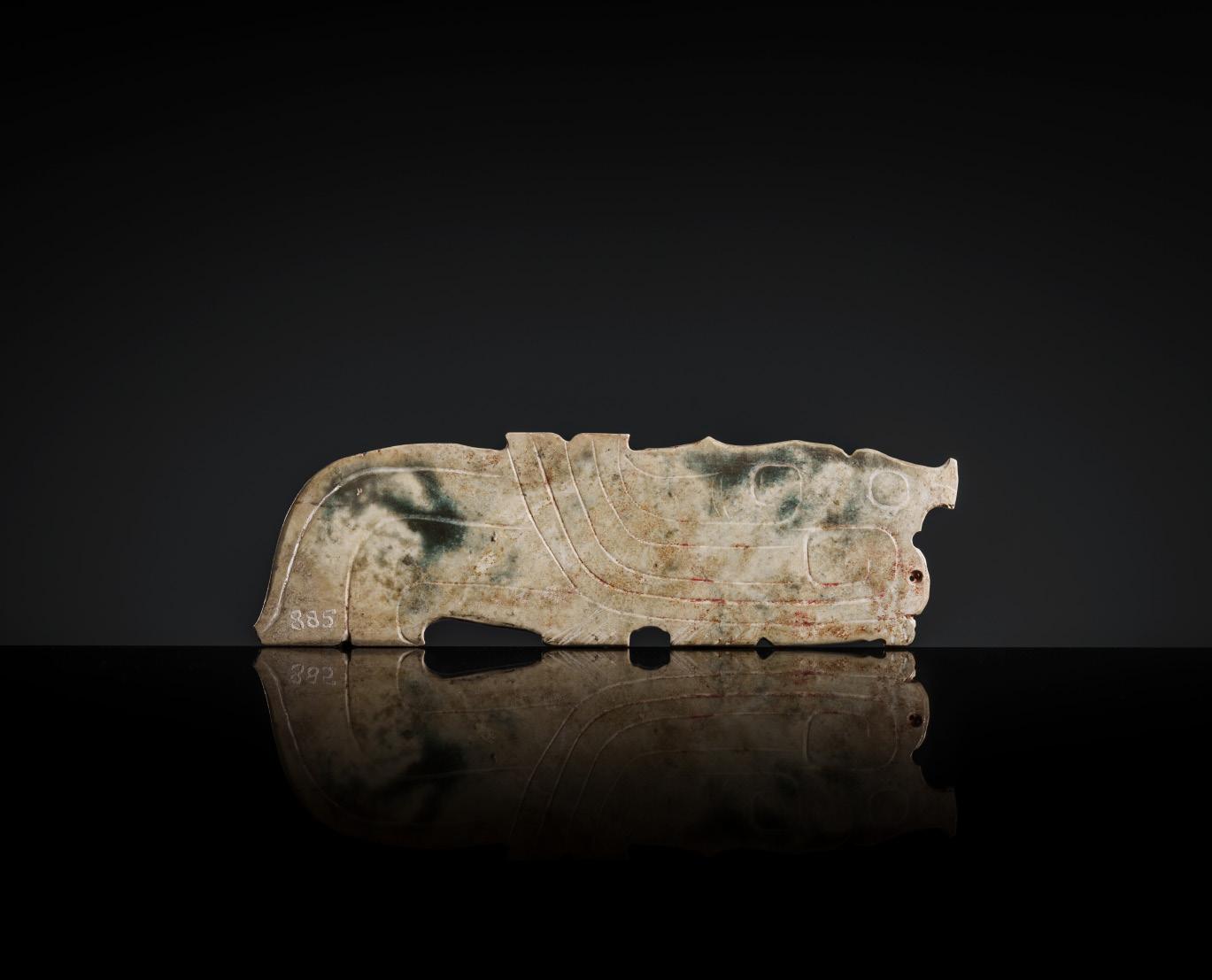
75 A CELADON JADE ‘BIRD’ PENDANT, WESTERN ZHOU DYNASTY, 11TH-10TH CENTURY BC
China. Finely carved in the form of a bird shown in profile with a sharp beak and a curved fish-like tail, the wings neatly detailed with skillful incision work, the chest pierced with a minute aperture for suspension. The semi-translucent stone with large areas of calcification, now of an ivory-white color as with nuances of deep sagegreen.
Provenance: Collection Armand Trampitsch, Paris, France. Ader Picard Tajan auction in Tokyo, Hôtel Okura, 30 May 1985, Lot 40. The Collection of Sam and Myrna Myers, Paris, France, acquired from the above. Armand Trampitsch (1890-1970) was the son of Carinthian Slovene brewer and industrialist Anton Trampitsch (1860-1940), co-founder of France’s second-largest brewery, Brasserie Champigneulles in Nancy. He joined his father’s company in 1911 but later sold his share and moved to Paris, where he built a noted collection of archeological finds and works of art.
Condition: Very good condition with wear, signs of prolonged burial, traces of weathering, minuscule nibbling, a small old chip, the stone with natural inclusions.
Weight: 10 g
Dimensions: Length 9 cm
LITERATURE COMPARISON
Compare a closely related jade plaque, described as a fish, 7.3 cm long, dated to the Western Zhou dynasty, in the Metropolitan Museum of Art, accession number 24.51.7 (fig. 1). Compare a closely related jade bird-form pendant, 6.5 cm long, dated late Shang to Western Zhou dynasty, 1500-1050 BC, in the British Museum, registration number 1947,0712.465.

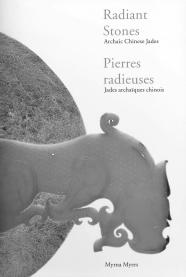
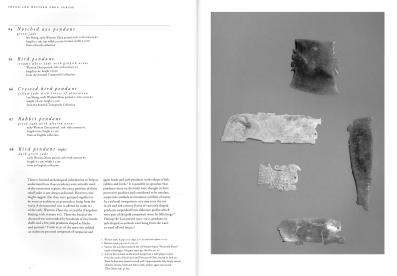

PUBLISHED
Myrna Myers (ed.) & Filippo Salviati (auth.), Radiant Stones. Archaic Chinese Jades, Paris, 2000, no. 65.
AUCTION RESULT COMPARISON
Type: Closely related
Auction: Christie’s, 28 November 2018, lot 2740
Price: HKD 112,500 or approx. EUR 14,000 converted and adjusted for inflation at the time of writing

Description: A celadon jade ‘bird’ pendant, mid-Western Zhou dynasty, circa mid-10th-mid-9th century BC
Expert remark: Compare the closely related form and manner of carving with similar beak, eyes, and bifurcated fish tail. Note the size (5.7 cm) and that the incised lines are slightly more dense and rounded than on the present lot.
Estimate EUR 3,000
Starting price EUR 1,500

Provenance: The Collection of Sam and Myrna Myers, Paris, France. Acquired between circa 1965-2012.
Condition: Very good condition with expected wear, minor signs of burial, minuscule nibbling to edges, one microscopic chip.



PUBLISHED
China, c. 9th century BC. Of flattened rectangular form, finely carved and pierced to depict a pair of dragons with intertwined bodies terminating in further beast heads, neatly incised to one side with oval eyes and subtle scroll designs, two corners pierced for suspension, the translucent stone of a white tone with russet and cloudy inclusions as well as areas of opaque calcification.
Weight: 14 g Dimensions: Length 5.3 cm
The Western Zhou merged different motifs, clearly demonstrated in the ‘dragon’ pendant of this lot. While the compositions present novel combinations, the individual elements stem from a long-standing visual tradition. The coiled dragon, for instance, traces its lineage back to Shang prototypes, which in turn were influenced by similar forms seen in the earlier Hongshan culture.
AUCTION RESULT COMPARISON
Type: Closely related
Auction: Bonhams London, 18 May 2023, lot 25
Price: GBP 22,950 or approx. EUR 28,500 converted and adjusted for inflation at the time of writing
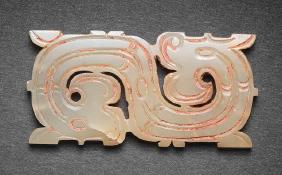
Description: An archaic pale green jade ‘dragon’ plaque, Spring and Autumn Period
Expert remark: Compare the closely related subject, manner of carving, stone, and size (5.7 cm). Note the slightly later dating.
Estimate EUR 2,000
Starting price EUR 1,000
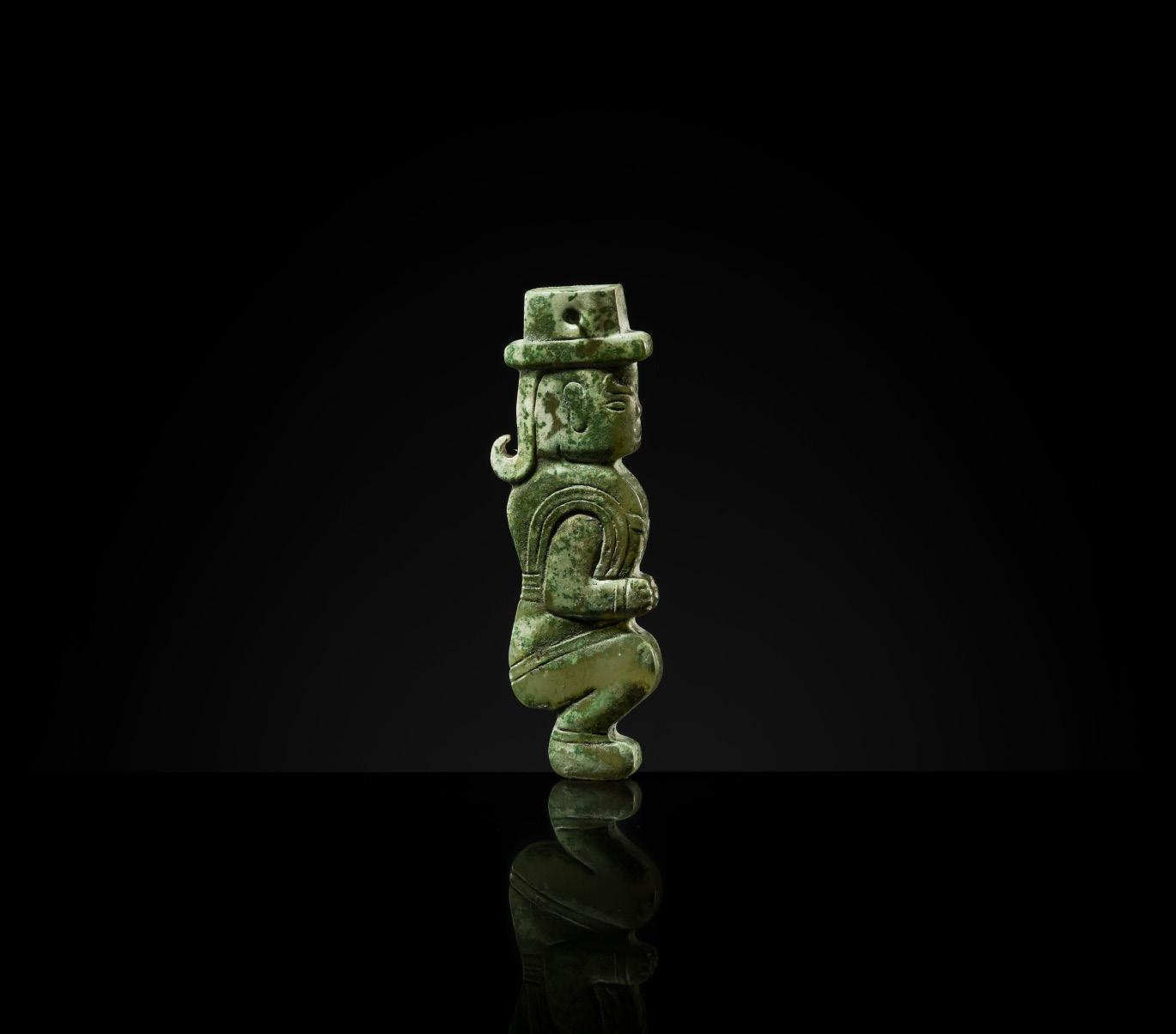
77 AN EXCEPTIONAL GREEN JADE MAN-SHAPED SILHOUETTE PENDANT, MID-LATE WESTERN ZHOU PERIOD
Exhibited:
1. Pointe-à-Callière Museum, From the Lands of Asia. The Sam and Myrna Myers Collection, Montréal, 17th November 2016-19th March 2017.
2. Kimbell Art Museum, From the Lands of Asia. The Sam and Myrna Myers Collection, Fort Worth, Texas, 4th March-19th August 2018.
Expert’s note: This jade figure shows a distinctive surface color alteration, most likely caused by the corrosion of bronzeware that lay in close proximity to it. Green malachite is a primary source of the greenish alteration often observed on excavated ancient jade artifacts. It is also possible that this pendant was once hidden inside a bronze vessel and subsequently buried together with it.
China, 10th-9th century BC. Finely carved in the form of a man in a crouching pose with bent legs, dressed in ornate robes, the long hair terminating in an upswept curl, the square face surmounted by a brimmed hat pierced with an aperture for suspension. The semitranslucent stone of an olive-green tone with areas of calcification and mottled patches of malachite.
Provenance: The Collection of Sam and Myrna Myers, Paris, France. Acquired between circa 1965-2012.
Condition: Very good condition with expected wear, signs of prolonged burial, traces of weathering, erosion, encrustations, minimal nibbling.
Weight: 18.8 g
Dimensions: Height 6.5 cm




PUBLISHED
Jean-Paul Desroches (ed.) et al, Two Americans in Paris. A Quest for Asian Art, Paris, 2016, p. 56, no. 113.
LITERATURE COMPARISON
Compare a related celadon jade silhouette of an anthropomorphic figure, dated Western or Eastern Zhou dynasty, 8th century BC, 4.1 cm high, in the National Museum of Asian Art, Smithsonian Institution, accession number S2012.9.1544 (fig. 1). Compare a related white jade flattened pendant depicting a standing woman, dated to the Warring States period, 5.2 cm high, in the British Museum, registration number 2022,3034.273. fig. 1
Estimate EUR 6,000
Starting price EUR 3,000


78
A BROWN AND IVORY-WHITE JADE ‘HUMANOID-DRAGON’ PENDANT, MID-LATE WESTERN ZHOU DYNASTY
Exhibited:
1. Pointe-à-Callière Museum, From the Lands of Asia. The Sam and Myrna Myers Collection, Montréal, 17th November 2016-19th March 2017.
2. Kimbell Art Museum, From the Lands of Asia. The Sam and Myrna Myers Collection, Fort Worth, Texas, 4th March-19th August 2018.
China, 10th-9th century BC. Finely carved and pierced to depict a crouching figure with a human and two dragon heads shown in profile, the legs drawn up beneath the coiled dragon which forms the arms and trunk of the body, all richly incised with double-line grooves echoing the outlines of the pendant. The opaque stone of pale brown and celadon tone with large areas of ivory-white calcification.
Provenance: The Collection of Sam and Myrna Myers, Paris, France. Acquired between circa 1965-2012.
Condition: Very good condition with expected wear, signs of prolonged burial and weathering, minuscule nibbling, few tiny nicks, the stone with natural fissures, some of which may have developed into small hairline cracks.
Weight: 19 g
Dimensions: Height 6.6 cm
AUCTION RESULT COMPARISON
Type: Closely related
Auction: Christie’s Hong Kong, 28 November 2018, lot 2743
Price: HKD 187,500 or approx. EUR 23,000 converted and adjusted for inflation at the time of writing
Description: A celadon jade dragon-form pendant, Western Zhou dynasty
Expert remark: Compare the closely related form, manner of carving, and motifs. Note the size (8.7 cm).





PUBLISHED
Jean-Paul Desroches (ed.) et al, Two Americans in Paris. A Quest for Asian Art, Paris, 2016, p. 57, no. 115.
AUCTION RESULT COMPARISON
Type: Closely related
Auction: Christie’s Hong Kong, 30 November 2020, lot 2749
Price: HKD 225,000 or approx. EUR 26,500 converted and adjusted for inflation at the time of writing
Description: A jade dragon-human form pendant, Western Zhou dynasty
Expert remark: Compare the closely related form, manner of carving, and motifs. Note the size (5.5 cm).
Estimate EUR 4,000
Starting price EUR 2,000


Exhibited:
1. Pointe-à-Callière Museum, From the Lands of Asia. The Sam and Myrna Myers Collection, Montréal, 17th November 2016-19th March 2017.
2. Kimbell Art Museum, From the Lands of Asia. The Sam and Myrna Myers Collection, Fort Worth, Texas, 4th March-19th August 2018.
China, 10th-9th century BC. Of flattened form, skillfully rendered in openwork as three stylized horned dragons surmounted by two humanoid heads, the coiling bodies of the beasts exquisitely picked out with scrollwork echoing the outlines of the pendant, and with apertures for suspension. The stone is of a pale celadon color with creamy-white inclusions.
Provenance: The Collection of Sam and Myrna Myers, Paris, France. Acquired between circa 1965-2012.
Condition: Very good condition with expected wear, signs of prolonged burial, traces of weathering, areas of calcification, encrustations, remnants of ancient cinnabar, and few minuscule nibbles. The stone with natural fissures, some of which have developed into thin hairline cracks.
Weight: 26.7 g
Dimensions: Height 8.5 cm
The late Shang dynasty period saw a revolutionary change in aesthetic style in ritual bronzes and jades. Among the novelties were jade plaques decorated with humanoid motifs, such as a pendant in the form of a crowned human with bent limbs unearthed from the tomb of Fu Hao (c. 1200 BC), included in the exhibition Queen, Mother, General: 40th Anniversary of Excavating the Shang Tomb of Fu Hao, Beijing, 2016, p. 7 (1976AXTM5:470). The present pendant, reminiscent of the Shang prototypes, ingeniously incorporates two human heads and two dragons on the upper section, atop curled-up human legs terminating in claws and a further dragon with a coiled tail. In the Western Zhou dynasty, this type of plaque probably formed parts of ritual necklace sets; see an elaborate




PUBLISHED
Jean-Paul Desroches (ed.) et al, Two Americans in Paris. A Quest for Asian Art, Paris, 2016, p. 57, no. 114.
set with a related plaque excavated from Qiangjiacun, Fufeng, Shaanxi, exhibited in The Cultural Grandeur of the Western Zhou Dynasty, National Palace Museum, Taipei, 2014, cat. no. 119. Although a variety of humandragon plaques can be found in public collections across China, few are in private hands and comparatively larger examples such as the present piece are even rarer.
AUCTION RESULT COMPARISON
Type: Near identical
Auction: Sotheby’s Hong Kong, 22 April 2021, lot 1
Price: HKD 201,600 or approx. EUR 24,000 converted and adjusted for inflation at the time of writing
Description: A rare jade ‘human-dragon’ pendant, Western Zhou dynasty Expert remark: Compare the form, manner of carving, incised details, and stone. Note the similar size (9.5 cm).
Estimate EUR 8,000
Starting price EUR 4,000
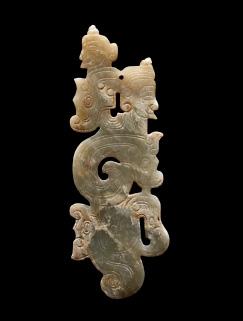
China, late 2nd-1st millennium BC. Finely carved with the sides flaring towards the gently curved beveled cutting edge, decorated only with three fine lines neatly incised on each side above a drilled circular aperture. The translucent stone of a pale greenish-white tone with white streaks, nuances of pale yellow, icy veins, and dark specks.
Provenance: The Collection of Sam and Myrna Myers, Paris, France. Acquired between circa 1965-2012.
Condition: Good condition with expected wear, signs of prolonged burial and traces of weathering with associated small losses to edges and little encrustation, minuscule nibbling, the stone with natural fissures, some of which have developed into small hairline cracks.
Weight: 135 g
Dimensions: Height 16.4 cm
AUCTION RESULT COMPARISON
Type: Related
Auction: Christie’s New York, 19 March 2015, lot 550
Price: USD 23,750 or approx. EUR 27,500 converted and adjusted for inflation at the time of writing
Description: An opaque creamy caramel-toned jade blade, China, late Shang-Western Zhou dynasty, late 2nd-1st millennium BC Expert remark: Compare the related form and manner of carving. Note the size (12.2 cm) and loss to the butt end.
AUCTION RESULT COMPARISON
Type: Related
Auction: Bonhams, Hong Kong, 5 April 2016, lot 9
Estimate: HKD 2,680,000 or approx. EUR 344,000 converted and adjusted for inflation at the time of writing
Description: A white jade ceremonial blade, gui, Shang Dynasty or later Expert remark: Compare the related form and manner of carving. Note the size (21.1 cm).
Estimate EUR 4,000
Starting price EUR 2,000

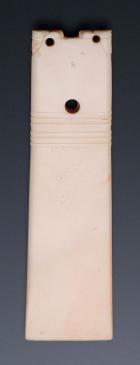

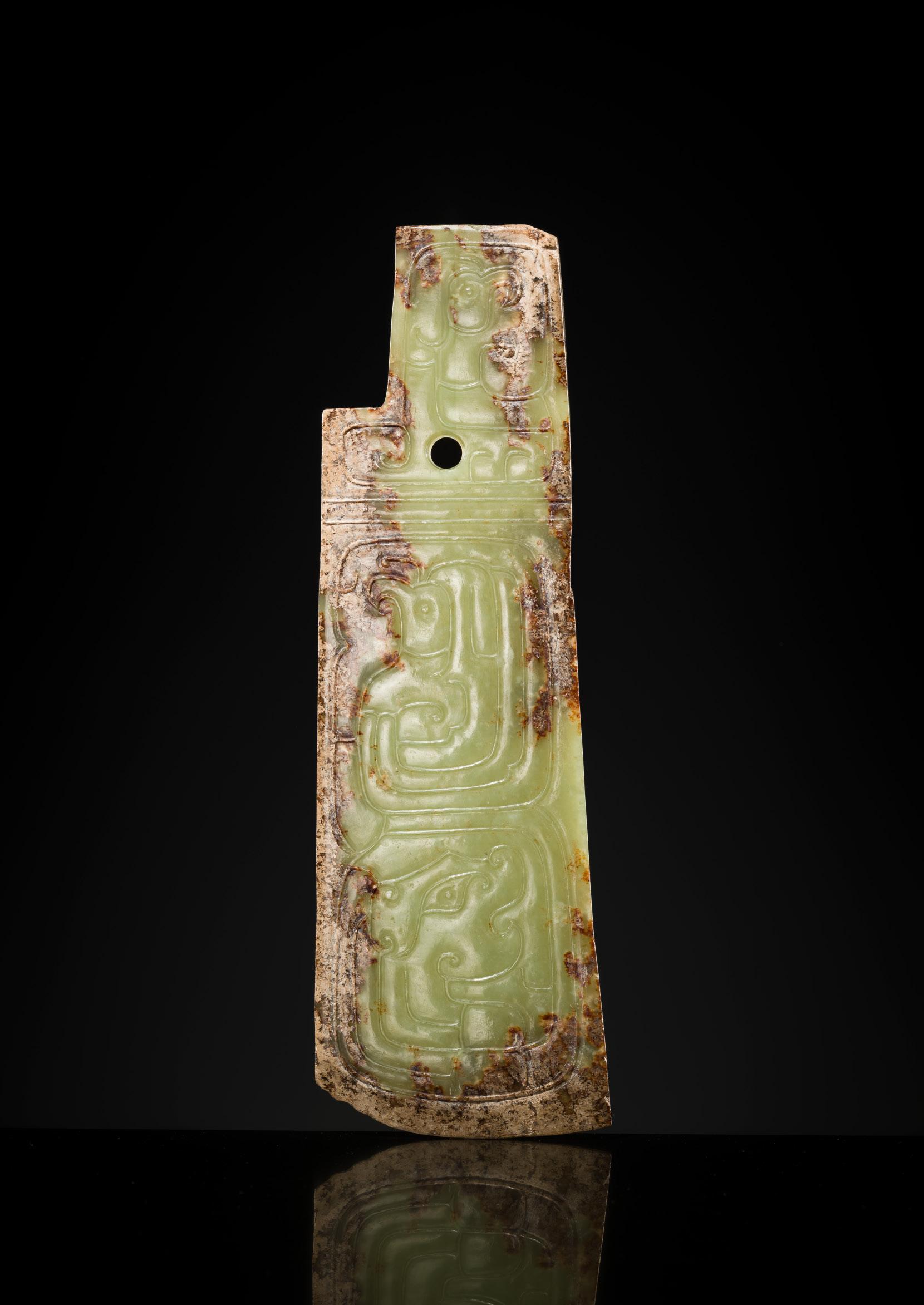
Exhibited:
1. Fondation Baur, The Beginning of the World – According to the Chinese. Dragons, Phoenix and Other Chimera, Geneva, 11 November 2020-23 May 2021.
2. Musée Départemental des Arts Asiatiques, The Beginning of the World – According to the Chinese. Dragons, Phoenix and Other Chimera, Nice, Summer 2021.
Expert’s note: Blades with carved decoration, such as the thread relief seen on the present lot, are exceptionally rare. The vast majority of comparable implements from the Neolithic through the Bronze Age feature plain surfaces, sometimes with one or more drilled holes, and only infrequently show incision work that is usually minimal in extent.
The form of this blade is reminiscent of a group of Shang and early Zhou jade handles—also described as finials, insignias, or pendants— but its size and fully carved surfaces indicate a ceremonial function, possibly as a scepter.
The presence of both bird and dragon motifs suggest a date toward the later phases of the Western Zhou period, rather than its earliest stages. Bird motifs seem to have entered the Western Zhou jade repertoire with designs of human or human-like heads, which were to disappear shortly afterwards and only the bird and dragon motifs remained.
China, 10th-9th century BC. Finely carved, the rectangular blade with one straight and one slightly flaring edge elegantly rising to the thin beveled cutting edge, opposite from the notched handle below a drilled circular aperture. The surface is intricately decorated in thread relief depicting two birds below a dragon. The semi-translucent stone is of a deep olive-green tone with cloudy inclusions, russet patches, and ivory-white calcification.
Provenance: The Collection of Sam and Myrna Myers, Paris, France. Acquired between circa 1965-2012.
Condition: Good condition with expected wear, signs of prolonged burial and traces of weathering with few small associated losses to edges, areas of calcification, the stone with natural fissures, some of which may have developed into small hairline cracks.
Weight: 196 g
Dimensions: Length 20.9 cm
LITERATURE COMPARISON
Compare a related pale green handle-shaped blade decorated with a bird, dragon, and anthropomorphic figure, dated 10th–9th century BC, in the Metropolitan Museum of Art, object number 1985.214.96. Compare a related ivory-white jade handle or scepter decorated with birds and dragons, dated 10th–9th century BC, in the British Museum, registration number 1947,0712.496.

AUCTION RESULT COMPARISON
Type: Related
Auction: Christie’s New York, 19 March 2015, lot 568
Price: USD 27,500 or approx. EUR 32,000 converted and adjusted for inflation at the time of writing
Description: A rare ivory-colored opaque jade ‘handle’-shaped finial or insignia, China, Early Western Zhou dynasty, circa 10th century BC
Expert remark: Compare the related manner of carving and bird motif. Note the form and size (15.2 cm).
Estimate EUR 15,000
Starting price EUR 7,500
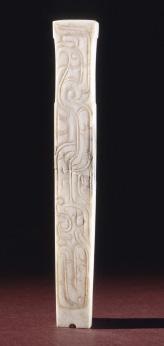
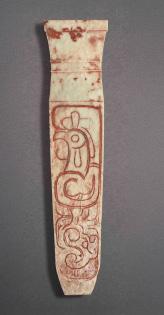

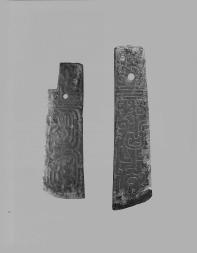


PUBLISHED
Jean-Paul Desroches (ed.) et al, The Beginning of the World. Dragons, Phoenix and Other Chimera, Fondation Baur, Geneva, 2020, p. 58, no. 29.


Expert’s note: Blades with carved decoration, such as the thread relief seen on the present lot, are exceptionally rare. The vast majority of comparable implements from the Neolithic through the Bronze Age feature plain surfaces, sometimes with one or more drilled holes, and only infrequently show incision work that is usually minimal in extent. A closely related harvesting knife (hu) in the National Museum of Asian Art in Washington, D.C. (see literature comparison) is described on their website as “reworked”, but the listing doesn’t go into detail regarding the period or extent. The possibility that this blade (and by extension also the present lot) was originally carved during the Neolithic period and subsequently embellished with its distinctive decoration in the Spring and Autumn period, also appears to be a possibility to this author.
China, 771-256 BC. Of rectangular form with notched edges on three sides, one of which is slanted. The blade is pierced with one large hole and five smaller ones. The surfaces of the three notched sides are intricately decorated in low relief, depicting a taotie buffalo among c-scrolls and dragons. Some of these are further incised with neat double grooves. The semi-translucent stone is of deep brown hues with cloudy inclusions that display a yellow tone when viewed through the stone.
Provenance: The Collection of Sam and Myrna Myers, Paris, France. Acquired between circa 1965-2012.
Condition: Very good condition with minor wear, traces of weathering and signs of prolonged burial, minuscule nibbling, the stone with natural fissures, some of which have developed into thin hairline cracks.
Weight: 345 g
Dimensions: Length 25 cm
From the end of the Eastern Zhou period to the Han dynasty, the scale and quality of jade production reached an unprecedented level. Many historians and connoisseurs regard it as China’s first high point in the development and art of jade. Carvings from this period typically possess a combination of intricacy in detail and boldness of design, enabled greatly by technological improvements with bronze implements and tools. Stylistically, designs and compositions often included long sinuous creatures, animal masks with ornate surface decoration of linked scrolls.

LITERATURE COMPARISON
Compare a closely related jade harvesting knife (hu) with interlaced dragons and birds, dated to the Spring and Autumn period, in the National Museum of Art, Smithsonian Institution, accession number F1968.38. Compare a related jade ornament, 12.1 cm long, dated to the late Spring and Autumn period, excavated from the tomb of Minister Zhou of State Jin at Jinshengcun, Tauyuan, Shanxi, now in the Shanxi Provincial Museum, illustrated by Gu Fang, The Complete Collection of Jades Unearthed from China, vol. 3, Shanxi, no. 174.


AUCTION RESULT COMPARISON
Type: Related
Auction: Sotheby’s Hong Kong, 9 October 2020, lot 68
Estimate: HKD 240,000 or approx. EUR 28,000 converted and adjusted for inflation at the time of writing
Description: A jade arc-shaped ‘animal mask’ ornament, Eastern Zhou dynasty, Spring and Autumn period
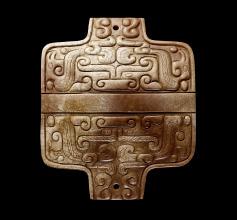
Expert remark: Compare the related manner of carving with similar animal mask. Note the different form and much smaller size (6.3 cm)
Estimate EUR 8,000
Starting price EUR 4,000

China, 1046-771 BC. The flat plaque is intricately carved and pierced with a central phoenix, flanked by two dragons, their bodies conjoined and neatly incised with double-line grooves to evoke wings and limbs, terminating on either side with a furcated fish-like tail. The translucent stone of a white tone with russet veins and inclusions.
Provenance: The Collection of Sam and Myrna Myers, Paris, France. Acquired between circa 1965-2012.
Condition: Good condition with expected wear, traces of weathering and signs of prolonged burial, minuscule nibbling, small nicks, and old smoothened losses, the stone with natural fissures, some of which may have developed into thin hairline cracks.
Weight: 59 g
Dimensions: Length 9.6 cm
LITERATURE COMPARISON
Compare a closely related openwork jade pendant depicting phoenix and dragon, with similar furcated fish-like tails to either end, 4.9 cm long, dated to the Western Zhou dynasty, in the National Palace Museum, Taipei, object number 購玉 000257N000000000.
AUCTION RESULT COMPARISON
Type: Closely related
Auction: Beijing Zhongpai International Auction Co., 3 December 2014, lot 5033
Estimate: HKD 115,000 or approx. EUR 16,000 converted and adjusted for inflation at the time of writing Description: Jade phoenix pendant Expert remark: Compare the closely related form, manner of carving, and stone. Note the size (7.7 cm).
Estimate EUR 6,000
Starting price EUR 3,000








PUBLISHED
Jean-Paul Desroches (ed.) et al, Two Americans in Paris. A Quest for Asian Art, Paris, 2016, p. 60, no. 137.
Exhibited:
1. Pointe-à-Callière Museum, From the Lands of Asia. The Sam and Myrna Myers Collection, Montréal, 17th November 2016-19th March 2017.
2. Kimbell Art Museum, From the Lands of Asia. The Sam and Myrna Myers Collection, Fort Worth, Texas, 4th March-19th August 2018.
China, 6th-5th century BC. Finely carved in relief with four confronted double-headed dragons, their bodies composed of C-scrolls and the heads with neatly incised round eyes as well as scrolling snouts, ears, and mouths, all between slightly raised borders. The semi-translucent stone of a deep yellow tone with pale brown and olive-green shadings and patches of creamy calcification.
Provenance: The Collection of Sam and Myrna Myers, Paris, France. Acquired between circa 1965-2012.
Condition: Very good condition with minor wear, signs of prolonged burial, traces of weathering, minuscule nibbling to edges.
Weight: 44 g
Dimensions: Diameter 11.3 cm
AUCTION RESULT COMPARISON
Type: Related
Auction: Christie’s Hong Kong, 3 December 2021, lot 2727
Price: HKD 300,000 or approx. EUR 35,000 converted and adjusted for inflation at the time of writing
Description: A pale celadon jade ‘dragons and clouds’ ring, huan, Early Warring States period, circa 476-400 BC
Expert remark: Compare the closely related form, manner of carving, scroll and dragon head motifs, and size (12.3 cm).
Estimate EUR 4,000
Starting price EUR 2,000
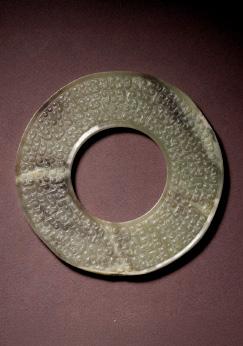
85 A RARE GREEN JADE FUNERARY MASK, WESTERN ZHOU DYNASTY, 10TH CENTURY BC



PUBLISHED
1. Myrna Myers (ed.) & Filippo Salviati (auth.), The Language of Adornment. Chinese Ornaments of Jade, Crystal, Amber and Glass, Paris, 2002, no. 23.
2. Jean-Paul Desroches (ed.) et al, The Beginning of the World. Dragons, Phoenix and Other Chimera, Fondation Baur, Geneva, 2020, p. 205, no. 132.

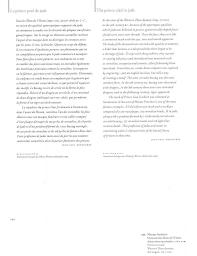
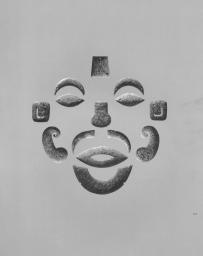

Exhibited:
1. Fondation Baur, The Beginning of the World – According to the Chinese. Dragons, Phoenix and Other Chimera, Geneva, 11 November 2020-23 May 2021.
2. Musée Départemental des Arts Asiatiques, The Beginning of the World – According to the Chinese. Dragons, Phoenix and Other Chimera, Nice, Summer 2021.
China. This funerary face covering is composed of fourteen variously shaped jade plaques reproducing the features of a human face: eyes, eyebrows, nose, mouth, chin, cheeks, moustache and ears. Except for the mouth, all the elements are pierced with small apertures. The semi-translucent stone of a green hue with extensive calcification of ivory-white and creamy-beige color. (14)
Provenance: The Collection of Sam and Myrna Myers, Paris, France. Acquired between circa 1965-2012.
Condition: Excellent condition with minor wear, signs of prolonged burial, traces of weathering, natural imperfections, remnants of ancient cinnabar, minute nibbling to the extremities. Natural inclusions.
Weight: 2.7-17.1 g
Dimensions: Length 3.7-7.5 cm
The central idea behind funerary face coverings was to prevent the spirit from wandering by offering it a new support, as well as to ensure passage of the spirit to its rightful place in the beyond. In the Chinese cultural context, it was believed that the human soul, and especially that of a high-ranking individual, was essentially composed of two parts, called hun and bo, which separated after death. The hun was conceived of as a sort of ethereal body, the real spirit of the deceased, contrary to the bo or earthly soul which found its place in the realm of the dead. An interesting passage of the 2nd century work Fengsu tongyi by Ying Shao casts additional light on the use of jade funerary masks in China: ‘the vital energy of the hun of a dead person floats away; therefore a mask is made in order to retain it.’
LITERATURE COMPARISON


Compare a closely related jade funerary face mask, dated to the late Western Zhou dynasty, in the National Palace Museum, Taipei, accession number 購 玉000410N000000000 (fig. 1). Compare a closely related jade funerary face mask, excavated Necropolis of State Guo, Sanmenxia, Henan Province, now in the Henan Provincial Museum, and illustrated in Gu Fang, The Complete Collection of Jades Unearthed in China, vol. 5, Beijing, 2005, p. 136 (fig. 2). Compare closely related jade ornaments for a funerary face mask, dated late Western Zhou, first half of the 9th century BC, in the Shanghai Museum. fig. 1 fig. 2
Estimate EUR 10,000
Starting price EUR 5,000

Exhibited:
1. Fondation Baur, The Beginning of the World – According to the Chinese. Dragons, Phoenix and Other Chimera, Geneva, 11 November 2020-23 May 2021.
2. Musée Départemental des Arts Asiatiques, The Beginning of the World – According to the Chinese. Dragons, Phoenix and Other Chimera, Nice, Summer 2021.
China, 770-476 BC. Each pendant of flattened form and meticulously carved on both sides in low relief with a dense composition of C-scrolls, often interspersed with subtly detailed, stylized beast heads as well as neatly incised, hatched designs. The translucent stones of variegated tones of celadon and pale yellow with russet inclusions, brown shadings, as well as opaque patches of creamy-beige calcification.
Comprising four pairs of bi (disks), the larger pairs with beast heads; a pair of double-dragon huang (arched pendants); a pair of notched double-tiger huangs; a pair of single-dragon pendants; a pair of oblong pendants with confronting dragons; and a notched rectangular pendant with bovine masks. The pendants, except the bi disks, are pierced with small apertures for suspension.
Provenance: The Collection of Sam and Myrna Myers, Paris, France. Acquired between circa 1965-2012.
Condition: Excellent condition with wear and natural imperfections. The edges with minuscule nibbling. Signs of prolonged burial and traces of weathering with associated small losses.
Weight: 293 g (total excl. box)
Dimensions: Diameter 3.7 cm (the smaller bi disks), Length 7 cm (the rectangular pendant) and 9.3 cm (the double-dragon huang)
With a fitted padded silk brocade storage box. (18)
AUCTION RESULT COMPARISON
Type: Closely related
Auction: Sotheby’s Hong Kong, 31 May 2023, lot 3008
Price: HKD 444,500 or approx. EUR 50,500 (for six) converted and adjusted for inflation at the time of writing
Description: A group of six archaic jade ornaments, Eastern Zhou dynasty, Warring States period
Expert remark: Compare the closely related forms and manner of carving with similar C-scrolls, beast heads, and hatched designs. Note the size (9.4 cm) and slightly later dating.

Jean-Paul Desroches (ed.) et al, The Beginning of the World. Dragons, Phoenix and Other Chimera, Fondation Baur, Geneva, 2020, p. 24-25, no. 5.



AUCTION RESULT
COMPARISON
Type: Related
Auction: Christie’s Hong Kong, 29 November 2022, lot 2708
Price: HKD 2,772,000 or approx. EUR 320,000 (for ten) converted and adjusted for inflation at the time of writing
Description: A set of ten jade pendants, Western Han dynasty
Expert remark: The central bi shows closely related carved decoration with similar C-scroll and beast heads, and further pendants exhibit related forms and manners of carving. Note the size of the largest jade (13.5 cm).
Estimate EUR 20,000
Starting price EUR 10,000

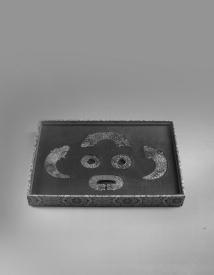


China, 7th-3rd century BC. Each of flattened form and finely carved in relief with a dense composition of C-and-S-scrolls interspersed with neatly hatched designs and stylized bird heads, all enclosed within plain bands. The translucent stone of a white tone with russet inclusions and patches of ivory-white calcification.
Comprising a bi (disk); two pairs of huang (arched pendants), the larger decorated with confronting birds; four rectangular pendants, one with notched edges; a sword pommel; and a pair of trapezoidal plaques. Each ornament (including the bi and pommel) is pierced with small apertures, likely for attachment to a garment.
Provenance: The Collection of Sam and Myrna Myers, Paris, France. Acquired between circa 1965-2012.
Condition: Very good condition with wear and natural imperfections. The edges with minuscule losses and minor nibbling. Signs of prolonged burial and traces of weathering with associated small losses.
Weight: 215 g (total excl. box)
Dimensions: 7.7 cm (large huang) – 4.7 cm (trapezoidal pendant) – 4.9 cm (small huang)
With a fitted padded silk box. (13)
Jade pendant sets discovered in Chinese royal tombs are remarkable examples of ancient ritual and decorative practice. These sets often included multiple components— bi disks, huang arc pendants, beads, and other ornaments—carefully arranged on the body or garments of the deceased. Strung together with silk cords (now decayed), they were designed not only as ornaments but also as protective talismans and symbols of status, rank, and cosmic harmony. The configuration of the pendants mirrored ritual cosmology, with round shapes symbolizing heaven and arc-shaped forms evoking the earth, reflecting beliefs in balance between the celestial and terrestrial realms. Their discovery in elite burials underscores jade’s enduring significance as a material associated with purity, immortality, and spiritual power in ancient China. For examples, see the pectoral found in the Western Han tomb of Zhao Mo, illustrated by Peter Y. K. Lam (ed.), Jades from the Tomb of the King of Nanyue, Guangzhou, 1991, pl. 52 (fig. 1), and a set of pendants dated to the Western Zhou dynasty, excavated from the Necropolis of State Guo, Sanmenxia, Henan Province, exhibited in the Jade Gallery of the Henan Provincial Museum.
Type: Closely related
Auction: Christie’s Hong Kong, 3 December 2021, lot 2747
Price: HKD 1,000,000 or approx. EUR 117,000 (for fifteen) converted and adjusted for inflation at the time of writing
Description: A group of jade ornaments and jade ring, late Spring and Autumn period, circa 570-476 BC
Expert remark: Compare the closely related manner of carving with similar C- and S-scrolls. Note the size of the largest jade (10 cm).
Estimate EUR 15,000
Starting price EUR 7,500

fig. 1



88 A GREEN JADE ‘DRAGONS AND BIRDS’ RING-FORM PENDANT, EASTERN ZHOU DYNASTY
China, 7th-2nd century BC. The thick-walled ring neatly incised with double-line grooves on both sides with two pairs of stylized dragons and long-necked birds, their bodies richly detailed with scroll designs. The translucent stone of a deep forest-green hue with icy inclusions and a small patch of russet calcification.
Provenance: The Collection of Sam and Myrna Myers, Paris, France. Acquired between circa 1965-2012.
Condition: Good condition with expected wear, traces of weathering and signs of prolonged burial, old smoothened chips, minuscule nibbling, the stone with natural fissures, some of which have developed into thin hairline cracks.
Weight: 76 g
Dimensions: Diameter 6.9 cm
LITERATURE COMPARISON
Compare two related jade bi carved with similar dragon scroll designs, 12.1 cm and 17 diameter, both dated to the Spring and Autumn period, ca. 600-476 BC, in the National Museum of Asian Art, Smithsonian Institution, accession numbers S1987.933 and S1987.674. Compare a related jade pendant in the form of a ring, of similar thickness albeit slightly convex shape, incised with scroll and hatched designs, 3.9 cm diameter, dated to the Warring States period, in the National Museum of Asian Art, Smithsonian Institution, accession number S2012.9.1313.

Estimate

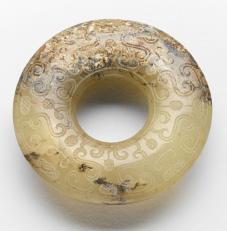

89
Exhibited:
1. Pointe-à-Callière Museum, From the Lands of Asia. The Sam and Myrna Myers Collection, Montréal, 17 November 2016-19 March 2017.
2. Kimbell Art Museum, From the Lands of Asia. The Sam and Myrna Myers Collection, Fort Worth, Texas, 4 March-19 August 2018.
Expert’s note: The majority of jade fittings were made to adorn the swords of nobles, which were hung from the belt and secured with the aid of a slide attached to the scabbard. The present lot is an early and markedly large example limited to a handle—as opposed to the standard group including the pommel and guard—with decoration of the type seen often on jades made in South China, like those produced in the state of Wu, Jiangsu province.
China. Of elliptical section, the sides tapering gently towards the butt end, each side intricately carved in relief with a band of snake-like interlaced dragons with bold features and neatly incised bodies, the handle smoothly polished, the shorter end still holding the deeply corroded remnants of the iron blade. The opaque stone now of an ivory-white tone.
Provenance: The Collection of Sam and Myrna Myers, Paris, France. Acquired between circa 1965-2012.
Condition: Good condition, commensurate with age. Obvious losses, signs of prolonged burial, traces of weathering, extensive calcification, encrustations, corrosion, minute nicks, the stone with natural fissures, some of which have developed into thin hairline cracks.
Weight: 184.3 g
Dimensions: Length 16.4 cm
With a padded storage box. (2)




PUBLISHED
Jean-Paul Desroches (ed.) et al, Two Americans in Paris: A Quest for Asian Art, Paris, 2016, p. 74, no. 161.
Literature comparison: Compare a related jade pendant with a similar design of interlaced dragons, dated to the later Spring and Autumn period, c. 600-476 BC, in the National Museum of Asian Art, Smithsonian Institution, accession number F1916.146. The design of interlaced dragons can also be observed on an openwork gold sword hilt, dated circa 6th-5th century BC, in the British Museum, registration number 1937,0416.218.
AUCTION RESULT COMPARISON
Type: Related
Auction: Christie’s Hong Kong, 28 November 2018, lot 2760
Price: HKD 475,000 or approx. EUR 59,000 converted and adjusted for inflation at the time of writing
Description: An exceptionally rare and important celadon jade ‘dragon’ weapon fitting
Expert remark: Compare the related manner of carving, calcified stone, and dragon motifs. Note the similar size (14.8 cm).
Estimate EUR 15,000
Starting price EUR 7,500
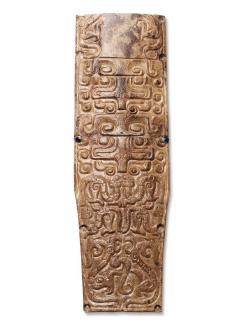


90
A YELLOW AND RUSSET JADE ‘BOVINE MASK’ SCABBARD CHAPE, BI, SPRING AND AUTUMN PERIOD
China, 6th-5th century BC. Of trapezoidal form with notched edges, finely carved to one side in shallow relief with the horns, eyes, and nose of a bovine, surrounded by densely arranged C-scrolls. The translucent stone is of a deep yellow tone with dark russet shadings and areas of creamy-beige calcification. Both ends are pierced with a central hole, the lower aperture evoking the beast’s mouth.
Provenance: The Collection of Sam and Myrna Myers, Paris, France. Acquired between circa 1965-2012.
Condition: Very good condition with minor wear, signs of prolonged burial, traces of weathering, minuscule nibbling to edges. The stone with natural fissures, some of which may develop into thin hairline cracks. Distinct remnants of ancient cinnabar.
Weight: 68 g
Dimensions: Length 4 cm
The present lot belongs to one of the four recognized types of jade sword accessories, along with the pommel (shou), guard (ge), and scabbard slide (zhi), collectively known as yujujian or ‘sword-decorating jades’, which emerged in the 6th-5th century BC alongside the fully developed sword and its rise as a status symbol among the ruling elite. This particular jade chape was not affixed directly to the sword itself, but rather to the end of the scabbard—typically made of wood, bamboo, or leather—serving both a protective and decorative function. Such ornaments reflected the owner’s rank and taste, and their craftsmanship often paralleled the refinement of the weapon they accompanied.
LITERATURE COMPARISON
Compare a closely related jade hilt with tiger’s heads, dated 6th-5th century BC, 4.2 cm long, formerly in the collection of Sir Joseph Hotung and now in the British Museum, registration number 2022,3034.182 (fig. 1). Compare a closely related jade ornament with a dragon pattern, dated to the Spring and Autumn period, 2.7 cm high, in the National Palace Museum, Taipei, accession number 購玉 000268N000000000. fig. 1
AUCTION RESULT COMPARISON
Type: Closely related
Auction: Christie’s Hong Kong, 28 November 2018, lot 2750
Price: HKD 275,000 or approx. EUR 17,000 converted and adjusted for inflation at the time of writing
Description: A celadon jade ‘animal mask’ scabbard chape, bi, Spring and Autumn period (770-476 BC)

Expert remark: Compare the closely related form, manner of carving, motifs, and size (4.7 cm).
Estimate EUR 3,000
Starting price EUR 1,500

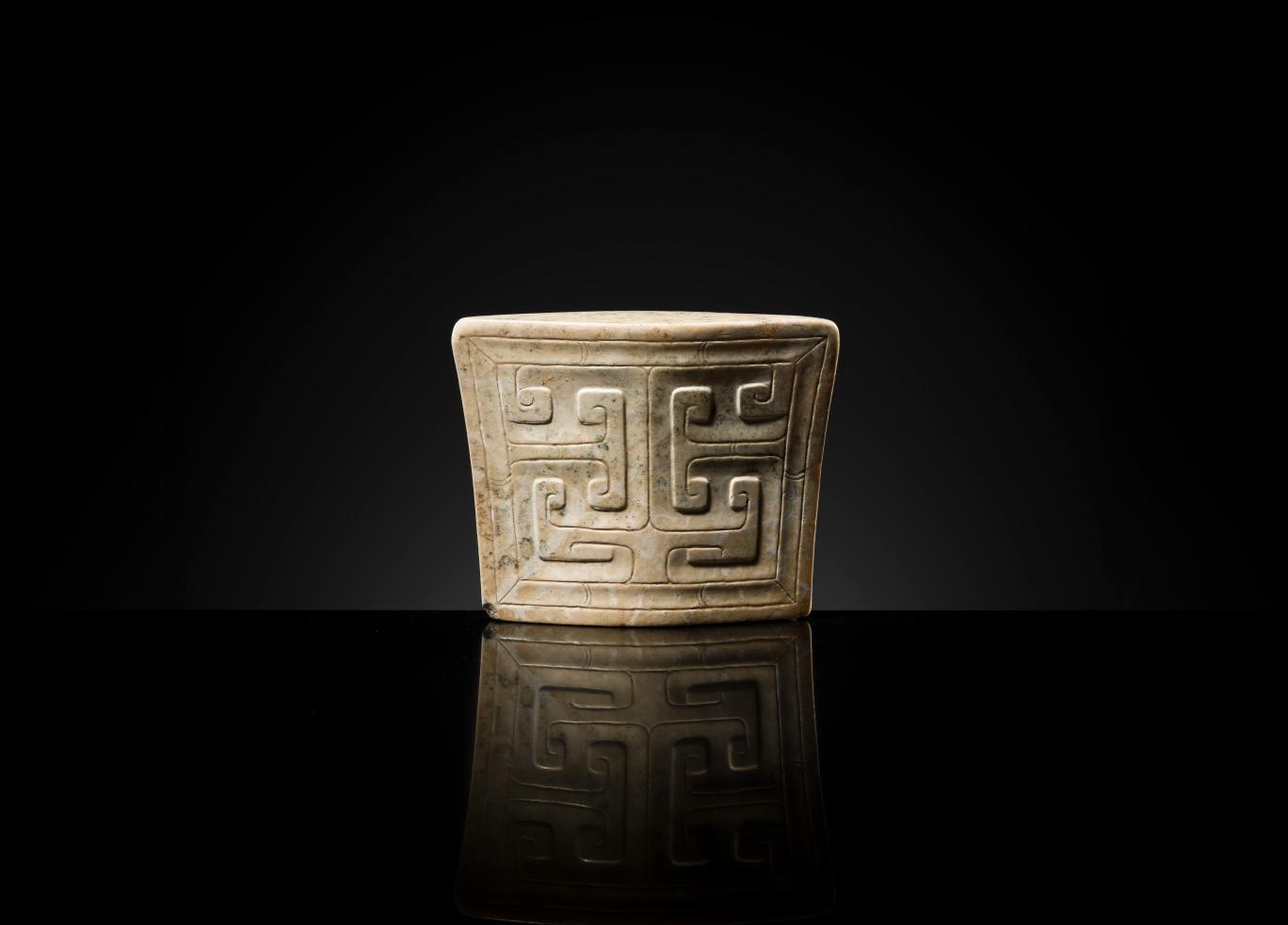
A JADE ‘MASK’ SCABBARD CHAPE, WARRING STATES PERIOD TO HAN
China, 4th century BC-1st century AD. Of lenticular section, finely carved to both sides with slightly raised angular scroll designs enclosed by line borders embellished with subtle incision work, the larger flat end neatly incised with an S-scroll, the other end pierced with a central hole for attachment to the bottom of the scabbard. The semi-translucent stone with small areas of pale green under the extensive opaque ivory-colored alteration as well as dark greenish-gray specks.
Provenance: The Collection of Sam and Myrna Myers, Paris, France. Acquired between circa 1965-2012.
Condition: Very good condition with wear, minor signs of burial and traces of weathering, a small chip to one corner, the calcified stone with natural veins and fissures, some of which have developed into small hairline cracks.
Weight: 41 g
Dimensions: Length 5.2 cm
Positioned at the tip of the scabbard as decoration, scabbard chapes first appeared during the Western Zhou period and rose to prominence in the Eastern Zhou dynasty. By the Warring States period and into the Han dynasty, these decorative fittings had evolved into powerful symbols of elite status.
LITERATURE COMPARISON
Compare a closely related jade scabbard chape dated to the Western Han dynasty in the Art Institute of Chicago, reference number 1950.729 (fig. 1). Compare a closely related jade scabbard chape dated to the Warring States period in the Ashmolean Museum, Oxford, accession number EA1956.1589.
Compare a closely related jade scabbard chape dated to the Warring States period in the National Museum of Asian Art, Smithsonian Institution, accession number S2012.9.894.

1
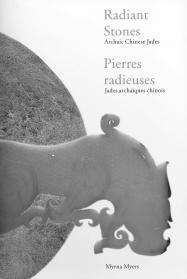


PUBLISHED
Myrna Myers (ed.) & Filippo Salviati (auth.), Radiant Stones. Archaic Chinese Jades, Paris, 2000, no. 135.
AUCTION RESULT COMPARISON
Type: Closely related
Auction: Christie’s New York, 21 March 2014, lot 2002
Price: USD 6,875 or approx. EUR 8,000 converted and adjusted for inflation at the time of writing
Description: A greyish-green jade scabbard chape, late Eastern Zhou/Han dynasty, 4th century BC-1st century AD

Expert remark: Compare the closely related form, manner of carving, motifs, stone, and size (5.5 cm).
Estimate EUR 3,000
Starting price EUR 1,500
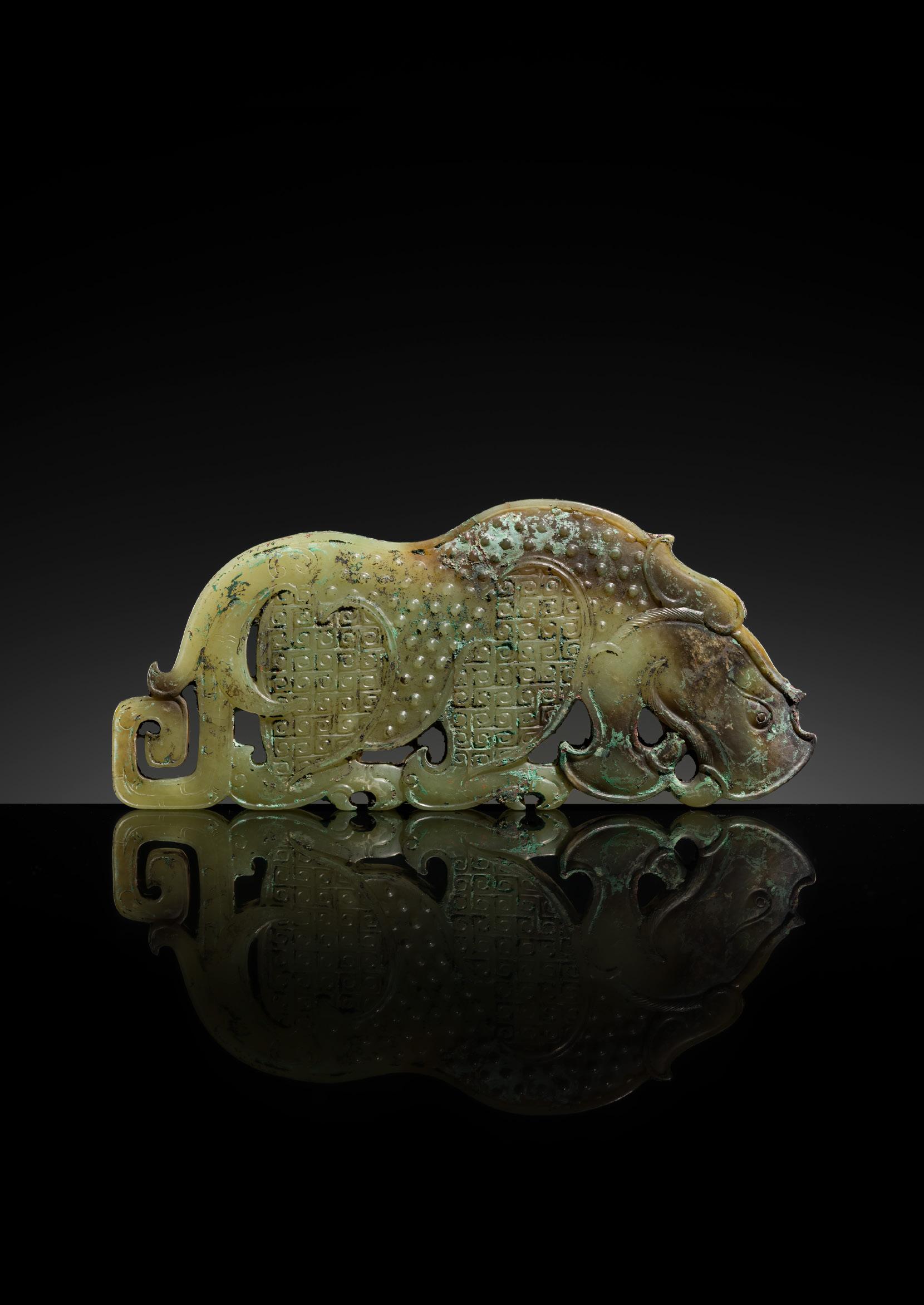
Expert’s note: This jade figure shows extensive metal encrustations of vibrant green and red color, most likely caused by the corrosion of bronze and iron objects that lay in close proximity to it, likely as part of an elaborate pectoral for a person of high status, like the examples found in the tomb of the Zhao Mo (see Peter Y. K. Lam (ed.), Jades from the Tomb of the King of Nanyue, Guangzhou, 1991, pls. 52, see fig. 1). Green malachite is a primary source of the greenish alteration often observed on excavated ancient jade artifacts.
China, Henan province, 3rd century BC. Powerfully carved in the form of a crouching beast with an undulating back defined with crisp edges, the head of the beast depicted with a horn issuing along the contours and ending in an upcurled tip, further rendered with a prominent and broad snout ending in an arc-shaped tip, the muscular body terminating in a furcated tail issuing an angular hooked scroll and decorated with subtle relief on each side with raised bosses, the bent limbs with interconnected scroll, the translucent stone of a deep celadon tone with brown shadings.

Provenance: The Collection of Sam and Myrna Myers, Paris, France.
Acquired between circa 1965-2012.
Condition: Good condition with expected wear, traces of weathering and signs of prolonged burial including encrustations of soil and malachite as well as corrosion. The stone with natural fissures, some of which may have developed into thin hairline cracks.
Weight: 360 g
Dimensions: Length 19.6 cm
This finely carved jade plaque belongs to a small and exceptional group of Warring States period animal pendants (475–221 BC), characterized by their dynamic silhouettes, precise detailing, and luminous polish. Though traditionally referred to as “tiger plaques,” the present example—along with closely related pairs in the Fogg Art Museum, the Cleveland Museum of Art, and the Freer Gallery of Art—suggests a more complex interpretation. Each of these pieces varies slightly in proportion, surface pattern, and relief carving, from T-hook and C-scroll motifs to abstract linear ornament, yet all reflect the technical and aesthetic sophistication achieved by late Eastern Zhou jade artisans.
The prominent horn, broad arc-tipped snout, and massive rounded neck and shoulders evoke not the sinuous grace of a dragon or feline dynamism of a tiger, but rather the grounded bulk and physical force of a rhinoceros. As J. Keith Wilson observed, the animal appears “at once tiger-like, rhino-like, and dragon-like” (Bulletin of the Cleveland Museum of Art, 1993, p. 127)—a deliberate ambiguity that speaks to the imaginative visual vocabulary of the time. While the term hu (tiger) was commonly used in early texts such as the Zhou li and often retained even when the animal form shifted toward dragons (see Jessica Rawson, Chinese Jade: From the Neolithic to the Qing, London, 1995, p. 261), the present carving seems to reach beyond such classifications.
A similar pendant from the tomb of Zhao Mo, who ruled as King of Nanyue from 137-122 BC during the Western Han dynasty, is illustrated in Peter Y. K. Lam (ed.), Jades from the Tomb of the King of Nanyue, Guangzhou, 1991, pls. 52, 54, and 55 (figs. 1-3), and offers further support for this interpretation. This pendant, of considerably smaller size than the present lot, formed part of the King’s elaborate jade pectoral, shows a similar silhouette, and has been identified as a rhinocerosshaped huang by Lam (see “Selected Jades from an Imperial Nanyue Tomb”, in Chinese Jade. Selected Articles from Orientations 1983-2003, Hong Kong, 2005, p. 121). Together, these works reflect both the symbolic elasticity and formal inventiveness of early Chinese jade carving.

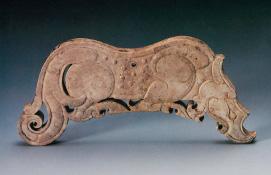

LITERATURE COMPARISON
Compare a pair of closely related jade tiger plaques, 19.1 cm long, dated Warring States-Western Han, 3rd century BC in the Fogg Art Museum, Harvard University, object number 1943.50.469. Compare a pair of closely related jade tiger plaques, 22.5 and 20.8 cm long, dated to the Warring States period, in the Cleveland Museum of Art, accession number 1991.78. Compare a pair of closely related jade tiger plaques, 14.7 and 15.1 cm long, dated to the Warring States period, in the Freer Gallery of Art, Smithsonian Institution, included in the exhibition Chinese Art of the Warring States Period. Change and Continuity, 480-222 BC, 1982, cat. no. 96.



AUCTION RESULT COMPARISON
Type: Closely related
Auction: Sotheby’s Hong Kong, 3 April 2019, lot 3620
Estimate: HKD 26,575,000 or approx. EUR 3,210,000 converted and adjusted for inflation at the time of writing
Description: An exceptional and large yellow jade animal-shaped plaque, Eastern Zhou dynasty
Expert remark: Compare the closely related subject and type as well as the related manner of carving and size (22 cm).
This exceptional plaque was formerly also in the Myers Collection, kept in the same cabinet as the present lot.
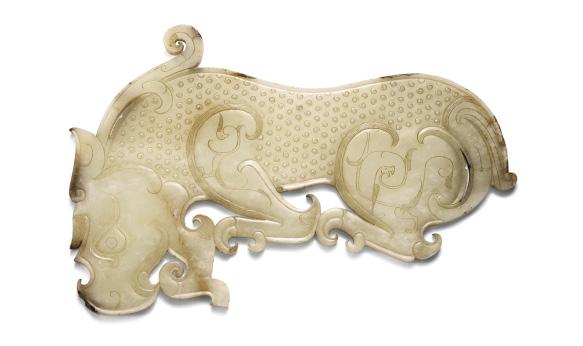
Estimate EUR 30,000
Starting price EUR 15,000




PUBLISHED
China. The funerary vest composed with small rectangular plaques cut from various kinds of jade, shaped on the top to follow the curve of the neck and shoulders. The plaques richly and meticulously incised at the chest with a majestic phoenix in flight, and each with small perforations drilled at each corner through which a metal thread is passed to hold them together.
Provenance: The Collection of Sam and Myrna Myers, Paris, France. Acquired between circa 1965-2012.
Condition: Good condition with wear and natural imperfections including fissures, few cracks, and inclusions, small chips, expected minor losses, and scattered corrosion to the jades. Although all components look 100% original, the possibility that there are replacements can never be excluded with absolute certainty.
Dimensions: Size 72 x 57 cm (excl. frame), 88 x 66 cm (incl. frame)
Set inside a frame, behind glass.

The influence of Daoist ideas about immortality and the preservation of the body after death undoubtedly inspired the Han-dynasty practice of encasing the body of high-ranking persons in funerary suits made of jade. Once known only through textual references, the existence of jade garments was confirmed after the discovery in 1968 of the undisturbed tomb of Prince Liu Sheng and his consort, Dou Wan, at Mancheng, Hubei province (see literature comparison). Since then, more than forty complete or partial jade suits have been discovered by Chinese archaeologists, mostly in sites located in eastern China.
Elderly people in China traditionally prepare special clothes to be buried in, known as shouyi, which directly translates to ‘longevity clothes’, before they pass. However, nobles of the Han dynasty preferred more elaborate burial attire, like the jade burial suit, also known as a shroud or coffin. Made entirely of jade pieces linked with gold, silver, or copper threads, these suits were a mark of high status.
Both literary and archaeological sources suggest that jade suits more elaborately decorated than those found at Lingshan (Mancheng) were also produced. Han shu records a ‘pearl robe jade suit’ in its description of the funeral accorded the notorious eunuch Dong Xian. The Tang commentator Yan Shigu (581-645) explains the phrase: ‘A pearl robe has pearls for the tunic like a suit of armor sewn together using gold thread. From the waist down the suit is jade (plaques), and down to the feet it too is sewn together with gold thread.’ If no archaeological corollary to this kind of shroud has yet been reported, there are at least two known examples of suits made from plaques that were engraved and then decorated with gold thread or foil on their surfaces. The dragon, floral, and cloud patterns rendered in gold found on these plaques may indicate that over time jade suits became even more elaborate. See Robert L. Thorp, “Mountain Tombs and Jade Burial Suits: Preparation for Eternity in the Western Han”, in Ancient Mortuary Traditions of China: Papers on Chinese Ceramic Funerary Sculptures, 1991, p. 36.
China’s reverence for jade dates back to its earliest civilizations Mined from mountain streams and possessing an intriguing translucence, jade symbolized noble qualities such as purity and resilience. People wore jade ornaments on a daily basis. At the sites of the Liangzhu culture, located near present-day Hangzhou, Zhejiang province and regarded as one of the oldest civilizations in the world over 4,000 years ago, archeologists have discovered numerous jade ornaments and disks. The Book of Rites, a collection of texts mainly published in the Han dynasty on the society and politics of the Zhou era, recorded that ‘a gentleman shall not part with his jade without cause’.
LITERATURE COMPARISON
Jade garments such as the present lot, although conforming to basic models and to a widely diffused funerary practice, show frequent differences, probably reflecting personal choice and taste. Compare the two gold-threaded jade burial suits of Liu Sheng, a king of the Western Han dynasty, and his wife Dou Wan, who both died in the 2nd century BC, discovered near the top of Lingshan Mountain, Hebei province, and now exhibited at the Hebei Museum, Shijiazhuang (fig. 1). Compare a closely related jade shroud sewn with gold wire, dated to the 2nd century BC, 175 cm long, discovered in a princely tomb at Shizishan, Xuzhou, northern Jiangsu province. Compare a closely related jade burial suit threaded with gold, Western Han dynasty, unearthed in 1985 from a Han dynasty tomb in Yongcheng, Henan province, and now in the Henan Museum.

Estimate EUR 15,000
Starting price EUR 7,500


Exhibited:
1. Fondation Baur, The Beginning of the World – According to the Chinese. Dragons, Phoenix and Other Chimera, Geneva, 11 November 2020-23 May 2021.
2. Musée Départemental des Arts Asiatiques, The Beginning of the World – According to the Chinese. Dragons, Phoenix and Other Chimera, Nice, Summer 2021.
China, 202 BC-220 AD. Each side finely carved in low relief with a dense pattern of comma spirals neatly arranged between the raised inner and outer borders. The semi-translucent stone of a greenish-yellow tone with extensive opaque calcification, patches of creamy-russet, and dark brownish-black streaky inclusions.
Provenance: The Collection of Sam and Myrna Myers, Paris, France. Acquired between circa 1965-2012.
Condition: Very good condition with minor wear, signs of prolonged burial and traces of weathering with few small associated losses, minuscule nibbling, the stone with natural fissures, some of which may have developed into small hairline cracks.
Weight: 446 g
Dimensions: Diameter 20.1 cm
During the late Warring States and Han periods, jade bi evolved from objects primarily associated with burial contexts to decorative elements incorporated into luxury items, architectural fittings, and ceremonial regalia. While their earlier use suggests cosmological significance—possibly linked to ritual practices—the exact nature of their function remains uncertain. In the Han period, bi continued to appear in tombs and may have retained ritual or symbolic roles, even as their formal qualities became increasingly refined and their decorative use more widespread. The enduring cultural importance of the bi is reflected in the character for jade, 玉 (yù), and its visual echo in the character for king, 王 (wáng), reinforcing the association between jade, power, and transcendence.
PUBLISHED
Jean-Paul Desroches (ed.) et al, The Beginning of the World. Dragons, Phoenix and Other Chimera, Fondation
Baur, Geneva, 2020, p. 213, no. 141

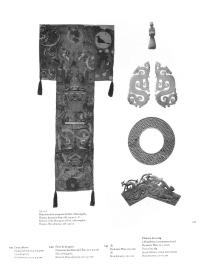

LITERATURE COMPARISON
Compare a closely related jade bi disk, 15.2 cm diameter, excavated from the Western Han-period tomb of the Nanyue King Zhao Mo (r. 137 BC-122 BC), illustrated by Peter Y. K. Lam (ed.), Jades from the Tomb of the King of Nanyue, p. 239, pl. 26, no. D50-10. Zhao Mo’s tomb was discovered in downtown Guangzhou in 1983, and the Museum of the Western Han Dynasty Mausoleum of the Nanyue King housing the tomb opened in 1988.
AUCTION RESULT COMPARISON
Type: Closely related
Auction: Christie’s New York, 27 September 2017, lot 37
Price: USD 16,250 or approx. EUR 18,000 converted and adjusted for inflation at the time of writing
Description: An archaistic celadon and brown jade bi disc, Han dynasty


Expert remark: Compare the closely related form, manner of carving with similar comma-spirals, stone with similar dark brownish-black streaky inclusions, and size (19.4 cm).
Estimate EUR 6,000
Starting price EUR 3,000

A YELLOW AND RUSSET JADE ‘ROPE-TWIST’ BANGLE, HAN DYNASTY OR EARLIER
China, 206 BC-220 AD or earlier. Of short, cylindrical form with curved outer walls, decorated with diagonally incised grooves that wrap around the circumference. These grooves are evenly spaced. The mostly opaque stone now of an ivory-white tone with russet veins and inclusions, dark gray specks, and hints of translucent yellow.
Provenance: The Collection of Sam and Myrna Myers, Paris, France.
Acquired between circa 1965-2012.
Condition: Very good condition with expected ancient wear, traces of weathering, erosion, calcification, and signs of prolonged burial with associated small losses, the stone with natural fissures, some of which have developed into small hairline cracks.
Weight: 190 g
Dimensions: Diameter 9.2 cm
LITERATURE COMPARISON
Compare a closely related brown jade bracelet of similar size (9 cm) in the National Museum of Asian Art, Smithsonian Institution, accession number S2012.9.1004 (fig. 1)
Compare a related jade bracelet with ropetwist design, dated to the Han dynasty, 8.8 cm diameter, in the British Museum, registration number 2022,3034.185.

fig. 1
Compare a related jade bracelet with bands from the Liangzhu culture, in the National Museum of Asian Art, Smithsonian Institution, accession number F1917.43. Compare a related calcified jade bracelet dated ca. 1600-1050 BC, in the National Museum of Asian Art, Smithsonian Institution, accession number F1916.387.
AUCTION RESULT COMPARISON
Type: Related
Auction: Bonhams London, 13 May 2019, lot 1
Price: GBP 37,562 or approx. EUR 61,000 converted and adjusted for inflation at the time of writing
Description: A yellow and russet jade bangle, Shang Dynasty or later
Expert remark: Compare the related form, manner of carving, stone, and size (7.6 cm).
Estimate EUR 3,000
Starting price EUR 1,500


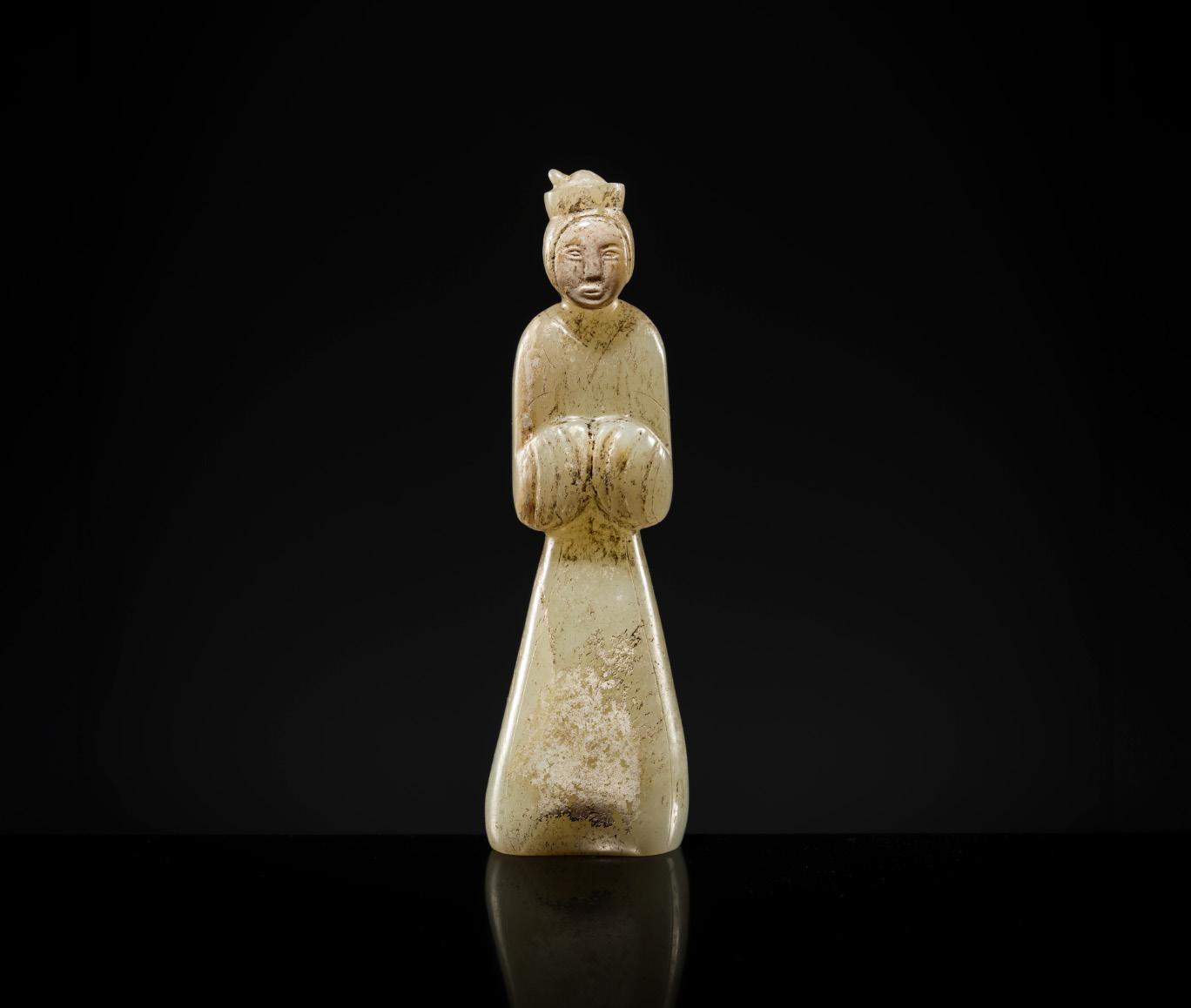
96 AN EXCEEDINGLY RARE AND IMPORTANT GRAYISH-WHITE JADE FIGURE OF A COURT LADY, EARLY WESTERN HAN DYNASTY
Exhibited:
1. Pointe-à-Callière Museum, From the Lands of Asia. The Sam and Myrna Myers Collection, Montréal, 17th November 2016-19th March 2017.
2. Kimbell Art Museum, From the Lands of Asia. The Sam and Myrna Myers Collection, Fort Worth, Texas, 4th March-19th August 2018.
3. Fondation Baur, The Beginning of the World – According to the Chinese. Dragons, Phoenix and Other Chimera, Geneva, 11 November 2020-23 May 2021.
4. Musée Départemental des Arts Asiatiques, The Beginning of the World – According to the Chinese. Dragons, Phoenix and Other Chimera, Nice, Summer 2021.
China, 3rd-2nd century BC. Superbly carved in a standing pose with elbows bent and hands held before the waist, dressed in a long robe flaring near the hem, her hair neatly tied into a knot secured by a hairpin with a short curling end falling behind the head. The semitranslucent stone is of a pale grayish-white color with dark russet inclusions as well as patches of creamy white calcification.
Provenance: The Collection of Sam and Myrna Myers, Paris, France. Acquired between circa 1965-2012.
Condition: Good condition, commensurate with age. With expected wear, traces of weathering and erosion, areas of calcification, minuscule nibbling and losses. The stone with natural inclusions, veining and fissures, some of which have developed into small hairline cracks. Some of these cracks show old fills.




PUBLISHED
1.
2.
Weight: 112 g
and
Dimensions: Height 11.2 cm
AUCTION RESULT COMPARISON
Type: Closely related
Auction: Sotheby’s Hong Kong, 4 April 2017, lot 3323
Price: HKD 1,250,000 or approx. EUR 160,000 (for two) converted and adjusted for inflation at the time of writing
Description: Two extremely rare calcified celadon jade figures of standing ladies, Western Han dynasty
Expert remark: Compare the closely related form and manner of carving.
Estimate EUR 6,000
Starting price EUR 3,000


97
China, 206 BC-220 AD. Superbly carved in openwork as an archer’s ring with a central aperture surrounded by a dragon and phoenix clambering over the sides, their furcated tails and other details as well as other details terminating in hooks and scrolls, the ring neatly incised with scroll designs, the semi-translucent stone of a pale tone with extensive russet shading ranging from pale brown to deep amber and patches of opaque ivory-colored calcification.
Provenance: The Collection of Sam and Myrna Myers, Paris, France. Acquired between circa 1965-2012.
Condition: Very good condition with minor wear, traces of weathering, signs of prolonged burial, encrustations, small areas of calcification, minuscule nibbling to edges.
Weight: 22 g
Dimensions: Height 5.4 cm
Although purely ornamental, pendants like the present lot, which derived from archer’s thumb rings, were still known as she or jue (the old term for the archer’s ring during the Zhou dynasty) in the Han period, the two terms being essentially synonymous. For further discussion, see James C. Y. Watt, Chinese Jades from Han to Ch’ing, New York, 1980, p.180. The pointed end and the central circular aperture follow the style of the preceding periods, and more decorative features were added to the oval pendant during the Han dynasty.
LITERATURE COMPARISON
Compare two closely related jade archer’s ring plaques with chilong and phoenix, dated to Han dynasty, in the Palace Museum, Beijing. Two closely related archer’s rings, also in the Myers Collection, are published in Jean-Paul Desroches (ed.) et al, Two Americans in Paris. A Quest for Asian Art, Paris, 2016, p. 78-79, nos. 173 and 174.



AUCTION RESULT COMPARISON
Type: Related
Auction: Bonhams Hong Kong, 29 May 2024, lot 447
Price: HKD 1,401,000 or approx. EUR 155,000 converted and adjusted for inflation at the time of writing
Description: A white jade ‘chilong and phoenix’ pendant, Western Han Dynasty
Expert remark: Compare the closely related form, manner of carving, and motifs. Note the related size (6.4 cm).
Estimate EUR 4,000
Starting price EUR 2,000

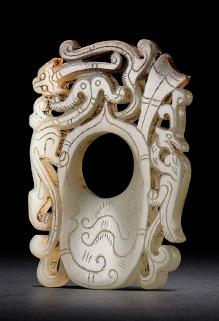
Exhibited:
1. Fondation Baur, The Beginning of the World – According to the Chinese. Dragons, Phoenix and Other Chimera, Geneva, 11 November 2020-23 May 2021.
2. Musée Départemental des Arts Asiatiques, The Beginning of the World – According to the Chinese. Dragons, Phoenix and Other Chimera, Nice, Summer 2021.
China, 206 BC-220 AD. The flat plaque is carved to depict a dragon clambering on the top of a trapezoidal frame while peering over the edge, with sinuous body and long scrolling tail, surrounded by further hooks. A phoenix is carved outside the frame facing one edge. The openwork design is neatly incised with c-scrolls and a further animal above the rectangular pierced handle. The translucent stone of a celadon tone with a magnificent shading of opaque black along one edge.
Provenance: The Collection of Sam and Myrna Myers, Paris, France. Acquired between circa 1965-2012.
Condition: Very good condition with little wear, minuscule nibbling here and there, and a minute chip to the outer edge. The stone with natural fissures, some of which may have developed into small hairline cracks.
Weight: 135 g
Dimensions: Height 18 cm
The present jade very closely resembles one from the Chu Valley of Kings, excavated from Shizishan and now housed in the Xuzhou Museum. Characterized by its elegant contours, pierced detailing, and lyrical motifs, the piece exemplifies the refined aesthetic unique to the Chu kingdom during the Western Han dynasty. The royal mausoleums of Chu near Xuzhou—particularly at Shizishan, Beidongshan, and Tuolanshan—have yielded some of the most remarkable jade finds in Chinese archaeology, including over 2,000 jade artifacts and a gold-wired jade burial suit of unprecedented scale and craftsmanship. These jades, many believed to have been produced in local Chu workshops, display a visual language distinct from that of other Han vassal states: a fusion of lingering Warring States elegance with early imperial formality, often incorporating fluid dragons, phoenixes, and abstracted cloud motifs. Today, the Chu jades are widely regarded as among the finest in both quality and quantity of all jade artifacts recovered from the Han dynasty, underscoring the Chu kingdom’s importance as a regional center of jade artistry.


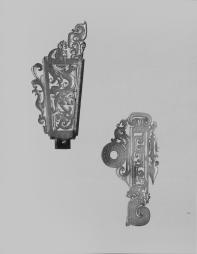

PUBLISHED
Jean-Paul Desroches (ed.) et al, The Beginning of the World. Dragons, Phoenix and Other Chimera, Fondation Baur, Geneva, 2020, p. 61, no. 31.
LITERATURE COMPARISON
Compare a near identical celadon jade dragon ornament, dated to the Western Han dynasty, excavated from the tomb of King Chu at Shizishan, Xuzhou, in the Xuzhou Museum, included in the exhibition Flight of Dragons and Dance of Phoenixes: Jade Artifacts from the Tomb of the King of Chu in the Han Dynasty at Xuzhou, Beijing Art Museum and Xuzhou Museum, Beijing, 2016.

AUCTION RESULT COMPARISON
Type: Closely related
Auction: Christie’s Hong Kong, 29 November 2017, lot 2773
Price: HKD 1,062,500 or approx. EUR 133,000 converted and adjusted for inflation at the time of writing
Description: An openwork jade ‘chilong and monkey’ scabbard chape, Western Han dynasty

Expert remark: Compare the closely related form and manner of carving with similar chilong clambering on the top of a trapezoidal frame while peering over the edge. Note the size (7.5 cm) and monkey.
Estimate EUR 10,000
Starting price EUR 5,000

Exhibited:
1. Fondation Baur, The Beginning of the World – According to the Chinese. Dragons, Phoenix and Other Chimera, Geneva, 11 November 2020-23 May 2021.
2. Musée Départemental des Arts Asiatiques, The Beginning of the World – According to the Chinese. Dragons, Phoenix and Other Chimera, Nice, Summer 2021.
China, 2nd century BC-1st century AD. Skillfully worked in the round as an elephant standing foursquare on its short legs with its long trunk curled to its left and its tail swished to its right, the animal depicted with characteristic dorsal bumps flanked by floppy ears, the corpulent body rendered gravitating towards the ground and delicately detailed with incisions to depict folds of wrinkles. The semi-translucent stone of a celadon tone with russet and cloudy inclusions.
Provenance: The Collection of Sam and Myrna Myers, Paris, France. Acquired between circa 1965-2012.
Condition: Excellent condition with minor wear, areas of calcification, tiny encrustations, few microscopic nibbles.
Weight: 177 g
Dimensions: Length 7.1 cm
During the Shang Dynasty, the Central Plain of China enjoyed a warm and humid climate and provided a suitable habitat for elephants. The archaeological ruins of Anyang, one of the Shang capitals, yielded large amounts of ivory and elephant bones, indicating that the Shang nobility sacrificed elephants in their rituals. The Lüshi Chunqiu (Spring and Autumn Annals of Master Lü) records the Shang people’s taming of elephants, ‘The Shang people trained elephants, which they used to oppress the Eastern Yi people. The Duke of Zhou consequently chased them with his armies to the Jiangnan region.’ The Tomb of Fu Hao yielded two jade elephants carved in the round, measuring 6-6.5 cm in length and 3-3.3cm in height, with upward-curling noses, slightly open mouths, eyes in the form of the chen character, ears close to the shoulders, and incised throughout with double lines. See Zhongguo gu qingtongqi xuan (A Selection of Ancient Chinese Bronzes), Beijing, 1976, pl. 91.
Han dynasty jade elephants carved in the round have yet to be found archaeologically, but some Han dynasty gilt-bronze elephants are extant, including four excavated in an Eastern Han burial site at Lijiacun, Koudian, Yanshi, Henan. See Nanjing Museum and Xuyi Cultural and Media Bureau, Jiangsu Xuyiai xian Dayunshan Xihan Jiangdu wangling yihao mu (Royal Mausoleum No. 1 of the Vassal King of Jiangdu State of the Western Han dynasty), Kaogu/Archaeology, Beijing, vol. 10, 2013, p. 36, fig. 57:1. Another relevant example is a gilt-bronze elephant recently excavated from the tomb of Liu Fei, Prince of Jiangdu of the Western Han Dynasty (and a stepbrother of Liu Che, Emperor Wu of the Han), Dayunshan, Xuyi, Jiangsu. Measuring 30.5 cm in length and 20 cm in height, this carving is depicted with large round eyes, ears pulled back, a long backward-curling nose and a tail that hangs towards the left.
LITERATURE COMPARISON
Compare a closely related jade figure of an elephant, dated to the Han dynasty, in the British Museum, registration number 2022,3034.255.



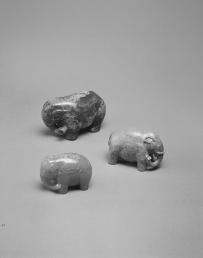

PUBLISHED
Jean-Paul Desroches (ed.) et al, The Beginning of the World. Dragons, Phoenix and Other Chimera, Fondation Baur, Geneva, 2020, p. 46, no. 23.
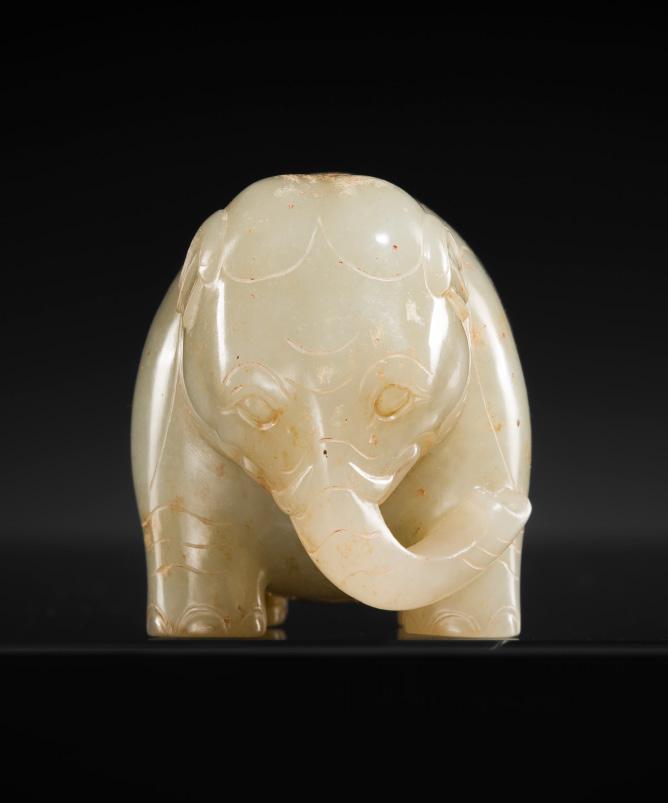
AUCTION RESULT COMPARISON
Type: Closely related
Auction: Sotheby’s Hong Kong, 4 April 2017, lot 3305
Estimate: HKD 7,300,000 or approx. EUR 920,000 converted and adjusted for inflation at the time of writing
Description: An outstanding and extremely rare celadon jade figure of an elephant, Western Han dynasty

Expert remark: Compare the closely related subject, stone, manner of carving, and incised details. Note the related size (8.4 cm).
Estimate EUR 15,000
Starting price EUR 7,500

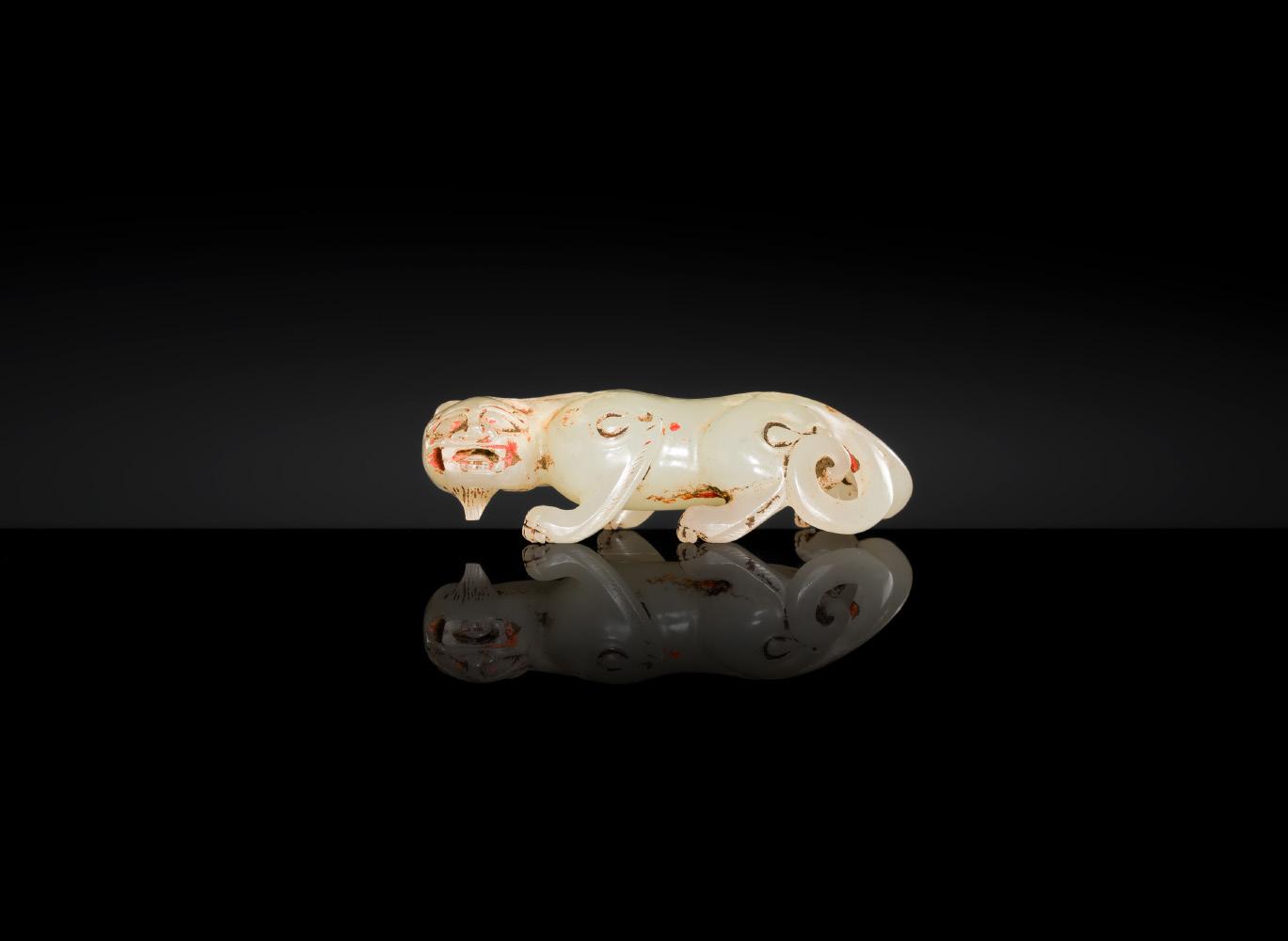
100
China. Skillfully carved as mythical beast standing crouched low in an attacking stance on four sharply clawed feet. Its mane finely incised, the mouth bares its ferocious teeth and bulging eyes and its scrolling tail bifurcated. The translucent stone of a pale celadon tone with creamy shading, and red and brown pigments.
Provenance: The Collection of Sam and Myrna Myers, Paris, France. Acquired between circa 1965-2012.
Condition: Very good condition with expected ancient wear, traces of weathering, areas of calcification, and residual soil and cinnabar. Minute nibbles here and there. Surface alterations suggest the possibility of prolonged burial. The stone exhibits natural fissures, some of which may have developed into fine hairline cracks.
Weight: 25 g
Dimensions: Length 5.7 cm
EXPERT’S NOTE
The style of carving, subject matter, and poised stance are inspired by the powerful mythical beasts of the Han dynasty and shortly thereafter—though it remains possible that this piece dates precisely to that period. Jade animals carved in the round were comparatively more common in the Han dynasty than in previous periods and much emphasis was placed on the depiction of wild animals in all their ferocity, which the carver of the present figure has accomplished with apparent ease and great success. Compare a jade bixie of closely related size (5.5 cm) from the Sze Yuan Tang collection, published and exhibited by the University of Hong Kong Museum and Art Gallery, Art and Imitation in China, 14 October-17 December 2006, p. 119, no. 14, and later dated “Han dynasty or later” and sold at Bonhams Hong Kong, 5 April 2016, lot 33, for HKD 24,760,000. Compare also a white and russet jade carving of a mythical beast, dated to the Han dynasty, at Bonhams Hong Kong, 27 November 2024, lot 493.

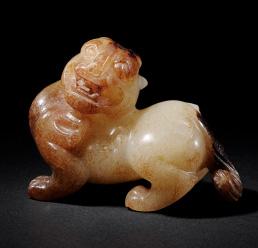
AUCTION RESULT
COMPARISON
Type: Closely related
Auction: Christie’s London, 6 November 2007, lot 19
Price: GBP 4,000 or approx. EUR 9,000 converted and adjusted for inflation at the time of writing
Description: A small celadon jade toggle, late Ming dynasty

Expert remark: Compare the related modeling and manner of carving with similar features—though notably lacking burial signs, cinnabar traces, surface alterations, and exhibiting instead a smoother polish and softer finish. Note the size (7 cm).
AUCTION RESULT
COMPARISON
Type: Related
Auction: Bonhams Hong Kong, 27 November 2018, lot 127
Price: HKD 56,250 or approx. EUR 7,000 converted and adjusted for inflation at the time of writing

Description: A rare pale green and russet jade carving of a recumbent mythical beast, Ming dynasty
Expert remark: Compare the related modeling and manner of carving with similar pose, albeit a slightly more timid expression and overall less dynamic appearance. Note the size (9 cm).
Estimate EUR 2,000
Starting price EUR 1,000

101 AN AGATE FIGURE OF A MYTHICAL BEAST, 17TH-18TH CENTURY
China. Finely carved in the round as a powerful leonine creature in a dynamic pouncing pose with the head turned sharply to the side, well detailed with bulging eyes, broad snout, and two prominent horns, framed by the long wavy mane, the muscular limbs with neatly incised fur tufts and sharp claws, the tail swept upward and terminating in a furcated fish-like tip, the base carved with swirling waves. The translucent stone of a pale gray tone exhibiting varying hues of yellow, amber, and deep russet with few creamy-white patches.
Provenance: The Collection of Sam and Myrna Myers, Paris, France.
Acquired between circa 1965-2012.
Condition: Good condition with minor wear, a small loss to the neck, little nibbling, the stone with natural fissures, some of which have developed into thin hairline cracks.
Weight: 389.1 g
Dimensions: Length 10.3 cm
AUCTION RESULT COMPARISON
Type: Closely related
Auction: Sotheby’s Hong Kong, 9 April 2006, lot 1771
Price: HKD 48,000 or approx. EUR 8,500 converted and adjusted for inflation at the time of writing
Description: A finely carved agate mythical beast, 17th century Expert remark: Compare the closely related stone and manner of carving with similar stance, bulging eyes, and color.
AUCTION RESULT COMPARISON
Type: Related
Auction: Christie’s New York, 15 September 2017, lot 1048
Price: USD 12,500 or approx. EUR 14,000 converted and adjusted for inflation at the time of writing
Description: An agate carving of two buddhist lions, 18th century
Expert remark: Compare the related stone and manner of carving. Note the size (7.3 cm).
Estimate EUR 3,000
Starting price EUR 1,500
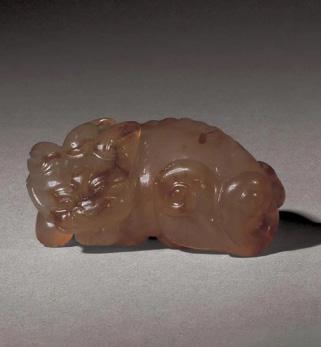


102
China, 17th-18th century. Dexterously carved, seated in dhyanasana, with his right hand lowered in bhumisparsa mudra and the left held in dhyana mudra over his lap, delicately cradling a sacred pearl. Boldly attired in a loose-fitting sanghati with ample folds cascading over one shoulder, leaving the chest partially exposed.
The meditative face bearing a serene expression marked by heavylidded downcast eyes below sinuously arched brows centered by an urna, a broad nose, and full lips forming a calm smile, all flanked by long, pendulous earlobes resting on his shoulders. The hair arranged in tight curls over the high ushnisha topped by a bud-shaped finial.
The amber exhibiting a warm, caramel-brownish tone with golden inclusions. Rare!
Provenance: The Collection of Sam and Myrna Myers, Paris, France. Acquired between circa 1965-2012.
Condition: Fair condition with old wear, natural inclusions and fissures, scattered small nicks, the lower edge of the base with minor nibbling and a shallow chip, light surface scratches mostly to base. The neck and one earlobe with old repairs.
Analysis: The surface shows microscopic deposits of silicate minerals with traces of iron and titanium oxides, consistent with natural clay sediment. The presence of vermilion, potassium chloride, and barium sulfate indicates that the sculpture was fully painted after the 18th century, in line with Buddhist tradition. Residual copper and microscopic steel particles point to surface treatment, most likely from historical restoration (see condition report). The clay sediment layer formed after both the painting and the restoration, suggesting that these interventions date back at least a century.
Weight: 228.6 g
Dimensions: Height 13.6 cm
A fossilized tree resin, amber was a rare and highly treasured material which appealed not only for its attractive natural hues but also for the beneficial properties it was believed to possess, such as self-healing, transmuting negative energy into positive, as well as being effective for detoxification. The art of amber carving reached its zenith during the 18th century, when a vast range of objects was produced at both the Imperial workshops located in the Forbidden City and select ateliers in Suzhou.
LITERATURE COMPARISON
The carving style of this Buddha is also associated with the later Ming dynasty, see for example a carved wood Buddha at Christie’s Amsterdam, December 2002, illustrated on Himalayan Art Resources, item number 20999 (fig. 1). Compare a related smaller amber figure of Buddha, 5.1 cm high, dated to the Qianlong period, in the Metropolitan Museum of Art, object number 21.175.111. See also a related larger amber figure of Buddha sold at Sotheby’s Hong Kong, 17 May 1989, lot 391. fig. 1
Estimate EUR 3,000
Starting price EUR 1,500



Expert’s note: Our piece, unlike the more common export silver examples, evokes a classical aesthetic rooted in Tang dynasty traditions, which continued to influence metalwork throughout the successive Liao, Song, and Yuan periods. For this reason, there is a possibility that this tray is earlier than the date indicated above. See a parcel-gilt and repoussé silver ‘dragon’ bowl, Liao dynasty, dated by inscription to the bingyin year of the Taiping era, corresponding to 1026, 17.5 cm wide, formerly in the collection of Alan and Simon Hartman, at Bonhams New York, 14 December 2023, lot 62; another silver octagonal dish, Southern Song dynasty, 17.7 cm wide, at Christie’s New York, 25 March 2022, lot 763; and a parcel-gilt silver vase, Meiping, Song dynasty, at Bonhams Hong Kong, 29 May 2024, lot 401.
Of oval form, finely chased and embossed to the center with the Four Symbols which are the Azure Dragon of the East, the Vermilion Bird of the South, the White Tiger of the West, and the Black Tortoise (also called “Black Warrior”) of the North, in addition to these four mythical beasts, the flying carp is also represented, all against a minutely ringpunched ground, encircled by a band of long shaped cartouches enclosing designs including squirrels and grapevines, butterflies and feline beasts, and gourds borne on leafy scrolling vines, below a band of scrolling foliage to the rim. The back fitted with a small loop for wall suspension.
Provenance: The Collection of Sam and Myrna Myers, Paris, France. Acquired between circa 1965-2012.
Condition: Very good condition with minor wear and manufacturing irregularities, expected tarnish, minor encrustations, light warping, tiny dents and dings, few small nicks.
Weight: 358.6 g
Dimensions: Length 29.3 cm
The Four Symbols (Sì Xiàng) are legendary creatures representing the cardinal directions and the four seasons. They are the Azure Dragon of the East, the Vermilion Bird of the South, the White Tiger of the West, and the Black Tortoise of the North. Each symbol carries deep cultural, spiritual, and cosmological significance.
The combination of carp and dragon alludes to the path of the scholar who must leap like a carp across the Longmen Falls in order to transform into a dragon, meaning to pass his examinations.
AUCTION RESULT COMPARISON
Type: Related
Auction: Sotheby’s London, 6 November 2013, lot 428
Price: GBP 7,500 or approx. EUR 14,000 converted and adjusted for inflation at the time of writing
Description: A Chinese export repoussé silver ‘dragon and carp’ tray, circa 1900
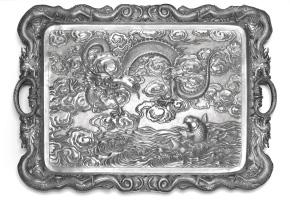
Expert remark: Compare the related technique and motifs. Note the different form and style.
AUCTION RESULT COMPARISON
Type: Related
Auction: Bonhams Edinburgh, 22 March 2017, lot 163
Price: GBP 12,500 or approx. EUR 21,500 converted and adjusted for inflation at the time of writing
Description: A large silver repoussé decorated box and cover, by Tai He, probably Bangkok, 19th century
Expert remark: Compare the related technique and motifs. Note the different form and the size (22 cm).
Estimate EUR 2,000
Starting price EUR 1,000
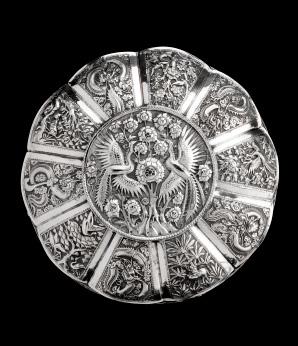

104
A BROWN AND RED LACQUER ‘EAR’ CUP, ERBEI, WARRING STATES PERIOD TO WESTERN HAN DYNASTY
China, Chu state, 3rd century BC. Of elliptical form, with deep rounded sides resting on a flat base, flanked by a pair of rounded ear-shaped handles set at a slight angle. The exterior covered with a dark brown lacquer, the rim and handles with red-lacquered geometric motifs, the interior finely decorated with a pheasant flanked by two swimming carp and interspersed with delicate stylized sprays, all in black and ochre against a lustrous red ground.
Provenance: The Collection of Sam and Myrna Myers, Paris, France. Acquired between circa 1965-2012.
Condition: Condition as expected from this group of wares and commensurate with age, with old wear, minor traces of use, sparse nicks, few small chips, and losses to lacquer.
Weight: 75.7 g
Dimensions: Length 14.4 cm
The Chu state, noted for its lacquer production, had become the major cultural force in south-central China by the Warring States period. The visual arts of Chu are often characterized as shamanistic in response to the prevalence of images of fairylike creatures riding on dragons, or clouds that change imperceptibly into dragons, and, as they meander through the sky, transform again into dragons. The playful lines painted on this winged cup are though a later stylized version of the traditional cloud-dragon motif, combined with a repertory of fantastic animals, birds, and anthropoid figures. These elements sometimes appear interrelated in order to express a mystical idea or vision; in other instances, they seem to fulfill a narrative purpose. The two large winglike appendages on the cup are often described as ‘ears’ in Chinese writings and cups of this type, generally termed ‘ear cups’ (erbei), are known from at least the 8th century BC. The current lot was most likely once part of a matched set of eating and drinking vessels.
LITERATURE COMPARISON
Compare a closely related lacquered ear cup with phoenix pattern, dated to the Warring States period, 16 cm long, in the Shanghai Museum (fig. 1) and illustrated in their catalog In a Myriad of Forms: The Ancient Chinese Lacquers, Shanghai, 2018, p. 43-44. Compare a related lacquered ear cup, dated to the Qin dynasty 221-206 BC, 19.2 cm long, in the Nelson Atkins Museum of Art, object number 48-36/4. Compare a related lacquered ear cup with geometric designs, dated to the Warring States period, 3th century BC, 15.2 cm long, in the Metropolitan Museum of Art, object number 1974.268.4.
AUCTION RESULT
COMPARISON
Type: Related
Auction: Bonhams Hong Kong, 29 May 2022, lot 107
Price: HKD 51,000 or approx. EUR 6,000 (for two) converted and adjusted for inflation at the time of writing
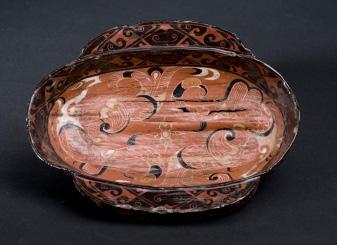

Description: A rare pair of painted ‘ear’ cups, Western Han dynasty Expert remark: Compare the related form, decorative style, and lacquering technique. Note the size (11 cm).
Estimate EUR 3,000
Starting price EUR 1,500
Scientific analysis: A C14 test confirms a dating from mid-17th century to end of 18th century with a 84,9% probability.
China, mid-17th century to end of 18th century. The face finely carved with a serene expression, heavy-lidded downcast eyes under gently arched brows, a short wide nose, and a gently parted mouth revealing teeth within, flanked by ears with pendulous lobes, the neatly incised hair parted in the center.
Provenance: The Collection of Sam and Myrna Myers, Paris, France. Acquired between circa 1965-2012.
Condition: Overall good condition with old wear, natural imperfections including age cracks, fissures, and minor signs of insect activity, few chips, obvious losses, flaking and losses to pigment, and remnants of gilt and lacquer to the back.
Weight: 2,405 g
Dimensions: Height 26 cm (excl. stand), 34.5 cm (incl. stand)
With an associated wood stand. (2)
Literature comparison: Compare a closely related wood head of a luohan, dated to the Ming dynasty, 24.5 cm high, in the National Museum of Asian Art, Smithsonian Institution, accession number F1917.248. Compare a figure of the pilgrim Sudhana (Shancai tongzi) with similar facial features and expression, dated to the Ming dynasty, late 15th-early 17th century, 69.9 cm high, in the Metropolitan Museum of Art, object number 42.25.6.
AUCTION RESULT COMPARISON
Type: Related
Auction: Christie’s New York, 17 March 2017, lot 1024
Price: USD 18,750 or approx. EUR 21,000 converted and adjusted for inflation at the time of writing
Description: A painted wood head of a luohan, Yuan-Ming dynasty, 13th-16th century

Expert remark: Compare the related modeling and manner of carving with similar facial features. Note the size (34.6 cm).
Estimate EUR 4,000
Starting price EUR 2,000

Scientific analysis: A C14 test confirms a dating of 1423 - 1455 AD with a probability of 95,4%.
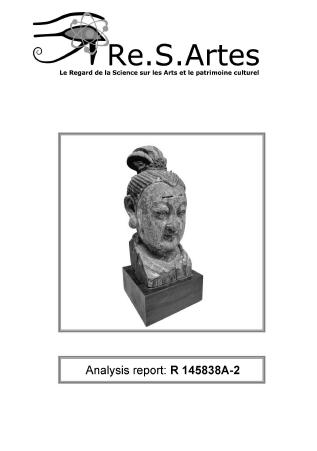
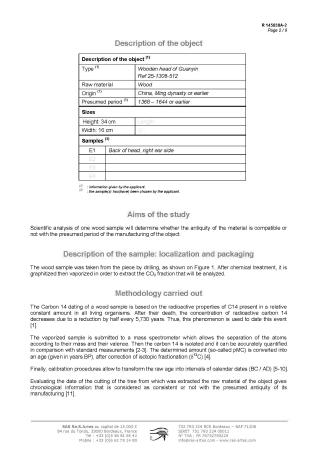
China, first half of 15th century. The face is finely carved with full cheeks, heavily and sinuously lidded, piercing eyes below gently arched brows, with pursed bow-shaped lips, flanked by ears with thick pendulous lobes, the hair finely combed into a looped chignon, secured by a foliate diadem.
Provenance: The Collection of Sam and Myrna Myers, Paris, France. Acquired between circa 1965-2012.
Condition: Extensive wear, natural imperfections including age cracks, fissures, and insect activity. Few chips, small losses, flaking and losses to pigment.
Weight: 2,112 g (excl. stand), 3,171 g (incl. stand)
Dimensions: Height 39 cm (excl. stand), 41 cm (incl. stand)
With an associated wood stand. (2)
LITERATURE COMPARISON
Compare a related, larger, carved and painted wood head of a bodhisattva, dated “probably” Song dynasty, 66 cm high, in the Victoria & Albert Museum, accession number A.21-1921.
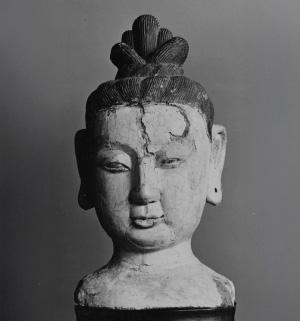
AUCTION RESULT COMPARISON
Type: Related
Auction: Christie’s Hong Kong, 30 November 2023, lot 2890
Estimate: HKD 1,000,000 or approx. EUR 113,000 converted and adjusted for inflation at the time of writing
Description: A carved wood head of Bodhisattva, Song dynasty Expert remark: Note the size (46.3 cm).
Estimate EUR 10,000
Starting price EUR 5,000


Exhibited:
1. Pointe-à-Callière Museum, From the Lands of Asia. The Sam and Myrna Myers Collection, Montréal, 17 November 2016-19 March 2017.
2. Kimbell Art Museum, From the Lands of Asia. The Sam and Myrna Myers Collection, Fort Worth, Texas, 4 March-19 August 2018.
China, 1368-1644. Finely cast, the oval face with full cheeks, downcast eyes below arched brows, and full bow-shaped lips forming a calm smile, flanked by pendulous earlobes, the hair finely combed into a stylized chignon, crowned with a ceremonial headdress.
PUBLISHED
Jean-Paul Desroches (ed.) et al, Two Americans in Paris. A Quest for Asian Art, Paris, 2016, p. 112, no. 209.

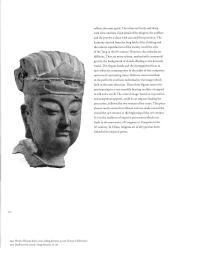

Literature comparison: Compare two closely related cast iron heads of Daoist deities, dated to the Ming dynasty, 31.7 and 55.9 cm high, in the Asian Art Museum of San Francisco, object numbers B60S97 and B60S96.

Provenance: Collection of Han Coray (18801974), Zurich and Agnuzzo, Switzerland. The Collection of Sam and Myrna Myers, Paris, France, acquired from the above on 7 October 1974. Han Coray (1880-1974) was a Swiss educator, art dealer, and important collector of African art. While serving as a school principal and running an avant-garde gallery in Zurich during World War I, he first encountered African art. After marrying into wealth in 1919, he began collecting seriously, acquiring works from Parisian dealers like Paul Guillaume, an early expert in African art and culture, and a mutual friend of Romanian poet and performer Tristan Tzara. Coray assembled a celebrated collection that included European art from the 15th to 18th centuries and over 2,000 pieces of African art, making him Switzerland’s first major collector in this field. He established a private museum, envisioning it as a universal museum of human art. Following his wife’s death in 1928, he sold much of the collection to public institutions and private buyers. From 1930, he lived in Agnuzzo, where he established a hotel named Casa Coray, where he housed his old and newly acquired works, remaining devoted to art collecting throughout his life. Condition: Extensive wear and casting irregularities. Obvious losses, cracks, repairs, fills, signs of weathering, encrustations, and corrosion.
Dimensions: Height 38 cm (excl. stand), 47.5 cm (incl. stand)
With an associated wood stand. (2)
This icon wears a ceremonial headdress which would have been made of leather straps assembled on a bamboo support tied with bands, a type of headdress reserved for nobility. Its position in the hierarchy of the pantheon is indicated here allegorically.
AUCTION RESULT COMPARISON
Type: Closely related
Auction: Christie’s New York, 18 December 2007, lot 467
Price: USD 11,875 or approx. EUR 15,500 converted and adjusted for inflation at the time of writing
Description: A large Chinese cast iron head of a Daoist deity, Ming dynasty
Expert remark: Compare the closely related modeling, manner of casting, and subject. Note the size (45.8 cm).
AUCTION RESULT COMPARISON
Type: Closely related
Auction: Christie’s Amsterdam, 31 October 2000, lot 100
Price: NLG 87,765 or approx. EUR 71,500 converted and adjusted for inflation at the time of writing
Description: A fine Chinese, Ming dynasty, iron head of Buddha Sakyamuni, circa 15th century
Expert remark: Compare the related modeling and manner of casting. Note the size (45 cm) and different subject.
Estimate EUR 8,000
Starting price EUR 4,000
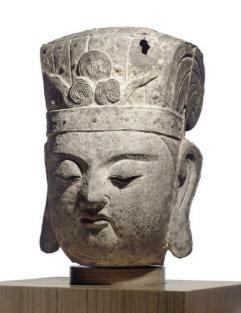



108
AN
China, 16th-17th century. Finely carved, the mother goddess standing with her body gently arched to the right, richly attired in long, flowing robes that cascade elegantly from her arms. Her plump face holding a serene expression defined by heavy-lidded, downcast eyes, a flattened nose, and full lips forming a calm smile, all framed by finely incised hair falling over her shoulders. The female deity charmingly supports in her arms a small child with upraised arms, clutching a book with one of his hands, while bearing a pensive expression. The ivory exhibiting a rich patina, with its creamy surface subtly suffused with caramel tones.
Provenance: The Collection of Sam and Myrna Myers, Paris, France. Acquired between circa 1965-2012. Condition: Good condition with expected wear and age cracks, minor losses to exposed areas, few minute nicks, light surface scratches, the ivory with a fine, naturally grown, soft honey patina.
Weight: 183 g (incl. stand)
Dimensions: Height 15.5 cm (excl. stand), 17.2 cm (incl. stand)
Mounted on a modern stand. (2)
The Songzi representation of Guanyin, or the ‘Bringer of Sons’, is distinguished by the boy carried in her arms. Male children were extremely important to Confucian family structure. They ensured not only the continuity of family and clan, but that there would be uninterrupted generations to carry on the rituals of ancestral worship. The Child-Giving Guanyin was prayed to by worshipers for healthy children and intelligent male heirs. Extant depictions of Songzi Guanyin from the later Ming dynasty are known in various materials, including bronze, wood, stone, and ivory.
LITERATURE COMPARISON
Compare a closely related ivory figure of Guanyin holding an infant boy, China, Ming dynasty, dated 16th-17th century, 18.7 cm high, in the British Museum, registration number 2018,3005.18.

AUCTION RESULT COMPARISON
Type: Closely related
Auction: Sotheby’s Hong Kong, 30 May 2018, lot 22
Price: HKD 100,000 or approx. EUR 12,500 converted and adjusted for inflation at the time of writing
Description: An ivory ‘Guanyin and child’ group, late Ming dynasty
Expert remark: Compare the pose of the child resting in his mother’s arms and the manner in which the hair of Guanyin is carved. Note the similar size (16.5 cm).
Estimate EUR 2,000
Starting price EUR 1,000

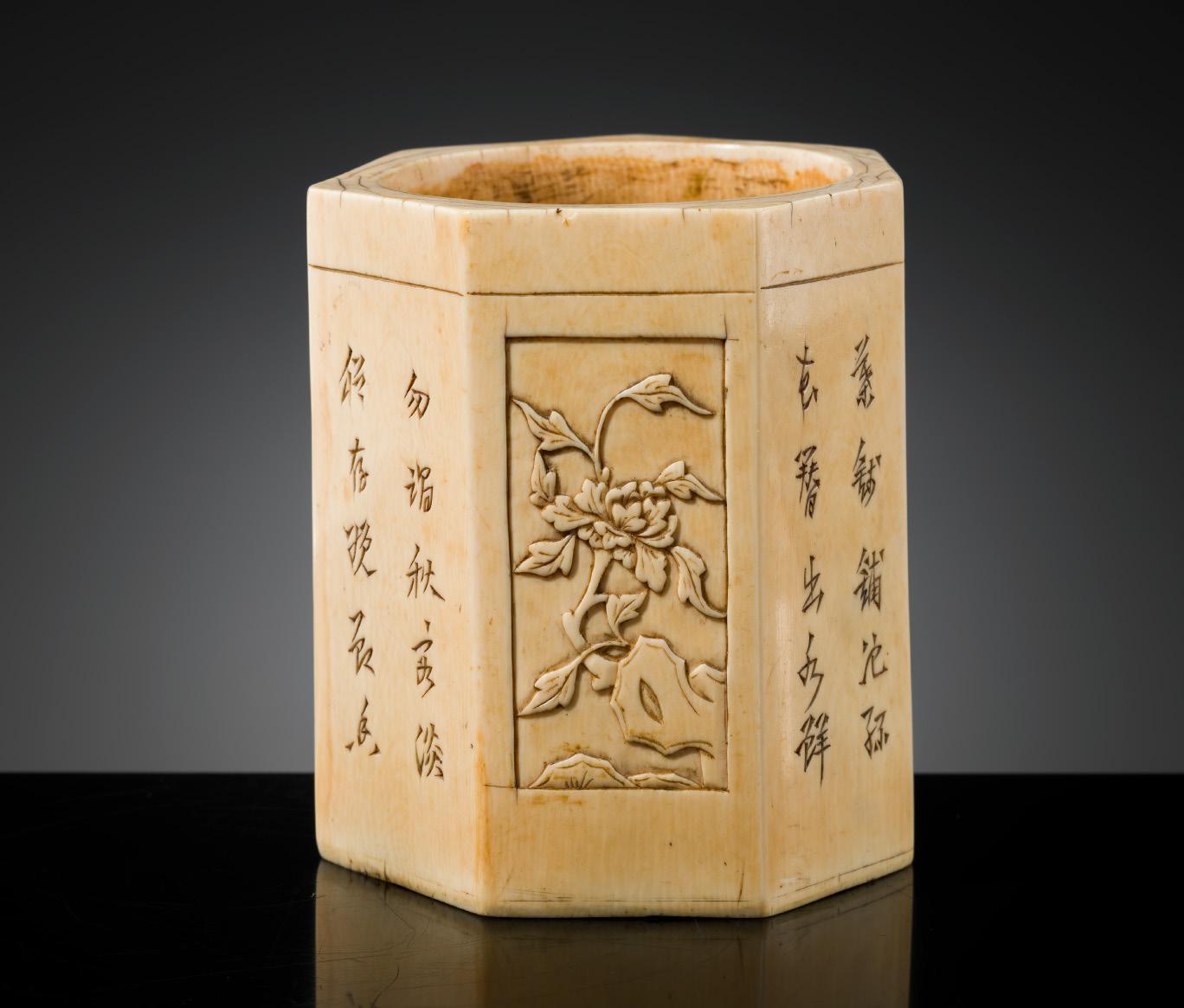
China, 17th-18th century. The section of tusk displaying its original oval interior form and cut with seven faceted faces, finely carved with four alternating rectangular panels depicting flowering branches with cherry, peony, lotus, and chrysanthemum blossoms, beside rockwork and a standing crane. The remaining three faces delicately incised with poetic inscriptions. The base fitted with a central oval zitan plug of attractive grain and color with characteristic ‘crab’s claw’ marks. The ivory exhibiting a fine honey-amber patina.
Inscriptions: To three of the sides:
1. 葉鉥鋪 [...] 孫, 春簪出[...] 鮮 Yeshu pu [...] sun, chun zan chu [...] xian
2 江南春色秀,一枝奪搖光 Jiangnan chunse xiu, yizhi duo yaoguang ‘Spring is beautiful in the South, a branch glows in the shimmer.’
3. 勿谒秋客淡, [...] 存晚 [...] 香 Wuye qiuke dan, [...] cun wan [...] xiang ‘The autumn visitor leaves behind a delicate scent.’
江南春色秀,一枝奪搖光 Jiangnan chunse xiu, yizhi duo yaoguang ‘Spring is beautiful in the South, a branch glows in the shimmer.’
勿谒秋客淡, [...] 存晚 [...] 香 Wuye qiuke dan, [...] cun wan [...] xiang ‘The autumn visitor leaves behind a delicate scent.’
Provenance: The Collection of Sam and Myrna Myers, Paris, France. Acquired between circa 1965-2012.
Condition: Overall good condition with wear, expected traces of use, minor age cracks, sparse nicks, minute nibbles to edges, few minor fills to the base.
Weight: 352.4 g
Dimensions: Height 10.9 cm
Literature comparison: Compare a closely related polygonal ivory brush pot with floral depictions and calligraphic inscriptions, 11.5 cm high, dated early 17th century, in the British Museum, registration number 2018,3005.252.
AUCTION RESULT COMPARISON
Type: Closely related
Auction: Christie’s London, 6 November 2012, lot 137
Price: GBP 10,000 or approx. EUR 19,000 converted and adjusted for inflation at the time of writing
Description: A carved and inscribed ivory hexagonal brush pot, bitong, Kangxi period
Expert remark: Compare the closely related form, manner of carving, decoration, and size (11.1 cm).
AUCTION RESULT COMPARISON
Type: Closely related
Auction: Christie’s London, 9 November 2011, lot 590
Price: GBP 18,750 or approx. EUR 37,000 converted and adjusted for inflation at the time of writing
Description: A Chinese octagonal ivory brush pot, 17th-18th century
Expert remark: Compare the closely related faceted form and decoration with similar floral panels and calligraphic inscriptions. Note the size (12.4 cm).
Estimate EUR 2,000
Starting price EUR 1,000


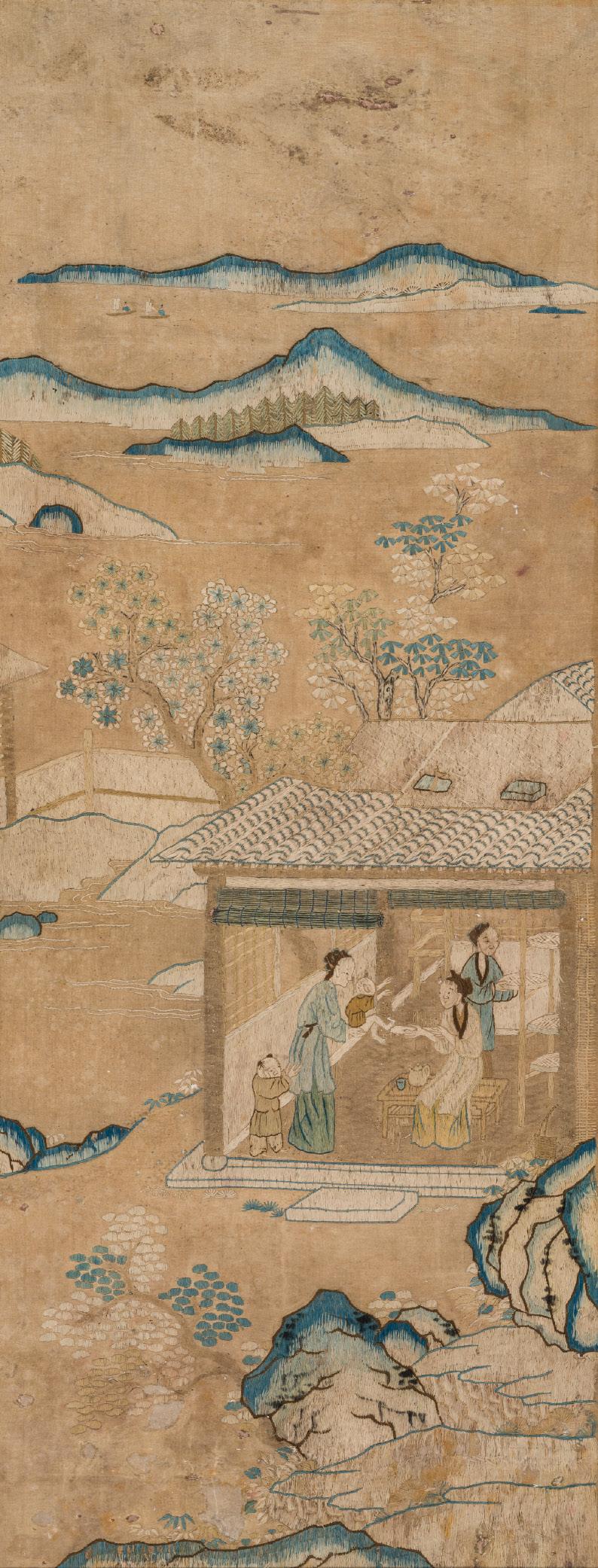
110
China. The golden-beige silk finely decorated with a pavilion enclosed within a thatched fence, housed within are three figures busy at work, a young mother passing her infant to a seated lady as her toddler tugs on the hem of her robe, the third woman busy shelving trays. The landscape dotted with craggy rocks, rolling hills, and verdant trees bearing blossoms, few stray boats in the distance.
Provenance: The Collection of Sam and Myrna Myers, Paris, France. Acquired between circa 1965-2012.
Condition: Good condition commensurate with age, showing old wear, light soiling and browning, few minor tears and loose threads, minute losses.
Dimensions: Image size 56 x 22 cm, Size incl. frame 70 x 36 cm
Framed under glass.
Type: Closely related
Auction: Christie’s New York, 18 March 2016, lot 1386
Price: USD 25,000 or approx. EUR 29,000 converted and adjusted for inflation at the time of writing
Description: A rare gu family embroidered silk panel, 17th-18th century
Expert remark: Compare the closely related style and technique. Note the different size (97.8 x 43.1 cm) as well as the inscription and studio seals.
Estimate EUR 3,000
Starting price EUR 1,500

China, 1368-1644. The panel is finely woven in shades of blue, yellow, and ivory white, featuring a pattern of stylized floral blossoms with cloudlike petals radiating tripartite leaf blades, all borne on foliate scrolling vines against a rust-gold ground.
Provenance: The Collection of Sam and Myrna Myers, Paris, France. Acquired between circa 1965-2012.
Condition: Overall fair condition with expected wear, soiling and browning commensurate with age, minor tears, losses, few loose threads, the outer edges possibly trimmed.
Dimensions: Panel size 126 x 67 cm, Size incl. frame 138 x 78.5
Mounted and framed behind glass. (2)
Literature comparison:
Compare a related fragment of a panel with similar cloud scrolls, dated 17th-18th century, 10.8 x 33 cm, in the Metropolitan Museum of Art, object number 46.133.68. Compare a related fragment of a panel with a dragon, dated to the Ming dynasty, 53.7 x 116.8 cm, in the Metropolitan Museum of Art, object number 1972.36.

AUCTION RESULT
COMPARISON
Type: Related
Auction: Christie’s New York, 22 March 2013, lot 1198
Price: USD 7,500 or approx. EUR 8,900 converted and adjusted for inflation at the time of writing
Description: A rare embroidered rectangular panel, Ming dynasty, 15th16th century
Expert remark: Compare the closely related ground and related embroidery. Note the size (78.8 x 94 cm).
Estimate EUR 2,000
Starting price EUR 1,000
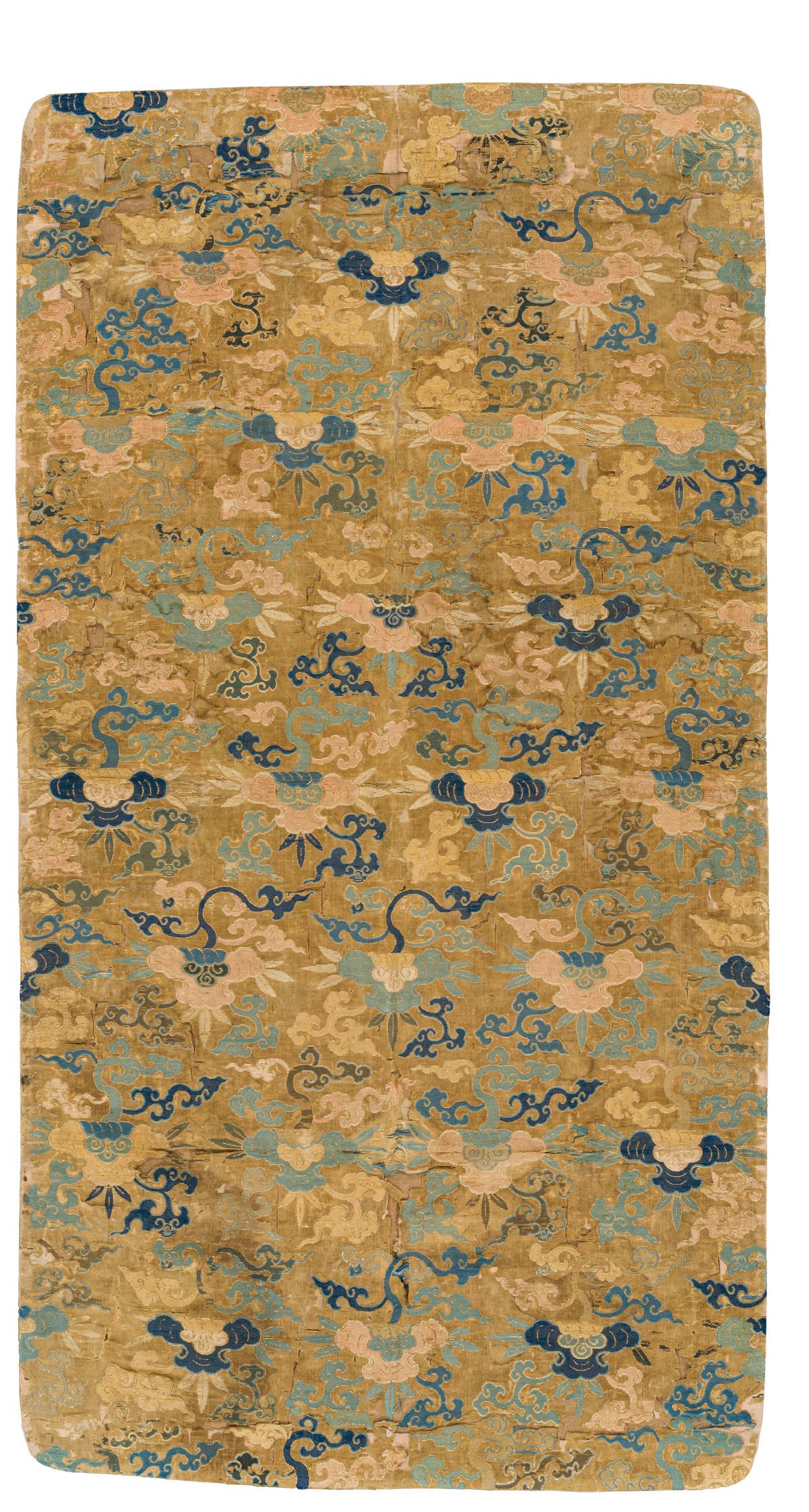

112
A THANGKA OF HAYAGRIVA IN UNION WITH HIS CONSORT VAJRAVARAHI, 18TH-19TH CENTURY
Tibet. Distemper and gold on cloth. Encompassed by flickering flames, the winged central deity striding in alidhasana on prone figures over a lotus base, his primary hands embracing Vajravarahi while holding a vajra and ghanta, the radiating secondary hands clasped around various attributes. Dressed in a tiger-skin loincloth and garland of severed heads, a flayed elephant strewn on his back.
The three-headed wrathful face with a fierce expression, bulging eyes centered by a third eye, furrowed brows, mouths wide open, all crowned by a skull tiara and topped by three horse heads below three bird heads. The nude consort with one arm and leg wrapped around the Heruka, the right hand raised holding a skullcup. The pair is surrounded by diminutive avatars of Heruka centered by three Buddhas below a four-armed deity in yab-yum, all set within a verdant landscape.
Provenance: The Collection of Sam and Myrna Myers, Paris, France. Acquired between circa 1965-2012.
Condition: Good condition with wear, expected rubbing and flaking to pigments, some fading, light soiling, scattered losses, and typical creases and folds.
Dimensions: Image size 77.5 x 53.5 cm, Size incl. frame 94 x 66.5 cm
Literature comparison: Compare a related thangka depicting Yamari Heruka, in the collection of Tibet House, New York and illustrated by Jeff Watt on Himalayan Art Resources, item number 90727.
AUCTION RESULT COMPARISON
Type: Related
Auction: Bonhams London, 11 May 2017, lot 39
Price: GBP 13,750 or approx. EUR 23,500 converted and adjusted for inflation at the time of writing
Description: A thangka of Chemchok Heruka, Tibet, 18th century
Expert remark: Compare the related subject and manner of painting. Note the size (62 x 40.7 cm).
Estimate EUR 3,000
Starting price EUR 1,500


A RARE PORTRAIT OF THE ARHAT DOKSEONG, FORMERLY IN THE GREAT DHARMA HALL AT JINJUSEONG FORTRESS, JOSEON DYNASTY, DATED 1860
Published:
1. Jean-Paul Desroches (ed.) et al, Two Americans in Paris. A Quest for Asian Art, Paris, 2016, p. 121, no. 217.
2. Pointe-à-Callière Museum, Two Americans in Paris. A Quest for Asian Art, Montréal, 2016, exhibition album, p. 35.
Exhibited:
1. Pointe-à-Callière Museum, From the Lands of Asia. The Sam and Myrna Myers Collection, Montréal, 17 November 2016-19 March 2017.
2. Kimbell Art Museum, From the Lands of Asia. The Sam and Myrna Myers Collection, Fort Worth, Texas, 4 March-19 August 2018.
Korea. Ink, watercolors, and gouache on silk. Set inside a frame, behind glass. Finely painted with the solitary arhat sitting at the foot of a hundred-year old pine tree, represented as a sage whose white hair contrasts with the elegant aristocratic attire rendered in blue, red, black, and white, holding a bulja (fly whisk) of long white hair. The lower margin with a colophon inscribed in Chinese.
Inscriptions: The colophon, ‘The 7th day of the 10th year of the reign of Xianfeng (1860), The Great Dharma Hall […] Jinjuseong Fortress, Jinju City (now in South Korea)’.
Provenance: The Great Dharma Hall, Jinjuseong Fortress. Ex-collection Roger Chambard, the first French Ambassador to Korea (1959-1969). The Collection of Sam and Myrna Myers, Paris, France. Acquired between circa 1965-2012.
Condition: Good condition with wear and vibrant colors. Some soiling, few stains, and flaking to pigment. Scattered tears, tiny losses, and creasing.
Dimensions: Image size 86 x 59 cm, Size incl. frame 90.5 x 63 cm
LITERATURE COMPARISON
Compare a closely related painting depicting Dokseong, with a similar colophon to the lower margin, housed in the Unmunsa Temple, Gyeongsangbuk-do, South Korea. Compare a closely related painting of the arhat Pindora Bharadvaja, dated to the 19th century, in the Portland Art Museum, accession number 89.3.1 (fig. 1). Compare a closely related portrait of the Priest Samyeongdang, dated to the Joseon dynasty, late 19th century, in the Los Angeles County Museum of Art, accession number M.2000.15.8. fig. 1
Estimate EUR 2,000
Starting price EUR 1,000


Korea. Ink, watercolors, and gouache on linen. Finely painted to depict a tiger passing by silently then suddenly turning and glaring in the distance, taking a menacing stance. Each strand of the tiger’s fur, which moves in accordance with the body, is depicted through the repetition of fine lines that join together to create a thick pelt. The upper right signed and with two seals.
Provenance: The Collection of Sam and Myrna Myers, Paris, France. Acquired between circa 1965-2012.
Condition: Good condition with wear, creasing, small stains, tiny losses, light browning.
Dimensions: Image size 77 x 30 cm, Size incl. frame 89.5 x 38 cm
Mounted and framed behind glass.
This composition of a tiger emerging from the mountains was first employed by Zhao Miaochuo, a Chinese artist famous for his tiger paintings who lived during the Northern Song period. From the latter half of the Joseon dynasty, such tiger paintings featuring the same composition were produced in large numbers for appreciation.
The Book of Changes includes a passage in which the transformation of the tiger and leopard into magnificent and dignified animals after shedding their hair while hidden in an autumn fog is likened to a man who is completely transformed into a superior man. As such, the tiger emerging from its hideout often represent the man of virtue, or noble man, coming out of seclusion and going out into the world to change it for the better.
Type: Closely related
Auction: Christie’s New York, 16 March 2021, lot 250 Price: USD 62,500 or approx. EUR 64,500 converted and adjusted for inflation at the time of writing
Description: Anonymous (17th-19th century), Tiger and Magpie
Expert remark: Compare the closely related manner of painting and subject with similar posture and menacing facial expression. Note the different size (166.1 x 86 cm).
Estimate EUR 3,000
Starting price EUR 1,500


115
A FINE PAINTING DEPICTING A MOTHER DOG AND TWO PUPPIES, JOSEON DYNASTY, 19TH CENTURY
Korea. Ink, watercolors, and gouache on paper. Mounted on a silk brocade frame and set inside a vintage frame. Finely painted to depict a canine seated on its haunches before its litter of two, one puppy with an identical coat staring at its parent, while its sibling in an ochre coat scratches an itch. The lower left with two seals.
Provenance: The Collection of Sam and Myrna Myers, Paris, France. Acquired between circa 1965-2012.
Condition: Overall good condition with some old wear. Light fading and browning to paper. Scratches and superficial tears, some with associated touchups. Small stains and scattered foxing.
Dimensions: Image size 40 x 47.5 cm, Size incl. frame 62 x 69 cm

Estimate EUR 2,000
Starting price EUR 1,000
LITERATURE COMPARISON
Compare a related painting of a mother dog and puppies, Joseon period, size 163 x 55.5 cm, National Museum of Korea, collection number 본관255. Compare a related painting of a mother dog and puppies by Kim Hong-do (1745-probably 1806), in the Kansong Art Museum, Seoul.
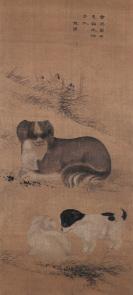




PUBLISHED
1. Jean-Paul Desroches (ed.) et al, Two Americans in Paris. A Quest for Asian Art, Paris, 2016, p. 118, no. 215
2. Pointe-à-Callière Museum, Two Americans in Paris. A Quest for Asian Art, Montréal, 2016, exhibition album, p. 34.

Exhibited:


1. Pointe-à-Callière Museum, From the Lands of Asia. The Sam and Myrna Myers Collection, Montréal, 17 November 2016-19 March 2017.
2. Kimbell Art Museum, From the Lands of Asia. The Sam and Myrna Myers Collection, Fort Worth, Texas, 4 March-19 August 2018.
Korea. Finely cast, the figure seated in dhyanasana, the right hand lowered in bhumisparsha mudra and the left raised above the lap in dhyana mudra, dressed in a close-fitting monastic robe draped over his left shoulder and falling in voluminous, rhythmic folds over his limbs. The serene face with heavy-lidded downcast eyes below gently arched brows centered by an urna, his full lips forming a calm smile, and flanked by elongated earlobes. The hair arranged in tight snailshell curls over the gently domed ushnisha.
Provenance: The Collection of Sam and Myrna Myers, Paris, France. Acquired between circa 1965-2012.
Condition: Good condition, commensurate with age. Old wear, casting irregularities, obvious losses, signs of weathering and erosion, significant corrosion, and expected rubbing to gilt. Verdigris and malachite encrustations.
Alloy Composition and Patina: The four-metal alloy composition (circa 77% copper, 10% zinc, 8.5% tin, 4.5% lead) represents sophisticated 10th-century metallurgy characteristic of both Korean late Silla and early Goryeo periods as well as Yunnan Dali Kingdom casting technologies for Buddhist sculptures in the 10th century. This complex brass-bronze-lead combination demonstrates advanced smelting techniques developed in both regions during this period. Distinct zinc sulfide inclusions with microscopic traces of aluminum and manganese are authentic corrosion products consistent with aged brass alloys, confirming the antiquity of the piece.
Weight: 1,166.1 g
Dimensions: Height 16.4 cm
By the 8th and 9th centuries, the Silla kingdom in Korea stood as one of the most sophisticated Buddhist states in East Asia, sustained by deep religious and artistic ties to Tang China. Pilgrimage routes carried Silla monks to Tang monasteries, while scriptures, ritual manuals, and gilt-bronze icons flowed back across the Yellow Sea, resulting in a shared visual language of devotion. Yet both Silla and Tang would soon enter periods of decline, with the Tang witnessing waves of Buddhist persecution that ruptured long-standing institutional networks.
As power shifted to the Song, the Khitan-led Liao, and the Dali kingdom in Yunnan, Buddhist sculpture and sacred texts continued to circulate across regions, often via itinerant monks and the increasingly widespread use of woodblock printing. These new powers inherited the visual and ritual paradigms of the Tang-Silla era, and gilt-bronze Buddha images retained a remarkably consistent vocabulary. Goryeo, which succeeded Silla in the early to mid-10th century, positioned itself as the rightful heir to Tang Buddhist civilization, dispatching monks to Song China and preserving Buddhist orthodoxy through grand printing projects and temple patronage.
Within this regional matrix, the stylistic affinities among Buddhist bronzes from Silla, Liao, Song, and Dali reflect not imitation but a common adherence to a sacred sculptural idiom that transcended court boundaries and endured across dynastic change.
Compare a gilt bronze figure of Buddha Vairocana, 20.3 cm high, dated to the Tang dynasty, early 8th century, in the Metropolitan Museum of Art, object number 43.24.3 (fig. 1). Compare a gilt bronze figure of Buddha Amitabha, 23 cm high, attributed to the Dali kingdom and dated to the mid-1000s, in the Cleveland Museum of Art, accession number 1942.1082 (fig. 2). Compare a gilt bronze figure of Buddha Vairocana, 24.5 cm high, dated to the Liao dynasty, in the National Museum of Asian Art, Smithsonian Institution, accession number S2006.7 (fig. 3)



LITERATURE COMPARISON
Compare a related but larger and slightly later gilt-bronze figure of Buddha Amitabha, dated to the Goryeo dynasty, in the National Museum of Korea, accession number Deoksu 71.
Estimate EUR 50,000
Starting price EUR 25,000



Exhibited:
1. Pointe-à-Callière Museum, From the Lands of Asia. The Sam and Myrna Myers Collection, Montréal, 17 November 2016-19 March 2017.
2. Kimbell Art Museum, From the Lands of Asia. The Sam and Myrna Myers Collection, Fort Worth, Texas, 4 March-19 August 2018.
Expert’s note:
The serene and contemplative expression of this Buddha head, combined with meticulous attention to detail and craftsmanship, render this not only a significant cultural relic but also a representation of the artistic and spiritual heights attained during the Goryeo dynasty. Its existence today affirms the transcendental beauty and profound devotion that defined Goryeo’s artistic legacy.
Korea, 918-1392. Finely cast with a serene expression, marked by heavy-lidded downcast eyes, gently arched brows, a slender nose, and bow-shaped lips gently pursed to form a calm smile, flanked by large ears with pendulous lobes. The hair arranged in sharp spikes surrounding the tall ushnisha fronted by an oval cudamani.
Provenance: The Collection of Sam and Myrna Myers, Paris, France. Acquired between circa 1965-2012.
Condition: Overall good condition with extensive wear, casting irregularities, obvious losses, small fissures and cracks, signs of weathering, encrustations, remnants of gilt. The bronze with a naturally grown, dark patina.
Weight: 7,599 g
Dimensions: Height 24 cm (excl. stand), 36.5 cm (incl. stand)
The creative accomplishments of the Goryeo Dynasty are exemplified by this bronze head of Buddha, which captures the period’s sophisticated culture and fervent religious devotion. The Goryeo dynasty was distinguished by a strong devotion to Buddhism that pervaded all societal levels, from royalty to commoners. It was noted for its integration and refinement of earlier cultural traditions with a pluralistic approach.
Goryeo’s founder, Taejo Wang Geon (877-943), laid the groundwork for a patronage culture that strongly favored Buddhist art when the dynasty was established. As a result of Wang Geon’s influence as a patron, the arts were later supported by the elites of the Buddhist, aristocratic, and royal classes.
Goryeo artisans, under court patronage, strived to meet high standards, producing superb bronzes such as this Buddha head, which testifies to the era’s artistic and technical finesse. Unlike this large-scale sculpture, Buddhist images were often portable and used for private worship, and made from various materials such as wood, lacquer, clay, stone, and metal. Most surviving examples from the Goryeo period are small bronze votive images and stone carvings due to the fragility of materials like wood and lacquer. This bronze Buddha head is therefore among the rarities that have endured the passage of time.
LITERATURE COMPARISON
The present head was possibly once entirely covered in gilding; compare, for instance, a closely related smaller giltbronze head of Buddha, dated to the 900s and measuring 8.6 cm in height, in the Cleveland Museum of Art (accession no. 1985.190).
AUCTION RESULT COMPARISON
Type: Related
Auction: Sotheby’s Hong Kong, 29 October 2024, lot 628
Price: HKD 960,000 or approx. EUR 106,000 converted and adjusted for inflation at the time of writing
Description: A bronze head of Buddha, early Goryeo dynasty
Expert remark: Compare the related modeling and manner of casting with similar expression. Note the size (34.5 cm).
Estimate EUR 10,000
Starting price EUR 5,000


PUBLISHED
1. Jean-Paul Desroches (ed.) et al, Two Americans in Paris. A Quest for Asian Art, Paris, 2016, p. 120, no. 216.
2. Pointe-àCallière Museum, Two Americans in Paris. A Quest for Asian Art, Montréal, 2016, exhibition album, p. 26.




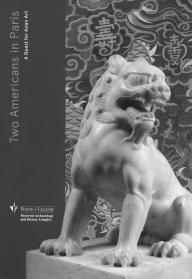



118 A MOTHER-OF-PEARL INLAID LACQUER CHEST, JOSEON DYNASTY
PUBLISHED
Jean-Paul Desroches
(ed.) et al, Two Americans in Paris. A Quest for Asian Art, Paris, 2016, p. 258, no. 406.


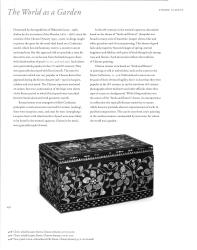
Exhibited:
1. Pointe-à-Callière Museum, From the Lands of Asia. The Sam and Myrna Myers Collection, Montréal, 17 November 2016-19 March 2017.
2. Kimbell Art Museum, From the Lands of Asia. The Sam and Myrna Myers Collection, Fort Worth, Texas, 4 March-19 August 2018.
Korea (1392-1897), circa 17th-18th century. The deep box with shallow flush-fitting cover decorated with scrolling flowers of inlaid mother-of-pearl connected by arching stems of inlaid twisted wire, and additionally applied with brownish black lacquer, the interior lined with brown fabric.
Provenance: The Collection of Sam and Myrna Myers, Paris, France. Acquired between circa 1965-2012.
Condition: Overall good condition, consistent with age, expected age cracks with associated losses, minor losses to inlays and rims, few touchups, and flaking.
Weight: 2,690 g
Dimensions: Size 46 x 26.3 x 24.3 cm
This box demonstrates stylistic variations on the peony scroll, a favorite design on Korean lacquer ware ornamented with shimmering abalone shells, or mother-of-pearl. Here, the large and luscious blooms are accentuated.
AUCTION RESULT COMPARISON
Type: Closely related
Auction: Freeman’s, Philadelphia, 16 March 2018, lot 157
Price: USD 16,900 or approx. EUR 19,000 converted and adjusted for inflation at the time of writing
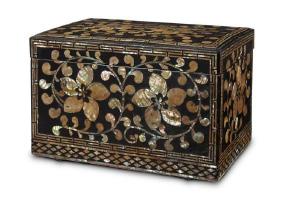
Description: A Korean mother of pearl, tortoiseshell and wire-inlaid rectangular box and cover, Joseon dynasty, 18th century
Expert remark: Compare the closely related form, inlay work, and decoration with similar flowers and lozenge bands. Note the length (33.6 cm)
AUCTION RESULT COMPARISON
Type: Closely related
Auction: Christie’s New York, 15 April 2016, lot 119
Price: USD 17,500 or approx. EUR 20,000 converted and adjusted for inflation at the time of writing
Description: A mother-of-pearl inlaid lacquer box, Joseon dynasty, 19th century
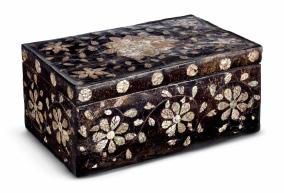
Expert remark: Compare the closely related form, inlay work, decoration, and size (42.5 x 26 x 19.1 cm).
Estimate EUR 3,000
Starting price EUR 1,500

Thailand, early 19th century. Of rectangular form, fitted with a pair of hinged lids, the exterior decorated with fine mother-of-pearl inlay swirling leaf and foliate designs enclosed within geometric bands. Each lid opening to reveal a leather-lined compartment.
Provenance: The Collection of Sam and Myrna Myers, Paris, France. Acquired between circa 1965-2012.
Condition: Overall good condition with extensive wear, traces of use, manufacturing irregularities, light warping, small chips, flaking to leather, and obvious losses to inlays and rims.
Dimensions: Size 27.2 x 15 x 7.5 cm
The workmanship and artistry of this box is of the highest quality, akin to secular objects made for court use in the early Bangkok period. This art form was especially refined in the early to mid-19th century, especially during the reign of Rama III (1824-51). The technique seen here is faultless, the carving of the individual plates of mother-of-pearl is uniformly refined and sophisticated. This workmanship belongs in the finest category of royal workshop production of the early 19th century, the apogee of Thai motherof-pearl production.
LITERATURE COMPARISON
Compare a related palmleaf manuscript storage box, Thailand, dated to the early 19th century, 62.2 cm wide, in the Metropolitan Museum of Art, object number 2017.379.
Estimate EUR 2,000
Starting price EUR 1,000


South India. Of square form, carved in four pieces, separated by a wide diagonal which separates the panel in two, each resulting triangle richly carved in deep relief with the half-bird half-human kinnara and kinnari. The female musician with a veena in her hands, while her companion clasps a shehnai, pressing the reed between his lips. The figures are dressed in minutely carved garments with feather details and adorned with ornate jewelry.
Provenance: The Collection of Sam and Myrna Myers, Paris, France. Acquired between circa 1965-2012.
Condition: Very good condition with wear and natural imperfections including age cracks and fissures. Scattered small losses around the edges, minor chips, expected signs of weathering, the wood with a rich, naturally grown, dark patina.
Dimensions: Size 87.5 x 87.5 cm
This fine panel, likely carved from Jackfruit Wood (Artocarpus heterophyllus) exemplifies the ornate ceiling tiles once embedded in the namaskara-mandapam, the ritual pavilion of Kerala temples, where coffered wooden ceilings serve as both structural marvels and sacred storytelling devices. Similar ceiling panels can be found in temples across Kerala,
where each square frames deities, animals, and cosmic narratives in sculptural relief. These ceilings not only honor the divine but also reflect Kerala’s ingenious wooden architectural tradition, whose timber construction, perfectly adapted to the region’s monsoon climate, predates and profoundly influences the later evolution of stone temple forms.
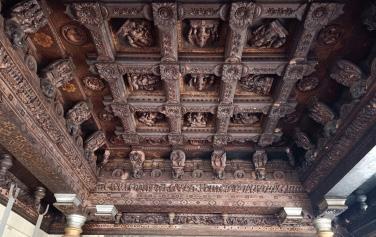
Kerala
Jackfruit wood was among the most favored for temple sculpture in Kerala during the 18th century, because it is fine-grained, easy to carve, and becomes darker and more beautiful with age. Also, it is naturally resistant to pests and rot.
Literature compariso: Compare a closely related wood and granite panel depicting a Kinnari playing a stringed instrument, dated 16th century, in the Sri Mahadeva Temple complex in Vaikom, Kerala, and illustrated in the Virtual Museum of Images & Sounds, accession number 103406. Compare a related wood architectural element, dated 16th-18th century, in the Sri Vishnu temple in Pullur, Kerala, and illustrated in the Virtual Museum of Images & Sounds, accession number 102838.
Estimate EUR 4,000
Starting price EUR 2,000
South India. Of square form, carved in four pieces, separated by a wide diagonal which separates the panel in two, each resulting triangle richly carved in deep relief with the half-bird half-human kinnara and kinnari. The female musician with a veena in her hands, while her companion clasps a shehnai, pressing the reed between his lips. The figures are dressed in minutely carved garments with feather details and adorned with ornate jewelry.
Provenance: The Collection of Sam and Myrna Myers, Paris, France.
Acquired between circa 1965-2012.
Condition: Good condition with wear and natural imperfections including age cracks and fissures. Scattered small losses around the edges, minor chips, expected signs of weathering, minor water damage to one edge, the wood with a rich, naturally grown, dark patina.
Dimensions: Size 87.5 x 87.5 cm
Kinnara and Kinnari are half-human-half-bird mythical creatures and constitute the celestial choir and attendants to the gods. They are often portrayed in Hindu and Buddhist sculptures and paintings. Kinnaris and Kinnaras are portrayed happy, singing and playing musical instruments.
LITERATURE COMPARISON
Compare a closely related wood ceiling element, dated 19th century, from a temple in Kochi, Kerala, now in the Victoria and Albert Museum, accession number IS.2564:1-1883.
Estimate EUR 4,000
Starting price EUR 2,000
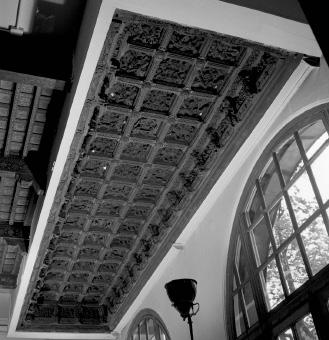
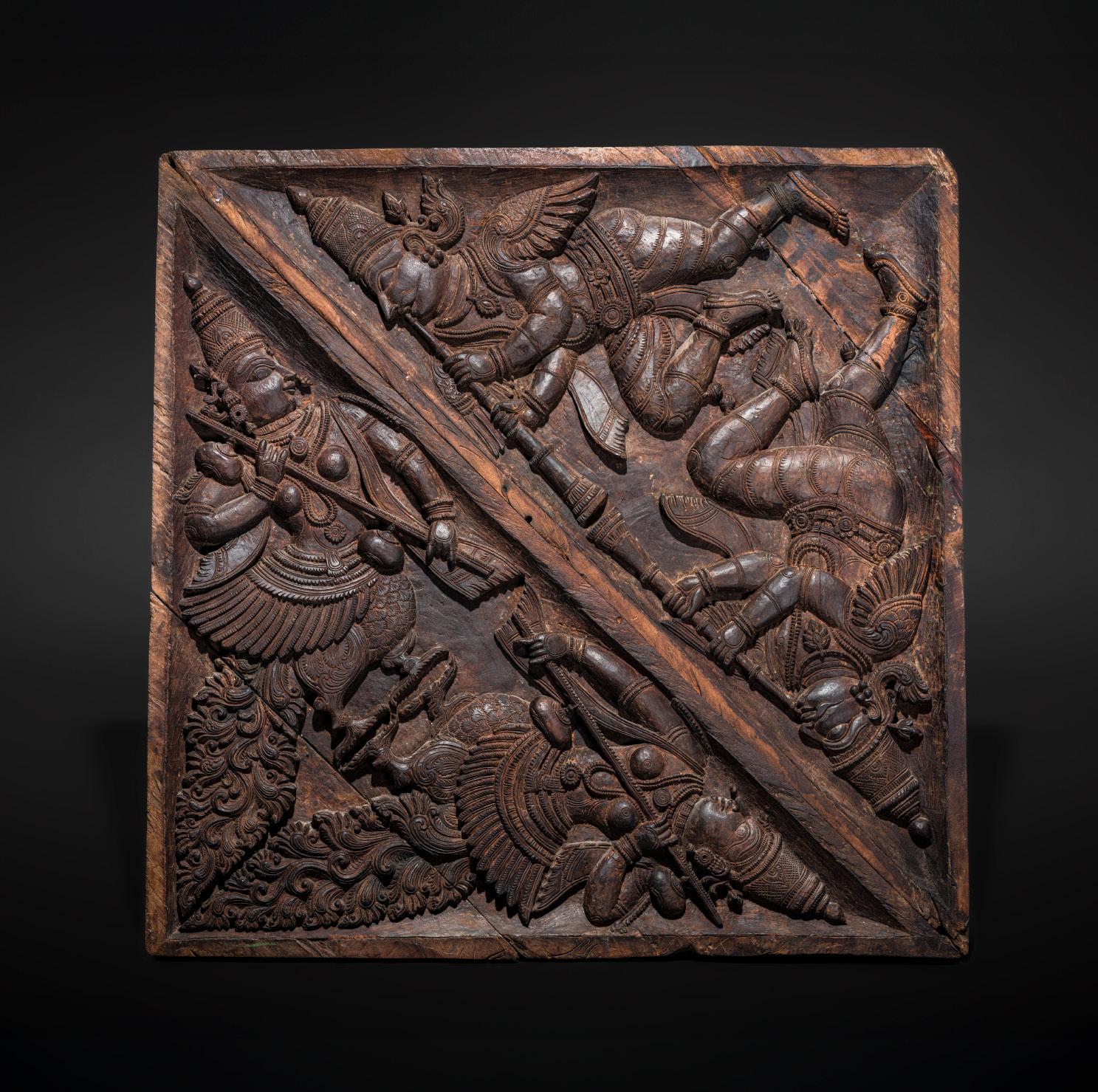
Exhibited:
1. Pointe-à-Callière Museum, From the Lands of Asia. The Sam and Myrna Myers Collection, Montréal, 17 November 2016-19 March 2017.
2. Kimbell Art Museum, From the Lands of Asia. The Sam and Myrna Myers Collection, Fort Worth, Texas, 4 March-19 August 2018.

PUBLISHED
Jean-Paul Desroches (ed.) et al, Two Americans in Paris. A Quest for Asian Art, Paris, 2016, p. 167, no. 279 (part-lot).



Western India, c. 1680-1700. Finely carved, the young Virgin Mary stands beside her mother, Saint Anne, who is seated atop a tall throne raised on a foliate pedestal, holding an open book as her mother guides her reading. Both figures dressed in neatly incised robes which pool gently to their feet as they huddle close to each other affectionately, their faces with neatly carved features.
Provenance: The Collection of Sam and Myrna Myers, Paris, France. Acquired between circa 1965-2012.
Condition: Very good condition with wear and natural imperfections including age cracks and fissures. Manufacturing irregularities, minute nicks and small surface scratches, and minor nibbling and tiny losses along the edges mostly to the base. The ivory with a rich, naturally grown, honey-amber patina.
Weight: 257.9 g
Dimensions: Height 14.6 cm
Saint Anne’s teaching of her daughter is described in The Golden Legend, a collection of popular stories about the saints. See a folio from an illuminated manuscript painted with the same subject, Master of Sir John Fastolf, about 1430-1440, in the J. Paul Getty Museum, object number 84.ML.723.45v.
Goa came under Portuguese rule in 1510, and subsequently became an eastern trading capital of the Portuguese empire and the seat of Christian imperialism, whose influence stretched from the Cape of Good Hope to the Sea of Japan. The Portuguese found a well-established infrastructure for ivory carving, with experienced artists and workshops. This explains the resulting hybrid of sculptures drawing from European iconography and traditional Indian stylistic conventions.
LITERATURE COMPARISON
Compare a related ivory carving of St. Anne teaching the Virgin to read, Goa, circa 1700, in the Victoria & Albert Museum, accession number A.34-1940.

AUCTION RESULT COMPARISON
Type: Closely related
Auction: Christie’s New York, 19 September 2002, lot 71
Price: USD 6,572 or approx. EUR 10,000 converted and adjusted for inflation at the time of writing
Description: An ivory group of St Anne and the Virgin Mary, India, Goa, 18th century Expert remark: Compare the closely related modeling, manner of carving, and subject, with similar facial expression, garments, throne, and size (17.1 cm).
Estimate EUR 3,000
Starting price EUR 1,500

PUBLISHED
Jean-Paul Desroches (ed.) et al, Two Americans in Paris. A Quest for Asian Art, Paris, 2016, p. 167, no. 279 (part-lot).
Exhibited:



1. Pointe-à-Callière Museum, From the Lands of Asia. The Sam and Myrna Myers Collection, Montréal, 17 November 2016-19 March 2017.
2. Kimbell Art Museum, From the Lands of Asia. The Sam and Myrna Myers Collection, Fort Worth, Texas, 4 March-19 August 2018.
Western India, c. 1680-1700. The virgin stands atop a crescent moon raised on a pedestal decorated with stylized florets in relief, encircled by a band of petals, wearing heavy outer and inner robes and a cape draped in naturalistic folds, with her hands clasped together. Her face is exquisitely carved with almond-shaped eyes, fleshy cheeks, and full lips.
Provenance: The Collection of Sam and Myrna Myers, Paris, France. Acquired between circa 1965-2012.
Condition: Good condition with wear and natural imperfections including age cracks and fissures. Manufacturing irregularities, scattered surface scratches, small losses and nibbling along the edges and interior of the cloak, the right hand reattached, remnants of gilt. The ivory with a rich, naturally grown, honey-amber patina.
Weight: 386 g
Dimensions: Height 19.2 cm
Devotional statuettes carved in ivory celebrating the Virgin Mary were popular in Europe during the 1600s, and this taste spread to the colonies established by Catholic countries in Asia and the Americas. The three most important locations for production of these ivories were the Portuguese colonies in Goa, where this piece was made, the island of Sri Lanka, and the Spanish colony of the Philippines.
The Virgin Mary was often standing on the crescent moon, triumphant over a dragon, both symbols derived from the Book of the Apocalypse in the New Testament. From the sixteenth century onwards, the four main missionary Orders, the Augustinians, Jesuits, Dominicans and Franciscans, built churches and aimed to convert the inhabitants of India. The ivories would assist in the presentation of Christian imagery, as well as being exported back to churches, convents and private collectors in Europe.
Type: Closely related
Auction: Christie’s London, 2 October 2013, lot 369
Price: GBP 3,125 or approx. EUR 5,800 converted and adjusted for inflation at the time of writing
Description: A carved ivory figure of the Virgin Mary on a crescent moon, late 17th or early 18th century
Expert remark: Compare the closely related modeling and manner of carving with similar pose, face, hair, robes, and crescent moon. Note the size (23.2 cm).
Estimate EUR 3,000
Starting price EUR 1,500



AN INDO-PORTUGUESE IVORY
FIGURE OF THE INFANT CHRIST, GOA, SECOND HALF OF THE 17TH CENTURY
PUBLISHED
Jean-Paul Desroches (ed.) et al, Two Americans in Paris. A Quest for Asian Art, Paris, 2016, p. 167, no. 279 (part-lot).
Exhibited:

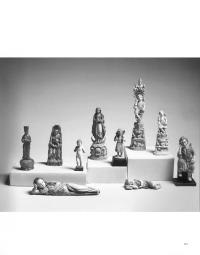

1. Pointe-à-Callière Museum, From the Lands of Asia. The Sam and Myrna Myers Collection, Montréal, 17 November 2016-19 March 2017.
2. Kimbell Art Museum, From the Lands of Asia. The Sam and Myrna Myers Collection, Fort Worth, Texas, 4 March-19 August 2018.
Western India. Standing nude on a cushioned pedestal with a slight bend in his knees, the deity’s cherubic face with round cheeks, big eyes and small mouth painted red, delicately framed by the richly carved wavy hair.
Provenance: The Collection of Sam and Myrna Myers, Paris, France. Acquired between circa 1965-2012.
Condition: Overall good condition with wear and natural imperfections including age cracks and fissures, obvious losses to arms, feet, and base, the latter with an old gilt-lacquered wood replacement with wear and flaking, remnants of pigment to the base and gilt to the hair.
Weight: 46.5 g
Dimensions: Height 10.6 cm
Literature comparison: Compare a related figure of the Christ Child, 14.5 cm high, dated c. 1650, in the Victoria and Albert Museum, accession number A.63-1927, where the authors note “[i]t was formerly thought to be Portuguese and then re-assigned to Goa. Comparisons with similar figures suggest it is in fact from Sri Lanka.”
AUCTION RESULT COMPARISON
Type: Closely related
Auction: Christie’s New York, 17 September 1999, lot 51
Price: USD 13,800 or approx. EUR 23,000 converted and adjusted for inflation at the time of writing
Description: An ivory figure of the Christ Child, India, Goa, 17th-18th century
Expert remark: Compare the closely related modeling and manner of carving with similar features, cold gilding to the hair, and body with fleshy folds. Note the larger size (29.3 cm).
Estimate EUR 3,000
Starting price EUR 1,500

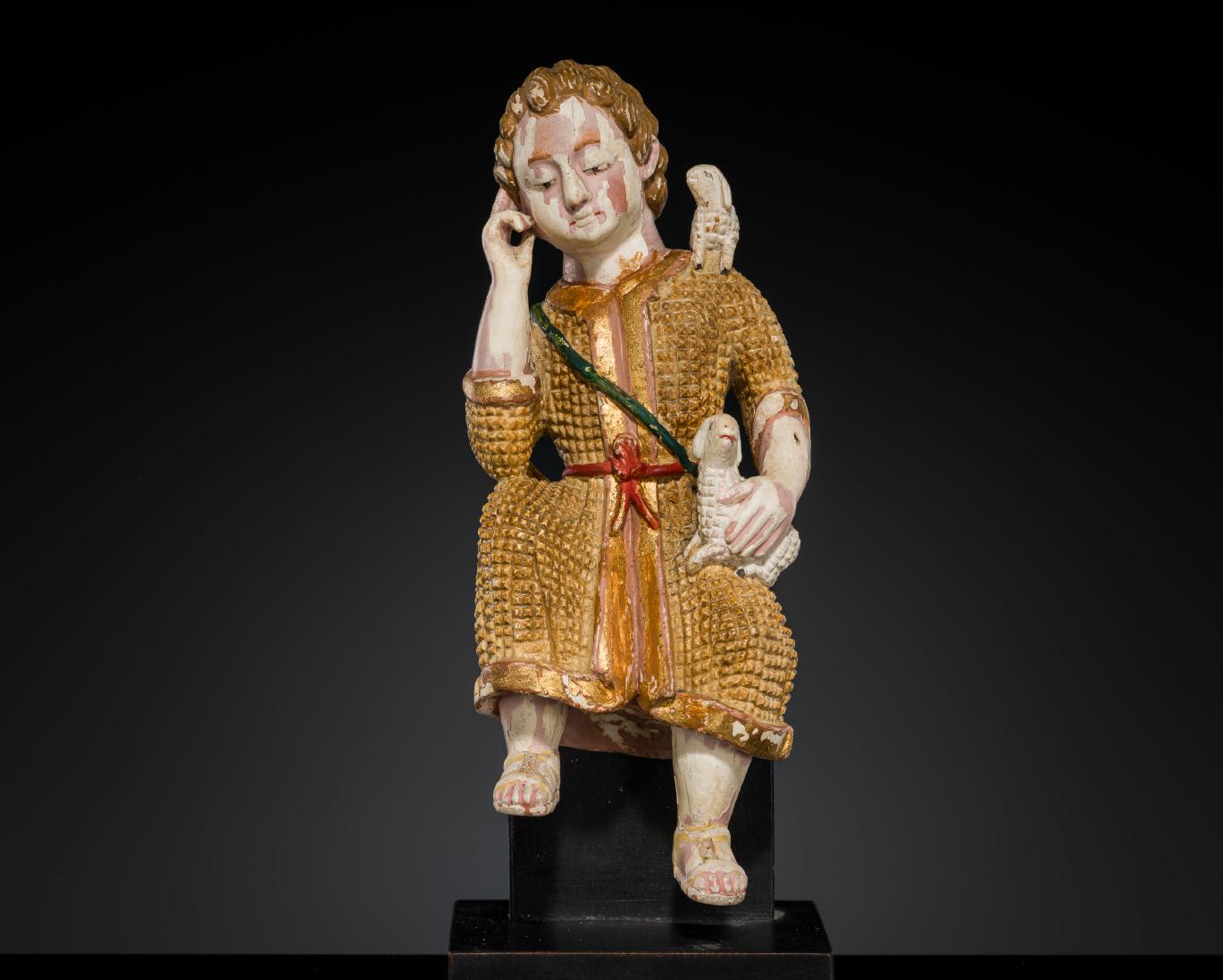
125 AN INDO-PORTUGUESE GILT AND POLYCHROME IVORY FIGURE OF CHRIST AS THE GOOD SHEPHERD, GOA, 17TH CENTURY
Exhibited:
1. Pointe-à-Callière Museum, From the Lands of Asia. The Sam and Myrna Myers Collection, Montréal, 17 November 2016-19 March 2017.
2. Kimbell Art Museum, From the Lands of Asia. The Sam and Myrna Myers Collection, Fort Worth, Texas, 4 March-19 August 2018.
Western India. Very finely carved seated with crossed legs and resting his head upon his hand while balancing a sheep on his lap and left shoulder, wearing a patterned wool tunic tied around the waist with a knotted belt suspending a gourd of water, a saddlebag strewn across his body, and his face gently modeled in a downcast gaze framed by strands of curls.
Provenance: The Collection of Sam and Myrna Myers, Paris, France. Acquired between circa 1965-2012.
Condition: Very good condition with wear and natural imperfections. Flaking and expected losses to gilt and pigment.
Weight: 339.6 g (incl. stand)
Dimensions: Height 15.5 cm (excl. stand), 17.1 cm (incl. stand)
Mounted on an associated wood stand. (2)
The representation in ivory of Christ the Good Shepherd is an iconography that is unique to Goa. While the exact date of these carvings is not known, most published examples are attributed to the seventeenth century or possibly earlier.
The depiction of Christ as a contemplative figure is noteworthy and may have been borrowed by the Jesuit missionaries from Buddhist images of pensive bodhisattvas and Maitreya, the Buddha of the Future. Christ’s eyes are closed. The gesture of his right hand, lightly touching his hair with two fingers, is seen by some scholars as adopting a gesture of the Buddha. Influences may also have been exerted by the popular Indian concepts of Krishna as the child god and divine cowherd. The Portuguese Christians thus could have deliberately selected a theme familiar to the Indians.
PUBLISHED
1. Jean-Paul Desroches (ed.) et al, Two Americans in Paris. A Quest for Asian Art, Paris, 2016, p. 167, no. 279.
2. Pointe-à-Callière Museum, Two Americans in Paris. A Quest for Asian Art, Montréal, 2016, exhibition album, p. 15.


AUCTION RESULT COMPARISON
Type: Closely related
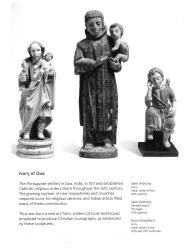
Auction: Christie’s Amsterdam, 5 April 2007, lot 38
Price: EUR 19,200 or approx. EUR 29,500 adjusted for inflation at the time of writing
Description: A polychrome decorated ivory group of Christ as the good shepherd, Goa, 17th18th century
Expert remark: Compare the closely related modeling, manner of carving, and subject with similar pensive pose, expression, garments, and coddling sheep. Note the separately carved base and overall height (27.2 cm), this figure and the current lot being of similar size.
Estimate EUR 4,000
Starting price EUR 2,000
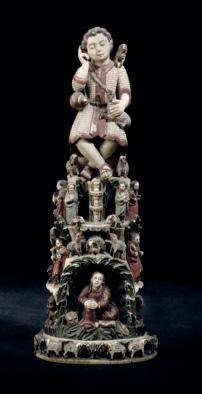

A CYPRESS WOOD FIGURE OF AMIDA NYORAI, KAMAKURA PERIOD, 13TH-14TH CENTURY



PUBLISHED
Jean-Paul Desroches (ed.) et al, Two Americans in Paris: A Quest for Asian Art, Paris, 2016, p. 122, no. 219.
Exhibited:
1. Pointe-à-Callière Museum, From the Lands of Asia. The Sam and Myrna Myers Collection, Montréal, 17 November 2016-19 March 2017.
2. Kimbell Art Museum, From the Lands of Asia. The Sam and Myrna Myers Collection, Fort Worth, Texas, 4 March-19 August 2018.
Japan. Finely carved from a hollowed section of hinoki (cypress) wood in yosegi-zukuri in a classic Heian standing pose with his right arm raised and left arm lowered in what was likely raigo-in (vitarka mudra). Amida is wearing monastic robes, his fukuken’e descending from the shoulders and forming a series of folds over the abdomen, the kun with typical Y-shaped and vertical pleats. The soft features of his face bearing a serene expression, heavy-lidded downcast eyes centered by a crystal inlay, subtly smiling lips, elongated lobes, and hair arranged in spiral curls.
Provenance: The Collection of Sam and Myrna Myers, Paris, France. Acquired between circa 1965-2012.
Condition: Extensive wear commensurate with age, the wood with natural imperfections, expected age cracks, losses, remnants of old repairs and resin residue, the hands and feet lost.
Weight: 531.9 g (incl. stand)
Dimensions: Height 32.5 cm (excl. stand), 37 cm (incl. stand)
Mounted on an associated wood stand. (2)
The present figure has characteristics of both Heian and early Kamakura sculptures. Yosegi-zukuri was a technique adopted in Japan from Indian and Chinese artists and became popular during the 10th century. The elegant folds of the robes and the inlaid urna come from techniques which became widely used during the Kamakura period. The combination of these two elements suggests a dating to a period of overlap between the two periods.
Yosegi-zukuri, or the joined wood-block construction, is a sculpting method in which several rectangular blocks of wood are individually selected and carved into shapes.
AUCTION RESULT COMPARISON
Type: Closely related
Auction: Christie’s New York, 21 March 2023, lot 5
Price: USD 30,240 or approx. EUR 27,500 converted and adjusted for inflation at the time of writing
Description: A carved wood sculpture of Amida Nyorai (Amitabha), Kamakura period, 13th century
Expert remark: Compare the closely related form and similar modeling, expression, and size (34 cm).
Estimate EUR 4,000
Starting price EUR 2,000


127
A GILT AND POLYCHROME-WOOD TEMPLE STATUE OF A HEAVENLY GENERAL, JUNI SHINSHO, KAMAKURA PERIOD
Exhibited:
1. Pointe-à-Callière Museum, From the Lands of Asia. The Sam and Myrna Myers Collection, Montréal, 17 November 2016-19 March 2017.
2. Kimbell Art Museum, From the Lands of Asia. The Sam and Myrna Myers Collection, Fort Worth, Texas, 4 March-19 August 2018.
Japan, 13th-14th century. Finely carved and elaborately painted in polychrome pigments, the heavenly general balancing on one foot, holding his right hand up, clutched in a fist, wearing a tiger’s skin, heavy-plated armor with elaborate detailing and foliate and wan designs. His red face bearing a fierce expression, his mouth open, his wild bloodshot eyes painted with gilt behind transparent rock crystal, his hair flowing behind his metal halo.
Provenance: The Collection of Sam and Myrna Myers, Paris, France. Acquired between circa 1965-2012.
Condition: Good condition with wear and natural imperfection including age cracks and fissures. Nicks, scratches, flaking and rubbing to pigment, chips and small losses, and signs of weathering and erosion. Small repairs with associated touchups. The attribute previously held in the right hand is lost.
Weight: 2,887 g
Dimensions: Height 55 cm (excl. stand), 59.5 cm (incl. stand)
PUBLISHED
Jean-Paul Desroches (ed.) et al, Two Americans in Paris: A Quest for Asian Art, Paris, 2016, p. 248, no. 386.



AUCTION RESULT COMPARISON
Type: Closely related
Auction: Bonhams New York, 11 September 2019, lot 567
Price: USD 15,075 or approx. EUR 16,000 converted and adjusted for inflation at the time of writing
Description: A wood figure of one of the juni Shinsho (12 Divine Generals), Kamakura period, 13th14th century
Expert remark: Compare the closely related carving and similar attire, expression, dynamic stance, and size (55 cm).
Estimate EUR 4,000
Starting price EUR 2,000



128
A GILT AND POLYCHROME-WOOD FIGURE OF A GUARDIAN KING, KAMAKURA PERIOD
Exhibited:
1. Pointe-à-Callière Museum, From the Lands of Asia. The Sam and Myrna Myers Collection, Montréal, 17 November 2016-19 March 2017.
2. Kimbell Art Museum, From the Lands of Asia. The Sam and Myrna Myers Collection, Fort Worth, Texas, 4 March-19 August 2018.
Japan, 1185-1333. Finely carved seated with the right leg extended, the left bent at the knee with his clasped hands pressed sharply against it. His forceful expression matches the defiant energy of his pose, heightened by the drapery extending off the wrist and down from the shoulder. The surface of the sculpture is decorated with polychrome lacquer and gilt.
The face modeled with a fierce expression, bulging eyes under furrowed brows, and a grim smile framed by scrolling moustache and goatee. The hair twisted away from the face into a looped chignon to the top and partially covered by a shroud.
Provenance: The Collection of Sam and Myrna Myers, Paris, France.
Acquired between circa 1965-2012.
Condition: Good condition, commensurate with age. Extensive wear, natural imperfections, expected flaking and rubbing to gilt and lacquer, small chips, minor losses, and signs of weathering. Old repairs with associated touchups.
Weight: 3,647 g (incl. stand)
Dimensions: Height 42 cm (excl. stand), Length 33.5 cm (excl. stand)
Mounted on an associate lacquered wood stand. (2)
PUBLISHED
1. Jean-Paul Desroches (ed.) et al, Two Americans in Paris: A Quest for Asian Art, Paris, 2016, p. 124, no. 222.
2. Pointe-à-Callière Museum, Two Americans in Paris. A Quest for Asian Art, Montréal, 2016, exhibition album, p. 36.


AUCTION RESULT COMPARISON
Type: Related

Auction: Christie’s New York, 20 March 2014, lot 1619
Price: USD 81,250 or approx. EUR 93,500 converted and adjusted for inflation at the time of writing
Description: A polychrome-wood figure of Jikokuten, Japan, Kamakura period, 14th century
Expert remark: Compare the related carving and similar remnants of polychrome pigment and gilt. Note the larger size (115 cm).
Estimate EUR 8,000
Starting price EUR 4,000
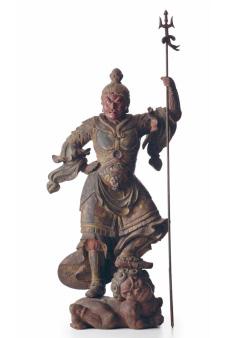

129
A LACQUERED GILT-WOOD GYODO MASK OF A BODHISATTVA, GYODOMEN BOSATSU, MUROMACHI TO MOMOYAMA PERIOD
Exhibited:
1. Pointe-à-Callière Museum, From the Lands of Asia. The Sam and Myrna Myers Collection, Montréal, 17 November 2016-19 March 2017.
2. Kimbell Art Museum, From the Lands of Asia. The Sam and Myrna Myers Collection, Fort Worth, Texas, 4 March-19 August 2018.
Japan, 15th-16th century. The rounded face of the bodhisattva with a serene expression, marked by gently arched brows above heavy-lidded downcast eyes, centered by a raised urna, flanked by long pendulous earlobes, the parted hair crowned by a tiara.
Provenance: The Collection of Sam and Myrna Myers, Paris, France. Acquired between circa 1965-2012.
Condition: Very good condition with old wear and manufacturing irregularities. Minor expected age cracks, few scratches, small losses, some flaking, and typical wear to the gilding. The back with minor remnants of pigment.
Weight: 874.4 g
Dimensions: Height 24 cm
Gyodo is a Japanese Buddhist ceremony where the procession is purely religious. Gyodo masks are the earliest known masks in Japan and were not worn by actors but by priests. As with Gigaku and Bugaku masks, the Gyodo masks were never signed but rather inscribed with the name of the mask, out of respect for the ceremony and for the sculptors of the original masks. During Gyodo ceremonies priests wearing masks enact the part of Amida Buddha (Sanskrit: Amitabha) and his disciples, welcoming the soul of dying believers into Paradise. The priests also carry a statue or Buddhist relics in a carriage or palanquin in a procession. Bodhisattva masks are particularly
PUBLISHED
Jean-Paul Desroches (ed.) et al, Two Americans in Paris: A Quest for Asian Art, Paris, 2016, p. 130, no. 227.



associated with the Raigo form of the Gyodo ceremony, in which the dead are welcomed into Paradise by the Amida Buddha.
LITERATURE COMPARISON
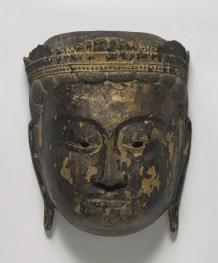
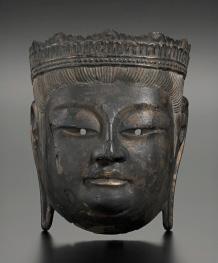
Compare a closely related Buddhist processional mask of a Bodhisattva, Muromachi Period, 15th century, 25.4 cm high, in the Brooklyn Museum, accession number 85.281.6. Compare a related earlier lacquer and gold paint on wood mask of a Bodhisattva, Kamakura period, 23.5 cm high, in the National Gallery of Victoria, Melbourne, accession number 1535-D4.
Estimate EUR 3,000
Starting price EUR 1,500
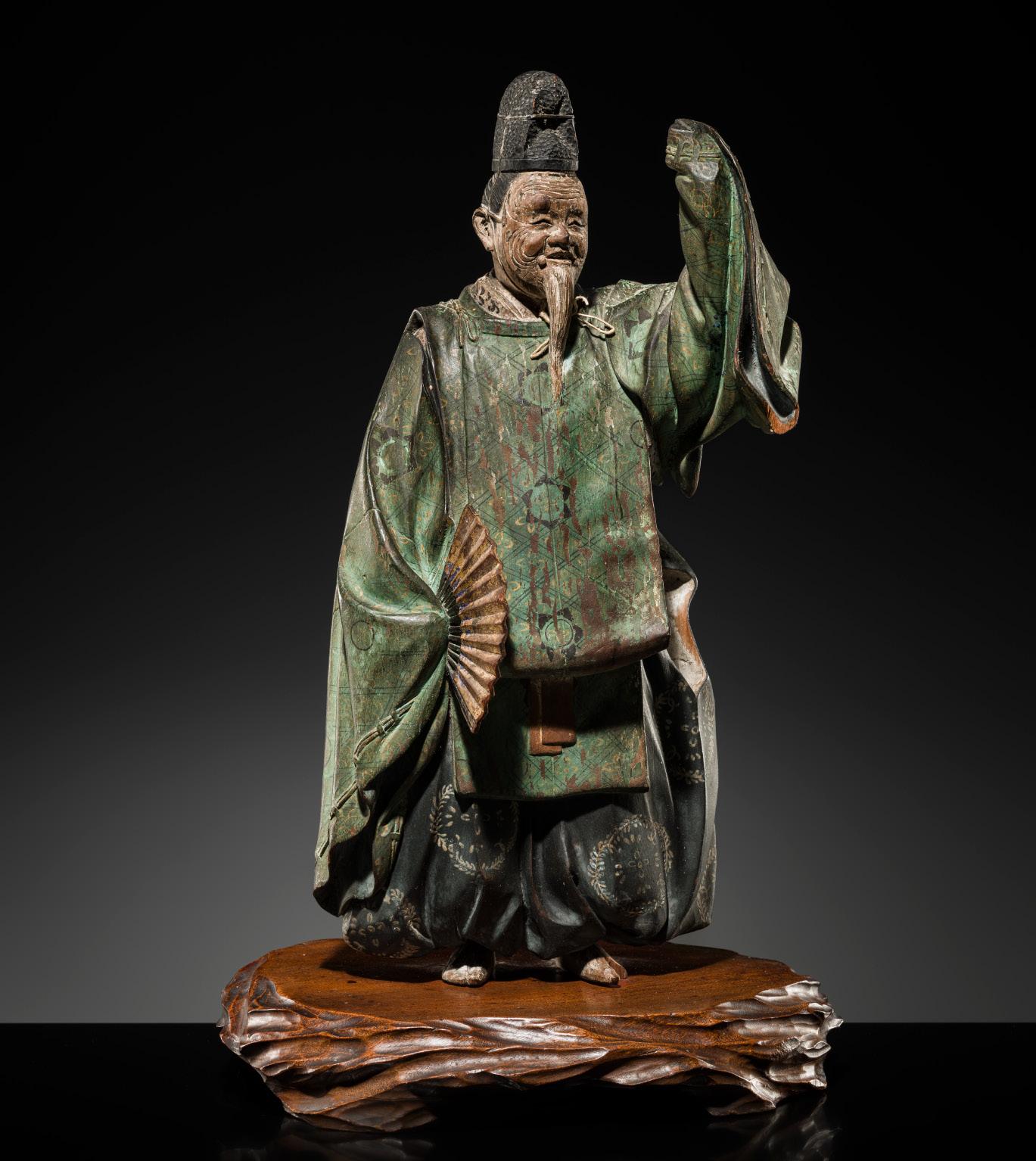
130
A POLYCHROME WOOD FIGURE OF A NOH ACTOR IN THE ROLE OF OKINA, MOMOYAMA PERIOD
Exhibited:
1. Pointe-à-Callière Museum, From the Lands of Asia. The Sam and Myrna Myers Collection, Montréal, 17 November 2016-19 March 2017.
2. Kimbell Art Museum, From the Lands of Asia. The Sam and Myrna Myers Collection, Fort Worth, Texas, 4 March-19 August 2018. Japan, 1573-1603. Standing with his left arm raised enveloped within voluminous sleeves, the actor wearing a removable Noh mask of Okina, and holding a folding fan in his lowered right hand. He is dressed in a vibrant green and turquoise checkered costume, painted to the pants with foliate wreaths, the textured eboshi (hat) of ebony tone, all raised above a stump-form stand.
Provenance: The Collection of Sam and Myrna Myers, Paris, France. Acquired between circa 1965-2012. Condition: Good condition with old wear and natural imperfections including age cracks and fissures. Small chips, few losses, nicks, flaking and rubbing to pigment, and signs of weathering.



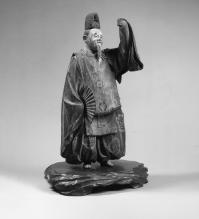
Weight: 2,633 g (incl. stand)
Dimensions: Height 38 cm (excl. stand), 42.5 cm (incl. stand)
Estimate EUR 4,000
Starting price EUR 2,000

131
A PAIR OF POLYCHROME WOOD FIGURES OF KOMA-INU, KAMAKURA PERIOD
Japan, 14th century. Finely carved to depict a pair of koma-inu (literally Korean dog), one shown with a single horn and with the mouth closed, uttering the syllable ‘un’, the other snarling with its mouth opened, uttering the syllable ‘a’. The separately carved tails are formed by finely crafted curls which appear like flames. (2)
Provenance: The Collection of Sam and Myrna Myers, Paris, France. Acquired between circa 1965-2012.
Condition: Overall good condition with extensive wear and natural imperfections including age cracks and fissures. Obvious losses, flaking to pigments, chips, weathering and erosion, encrustations, and splinters.
Dimensions: Height 39 cm and 32.5 cm
Koma-inu, literally “Korean dogs”, are lion-like guardian statues commonly placed in pairs at shrine and temple entrances to ward off evil. Believed to have arrived in Japan from China via Korea, their name derives from Koma, the Japanese word for the ancient Korean kingdom of Koguryo.
Stone and bronze lions began appearing as temple decorations during the Nara period (710–794), part of a sculptural lineage rooted in Indian and Chinese Buddhist art. Lions often flank images of the seated Buddha, symbolizing both protection and regal presence. By the early Heian period (9th century), the two statues were distinct: the right-hand figure, komainu, looked dog-like, with an open mouth (agyou) and sometimes a small horn; the left, shishi, was lion-like with a closed mouth (ungyou). Over time, both came to be called komainu, differing only in their open or closed mouths—a pairing known as a-un.
AUCTION RESULT COMPARISON
Type: Related
Auction: Christie’s New York, 27 March 2011, lot 841
Price: USD 37,500 or approx. EUR 46,400 converted and adjusted for inflation at the time of writing
Description: A pair of carved wood guardian dogs (koma inu), Kamakura period (13th-14th century)

Expert remark: Compare the closely related modeling and similar stance and expression, and size (34.2 – 35.5 cm).
Estimate EUR 3,000
Starting price EUR 1,500
PUBLISHED
Jean-Paul Desroches (ed.) et al, Two Americans in Paris: A Quest for Asian Art, Paris, 2016, p. 134135, no. 231 (described as “the life of Shotoku”).
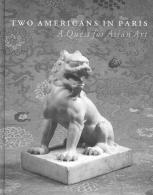
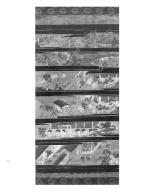
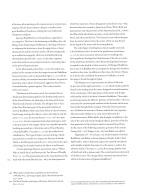
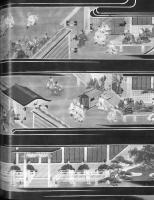

Exhibited:
1. Pointe-à-Callière Museum, From the Lands of Asia. The Sam and Myrna Myers Collection, Montréal, 17 November 2016-19 March 2017.
2. Kimbell Art Museum, From the Lands of Asia. The Sam and Myrna Myers Collection, Fort Worth, Texas, 4 March-19 August 2018.
Japan, late 16th- early 17th century. Ink, watercolors, gouache, and gold paint on silk. Mounted on a silk brocade frame and set inside a frame, behind glass. Finely painted with scenes from the life of Shinran Shonin, each panel separated by clouds.
Provenance: The Collection of Sam and Myrna Myers, Paris, France. Acquired between circa 1965-2012.
Condition: Very good condition with minor wear. Light fading, minuscule flaking, and minor creasing. Some foxing and scattered soiling. The frame with wear and signs of use.
Dimensions: Image size 134 x 77 cm, Size incl. frame 170 x 84 cm

AUCTION RESULT COMPARISON
Type: Related
Auction: Christie’s New York, 15 September 2010, lot 533
Price: USD 60,000 or approx. EUR 75,000 converted and adjusted for inflation at the time of writing
Description: Anonymous, 17th century, Life of monk Shinran
Expert remark: Compare the closely related iconography. Note the size (132.7 x 77.5 cm) and that the lot is a complete set. For the nearidentical image see the second painting from the left.
Estimate EUR 4,000
Starting price EUR 2,000

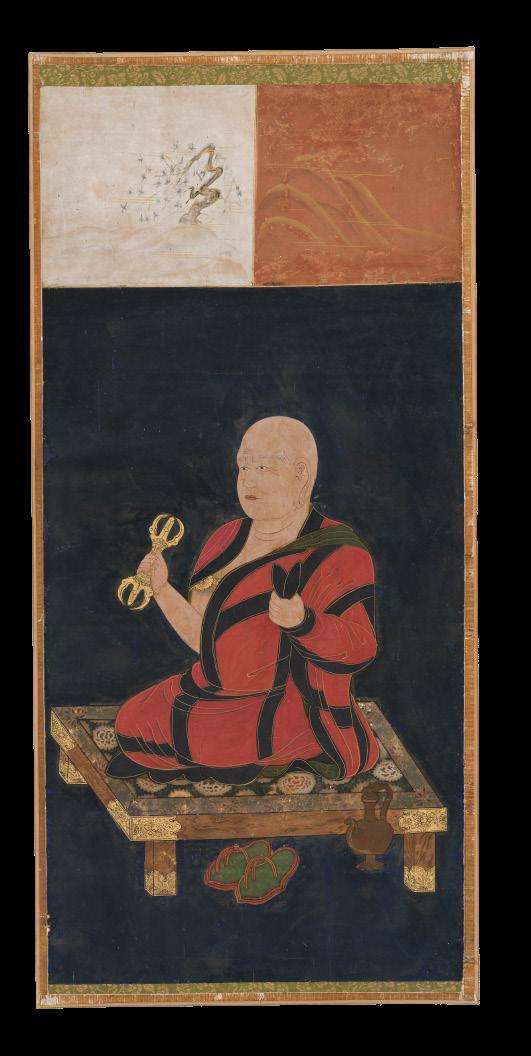
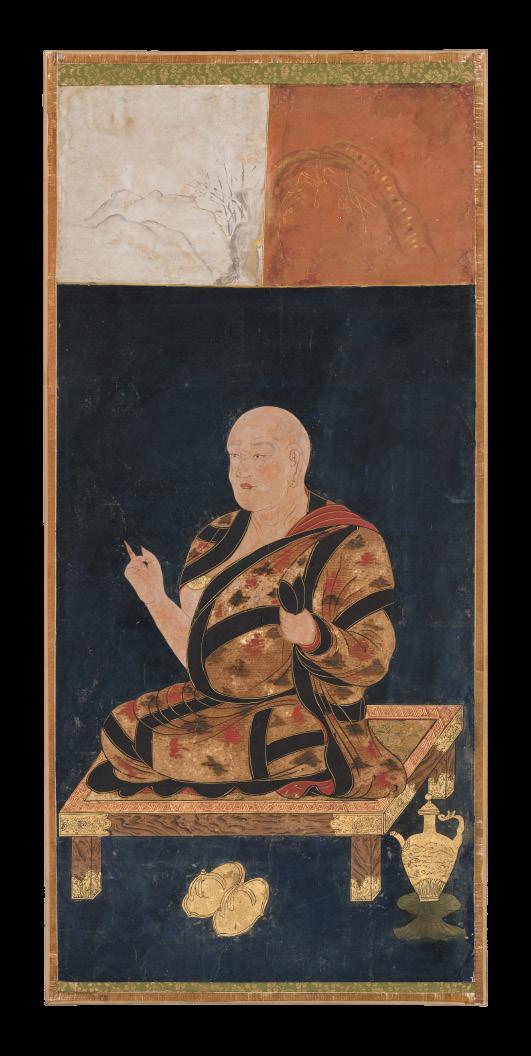



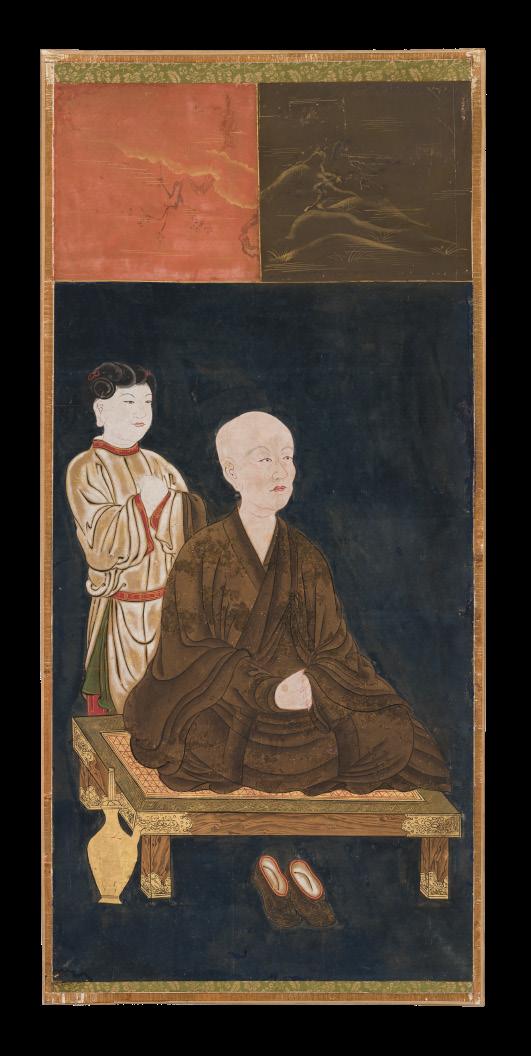


133




PUBLISHED
Jean-Paul Desroches (ed.) et al, Two Americans in Paris: A Quest for Asian Art, Paris, 2016, p. 128-129, no. 226
Exhibited:
1. Pointe-à-Callière Museum, From the Lands of Asia. The Sam and Myrna Myers Collection, Montréal, 17 November 2016-19 March 2017.
2. Kimbell Art Museum, From the Lands of Asia. The Sam and Myrna Myers Collection, Fort Worth, Texas, 4 March-19 August 2018.
Japan, 16th century. Ink, watercolors, gouache, and gold paint on paper, mounted on canvas and fixed on a wood frame. Each panel depicting one of the eight patriarchs of the Shingon school of esoteric Buddhism seated in a mediative posture atop a short platform, the shoes placed on the ground before them, some with a vase or ewer set beside them. Each portrait is topped by two small paintings showing a landscape and a stylized pine tree, respectively. (8)
The patriarchs depicted are as follows: Kukai (Kobo Daishi); Ryuchi-Bosatsu (Nagabodhi); Keika-Ajari (Huiguo); Yi Xing; Zenmui (Shubhakarasimha); Kongochi-Sanzo (Vajrabodhi); Fukukongo-Sanzo (Amoghavajra); Ryuju-Bosatsu (Nagarjuna).
Provenance: The Collection of Sam and Myrna Myers, Paris, France. Acquired between circa 1965-2012.
Condition: Very good condition with minor wear. Small nicks, minor flaking, some soiling, and minuscule losses. A few panels with worm holes with associated touchups.
Dimensions: Image size ca. 85.5 x 40 cm, Size incl. frame ca. 91.5 x 42.5 cm (each)
These portraits were likely displayed in the sutra reading hall, serving as a reminder to students of the importance of the master-disciple relationship, which is the foundation of esoteric Buddhism. These eight portraits highlight the direct founders and key thinkers of the tradition, emphasizing the unbroken transmission of doctrine from India to Japan via China.
AUCTION RESULT
COMPARISON
Type: Related
Auction: Christie’s Paris, 10 June 2009, lot 6
Price: EUR 18,750 or approx. EUR 24,500 converted and adjusted for inflation at the time of writing
Description: Eight kakemono, ink and color on silk, ‘the Shingon Denji Hasso’, Japan, Edo period, 17th-18th century

Expert remark: Compare the related subject and similar iconography. Note the later dating (17th18th century).
Estimate EUR 10,000
Starting price EUR 5,000
LITERATURE COMPARISON
Compare a related set of eight hanging scrolls depicting the eight patriarchs of the Shingon Sect of Buddhism, Kamakura period, dated to the 13th-14th century, 118.6 cm high, in the Nara National Museum, accession number 797-0.







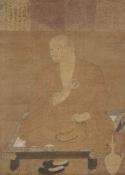

A SHIGARAKI-WARE MIZUSASHI (FRESH WATER JAR), MOMOYAMA PERIOD


PUBLISHED


1. Jean-Paul Desroches (ed.) et al, Two Americans in Paris: A Quest for Asian Art, Paris, 2016, p. 237, no. 396.
2. Pointe-à-Callière Museum, Two Americans in Paris. A Quest for Asian Art, exhibition album, p. 61, no. 4.
Exhibited:
1. Pointe-à-Callière Museum, From the Lands of Asia. The Sam and Myrna Myers Collection, Montréal, 17 November 2016-19 March 2017.
2. Kimbell Art Museum, From the Lands of Asia. The Sam and Myrna Myers Collection, Fort Worth, Texas, 4 March-19 August 2018.
Japan,1573-1603. Of irregular form, the gently rounded sides supported on a concave foot and rising to a tall neck with a rolled lip, the shoulders fitted with C-form loop handles, and decorated to the body with two geometric lozenge form panels in relief. With a concave lid applied to the center with a knop. Covered in a bright green natural glaze elegantly falling over the burnt, reddish-brown surface.
Provenance: The Collection of Sam and Myrna Myers, Paris, France. Acquired between circa 1965-2012.
Condition: Very good condition with minor wear and typical firing irregularities including firing cracks, burst bubbles, pooling, glaze recesses, and crackling. A small section of the lid with fills.
Weight: 2,500 g
Dimensions: Height 17.4 cm
Whereas most potters take care to filter rocks out of their clay, the potters of the Shigaraki region understand that the texture created by rocky bits of quartz and feldspar adds tactile and visual interest to their wares. The artisans add only minimal glaze, letting the surface retain its graininess.
Shigaraki, east of Kyoto, has been a kiln site for centuries, originally making utilitarian pieces such as storage jars and mortars. When the tea ceremony gained popularity in the sixteenth century, Shigaraki ceramicists were quick to adapt to the tea masters’ demands for rustic but engaging vessels, such as this deceptively simple water jar.
AUCTION RESULT COMPARISON
Type: Closely related
Auction: Christie’s London, 15 October 2014, lot 19
Price: GBP 11,250 or approx. EUR 20,500 converted and adjusted for inflation at the time of writing
Description: A Shigaraki Mizusashi (water pot), Momoyama period, 16th-17th century

Expert remark: Compare the related irregular form and similar iridescent green glaze against the vibrant orange burnt ground. Note the size (15 cm).
Estimate EUR 6,000
Starting price EUR 3,000
Japan. The dark brown body raised on a short tapering concave foot, the tapering sides rising to a broad shoulder decorated with a wide band applied with large foliate-form medallion, surmounted by a compressed neck with a thick-lipped rim. A small section partially covered in a white glaze with splashes of blue, elegantly falling over the dark brown surface. With a wood lid.
Provenance: The Collection of Sam and Myrna Myers, Paris, France. Acquired between circa 1965-2012.
Condition: Overall good condition with wear and firing irregularities. Old repairs with associated touchups.
Weight: 1,205 g
Dimensions: Height 14 cm
The subdued quality of Karatsu wares has been much appreciated by devotees of the tea ceremony. A mizusashi is a jar with a lid used to hold fresh water for pouring into the kama (kettle) or for rinsing the tea bowls and tea whisk.
This piece is thought to have been fired in the Karatsu area of present-day Saga Prefecture or the Ueno area of Fukuoka Prefecture. The name of the glaze, mottled Karatsu (madara Karatsu), derives from the blue dappled spots within the white glaze. This vessel clearly displays this characteristic mottling.
AUCTION RESULT COMPARISON
Type: Related
Auction: Bonhams London, 16 May 2024, lot 98
Price: GBP 2,048 or approx. EUR 2,400 converted and adjusted for inflation at the time of writing
Description: A karatsu mizusashi (fresh water jar)
Expert remark: Compare the closely related glaze.
Estimate EUR 3,000
Starting price EUR 1,500
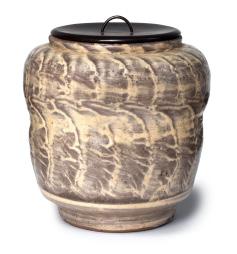
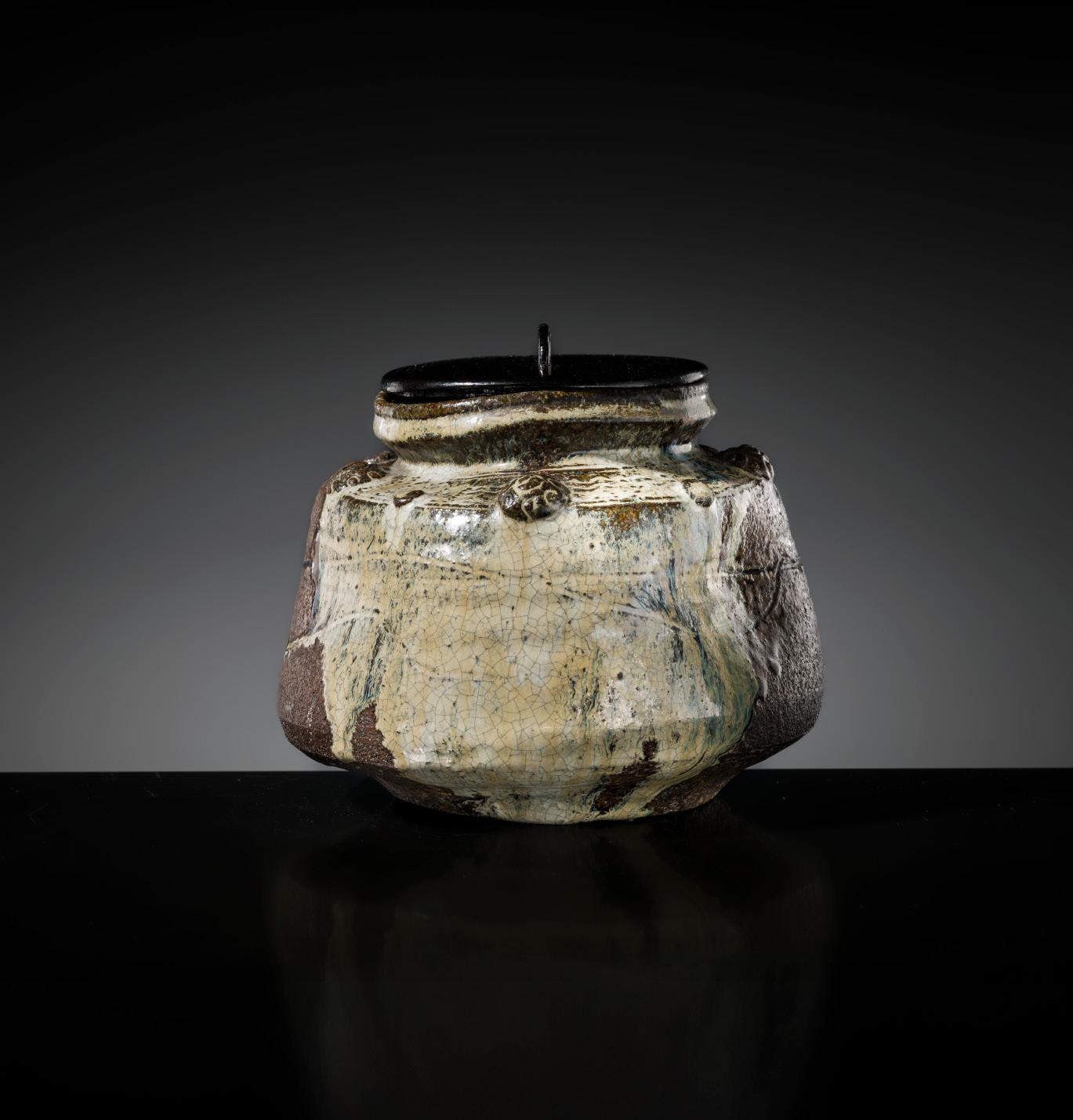
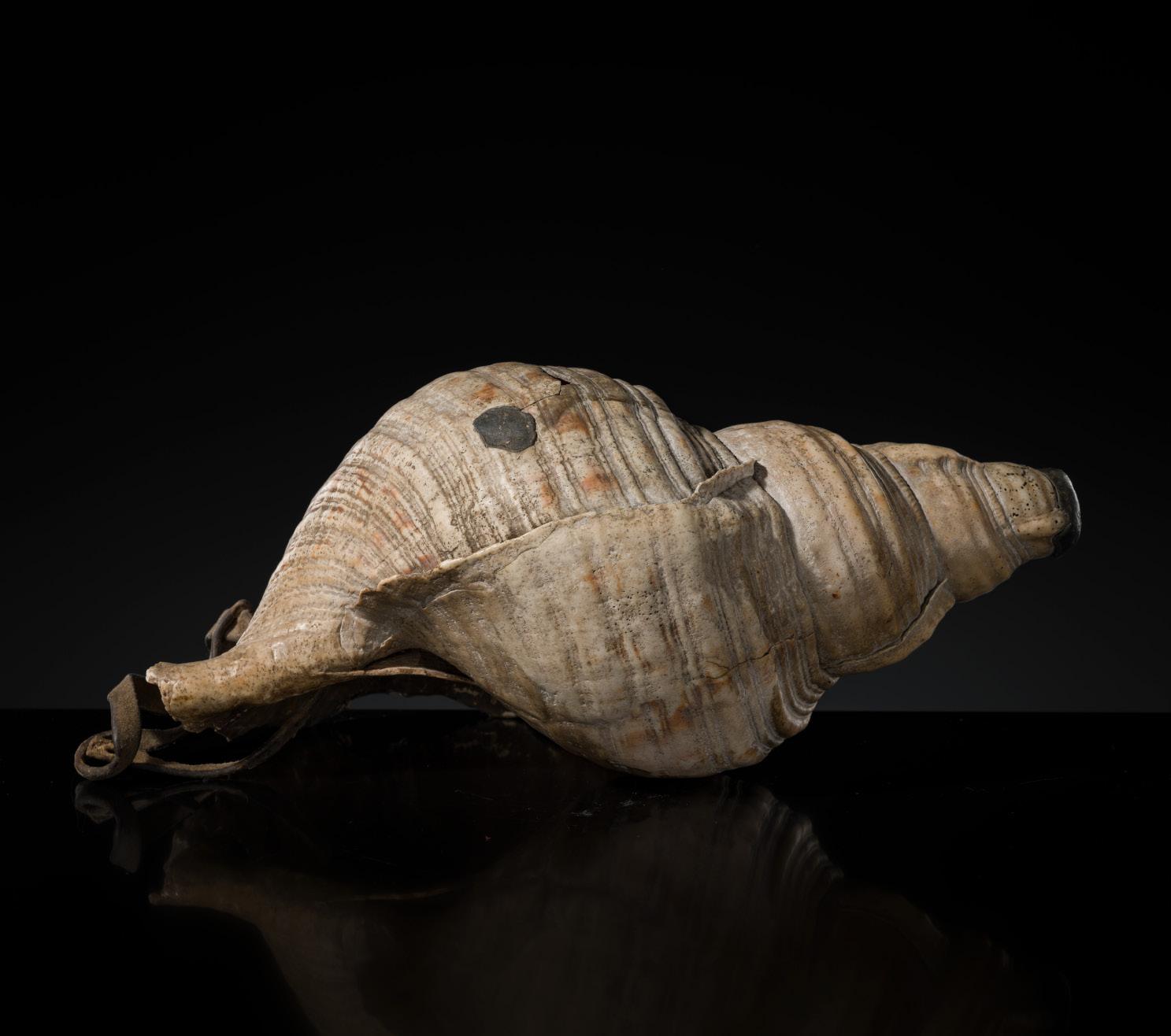
Japan, 1615-1868, circa 17th to mid-18th century. Crafted from a naturally formed seashell of creamy-white color marked with brown and russet patches, the body encircled by numerous ridged striations, the blowing hole lined in metal, a leather cord affixed to the upper edge.
DID YOU KNOW?
The conch shell is known as fanbei in Chinese and was considered a rare treasure in ancient times, with a long history of use in religious ceremonies. It is a common instrument in various ancient Indian religions and, most notably, in Buddhism. Legend has it that when the Buddha Shakyamuni first turned the Wheel of Law in the Deer Park, Śakra (the ruler of Heaven) offered him a right-turning white conch as reward. Since then, the conch has been widely used in the transmission of Buddhism as a symbol of auspiciousness and perfection. Making up one of the Eight Auspicious Signs (bajixiang) in Tibetan Buddhism, the conch not only symbolizes auspiciousness and perfection but also – due to its ability to produce a sound that gathers monks – the voice of the Buddha himself. Symbolizing the dissemination of Buddhist teachings across the world for the salvation of all beings, the present conch is more than just an object of beauty and history; it stands as a symbol of religious devotion and belief in a brighter tomorrow. See a Chenghuaperiod ritual conch trumpet, with an inscription dating it to 1478, sold at Sotheby’s Hong Kong, 29 October 2024, lot 1511 (fig. 1) fig. 1
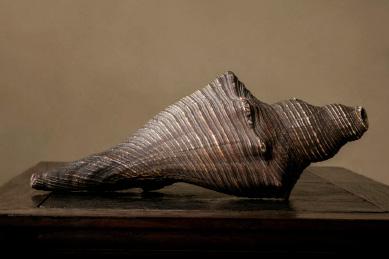
Provenance: The Collection of Sam and Myrna Myers, Paris, France. Acquired between circa 1965-2012.
Condition: Overall good condition with old wear, traces of use, manufacturing irregularities, cracks and fissures with associated repairs, obvious losses, one side with an old metal fill probably inherent to the manufacture.
Weight: 1,221 g
Dimensions: Length 33.4 cm
Horagai are large conch shells, usually from Charonia tritonis, that have been used as trumpets in Japan for many centuries.
A shell trumpet is a type of wind instrument crafted from the conch of large marine gastropods. These shells possess a natural conical bore, which enables them to produce a resonant musical tone when blown. Shell trumpets have been found across diverse cultures and regions, including East and South Asia, the Pacific Islands, and South America. Historically, shell trumpets were valued not primarily as instruments for musical ensembles, but as signaling devices. Their powerful, far-carrying sound made them effective tools for communication over long distances.
Literature comparison: Compare a related Japanese conch shell trumpet dated to the Edo period in the Penn Museum, Philadelphia, object number 51-46-75. Compare a related Indian shell trumpet, dated late 19th century, 38.1 cm long, in the Metropolitan Museum of Art, object number 89.4.1763. Compare a related Indian shell trumpet, 17 cm long, in the British Museum, registration number As1972,Q.316.
Estimate EUR 1,500
Starting price EUR 800

Exhibited:
1. Pointe-à-Callière Museum, From the Lands of Asia. The Sam and Myrna Myers Collection, Montréal, 17 November 2016-19 March 2017.
2. Kimbell Art Museum, From the Lands of Asia. The Sam and Myrna Myers Collection, Fort Worth, Texas, 4 March-19 August 2018.
Japan,17th-18th century. Of kurabane type, the riding saddle fitted with two igi (wood side boards), maewa (pommel) and shizuwa (cantle) of yamagata (highly-seated; ‘mountain-shaped’) form, the pommel with the two umi (‘sea’) and iso (shore’) registers almost evenly constructed, low-shouldered tegata (hand-shaped) indentations carved to each side, bearing a densely sprinkled aogai (abalone shell) nashiji ground.
Inscriptions: Signed with kakihan [artist’s cursive monogram] to the underside.

PUBLISHED
Jean-Paul Desroches (ed.) et al, Two Americans in Paris: A Quest for Asian Art, Paris, 2016, p. 234, no. 370.



The Collection of Sam and Myrna Myers, Paris, France. Acquired between circa 1965-2012.
Condition: Good condition with wear and manufacturing irregularities. Nicks, scratches, and some stains. Expected losses and flaking to inlays, some with associated touchups.
Dimensions: Size 39 x 27.3 cm
Such shell inlay, or raden was used in Japan since the Nara period (645794) introduced from Tang China. It was very fashionable during the Heian (794 - 1185) and Kamakura (1185 - 1333) periods, and then again found favor when it was re-discovered in the 16th century in the Kingdom of Ryukyu, South of Japan. Although made some centuries before the word Nanban was coined in Japan, such work is indicative of the admiration felt in Japan for overseas technology, and this piece might be said to typify the manner in which it was improved on in Japan.
LITERATURE COMPARISON
Compare a closely related aogainashiji lacquer kura, Edo period, circa 1750, in the Ann and Gabriel Barbier-Mueller Museum, Dallas.

Estimate EUR 3,000
Starting price EUR 1,500
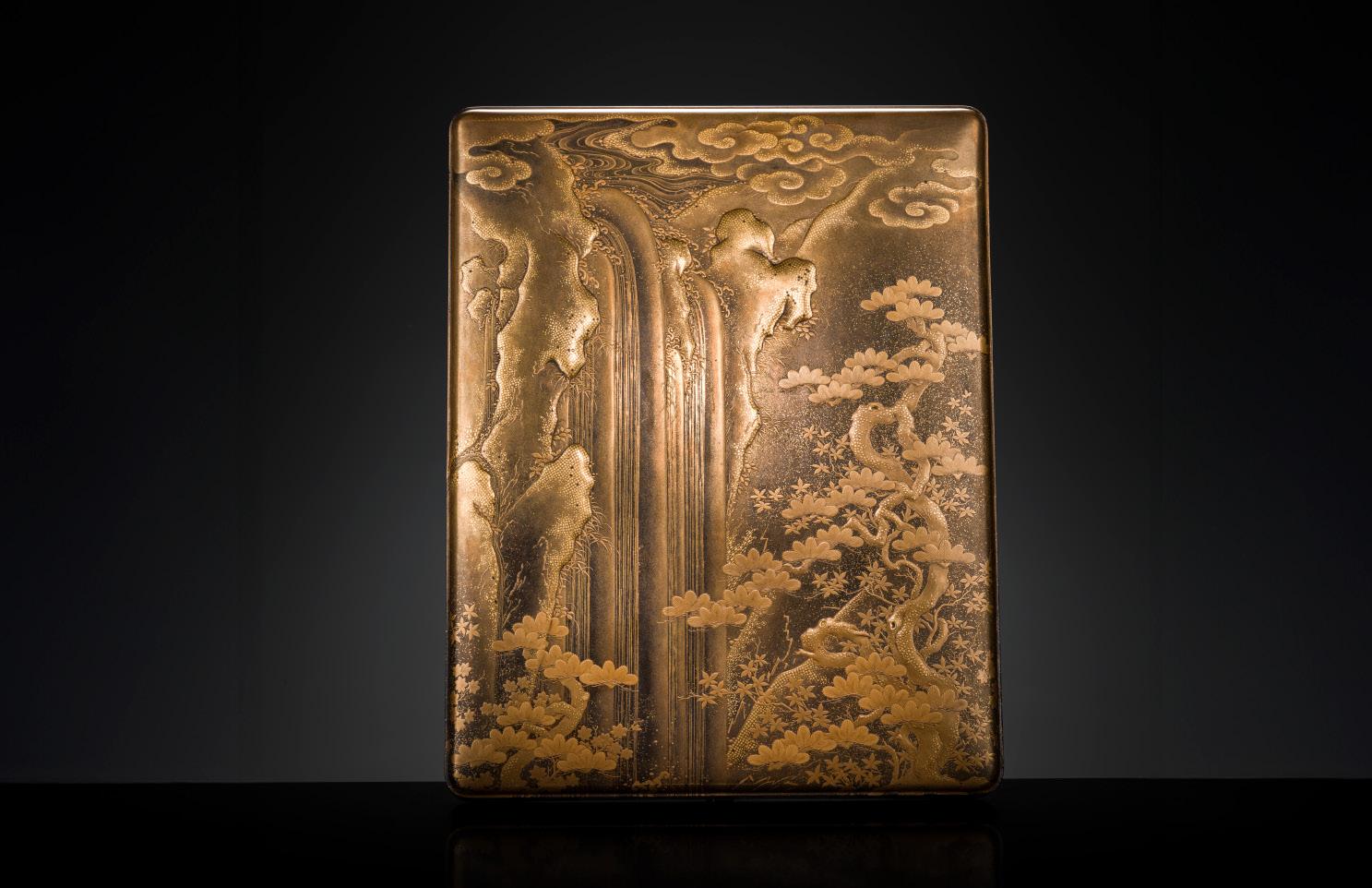


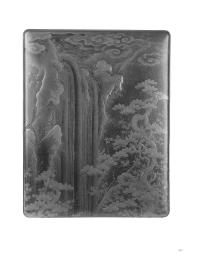

PUBLISHED
1. Jean-Paul Desroches (ed.) et al, Two Americans in Paris: A Quest for Asian Art, Paris, 2016, p. 237, no. 374.
2. Pointe-à-Callière Museum, Two Americans in Paris. A Quest for Asian Art, Montréal, 2016, exhibition album, p. 60.
Exhibited:
1. Pointe-à-Callière Museum, From the Lands of Asia. The Sam and Myrna Myers Collection, Montréal, 17 November 2016-19 March 2017.
2. Kimbell Art Museum, From the Lands of Asia. The Sam and Myrna Myers Collection, Fort Worth, Texas, 4 March-19 August 2018.

Japan, 18th-19th century. Of rectangular form with rounded corners, bearing a rich gold-sprinkled ground, finely decorated in gold hiramaki-e and takamaki-e, as well as kirigane flakes, to depict a waterfall gushing down a large gnarled cliff, framed by twisting pines and scrolling clouds to the sky. The motif continued to the sides of the box to map the meandering path of the stream dotted with trees, rocks, and vegetation on the shores. The interior of the cover similarly decorated with small huts by the shore, rakes, a sickle, and baskets outside, all against a vibrant nashiji ground. The interior fitted with a removable tray. The underside and interior compartments of nashiji with gold fundame rims.
Provenance: The Collection of Sam and Myrna Myers, Paris, France. Acquired between circa 1965-2012.
Condition: Excellent condition with minor wear and with typical expected losses to kirigane flakes and other light traces of use.
Dimensions: Size 43 x 33.5 x 16 cm
AUCTION RESULT COMPARISON
Type: Related
Auction: Sotheby’s New York, 16 September 2008, lot 264
Price: USD 9,375 or approx. EUR 11,500 converted and adjusted for inflation at the time of writing
Description: A gold lacquer box and cover (tebako), 19th century
Expert remark: Compare the closely related form and related motif.
Estimate EUR 6,000
Starting price EUR 3,000


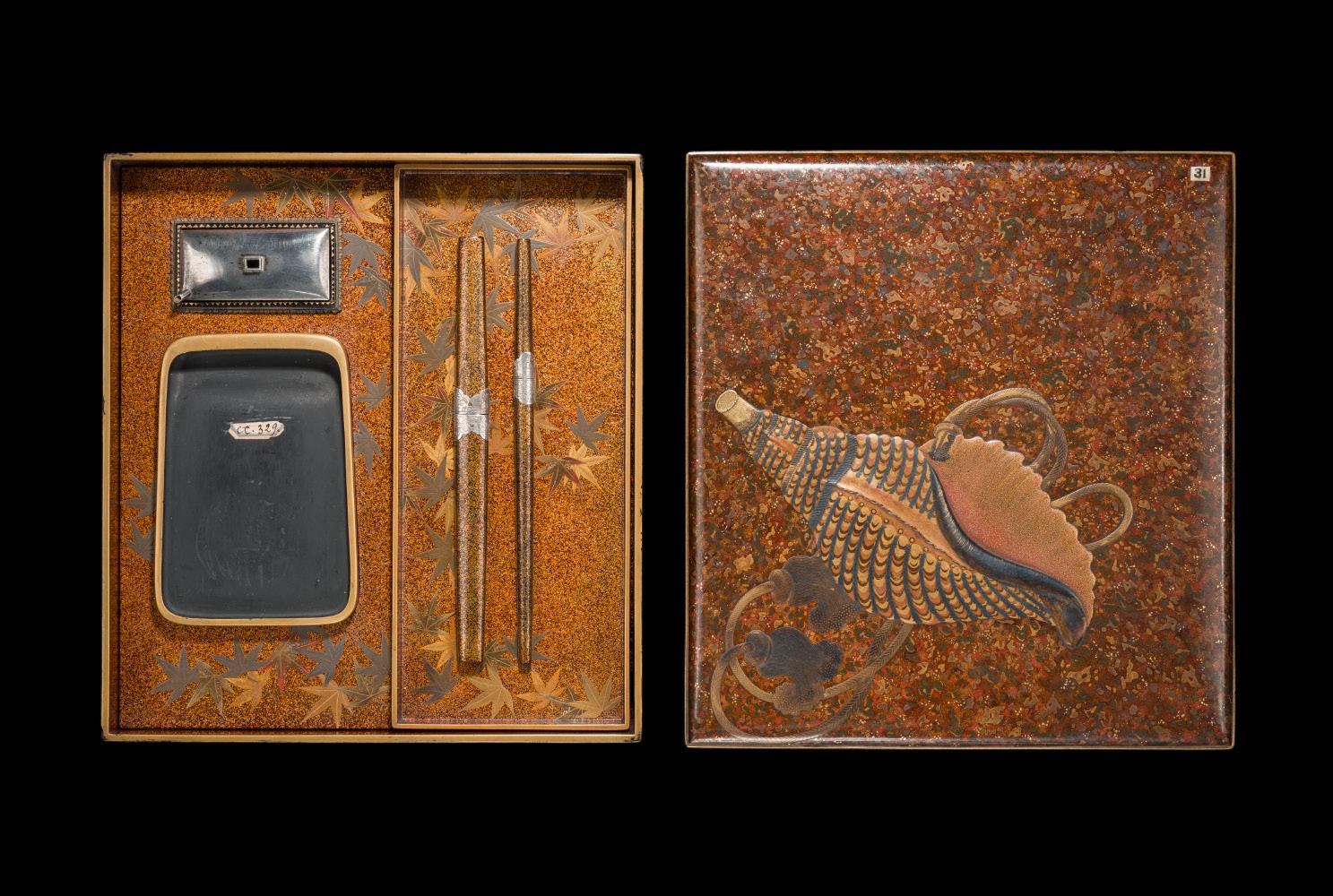
Exhibited:
1. Pointe-à-Callière Museum, From the Lands of Asia. The Sam and Myrna Myers Collection, Montréal, 17 November 2016-19 March 2017.
2. Kimbell Art Museum, From the Lands of Asia. The Sam and Myrna Myers Collection, Fort Worth, Texas, 4 March-19 August 2018.
Japan, 19th century. Of rectangular form with a flat overhanging cover, bearing a mottled ground, finely decorated to the cover in iro-e hiramaki-e and takamaki-e, as well as scattered gold sprinkles and kirigane, to depict a tasseled Horagai conch, its shell with naturally variegated stripes. The interior of the cover decorated with a mountainous landscape dotted with low, rolling hills, various creepers and maple leaves, an oi (monk’s backpack) to one side. The interior and base in nashiji with scattered leaves, fitted with a removable ita (baseboard), and housing the original implements: a silver waterdropper (suiteki), a paper-cutting knife (kogatana), an awl (kiri), and a fitted rectangular inkstone (suzuri). The rims of fundame.
Provenance: Ex-collection Charles CartierBresson (1853-1921). The Collection of Sam and Myrna Myers, Paris, France. Acquired between circa 1965-2012. Charles CartierBresson was a textile industrialist and art collector specializing particularly in works from Japan. He is the great uncle of famous photographer Henri Cartier-Bresson (19082004).
Condition: Excellent condition with minor wear including a few light surface scratches and light traces of use throughout.
Dimensions: Size 24.8 x 22.8 x 4.2 cm


PUBLISHED


1. Jean-Paul Desroches (ed.) et al, Two Americans in Paris: A Quest for Asian Art, Paris, 2016, p. 236, no. 372.
2. Pointe-à-Callière Museum, Two Americans in Paris. A Quest for Asian Art, Montréal, 2016, exhibition album, p. 60.
The interior of the cover shows a path covered with ivy and bordered with maple against which a wicker case has been placed. The path refers to Chapter IX in the Tale of Ise, in which a solitary traveler crosses a pilgrim and gives him a poem destined for his wife who is far away. It is intended to incite inspiration for the person who will use the writing box.
Estimate EUR 4,000
Starting price EUR 2,000


140 A LACQUER BUNKO (DOCUMENT BOX), FIRST HALF OF THE 20TH CENTURY
Japan. Of rectangular form with canted corners and flat flush-fitting cover, decorated in iro-e hiramaki-e and takamaki-e, as well as sprinkles of gilt, to depict fern leaves in varying subtle tones of brown, and clusters of red lilies with gilt stamens, the foliate stems decorated in nashiji on a black ground, all upon a pale tan lacquered ground, with black irregular splashes scattered throughout the foliage. The interior and base of nashiji with silver fundame rims.
Provenance: Christie’s London, 8 November 2007, lot 174 (sold for GBP 1,875 or approx. EUR 4,200 converted and adjusted for inflation at the time of writing). The Collection of Sam and Myrna Myers, Paris, France, acquired from the above.

Condition: Excellent condition with only very minor wear.
Dimensions: Size 26.5 x 22 x 13.5 cm
Estimate EUR 1,500
Starting price EUR 800
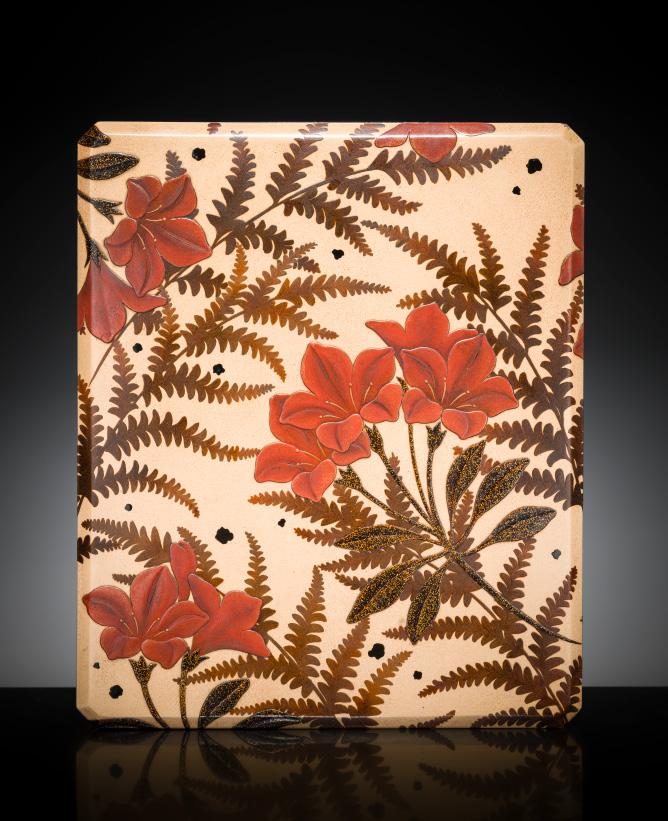
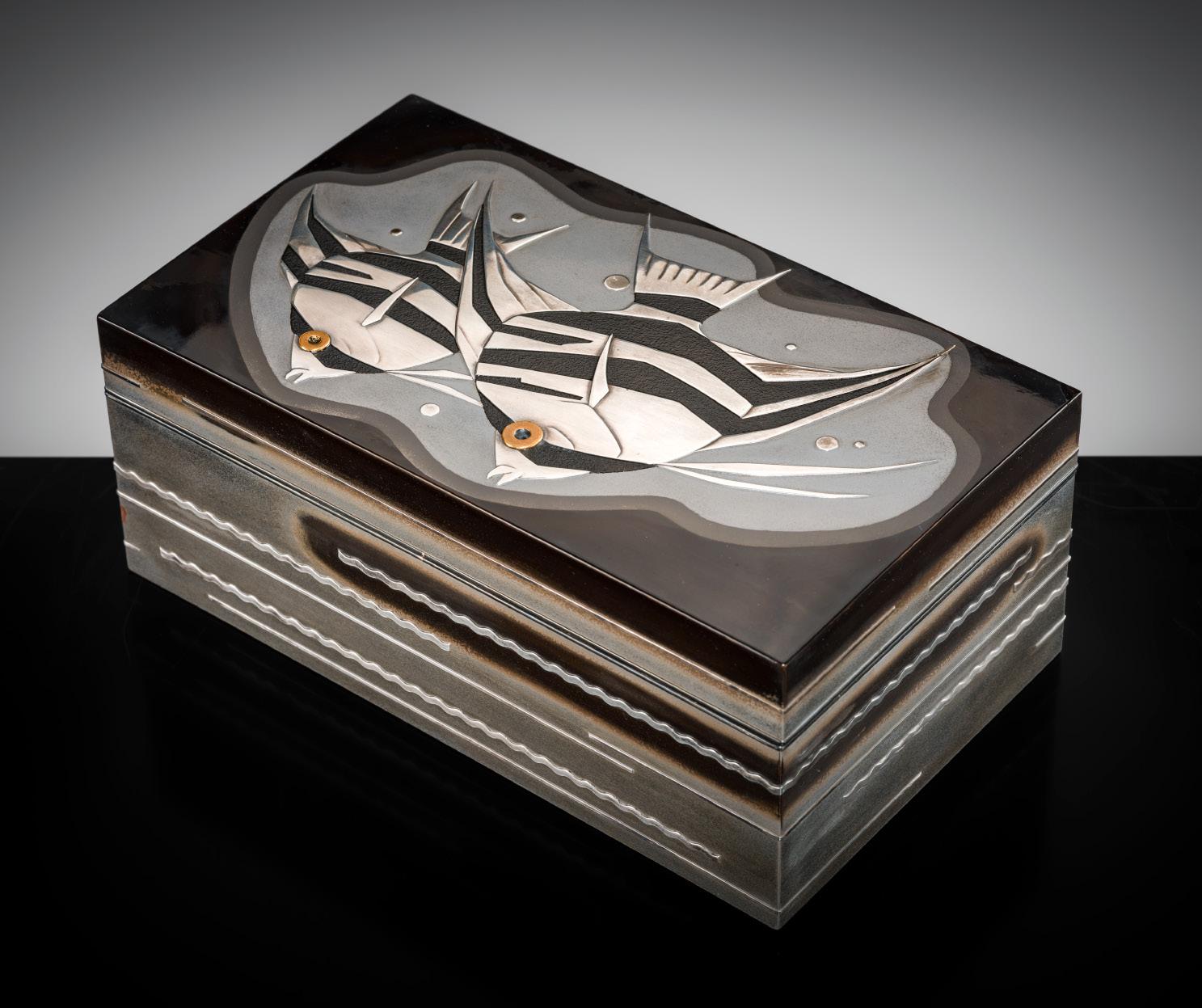
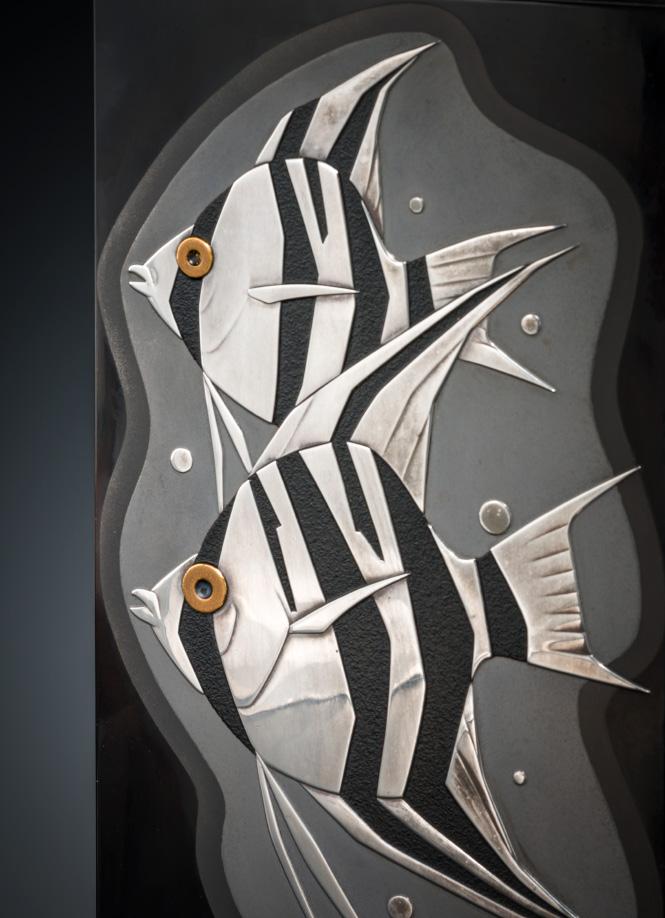
141
Japan, mid-20th century. Of rectangular form, bearing a roiro lacquered ground, the box is richly decorated in gold and silver takazogan, as well as iro-e hirazogan, to depict a pair of angelfish swimming in tandem against the flow of water, with ripples and waves simulated to the sides. The fish with their flared fins, curved bodies, and incised detailing capturing a sense of fluid movement, their eyes subtly accented with dense nashiji lacquered pupils. Circular bubbles of varying sizes are inlaid around them, enhancing the sense of an underwater scene. The interior lacquered in mottled red with silver fundame rims.
Inscriptions: Remnants of a gold-lacquered signature to the underside.
Provenance: The Collection of Sam and Myrna Myers, Paris, France. Acquired between circa 1965-2012.
Condition: Excellent condition with only very minor wear.
Dimensions: Size 25.1 x 14.5 x 10 cm
The freshwater angelfish (Pterophyllum scalare) is a popular species native to the Amazon Basin in South America, recognizable by its tall, triangular body, elongated fins, and striking vertical black stripes over a silver or golden body. Known for its graceful swimming and peaceful demeanor, the angelfish became especially favored in Japan during the mid20th century, where it was selectively bred for ornamental aquariums and admired for its elegant, almost calligraphic form reminiscent of traditional Japanese aesthetics.
Estimate EUR 1,500
Starting price EUR 800









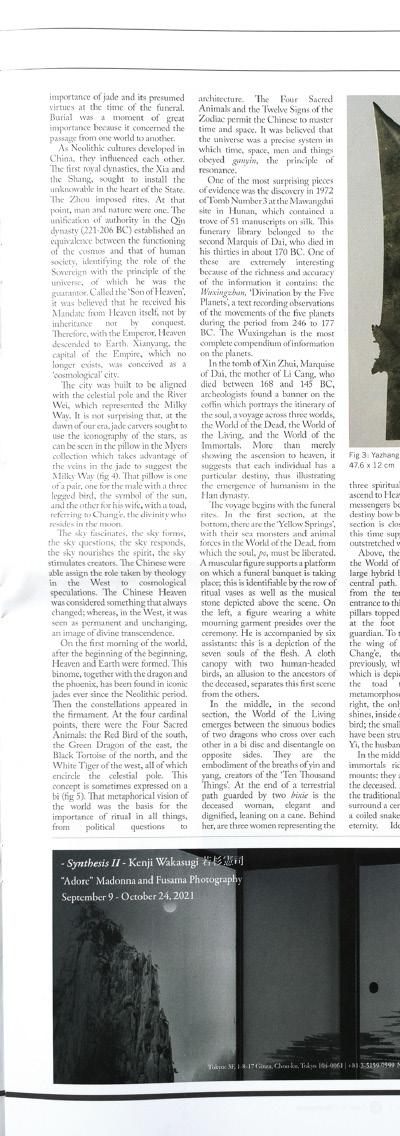

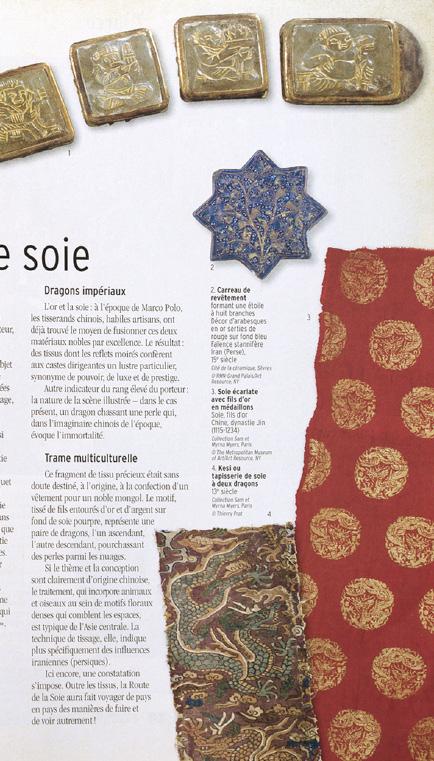









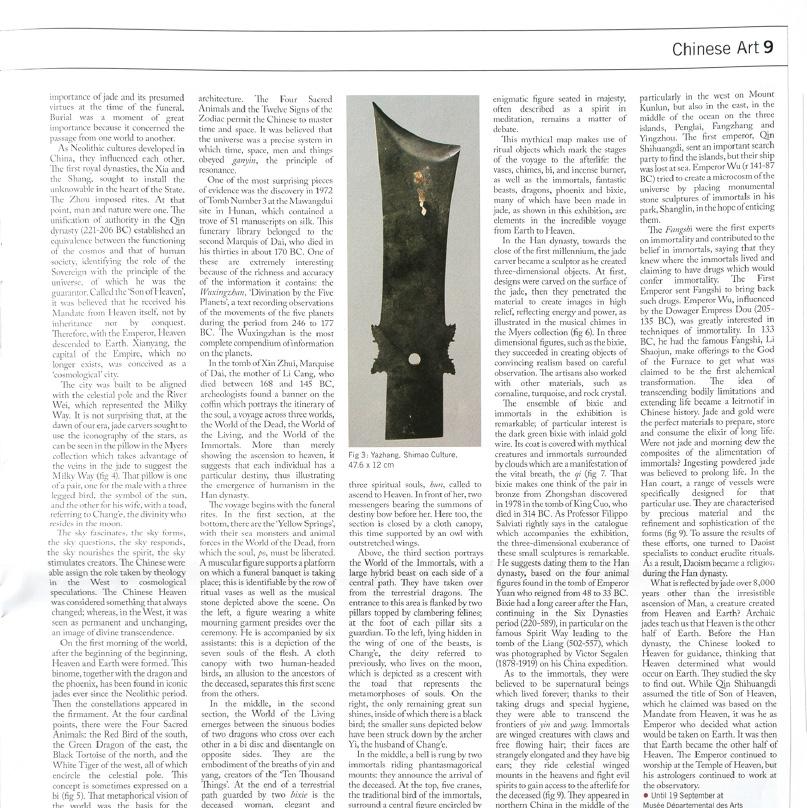



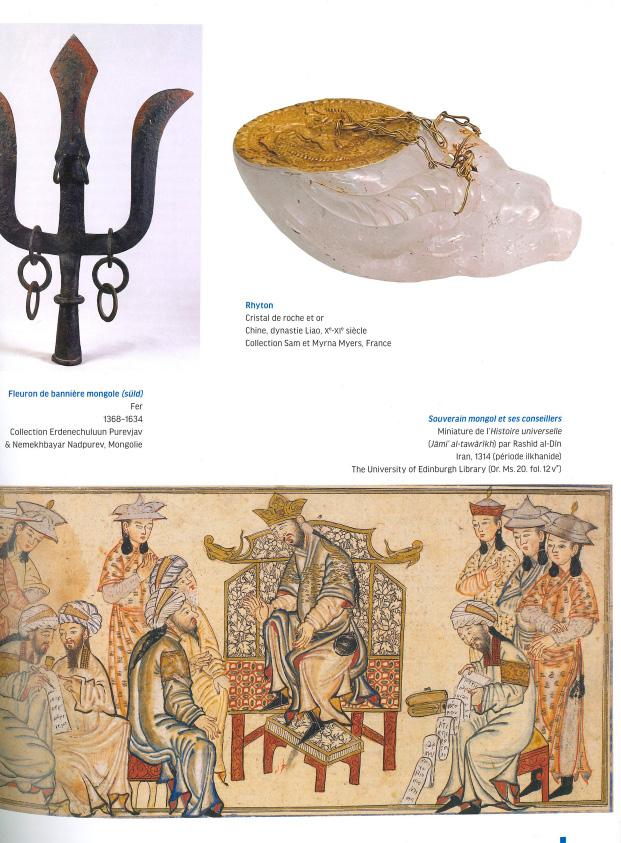






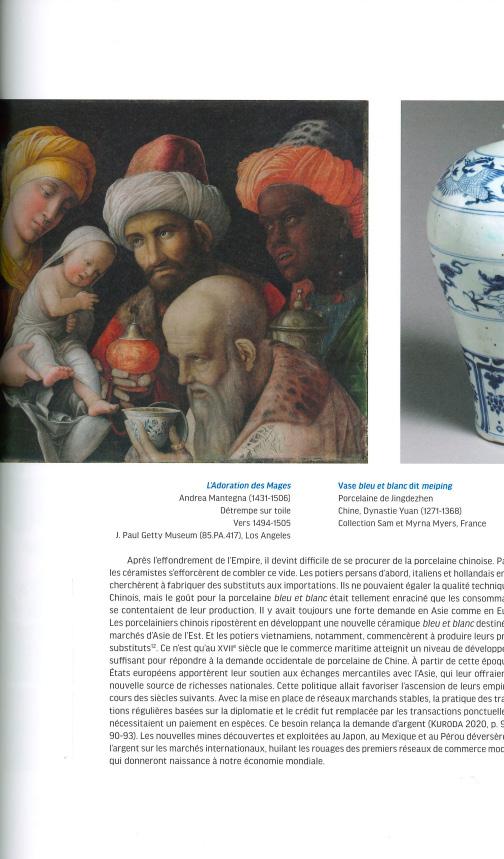
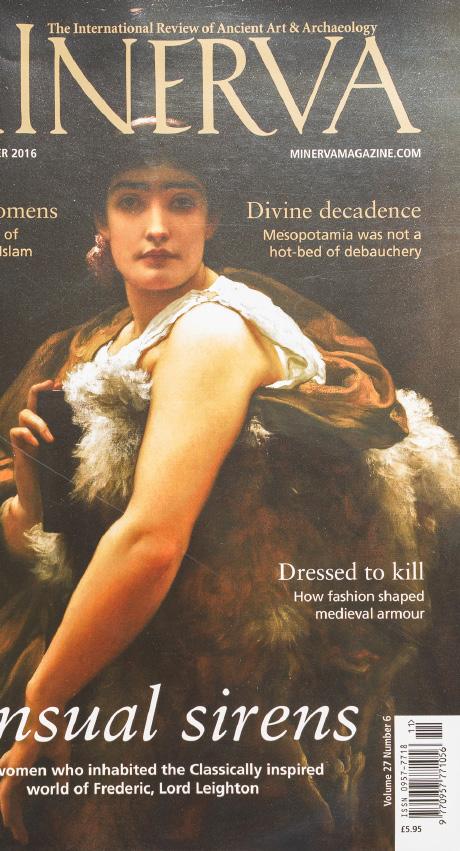

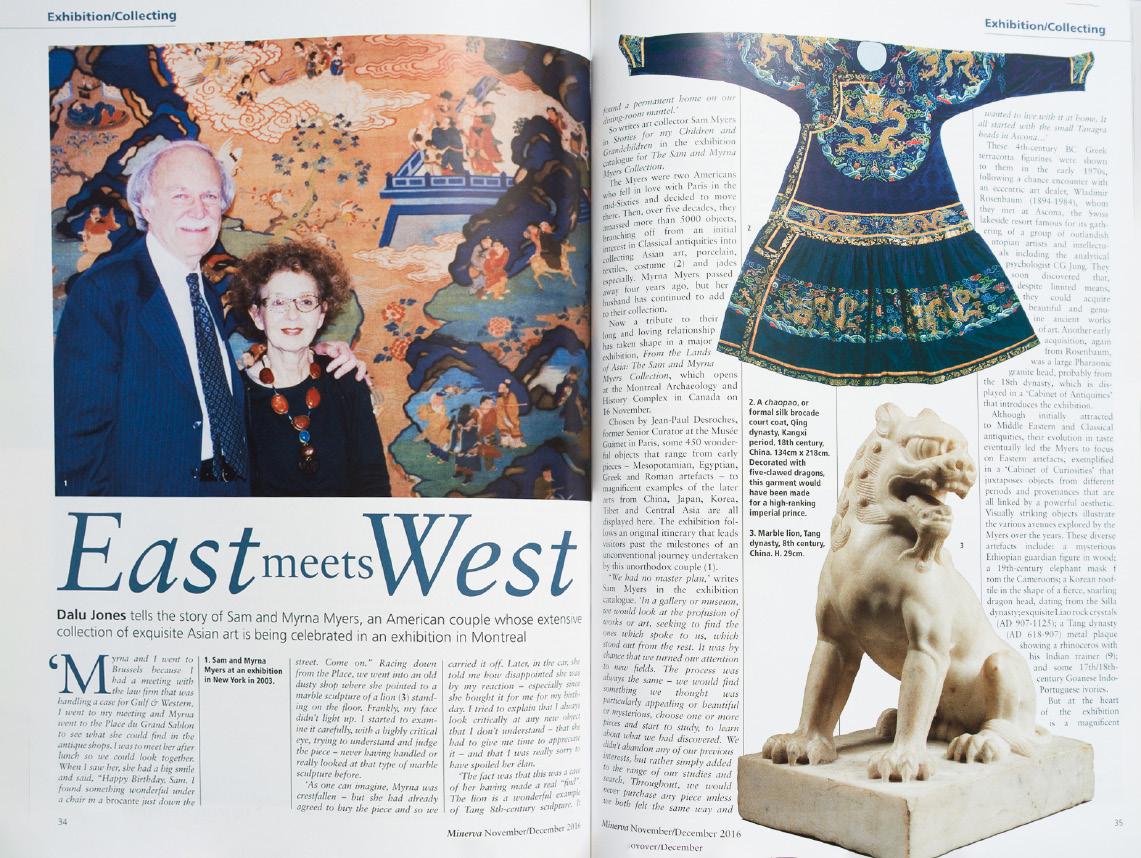





§ 1) The auction shall be carried out in accordance with the provisions of the rules of procedure of GALERIE ZACKE©, SZA VERSTEIGERUNGEN UND VERTRIEBS GMBH, Zelinkagasse 6, 1010 WIEN (hereinafter referred to as the company) as well as in accordance with sections 244246 of the GEWERBEORDNUNG [Industrial Code] of 1994. The auction shall be carried out on commission. The auctioneer shall be entitled to withdraw lots exceptionally, to conduct the auction deviating from the order of the catalog numbers and to offer lots jointly. In the event of any dispute concerning a double bid or if the auctioneer has missed a bid, the auctioneer shall be entitled to revoke acceptance of a bid and to continue auctioning the item. The figures stated in the catalog shall be the highest bid in Euro (€) expected by the respective expert. As a rule, the bid shall be increased by 10% of the last bid. (See table of the bidding increments).
§ 2) The acceptance of a bid shall be granted to the highest bidder unless a hidden reserve has been agreed upon with the consignor of the item in question. Such a hidden reserve (also called limit or just reserve) shall be the minimum price under which the item will not be sold during the auction. This reserve will be disclosed upon request and after the auction only and may exceed the estimate. The auctioneer will in this case bid on behalf of the seller against all other bidders until the reserve has been reached. If a reserve is not reached during the auction, the auctioneer will knock down the item to the highest bidder at the final bid, but the sale will be conditional of the acceptance of this final bid by the seller. In this case the highest bidder shall be bound to his/her last bid for a term of 8 days starting with the day of the knockdown. If the winning bidder does not receive a written cancellation notice within this term of 8 days, the knockdown becomes unconditional and the sale is final. Typically, only a minority of all items in an auction have a hidden reserve.
§ 3) Most items shall be subject to differential taxation. A uniform surcharge of 25% plus the value added tax applicable to the surcharge to the amount of 20% shall be added to the achieved highest bid (final and highest bid). Thus, the surcharge shall be 30% of the final and highest bid in total. Items with added VAT are marked † in the online catalog.
§ 4) In the event of sales abroad, the value added tax will be repaid if the item is sold to a country which is not a member country of the European Union (third country), the legal requirements are met, and the proof of exportation is provided. The value added tax shall not be shown separately on the invoice.
§ 5) The auction buyer must pay the purchase price immediately upon acceptance of the bid (final and highest bid plus 25% surcharge, plus the value added tax applicable to the surcharge to the amount of 20%, or the added VAT on top of the final price, when a lot is highlighted accordingly in the auction catalog). The company may grant an auction buyer a term of payment for the purchase price in whole or in part when this has been formally applied for in writing before the auction.
§ 6) In the event of a term of payment, or any payment delay, in whole or in part, the company shall be entitled to charge default interest (12% p.a.) as well as storage charges (2.4% pf the final and highest bid per month commenced) after 14 days upon acceptance of the bid. The item purchased at auction shall be handed over exclusively upon full payment of the purchase price including all costs and charges accrued since the acceptance of the bid.
§ 7) The buyer should take acquired items into possession, as far as possible, immediately or after the end of the auction. Items which have been fully paid for shall be handed over in our show rooms in GALERIE ZACKE, Zelinkagasse 6, 1010 VIENNA. If a deferred purchase price is not paid within the set period, the company shall be entitled to auction the item again in order to recoup its claim from the defaulting auction buyer. In this case, the defaulting auction buyer shall be liable to the company for the total loss of commission incurred by the company due to the re-auctioning as well as for any default interest and storage charges.
§ 8) The company shall be entitled to a lien on all items of the buyer irrespective of whether the buyer bought them within the scope of an auction or in free sale or the company secured ownership of these items otherwise. This lien shall serve to secure all current and future, qualified, limited and unmatured claims to which the company is entitled and which result from all legal transactions concluded with the buyer.
§ 9) The items received for auction will be exhibited and may be viewed prior to the auction. In doing so, the company shall give everyone the opportunity to check the nature and the condition of the exhibited items to the extent deemed possible within the scope of the exhibition. Every bidder shall be deemed to act on its own behalf unless it provides a written confirmation saying that it acts as a representative or agent of a well-known principal. The company may refuse bids; this shall particularly apply if a bidder who is unknown to the company or with whom the company has no business connections yet does not provide a security deposit before the auction. However, in principle there shall be no claim to accept a bid. If a bid has been refused, the previous bid shall remain effective.
§ 10) The company’s experts evaluate and describe the items received for auction and determine the starting prices unless otherwise stated in the catalog or expert opinion. The information concerning production technique or material, state of preservation, origin, design and age of an item is based on published or otherwise generally accessible (scientific) findings concluded by the company’s expert with the necessary care and accuracy. The company shall warrant to the buyer according to §34-38 of the AGB (Terms and Conditions) that properties are correct provided that any complaints referring to this are made within 45 days after the auction day. Subsequent complaints shall be excluded in principle. The company shall not be liable for any further information in the catalog and expert opinion as well. This shall also apply to illustrations in the catalog. The purpose of these illustrations is to guide the potential buyer during the preview. They shall not be authoritative for the condition or the characteristics of the pictured item. The published condition reports shall only mention defects and damage affecting the artistic or commercial value significantly. Complaints concerning the price shall be excluded upon acceptance of the bid. The company reserves the right to amend the catalog online prior to the auction. These amendments shall also be made public orally by the auctioneer during the auction. In this case, the company shall be liable for the amendment only. All items offered may be checked prior to the auction. These items are used. Any claims for damages exceeding the liability named above and resulting from other material defects or other defects of the item shall be excluded. When making the bid, the bidder confirms that he/ she has inspected the item prior to the auction and has made sure that the item corresponds to the description.
§ 11) If a customer is not able to participate in an auction personally, the company shall accept purchase orders. These orders may be placed in writing via mail, e-mail, fax, www.zacke.at or a third party bidding platform. In the case of a purchase order placed by phone or orally, the company shall reserve the right to make the performance dependent on a confirmation from the principal communicated in writing. Furthermore, the company shall not be liable for the performance of purchase orders. Equal purchase orders or live bids will be considered in the order of their receipt. Bids which below the estimate shall be exhausted completely. Bids which do not correspond to the increments determined by the company (see bidding increment table) will be rounded up to the next higher increment. The table of these increments can be sent upon request. The written bid (purchase order) must include the item, the catalog number and the offered top bid limit which is quoted as the amount of the acceptance of the bid without buyer’s commission and without taxes.
Ambiguities shall be carried by the bidder. A purchase order which has already been placed may only be cancelled if the written withdrawal is received by the company at least 72 hours prior to the beginning of the auction.
§ 12) The company may refuse a purchase order without explanation or make its execution dependent on payment of a security deposit. In the event of an unsuccessful order, such a deposit will be reimbursed by the company within 5 working days. Processing of purchase orders is free of charge.
§ 13) Every seller shall in principle be entitled to withdraw the items offered for auction until the start of the auction. Therefore, it is impossible to assume liability or to give warranty for the actual offering.
§ 14) Paid items must be collected within 30 days after payment. Items which have not been collected may be re-offered without further communication at the starting price from the recent auction reduced by 50%. Items which have not been collected within 30 days after the auction or for which the company does not receive any proper shipping instructions stating the type of shipping and the address of dispatch (independent of a possibly placed purchase order) shall be stored at the owner’s risk.
Furthermore, the company shall be entitled to store items which have been purchased at auction and paid but not collected at the buyer’s risk and expense, including the costs for an insurance, with a forwarding agency. It shall be understood that the provision concerning the re-auctioning of unpaid and paid but not collected items must also apply to items not exhibited or stored on the premises of the company. The ownership shall be transferred to the buyer at the time of handing over the issuing note.
§ 15) In the case of mixed lots with a starting price of less than EUR 350.00, the company shall not warrant for the completeness or correctness of the individual items within a mixed lot.
§ 16) A registration for a bid by telephone for one or several items shall automatically represent a bid at the starting price of these items. If the company cannot reach a bidder by telephone, it will bid the starting price on behalf of this bidder when the respective lot is up for auction.
§ 17) Payments made to the company by mistake (through the payer’s fault) (e. g. due to miscalculation of the exchange rate by the payer) or payments made to the company for the same invoice several times shall be compensated in form of a credit note for goods for an indefinite period of time. The repayment of such payments in cash shall be excluded.
§ 18) Certain auction lots may exist several times (multiples). In such a case, the auctioneer may accept a second, third or even more bids from the underbidder(s). In this case, the text in the catalog and not the illustration shall be exclusively binding with regard to the warranty.
§ 19) The company reserves the right to assign to the buyer all rights and obligations resulting from the contractual relationship between the company and the seller by way of a respective declaration, as well as to assign to the seller all rights and obligations resulting from the contractual relationship between the company and the buyer by way of a respective declaration, in each case in terms of a complete assignment of contract with the result that the contractual relationshipfollowing the submission of the aforementioned declarations by the company – shall exclusively be between the seller and the buyer, all of which is in accordance with the basic model of the commission agreement. Buyers and sellers shall already now give their explicit consent to this contract assignment.
§ 20) The place of performance of the contract brought about between the company on the one hand and the seller as well as the buyer on the other hand shall be the place of business of the company. The legal relationships and contracts existing between the company, the sellers and the buyers shall be subject to Austrian law. The company, the sellers and the buyers shall agree to settle all disputes resulting from, concerning and in connection with this contract before the territorially competent court of Vienna.
§ 21) The export of certain art objects from Austria shall require a permit from the Bundesdenkmalamt [Federal Monuments Office]. The company will orally provide information about art objects for which such export permit will probably not be granted at the beginning of the auction.
§ 22) Whenever making a bid, whether personally or via an agent, in writing, online, telephone, or in any other way, the bidder fully and unconditionally accepts the Terms of Auction, the ‘Important Information’ section in the auction catalog, the Terms and Conditions (AGB) of Galerie Zacke, §1-50, the Fee Tariff, and the Bidding Increments table, all as published on www.zacke.at on the day of the auction.













